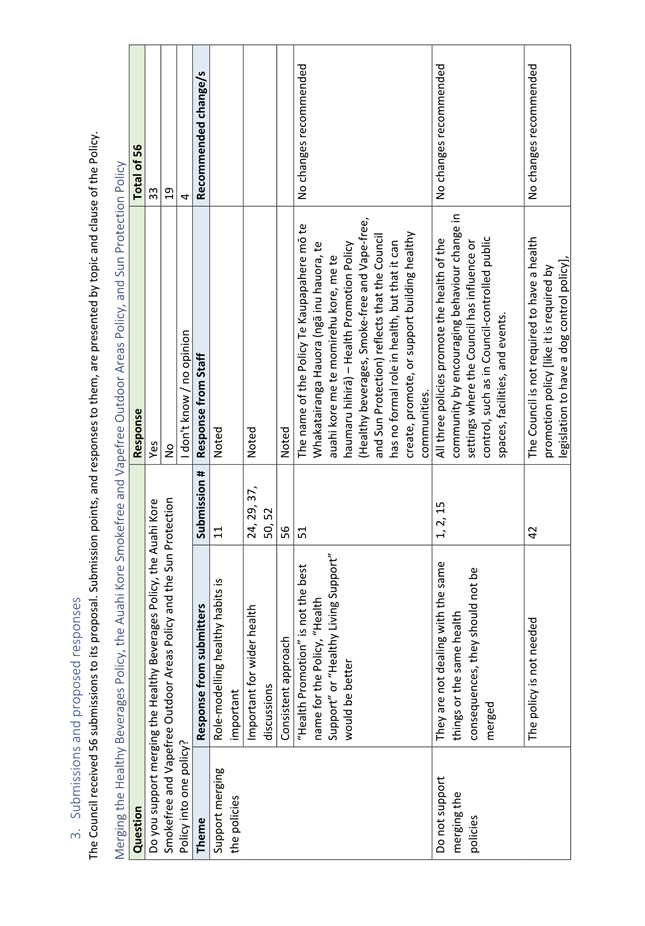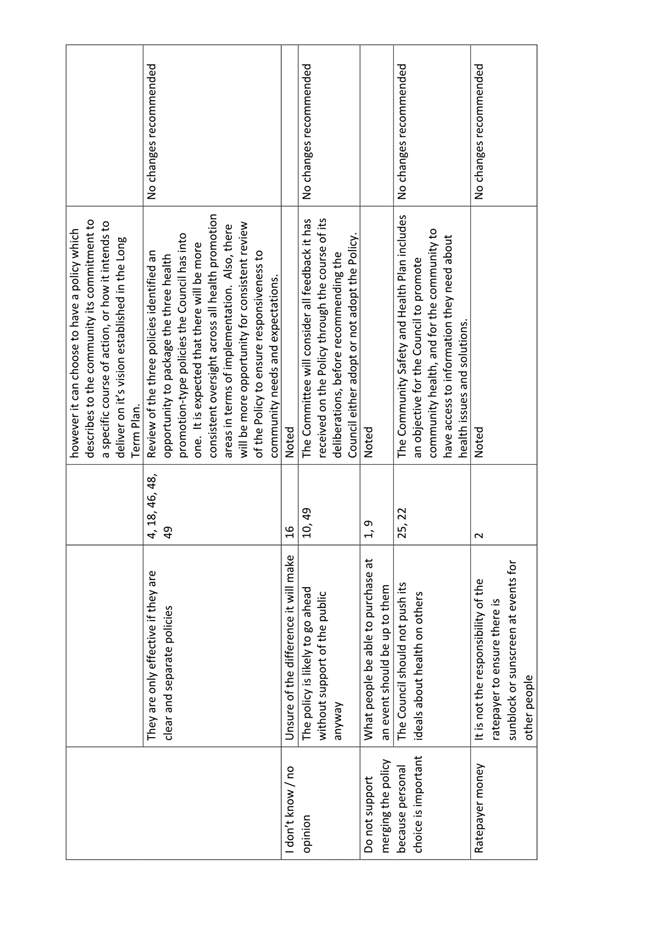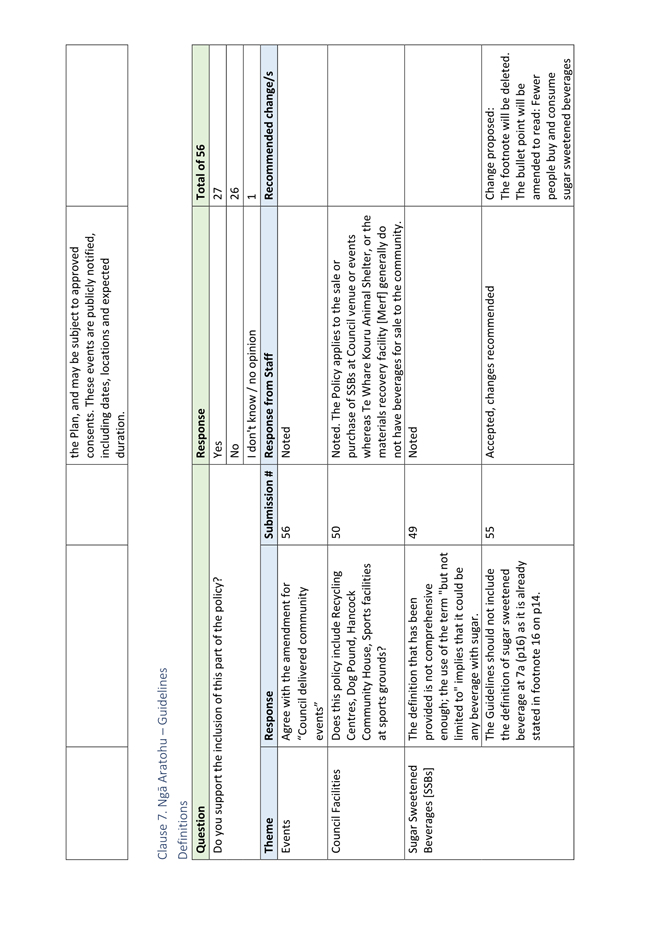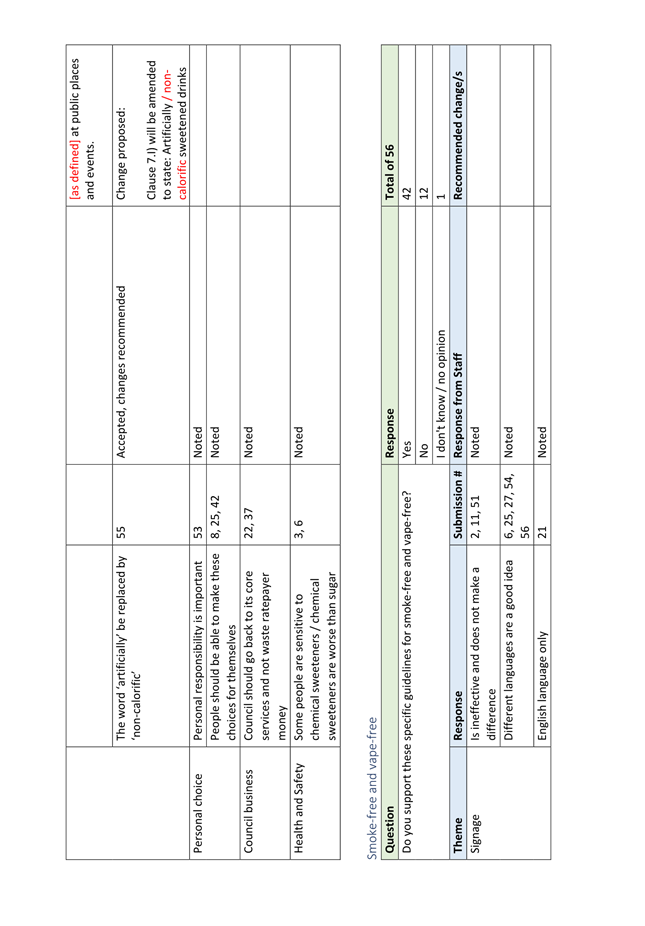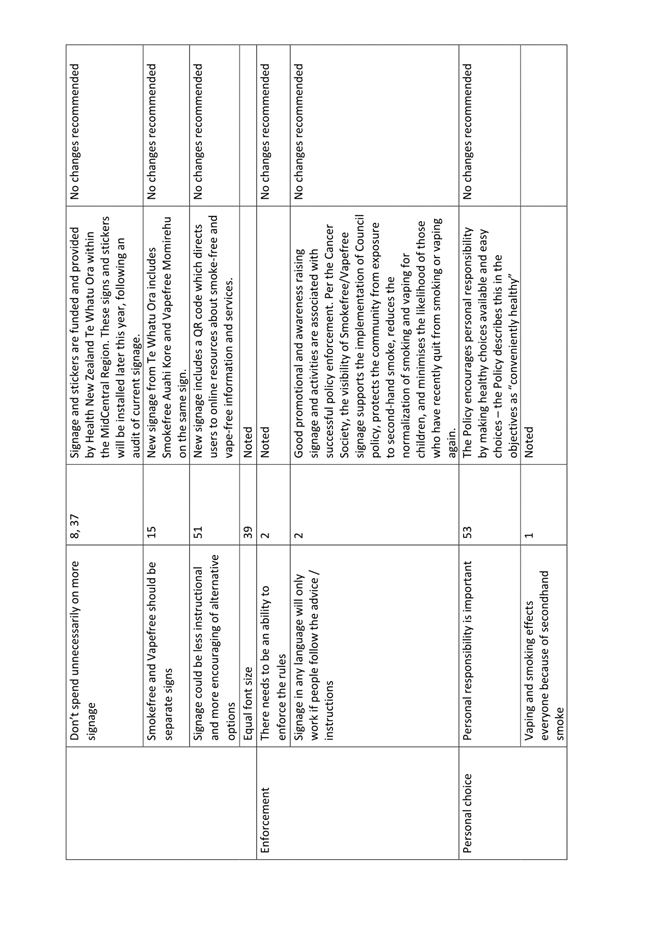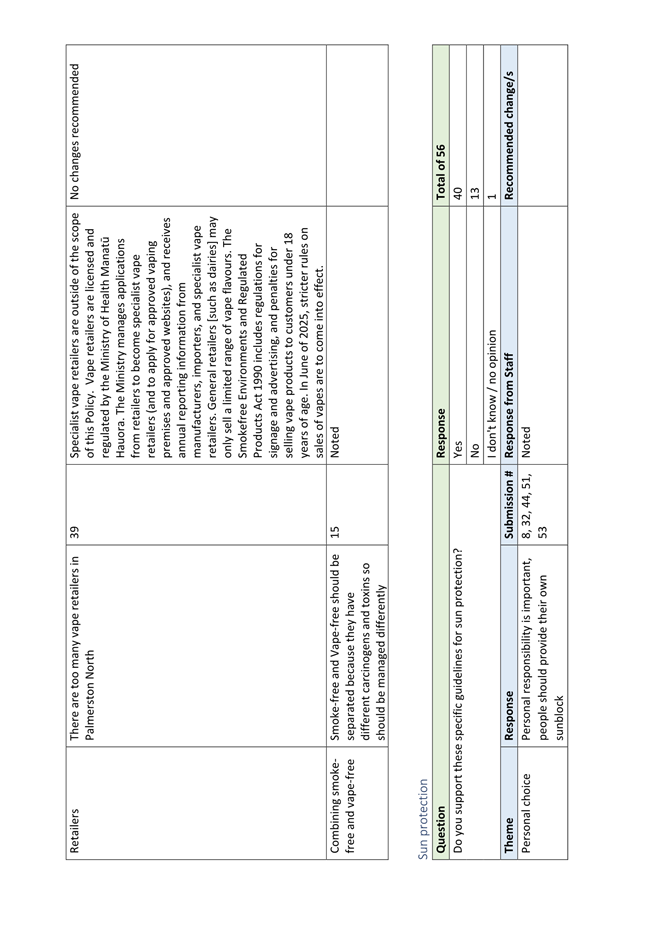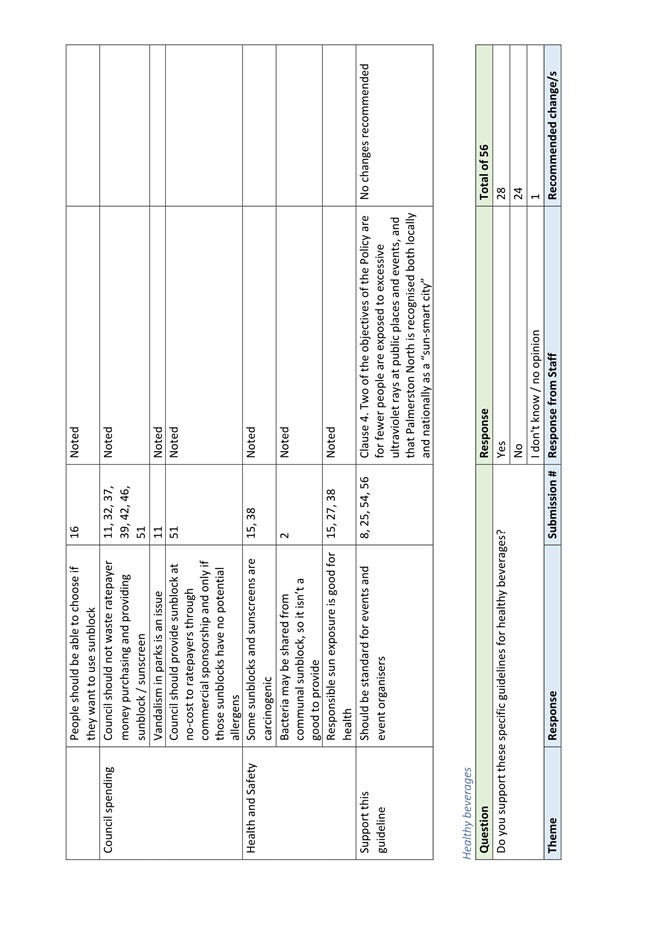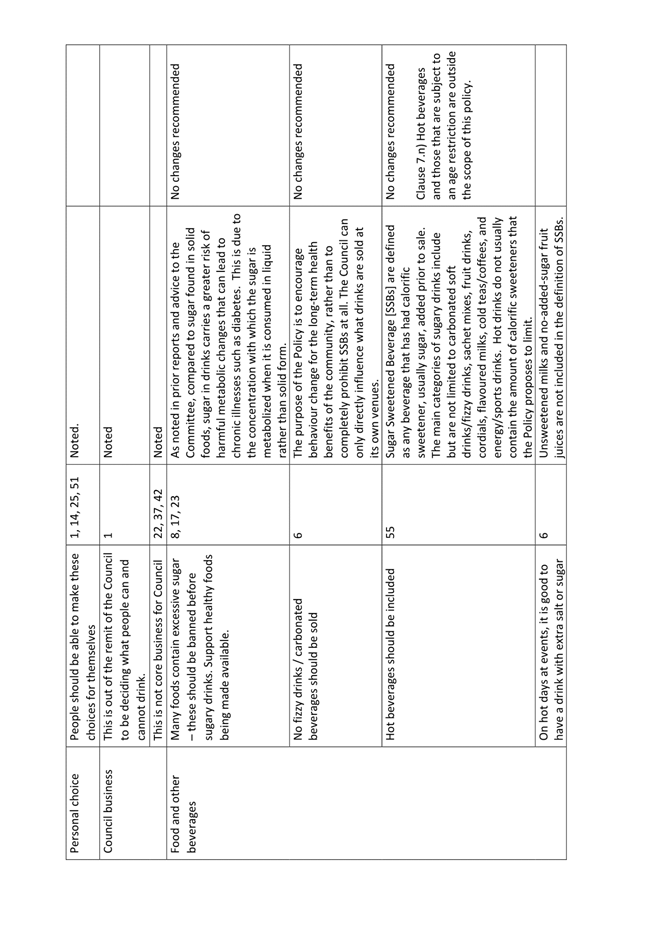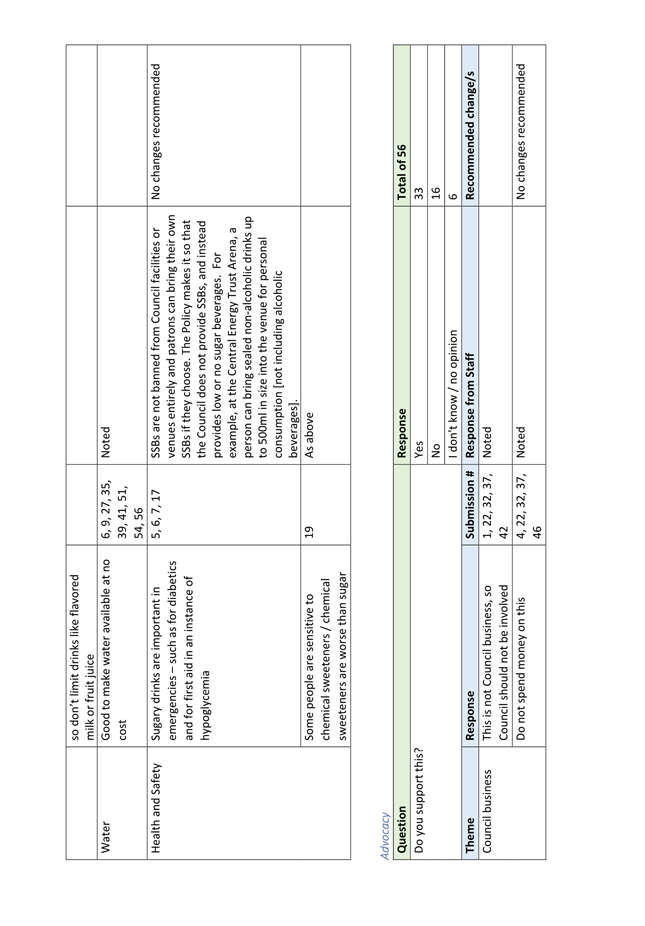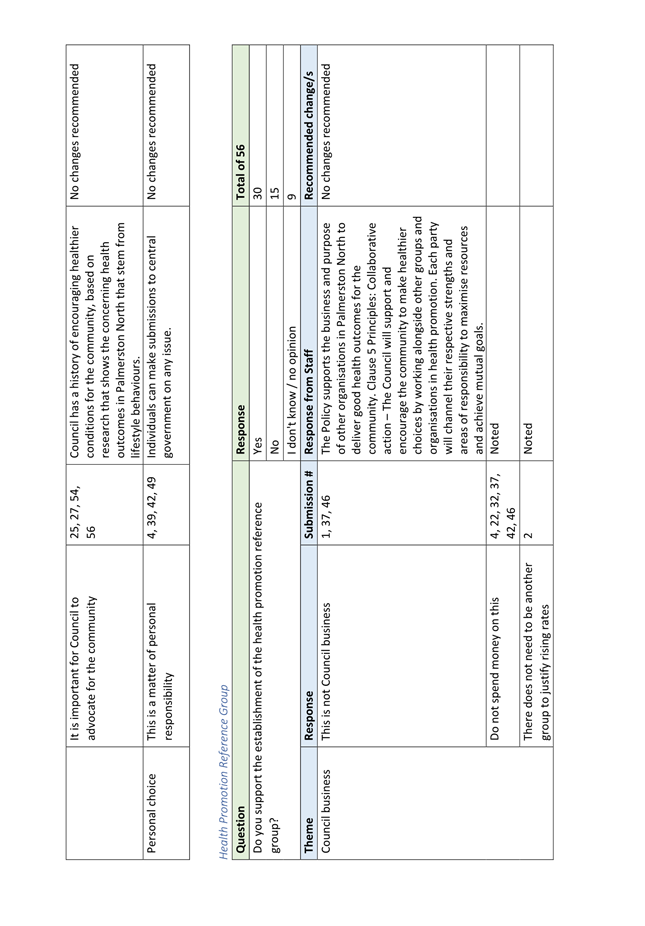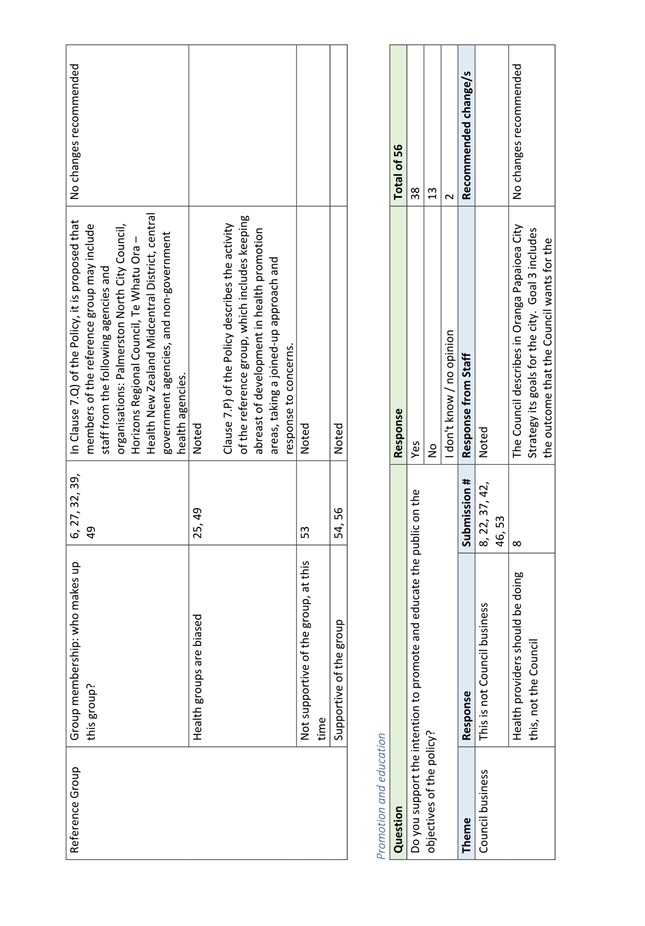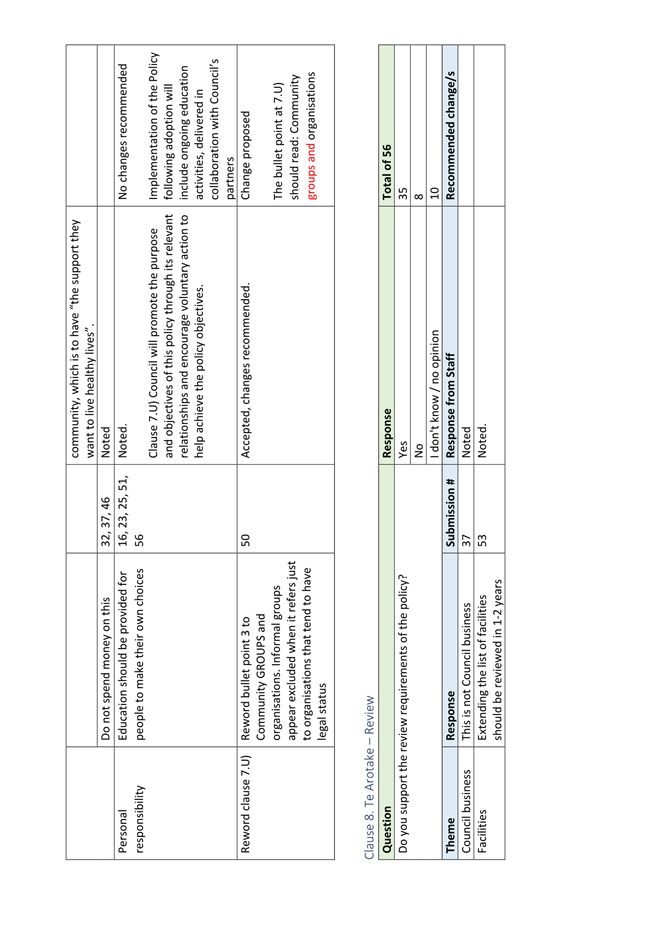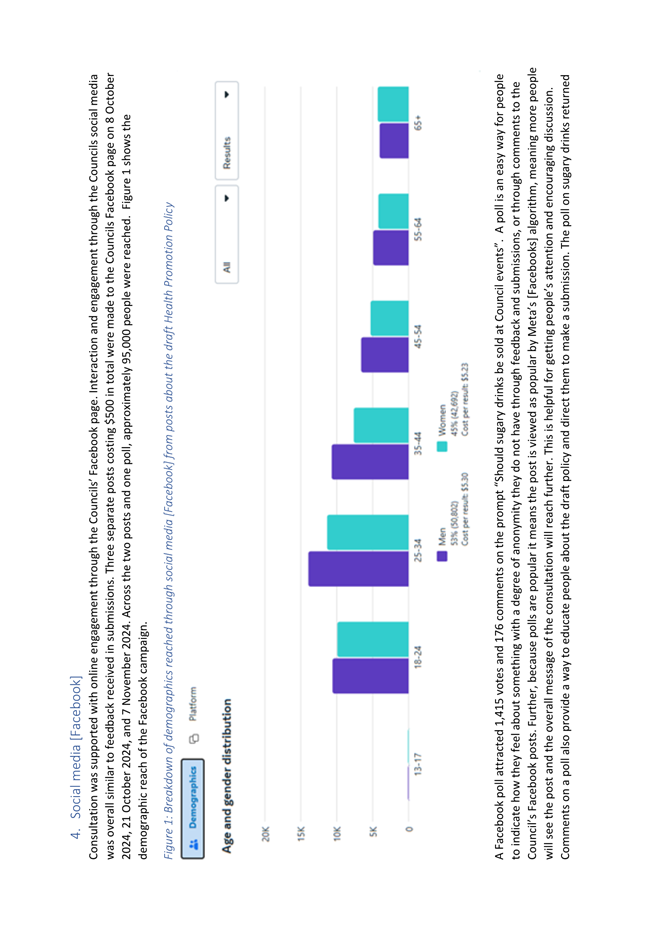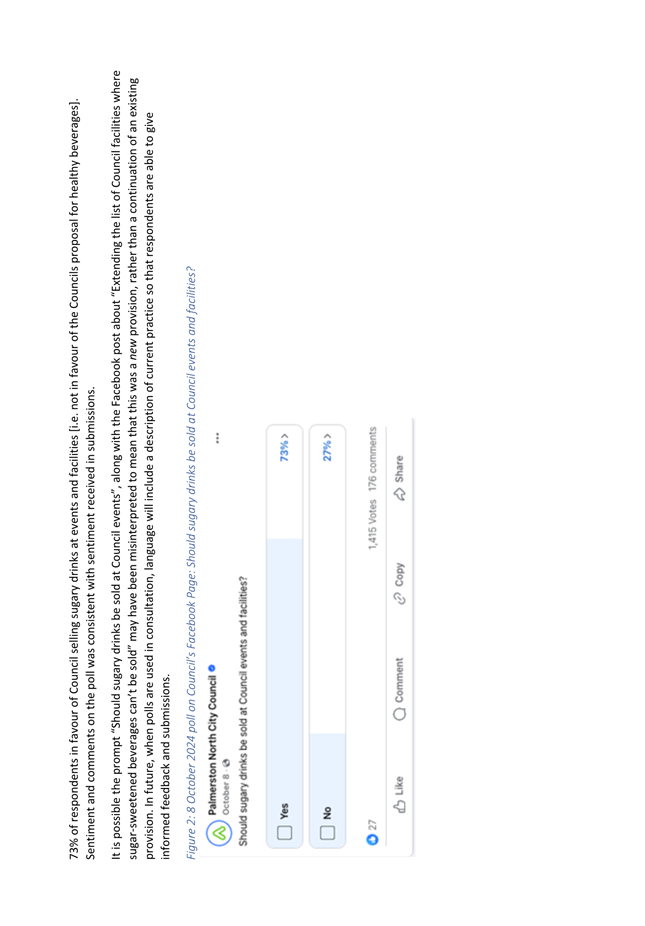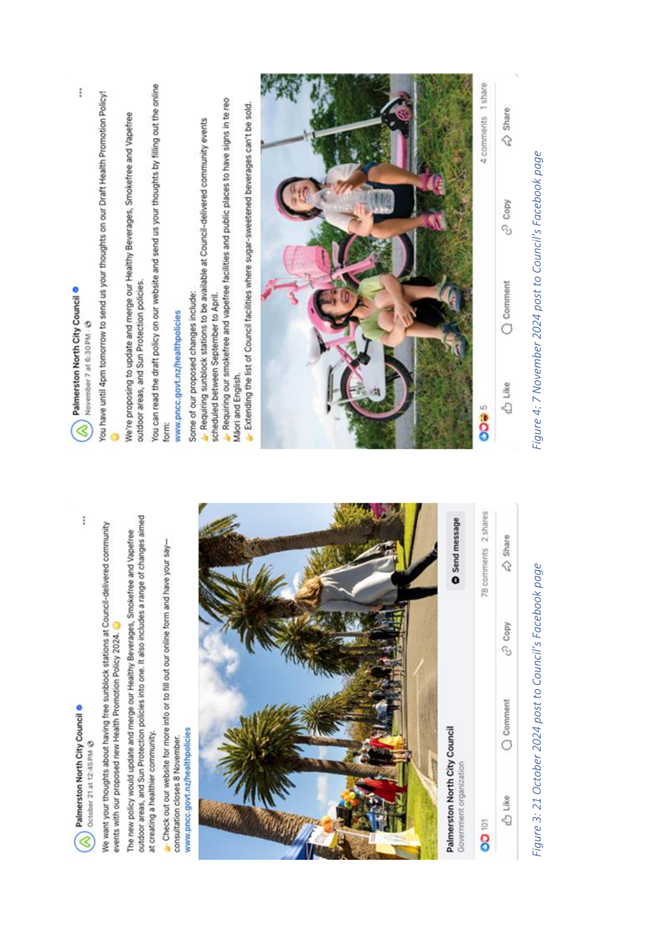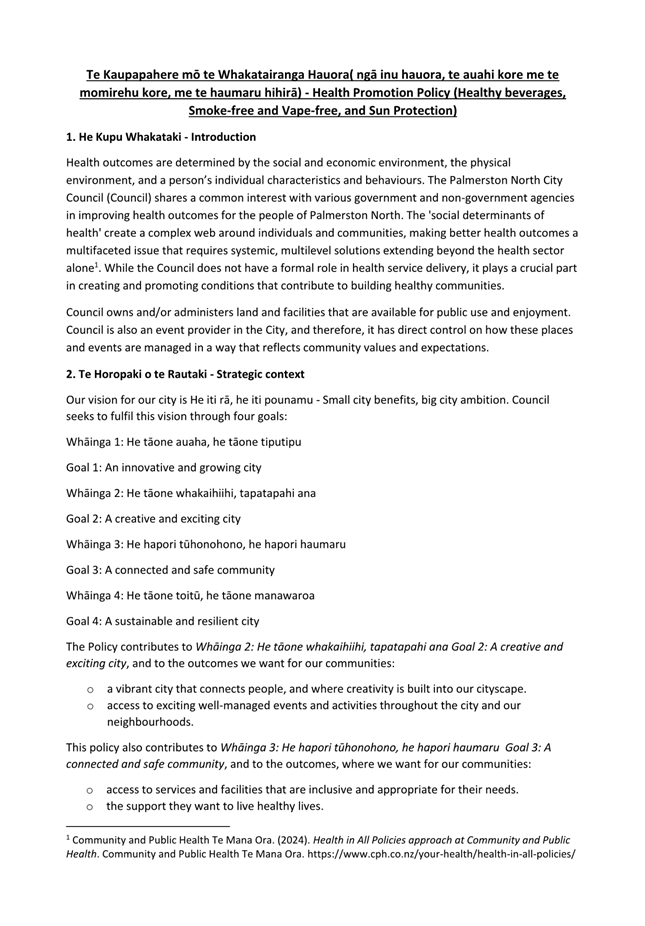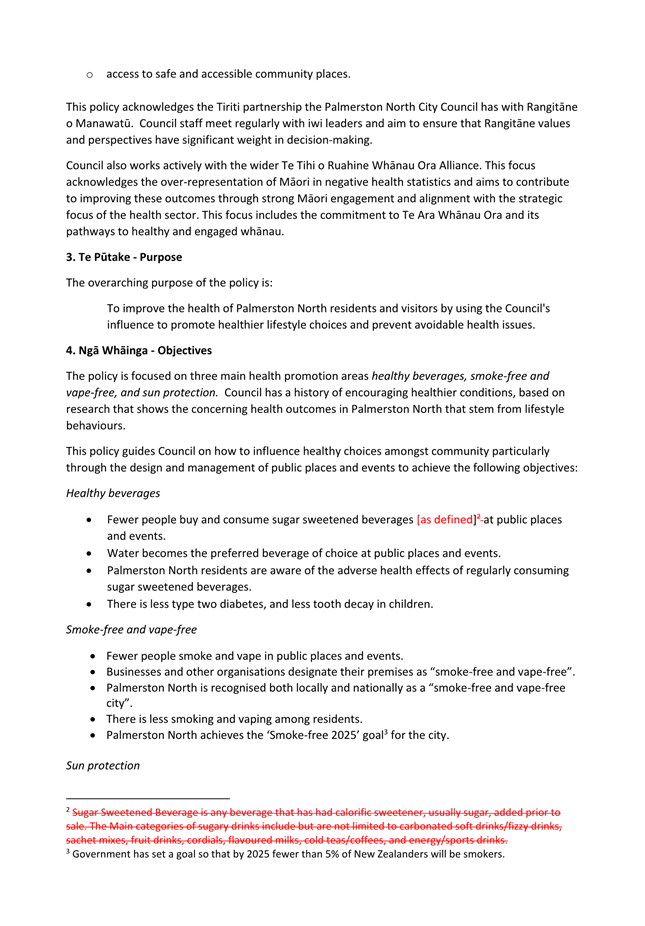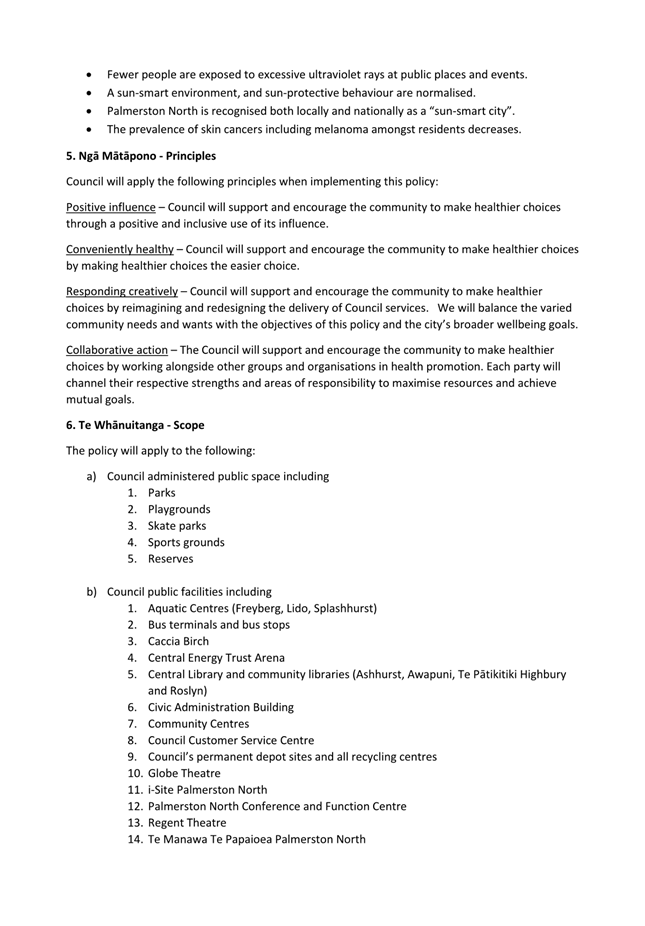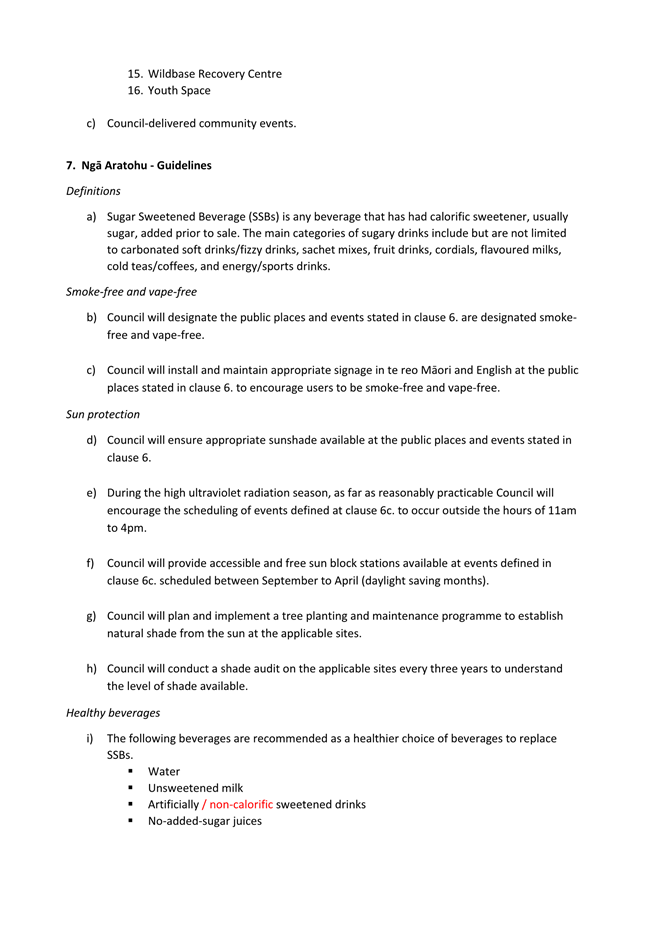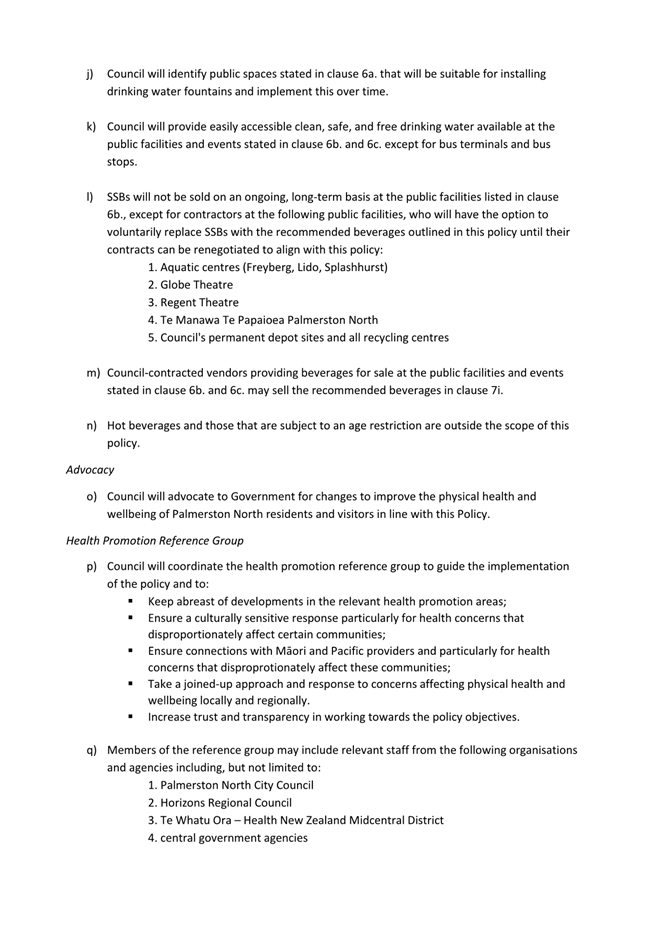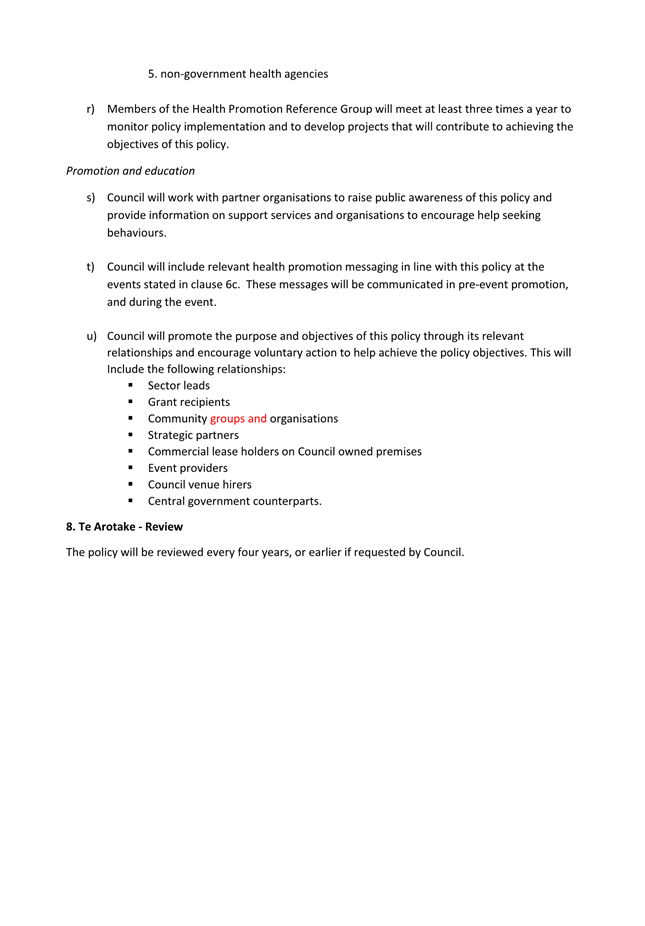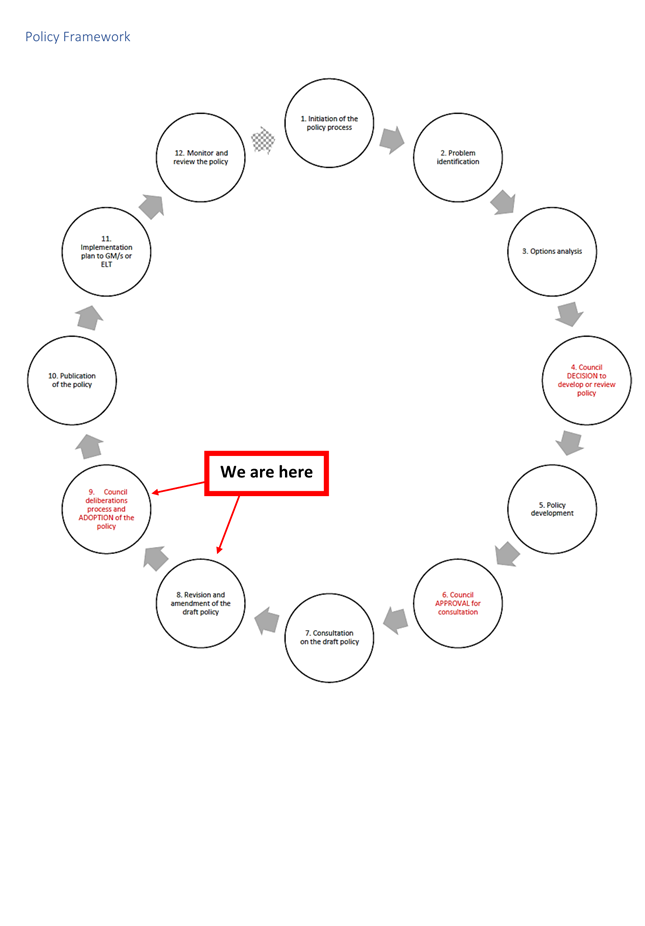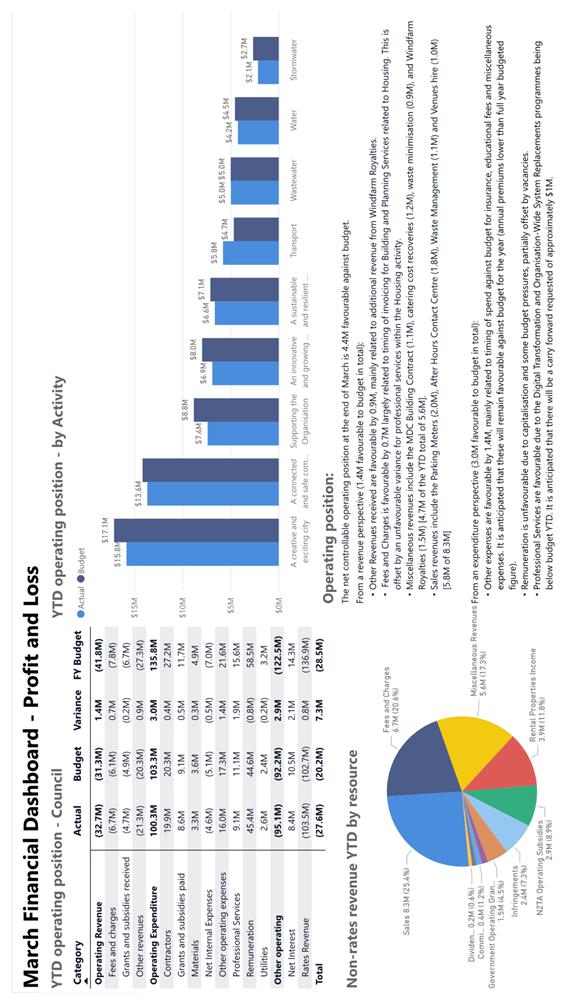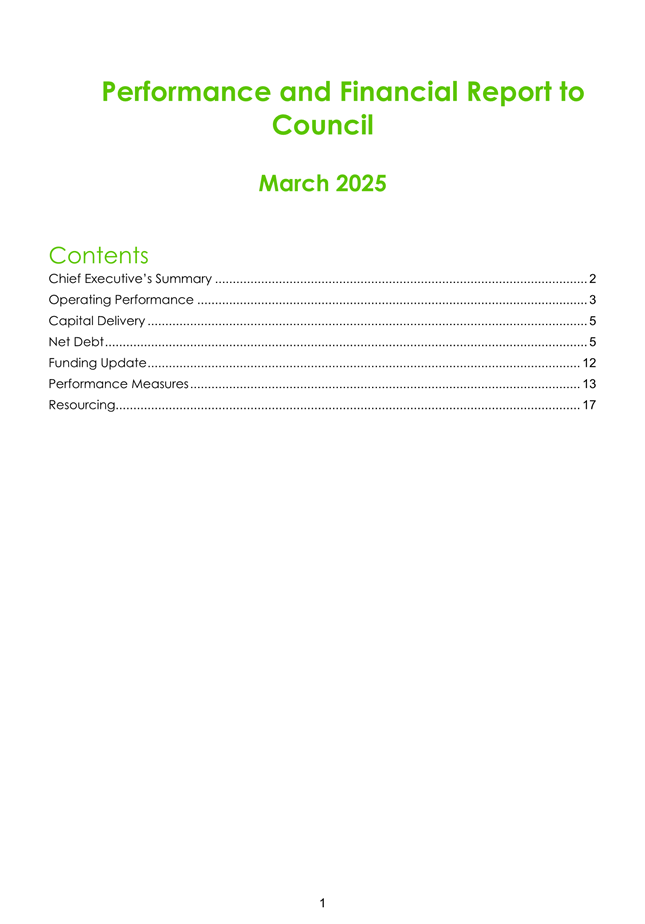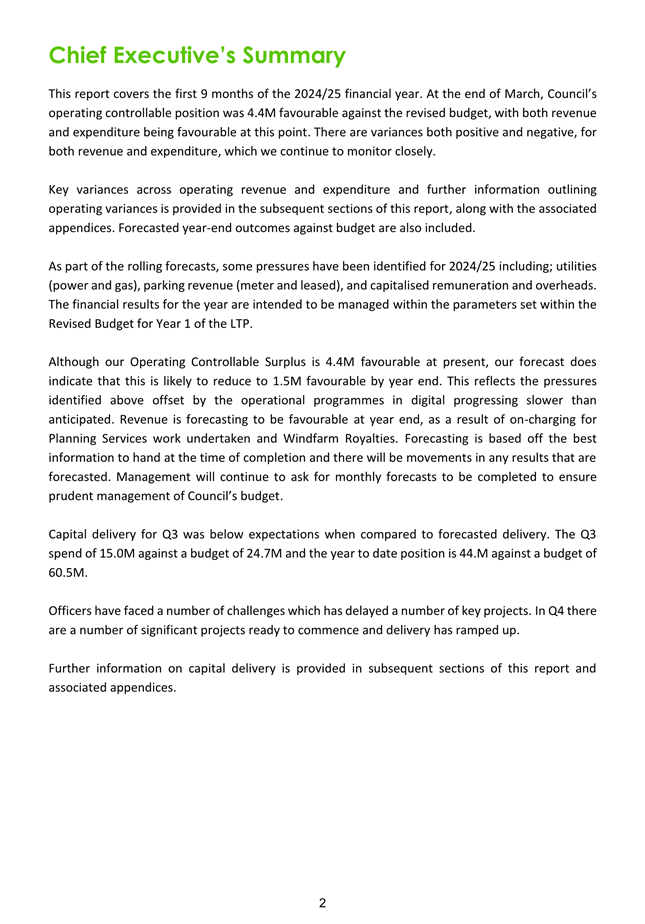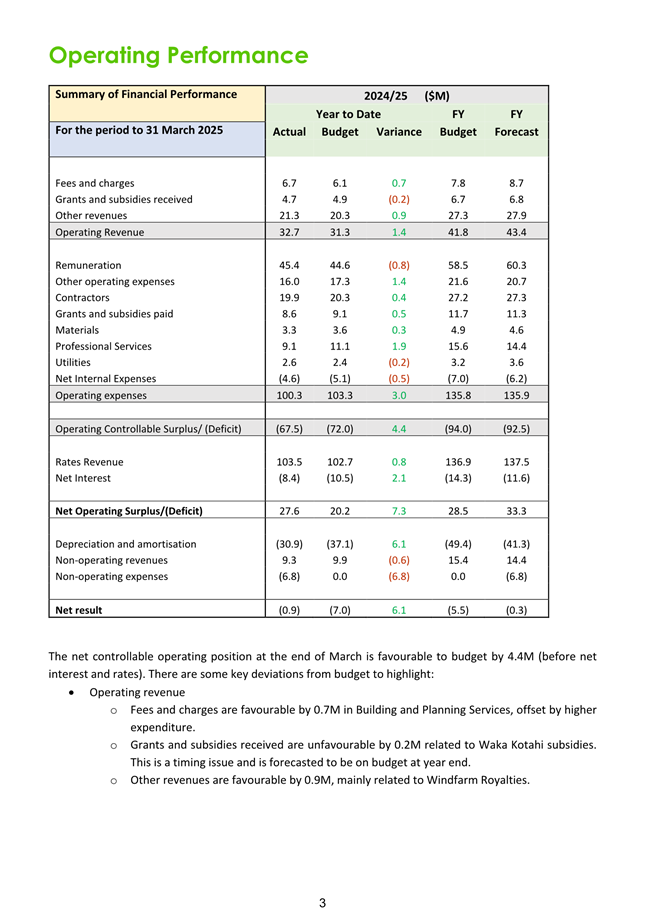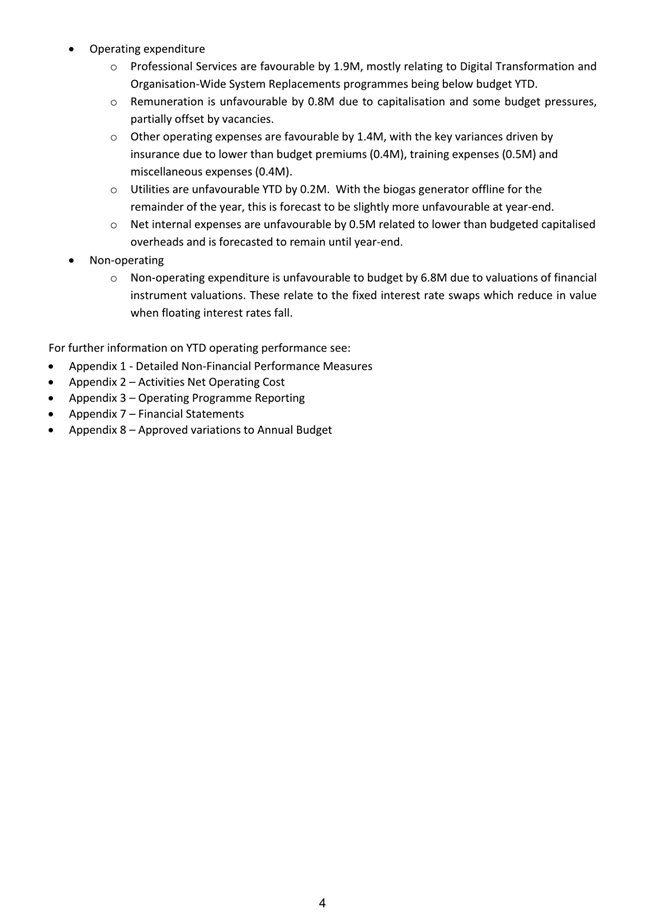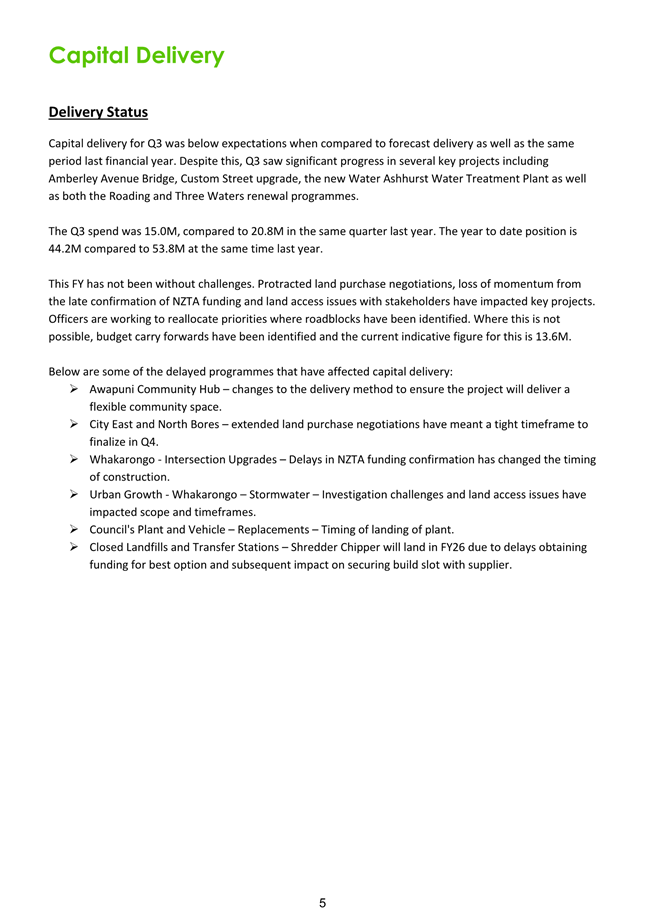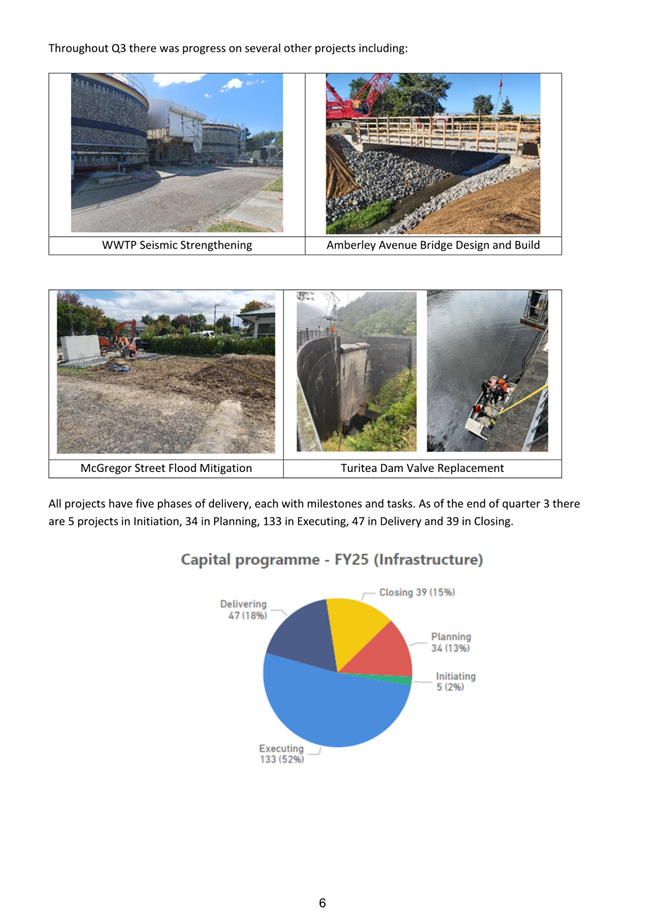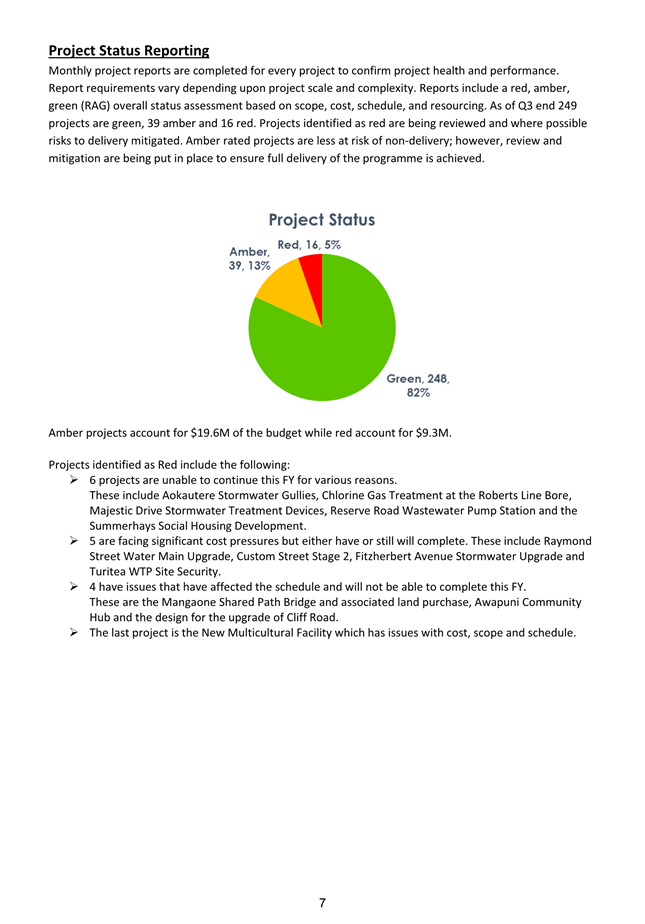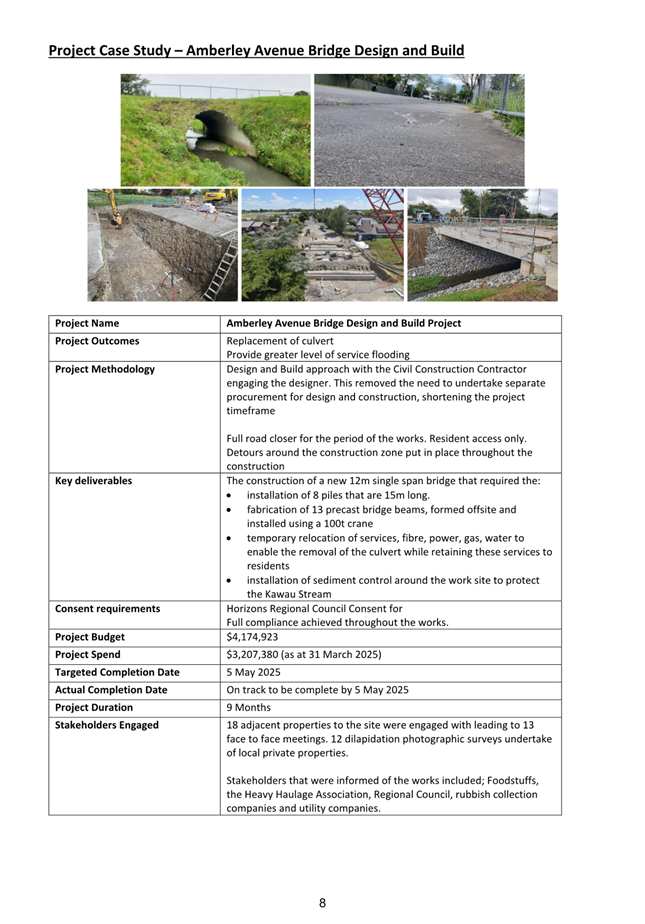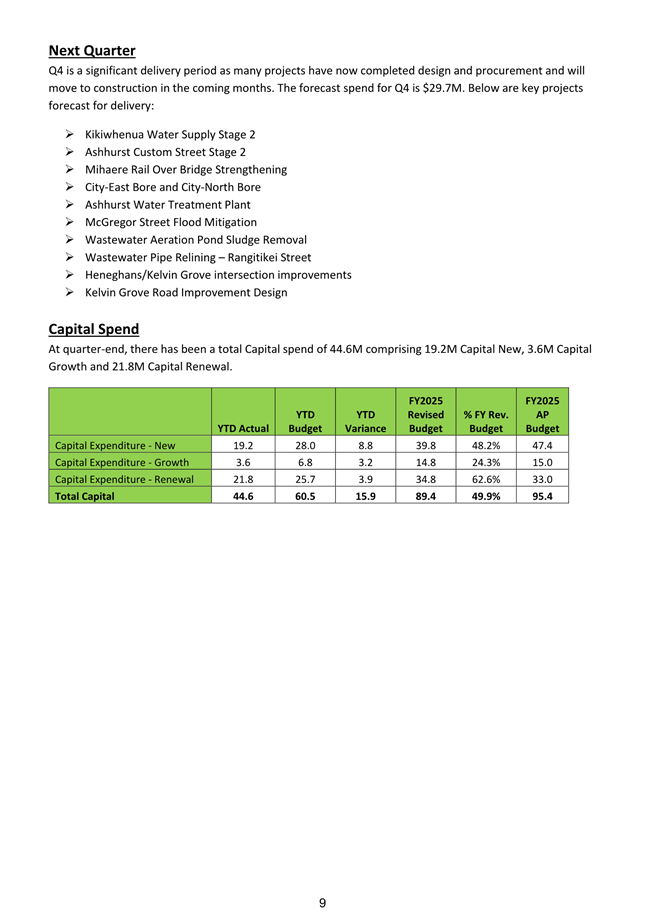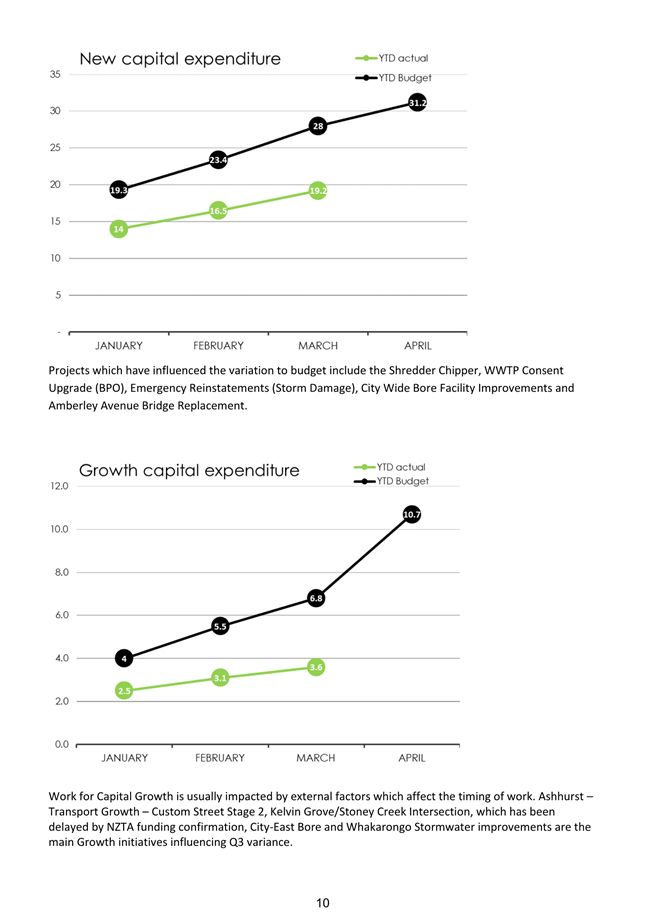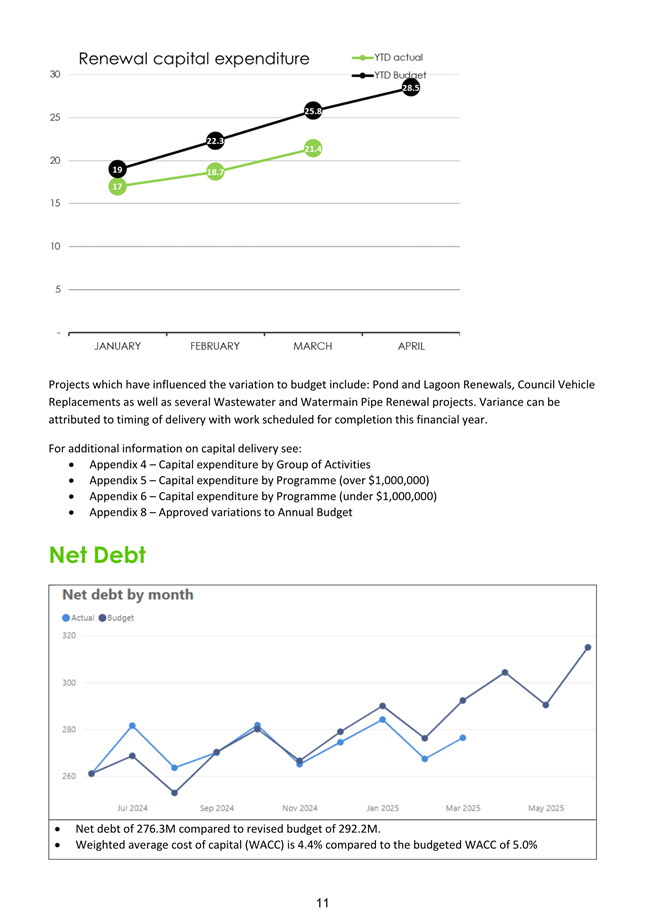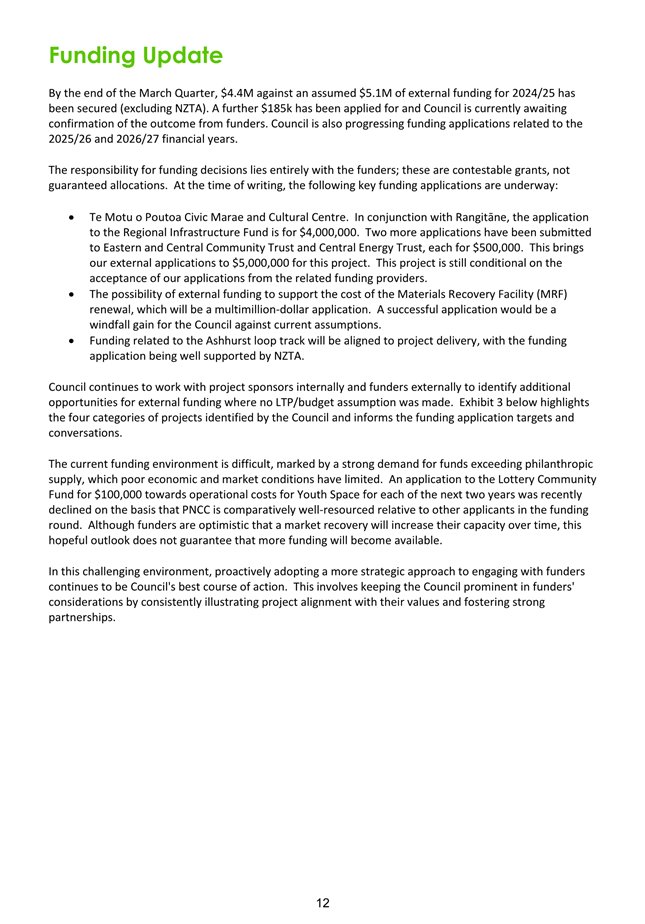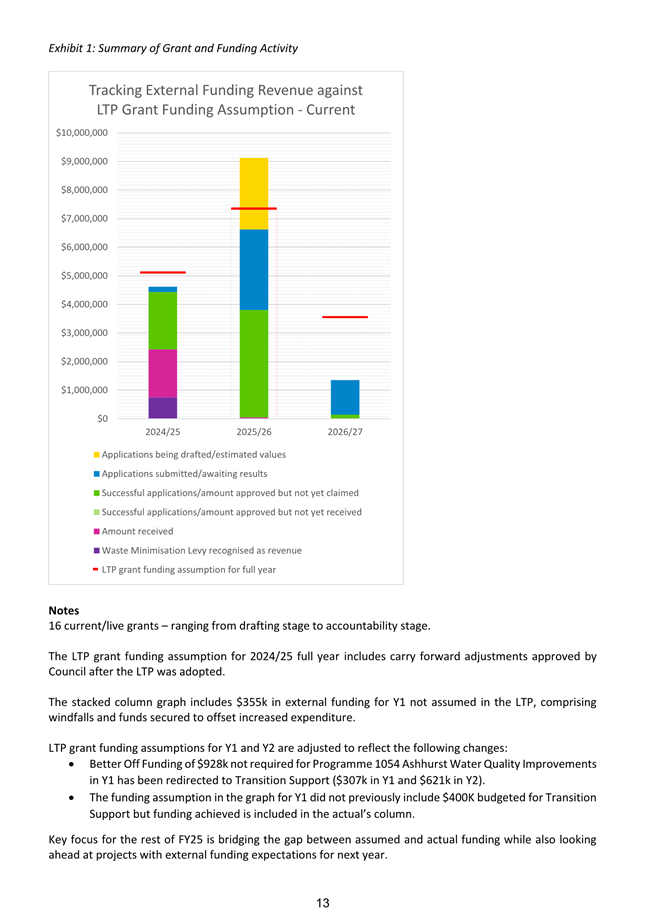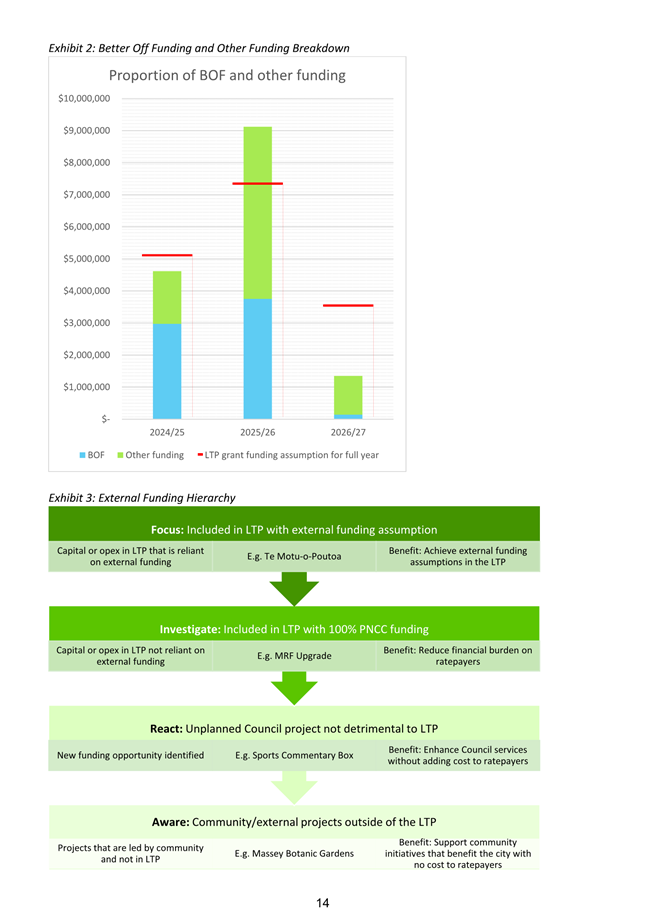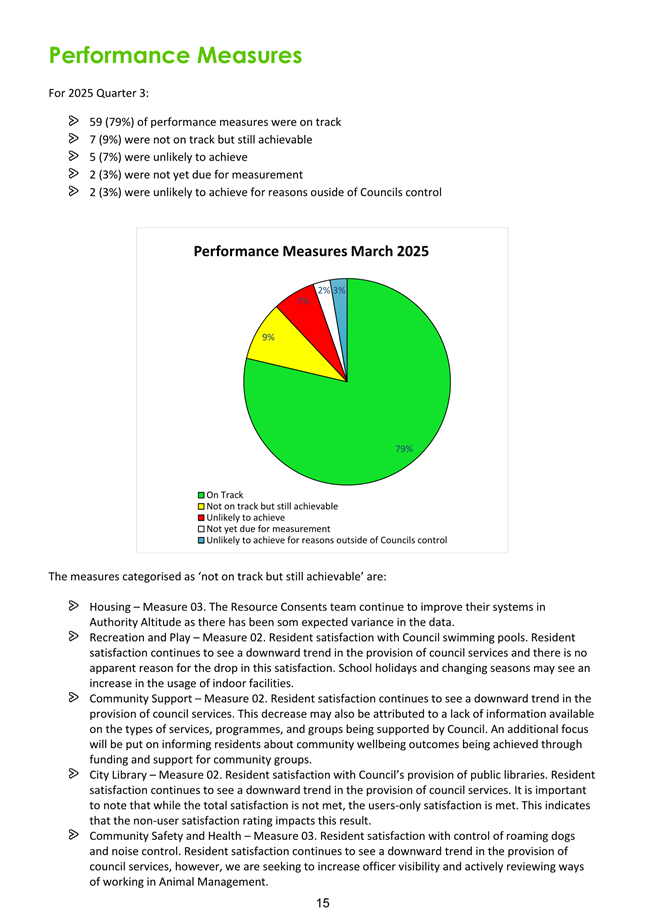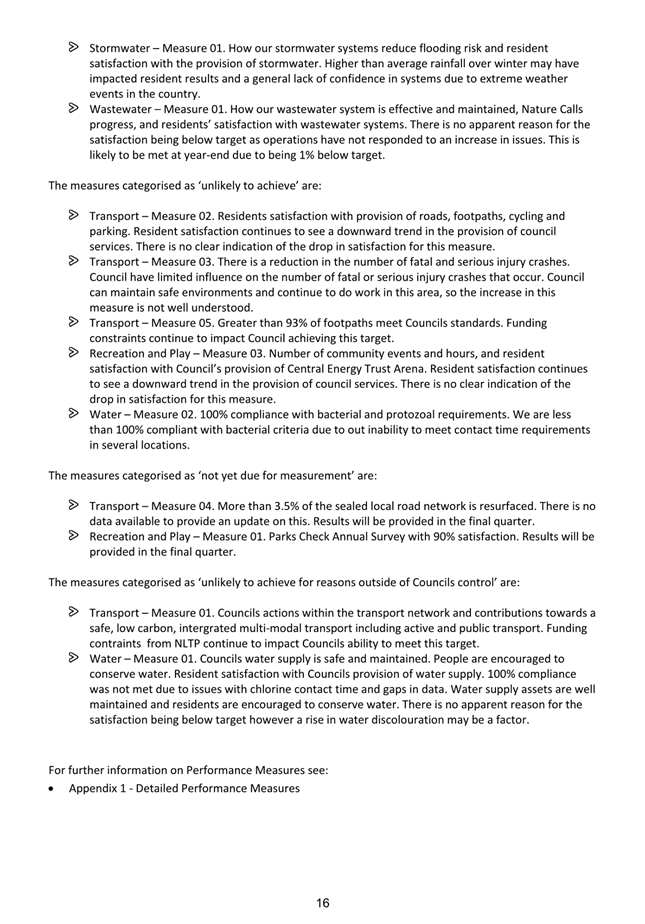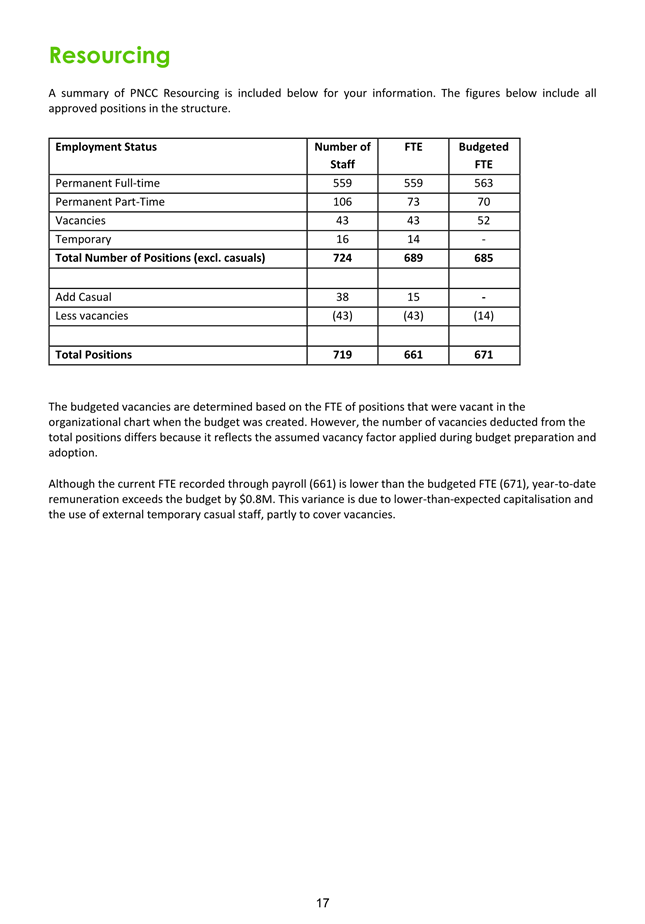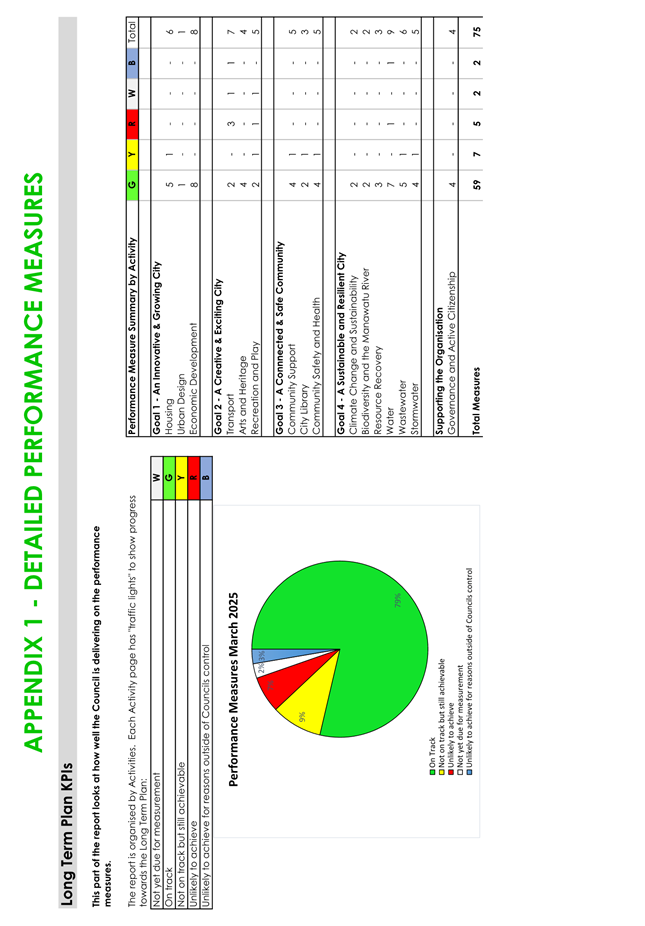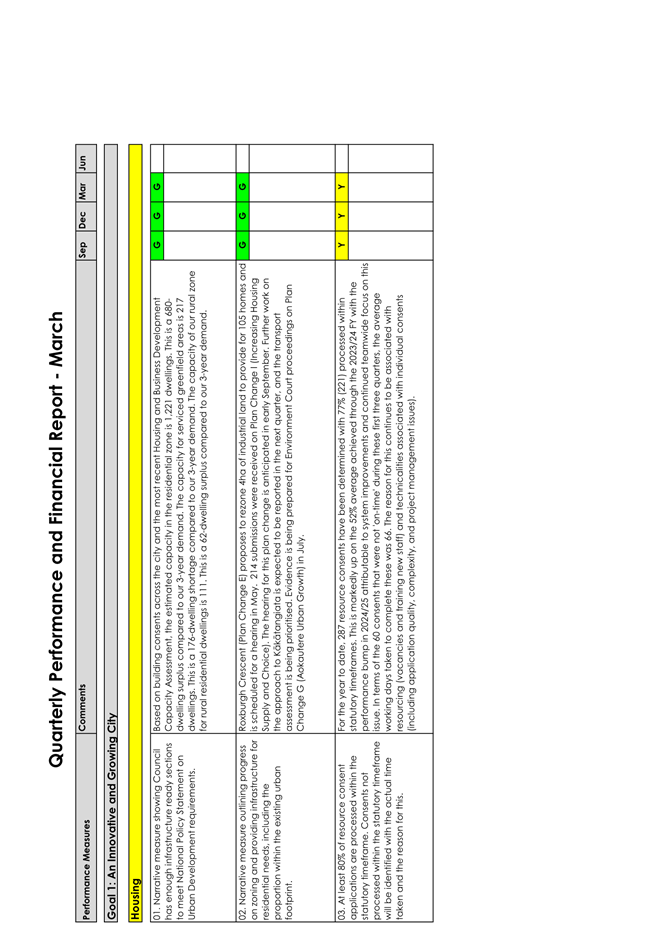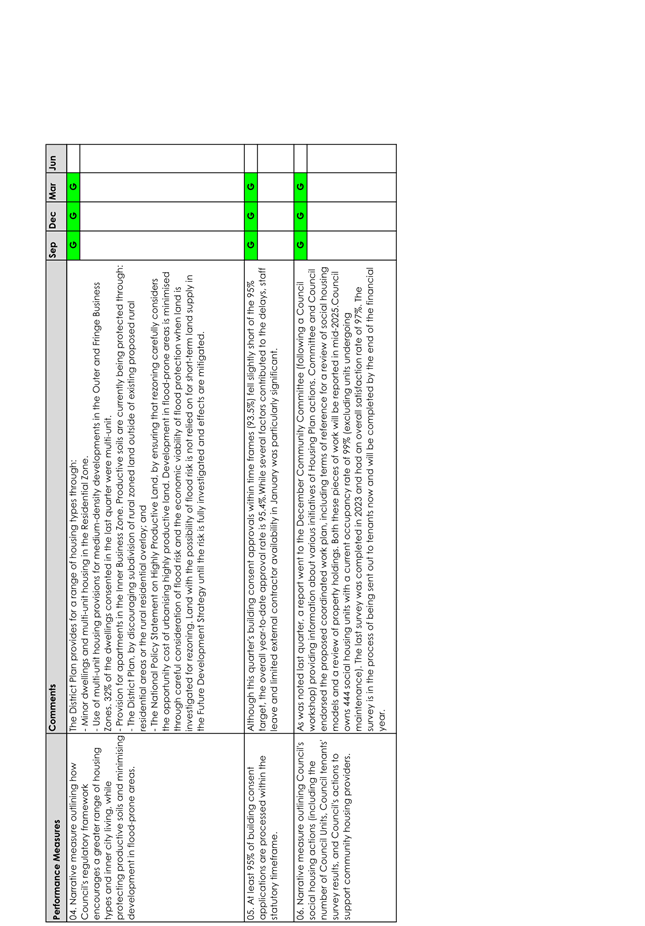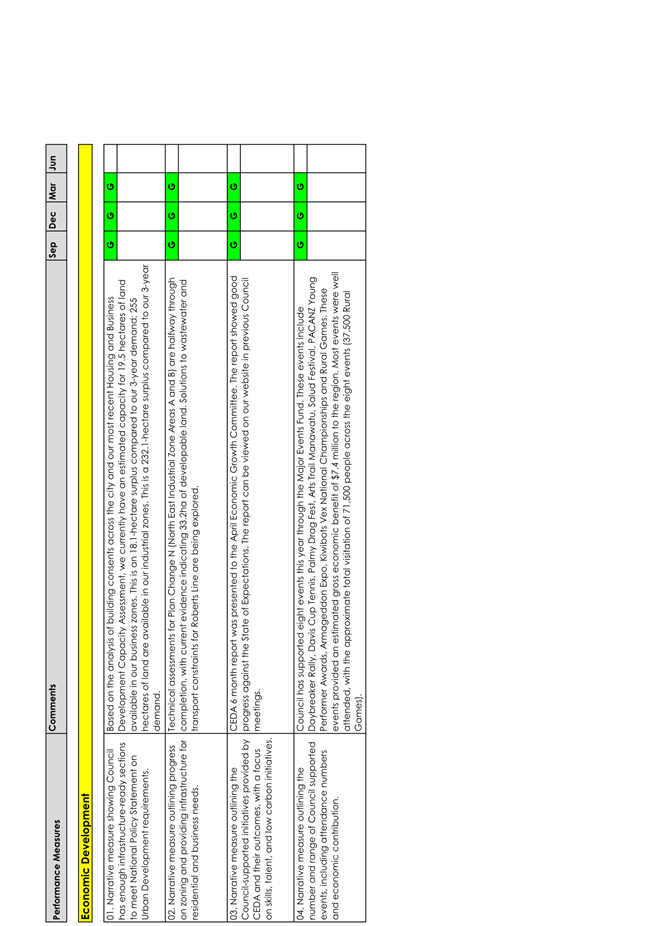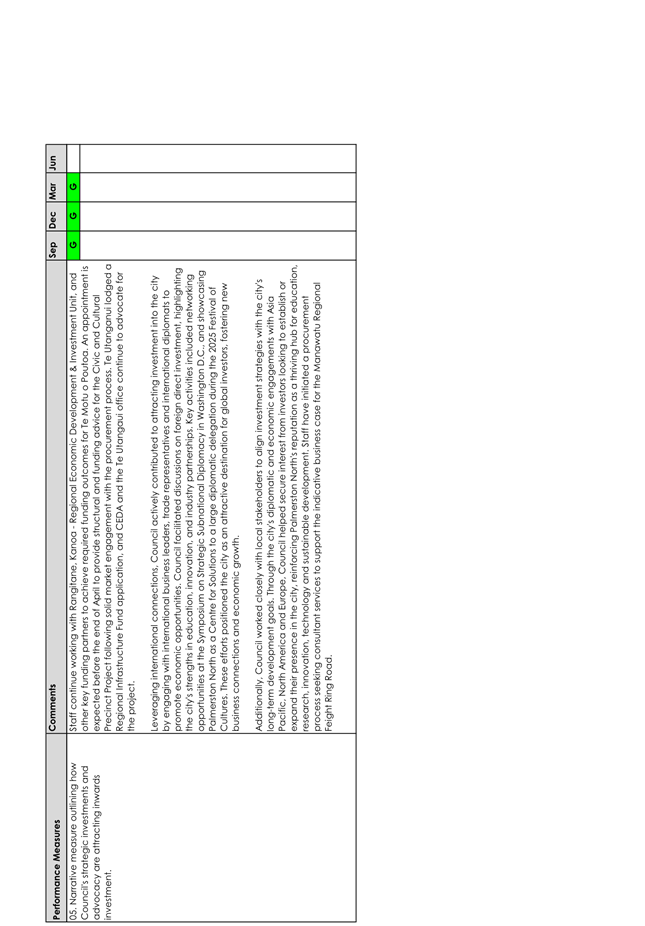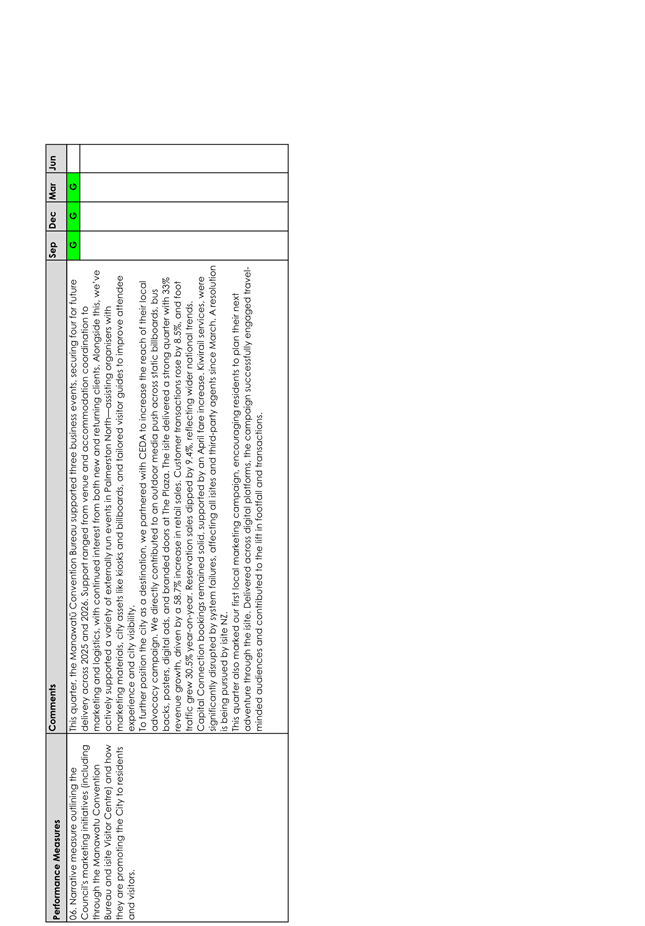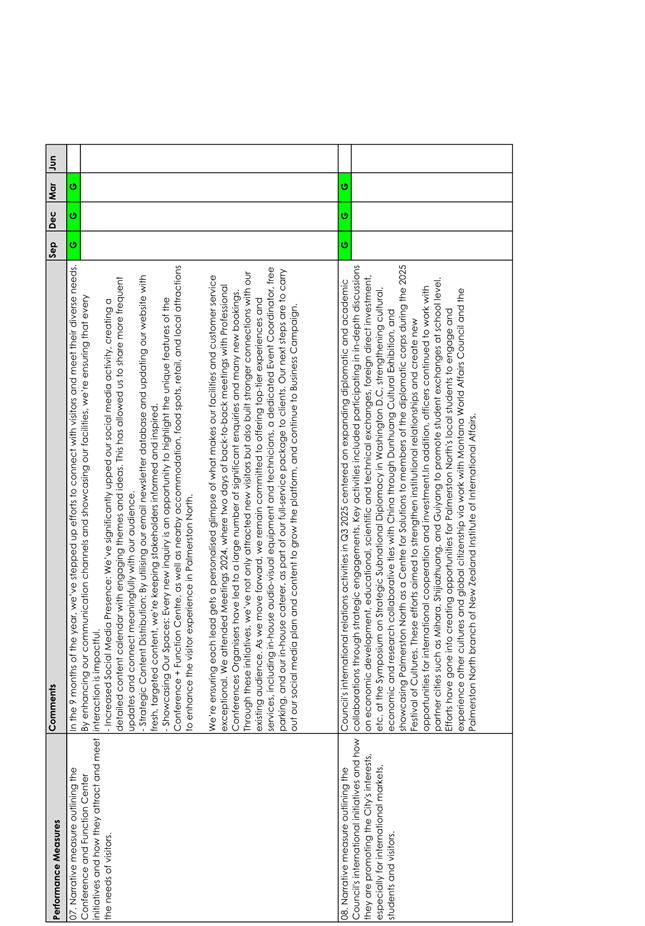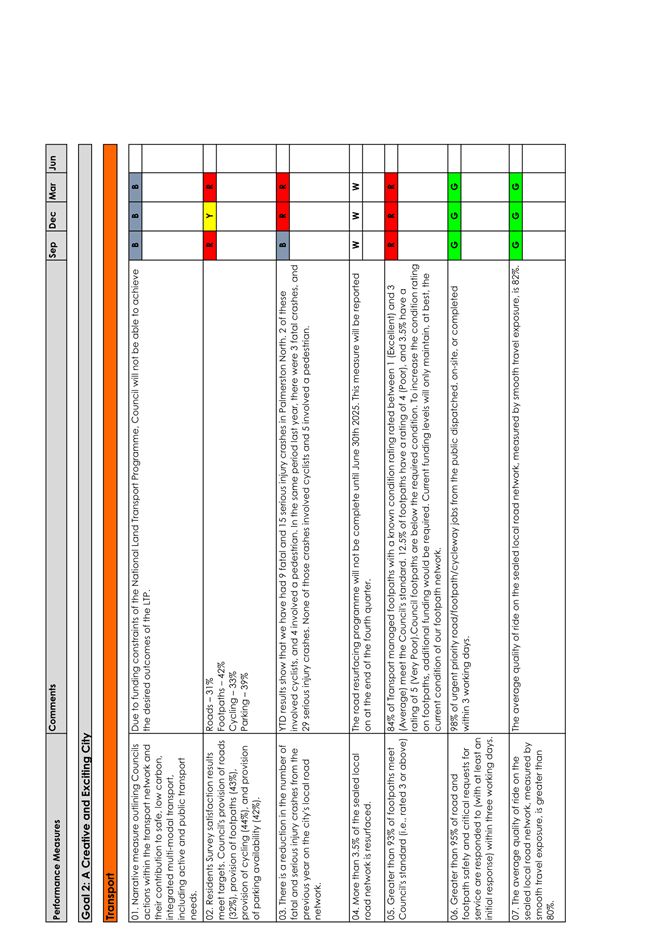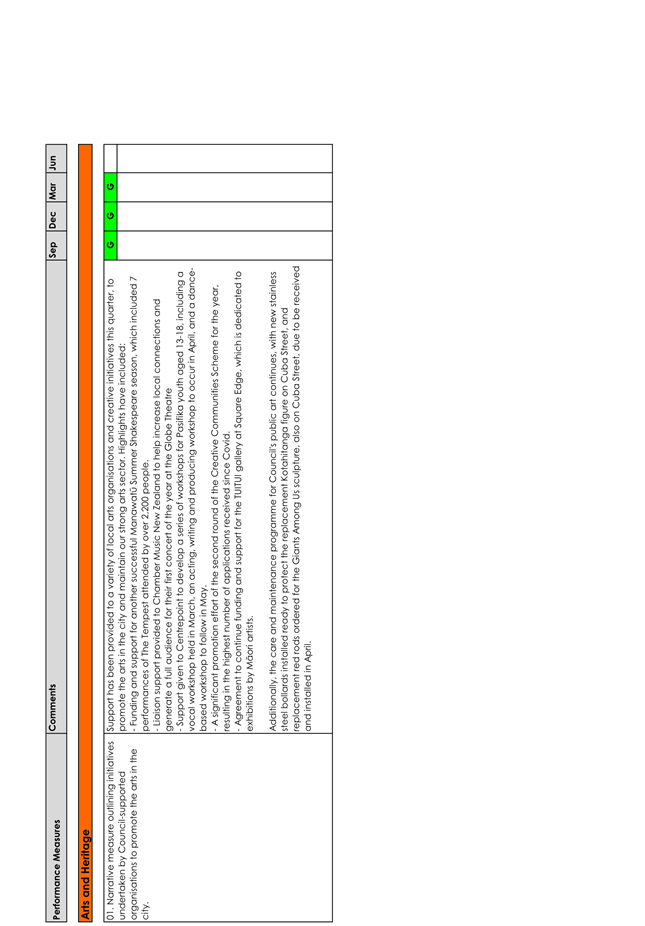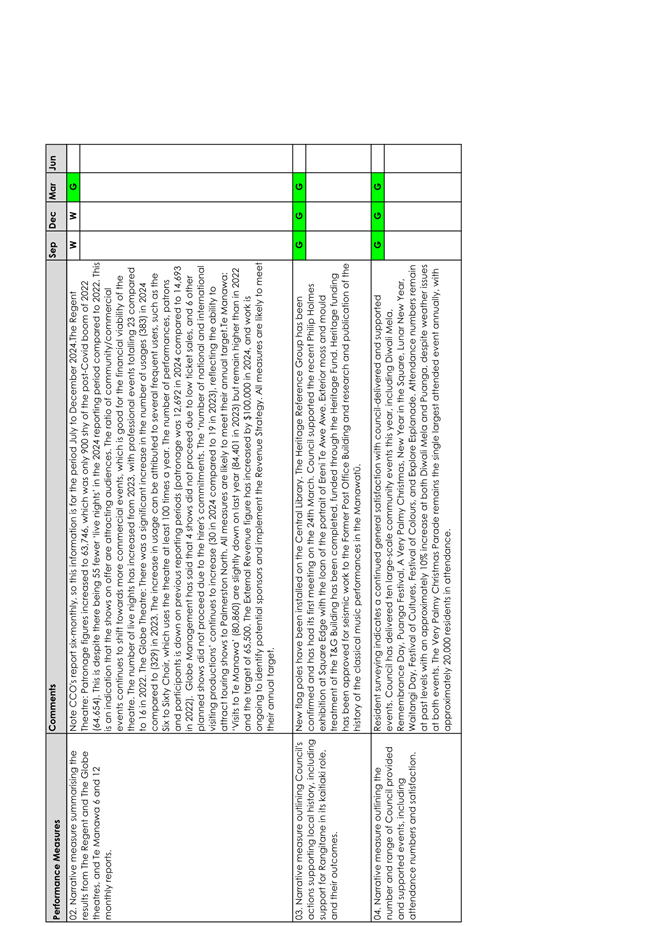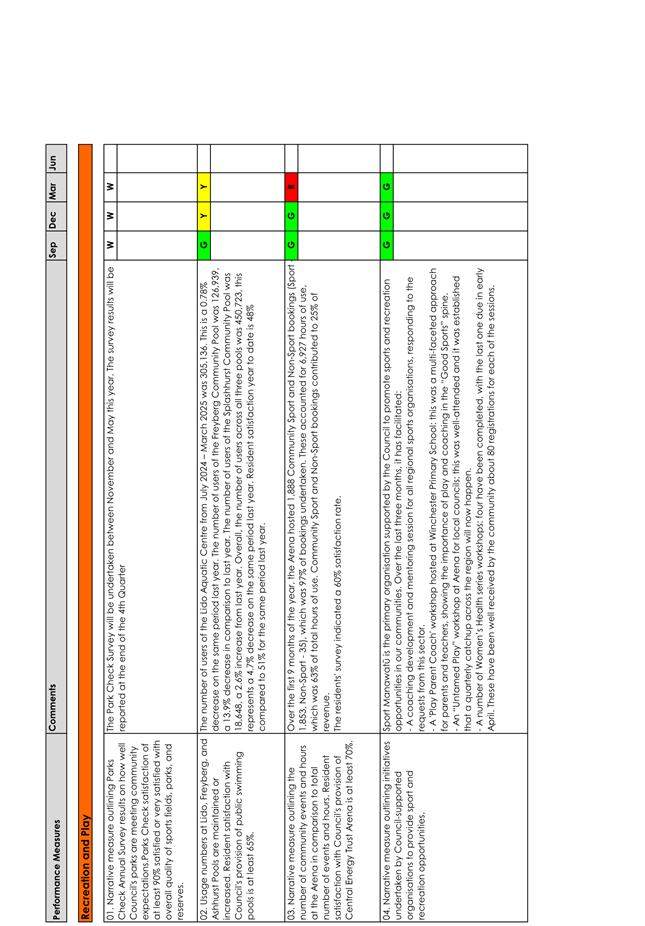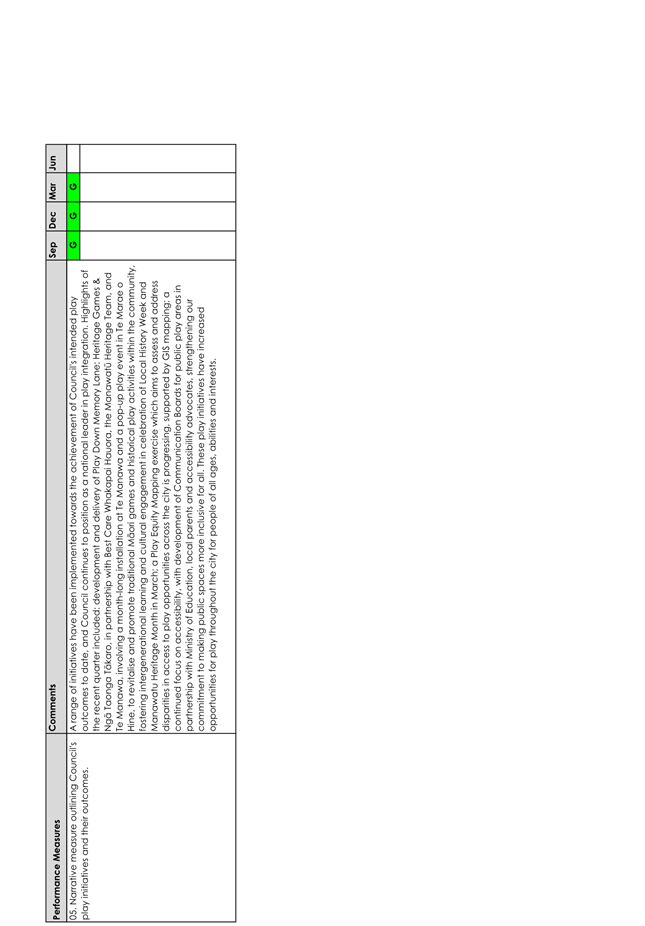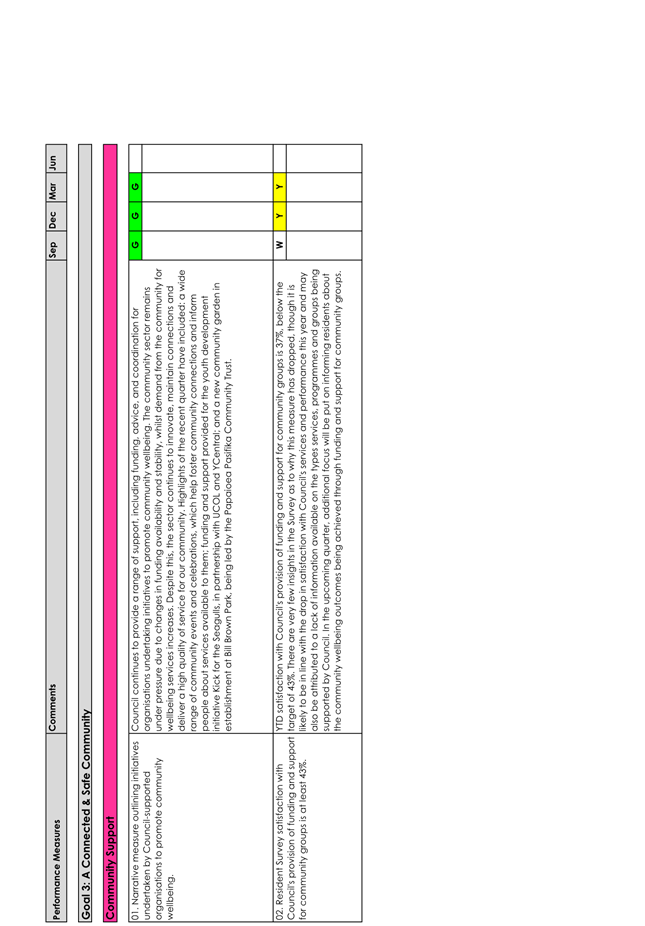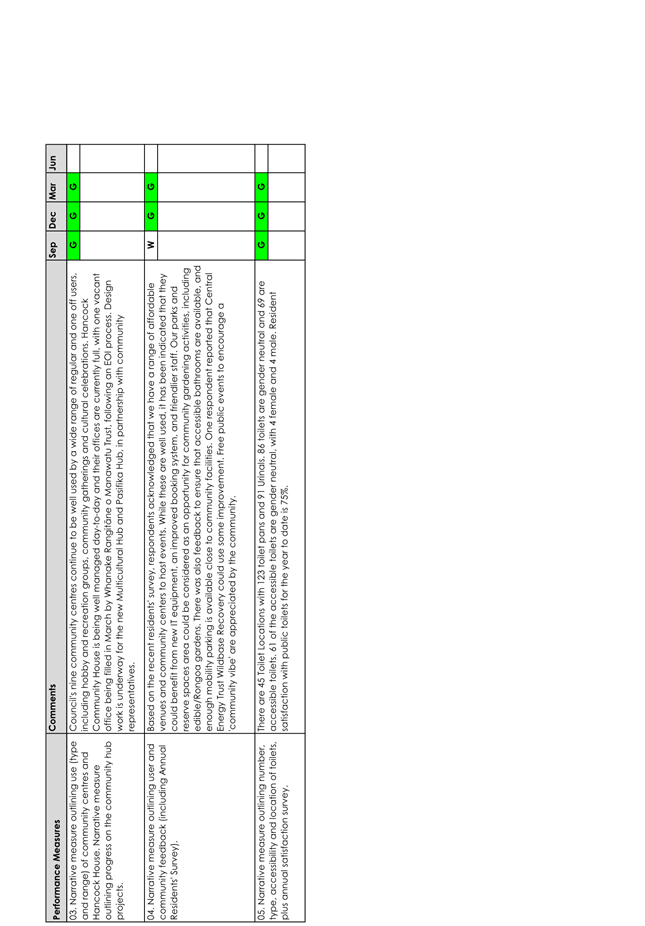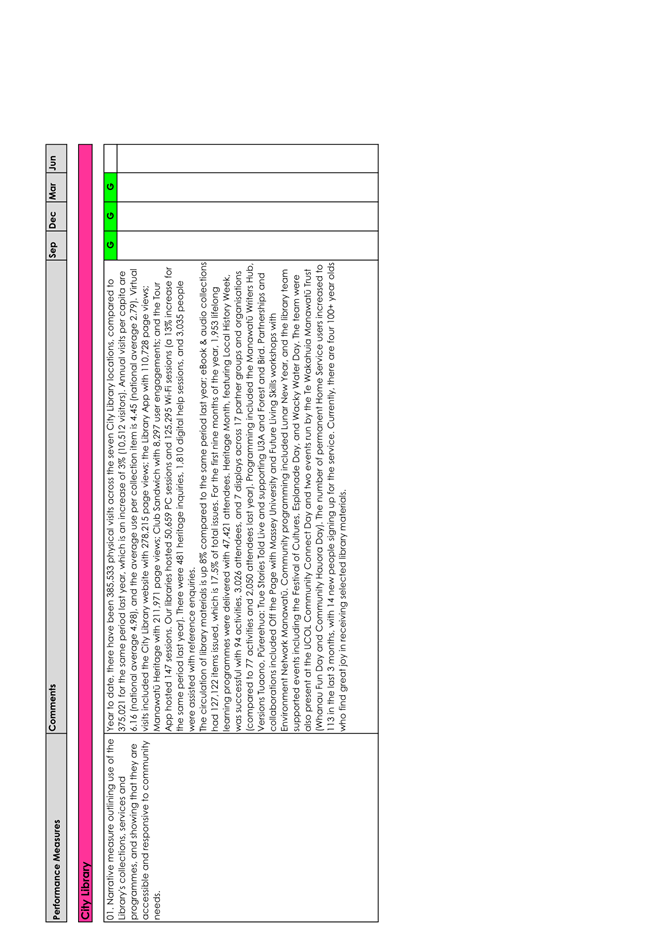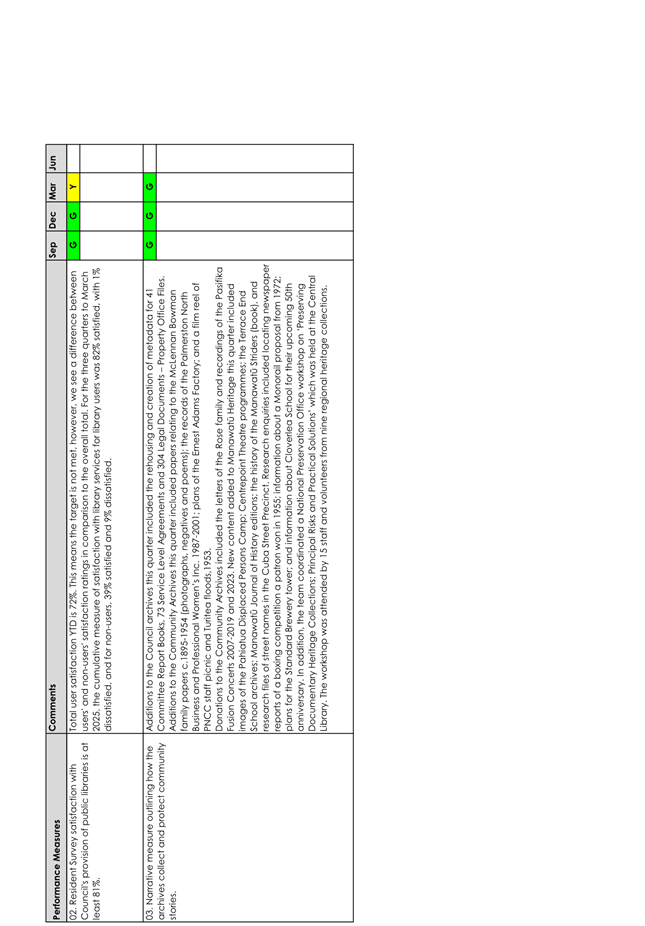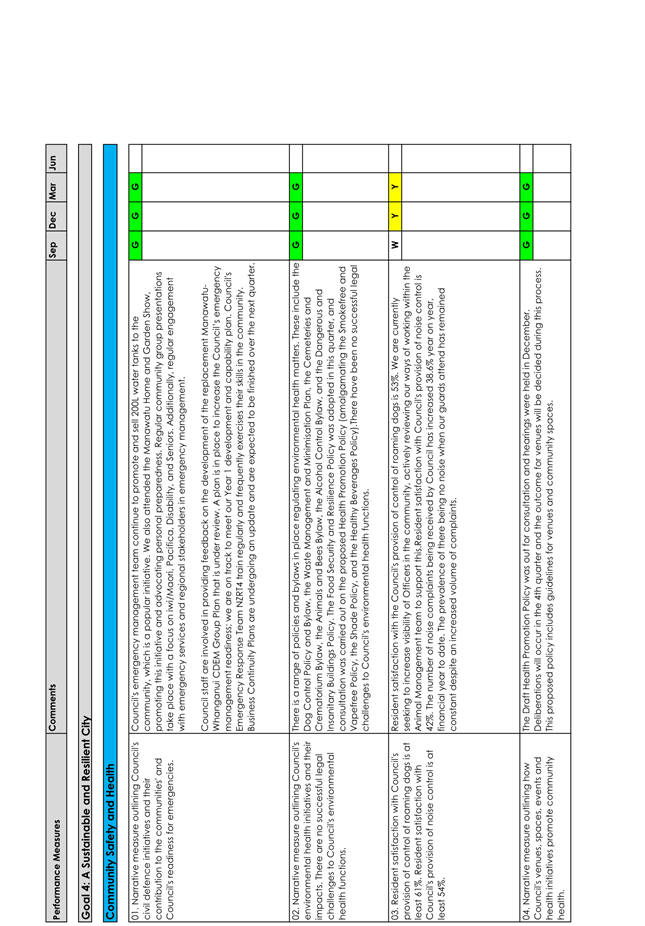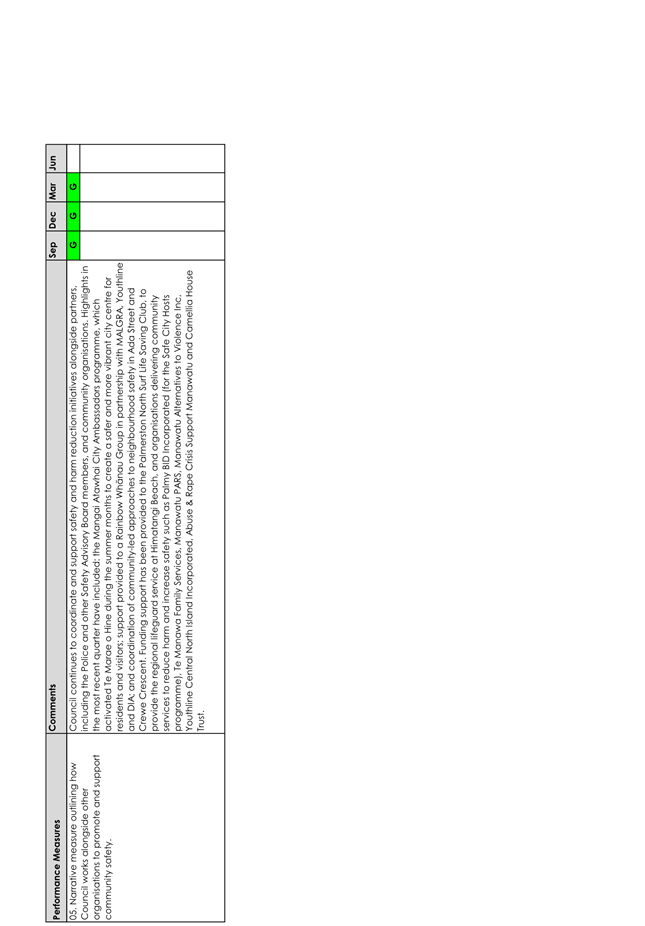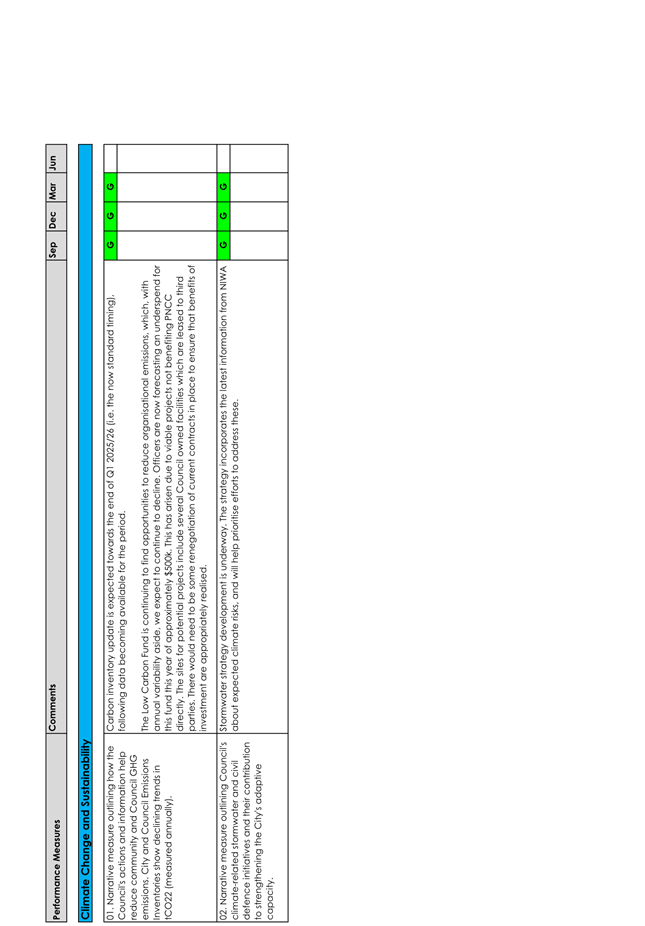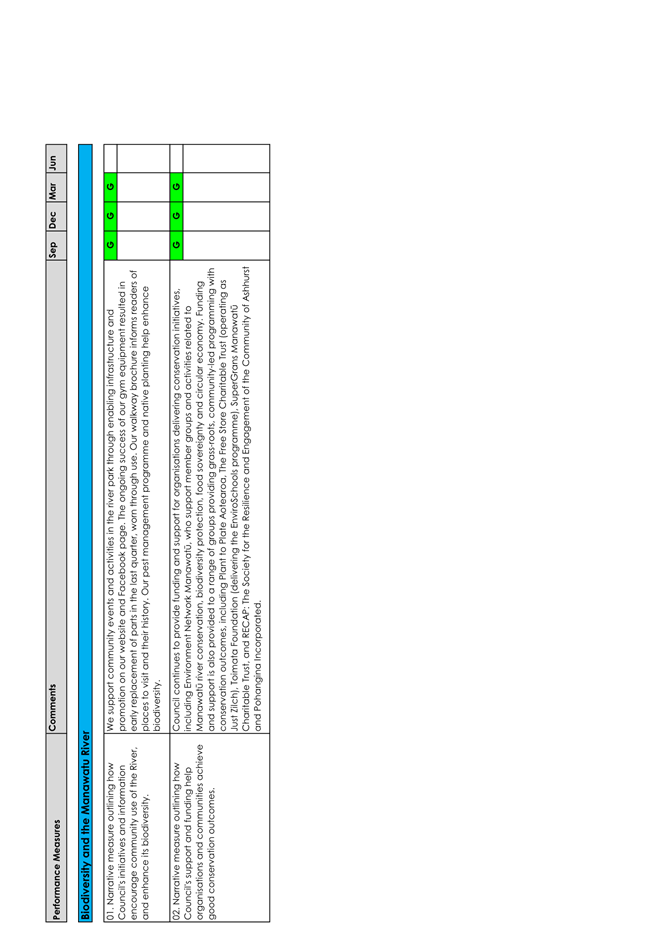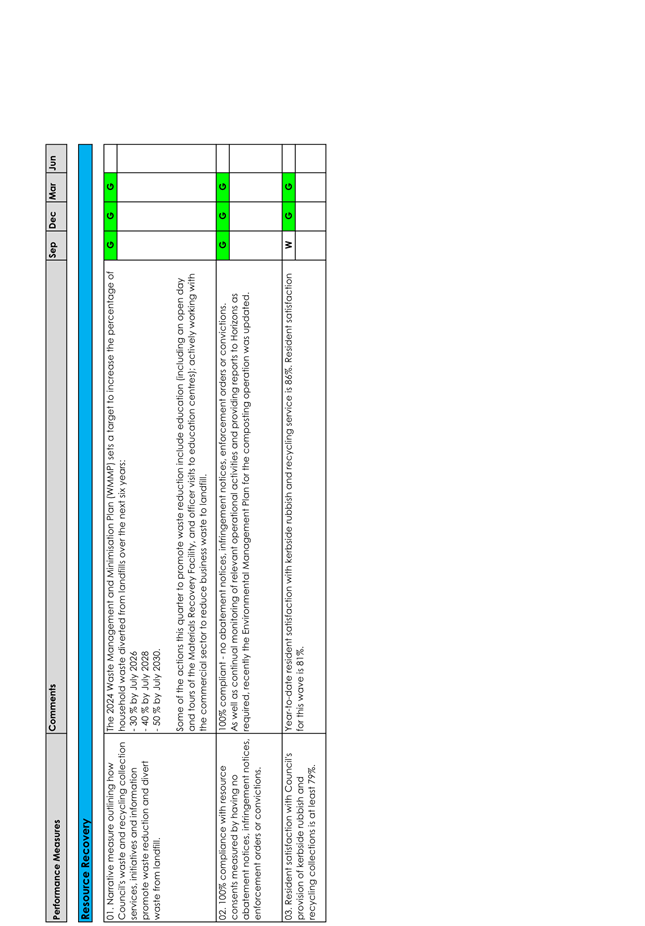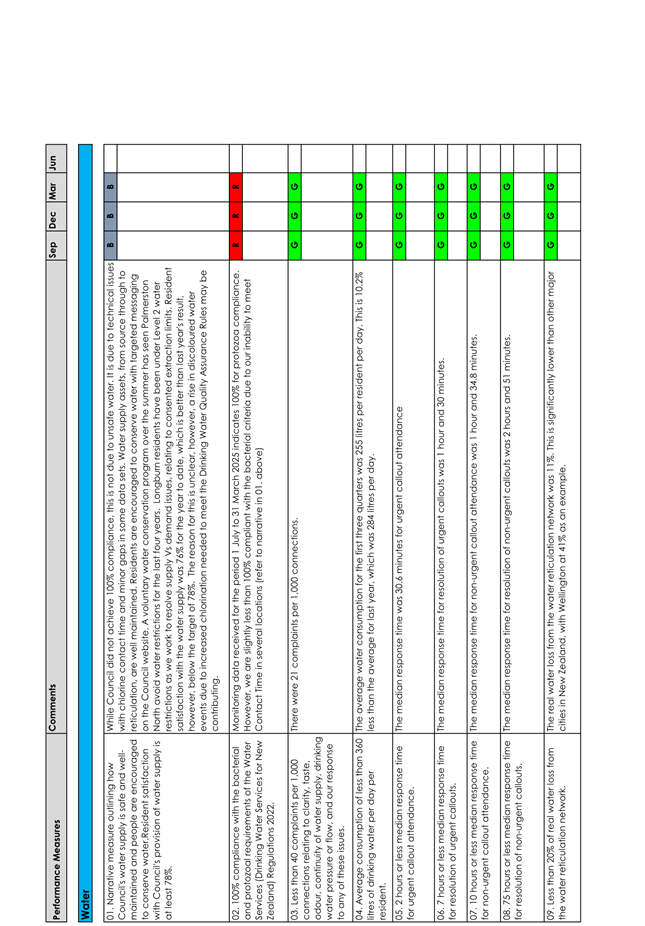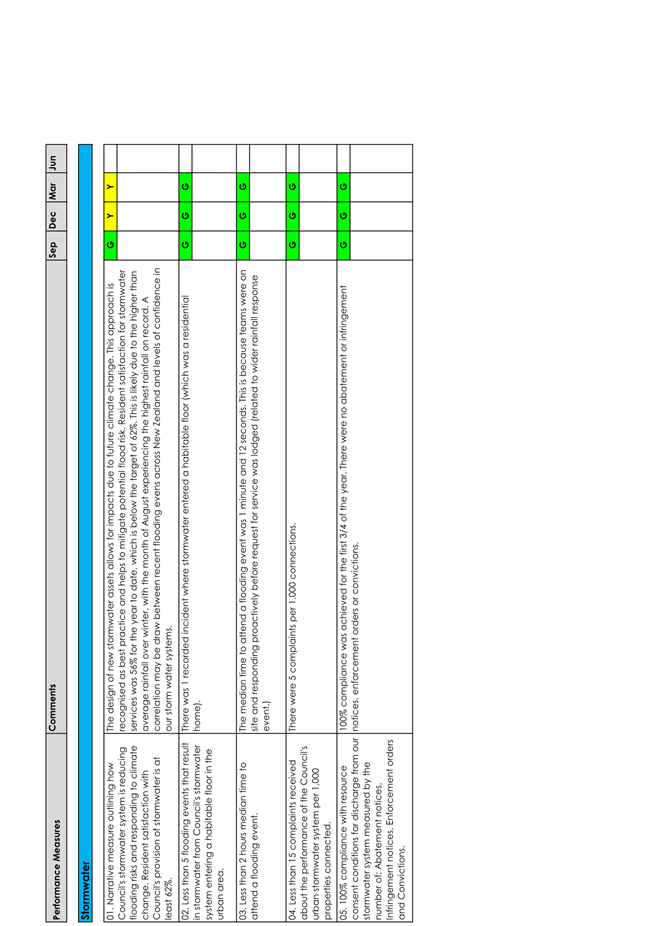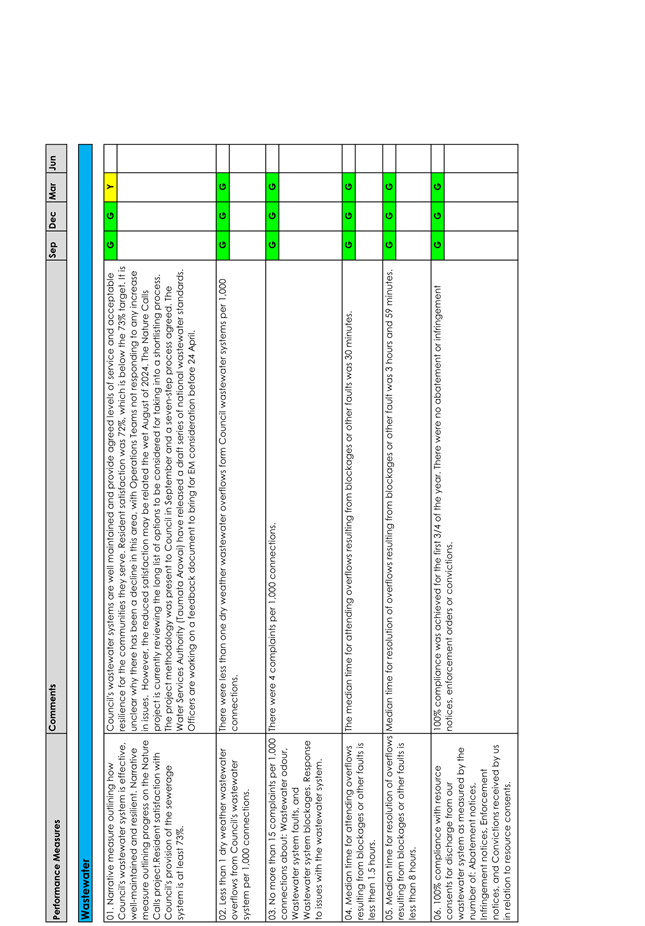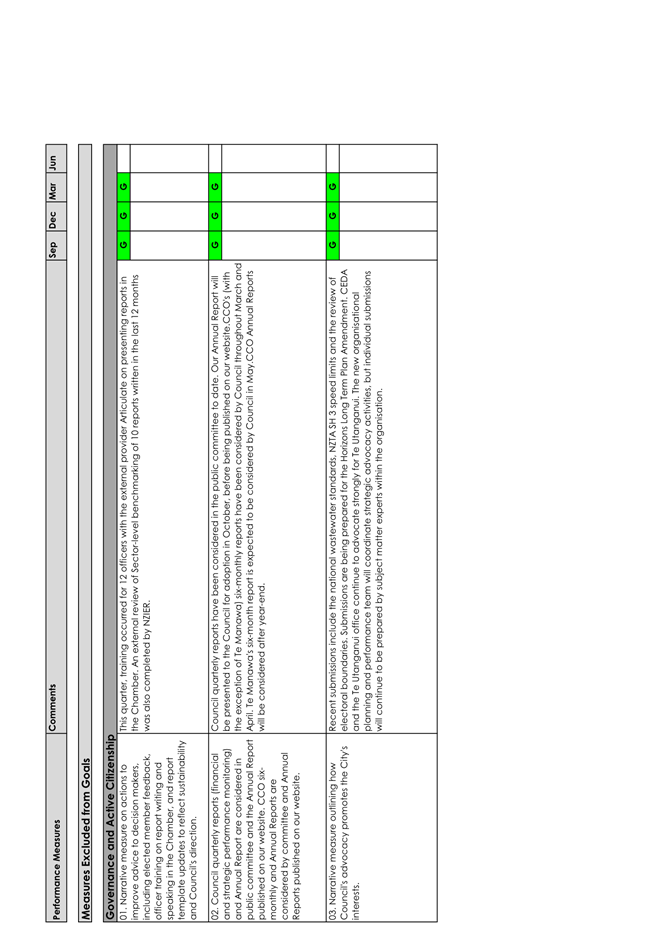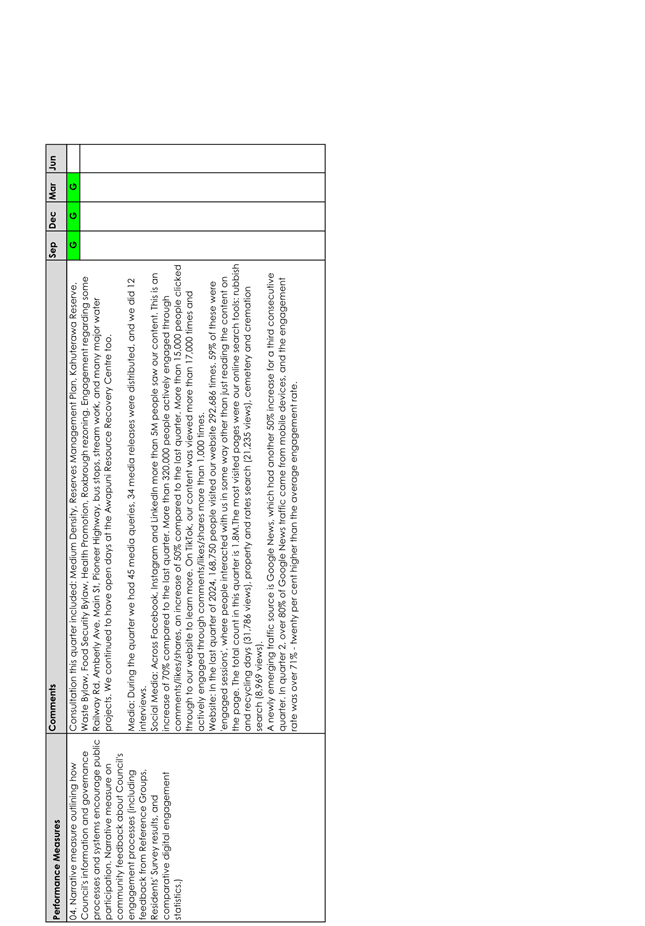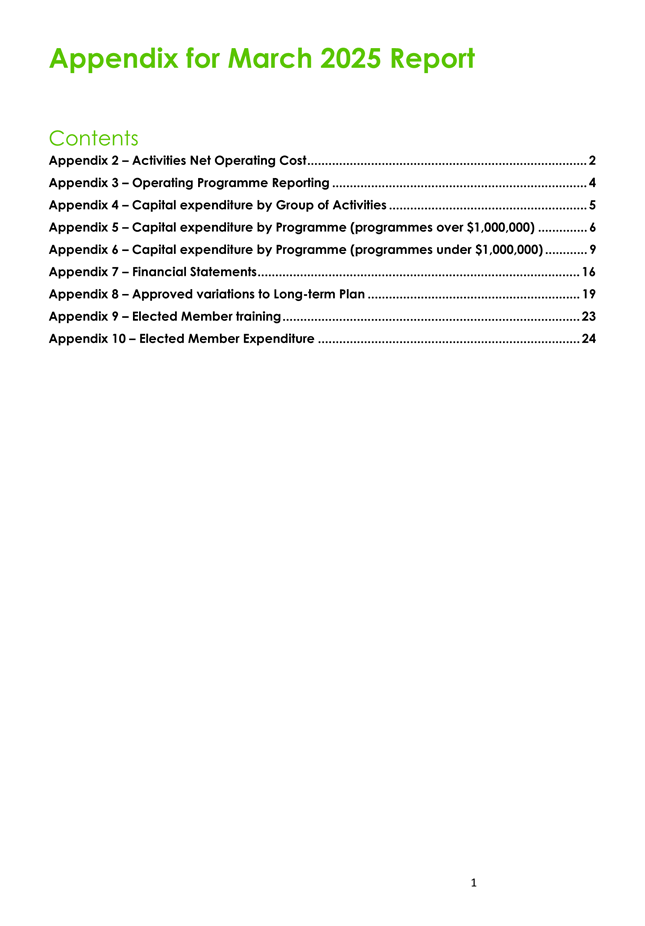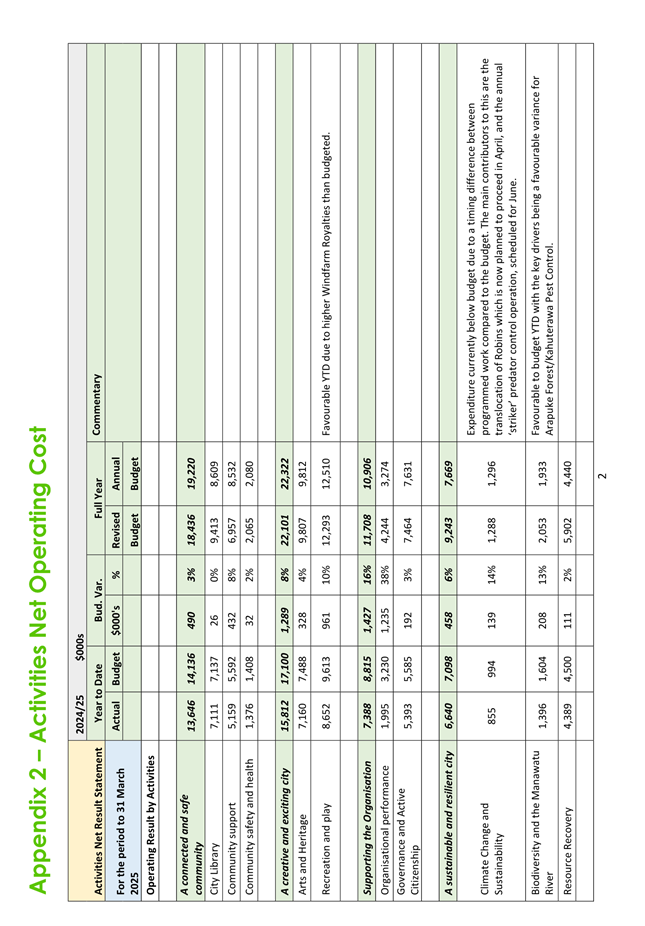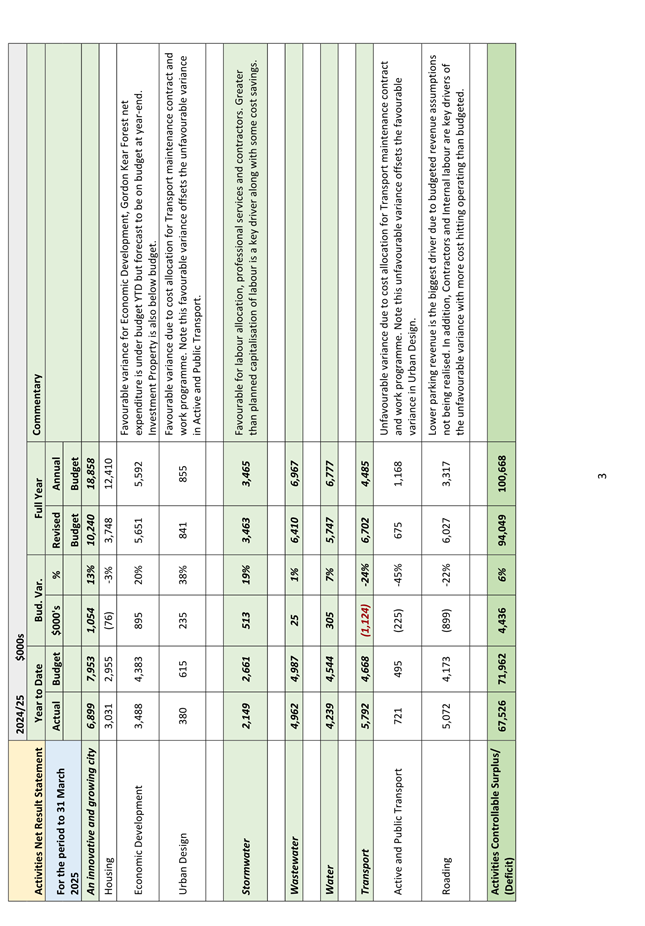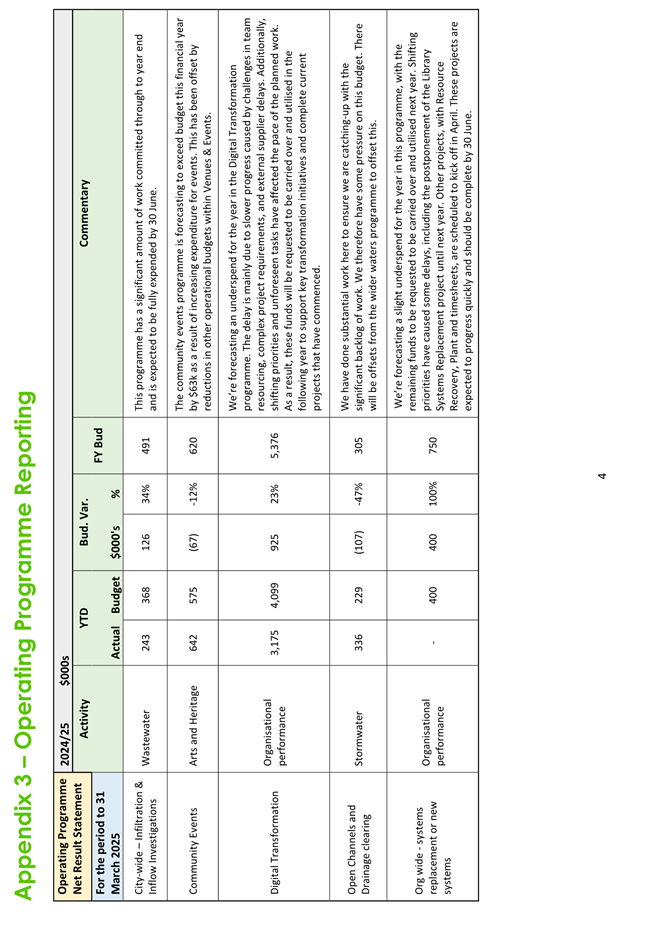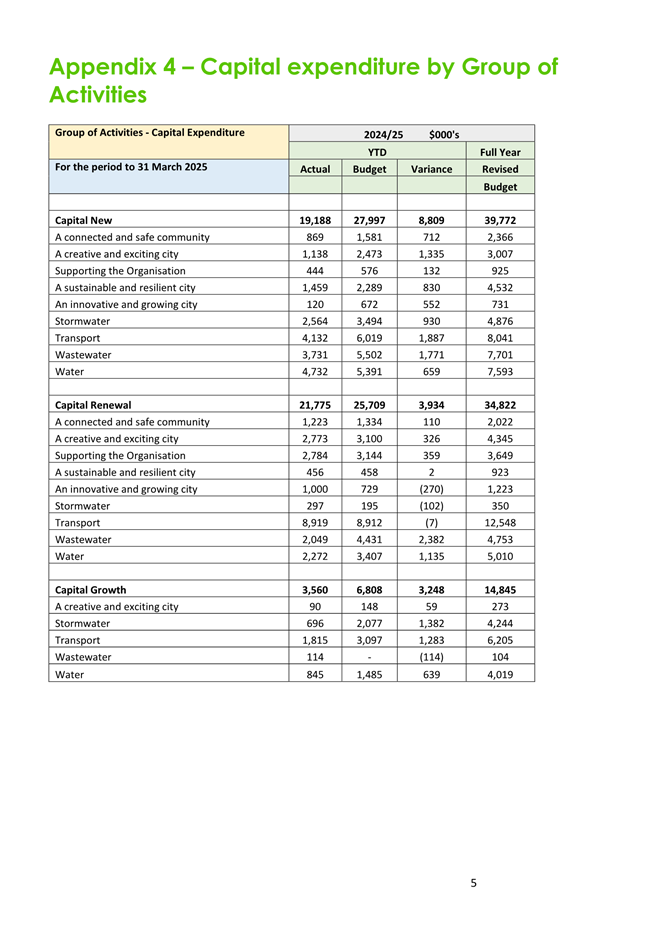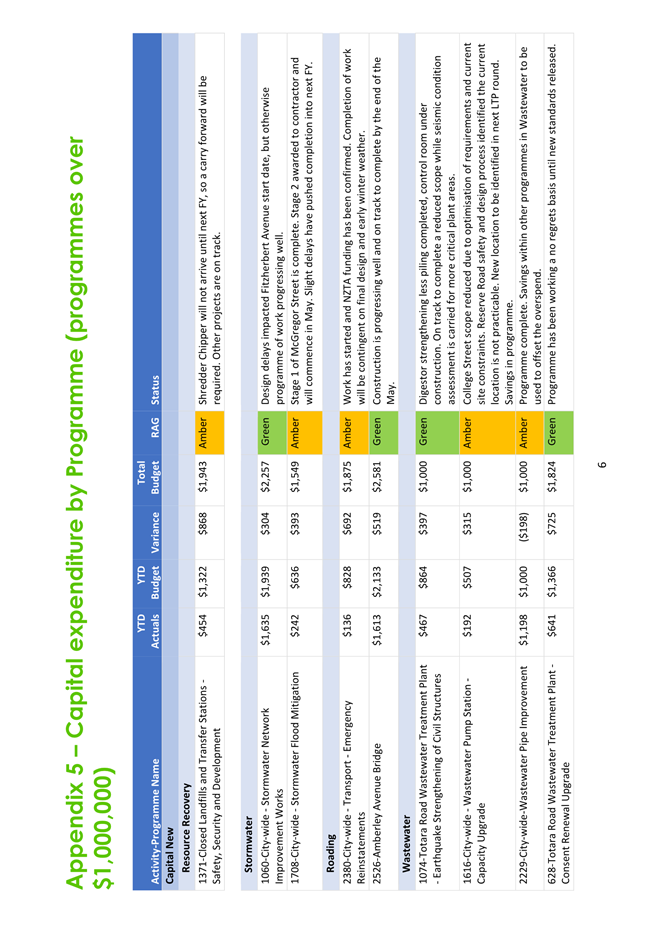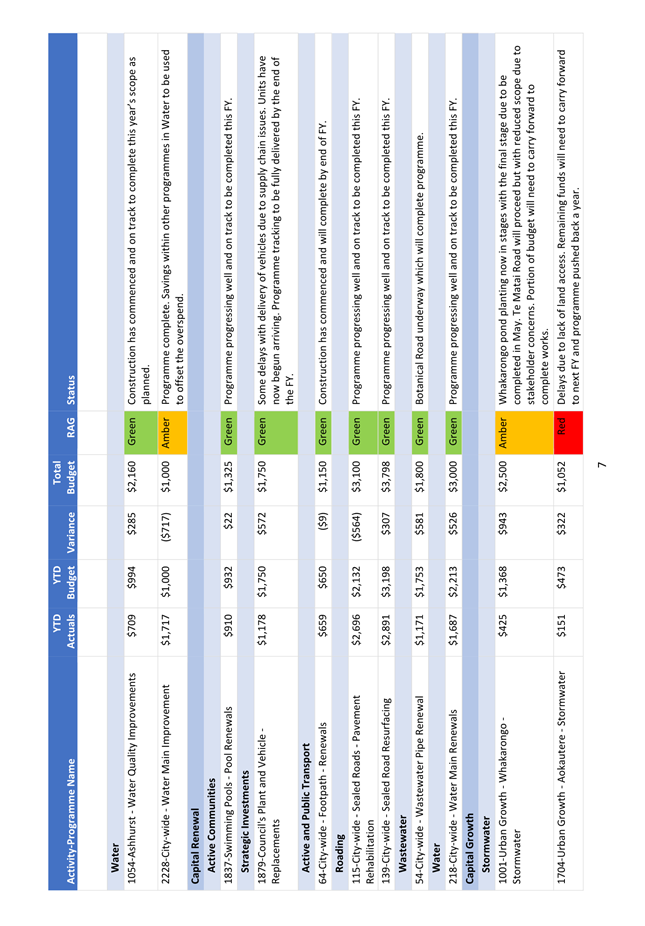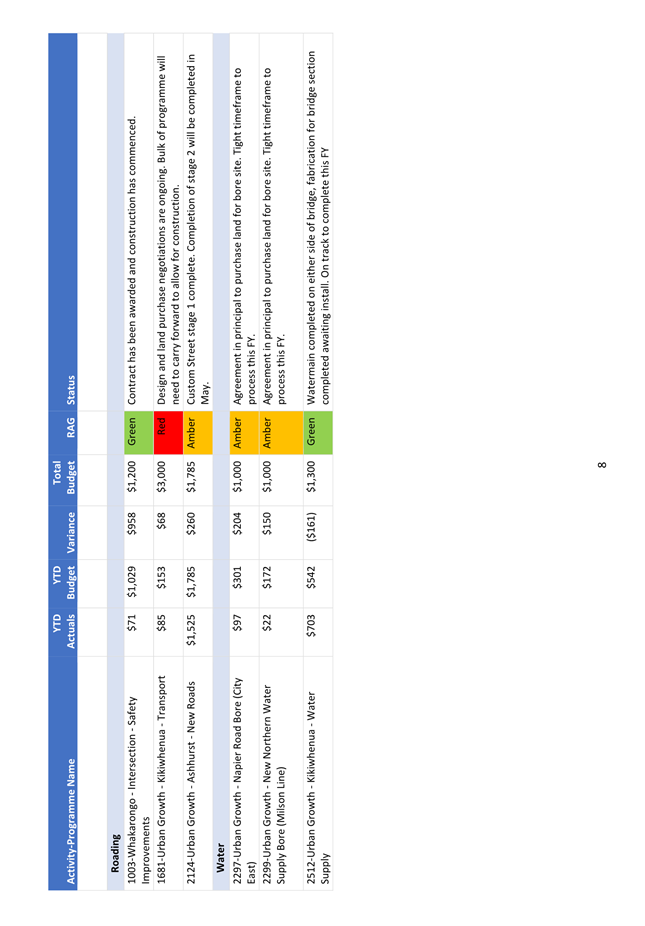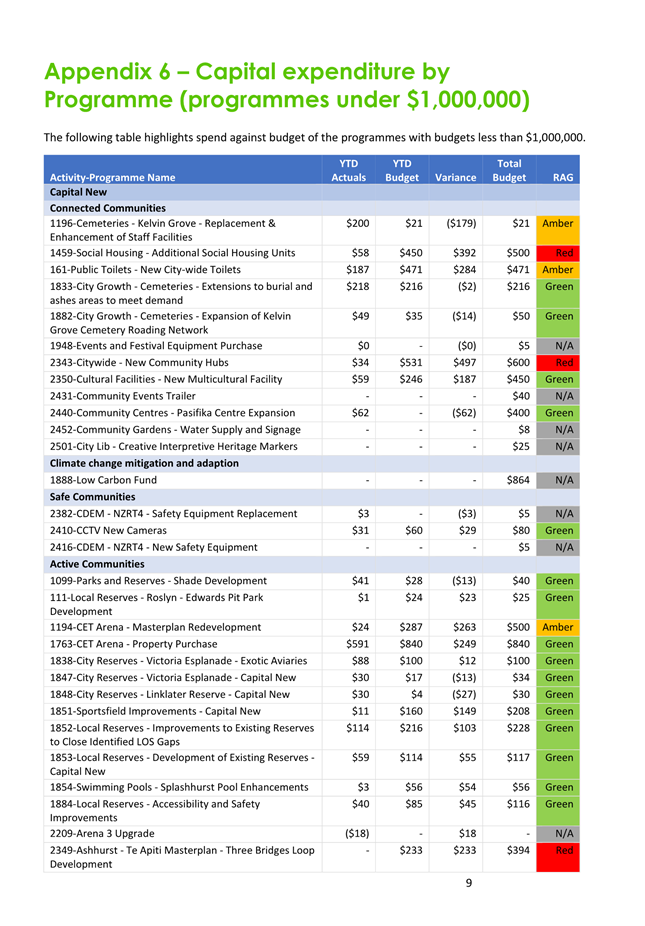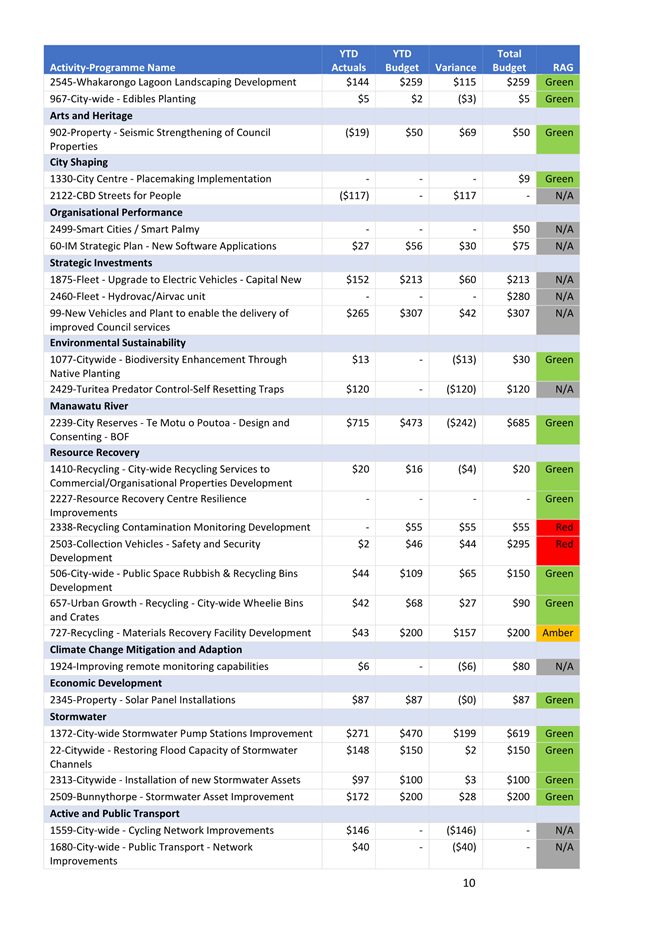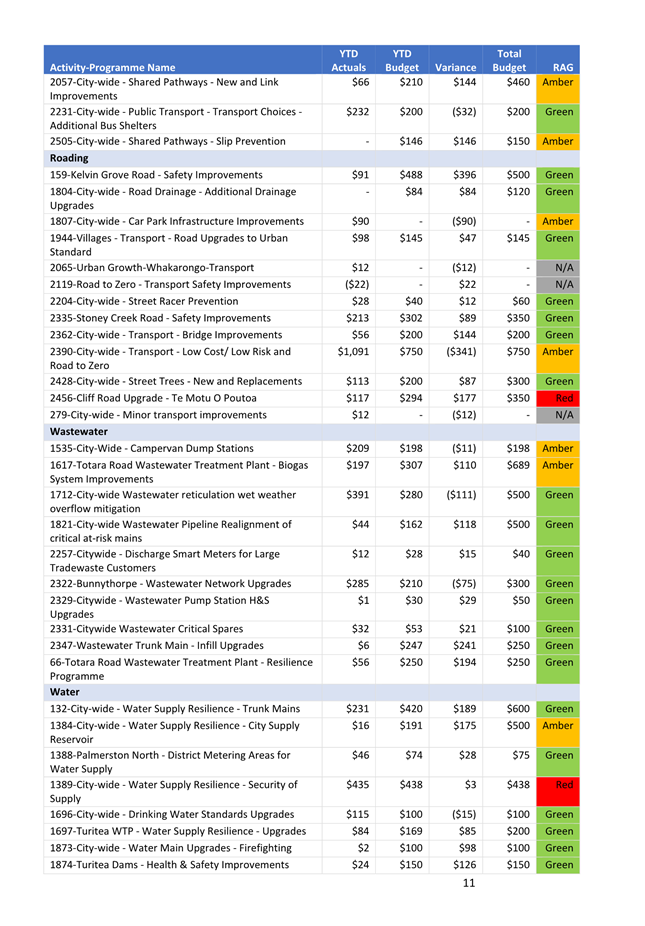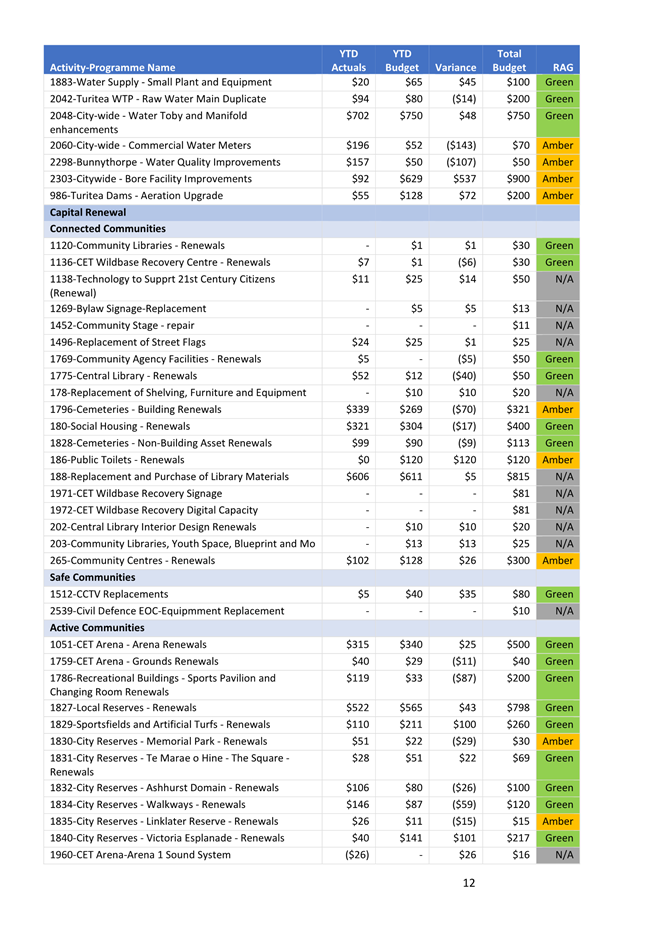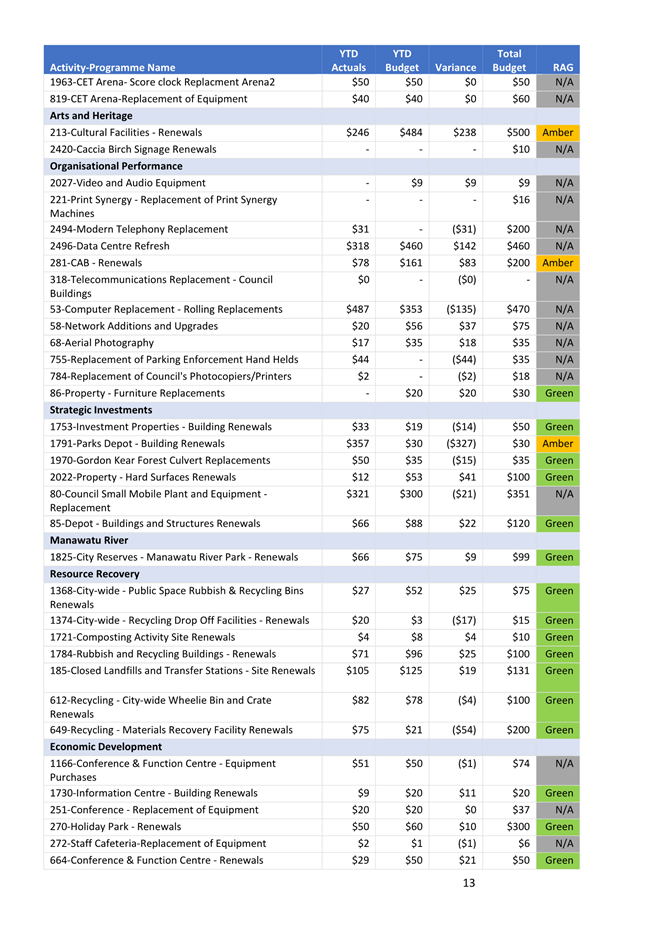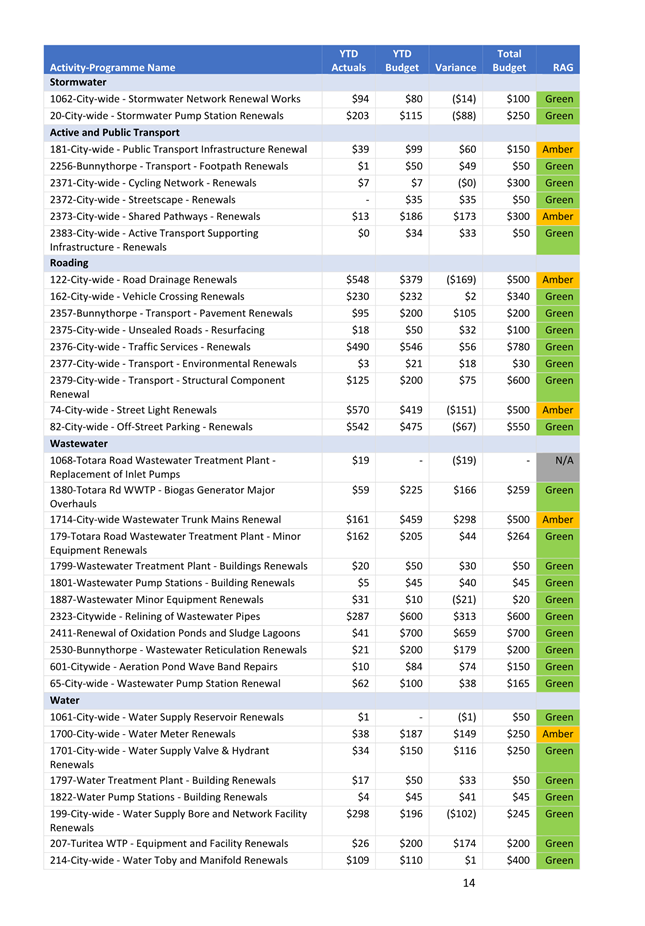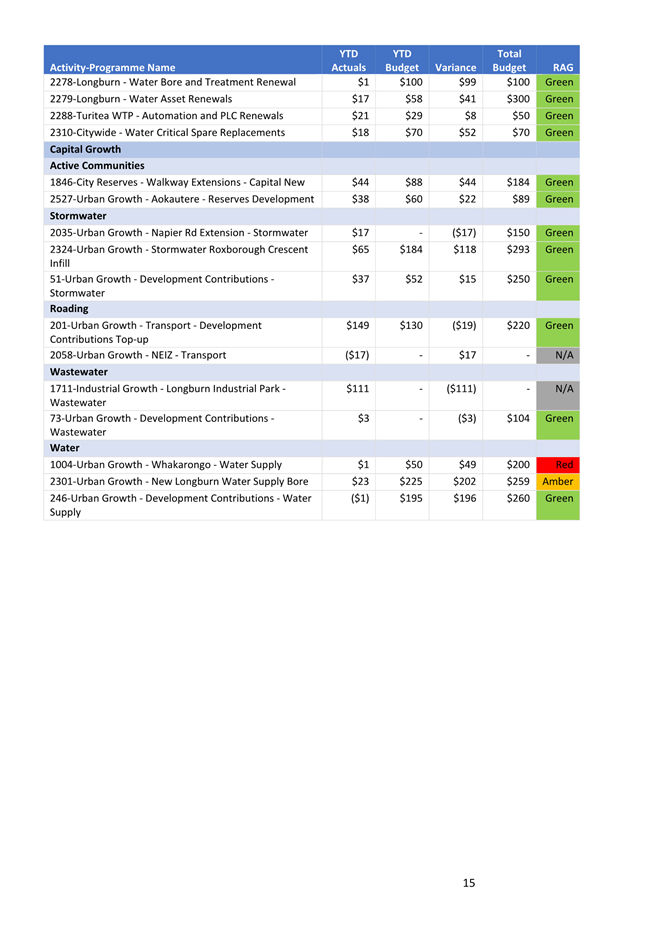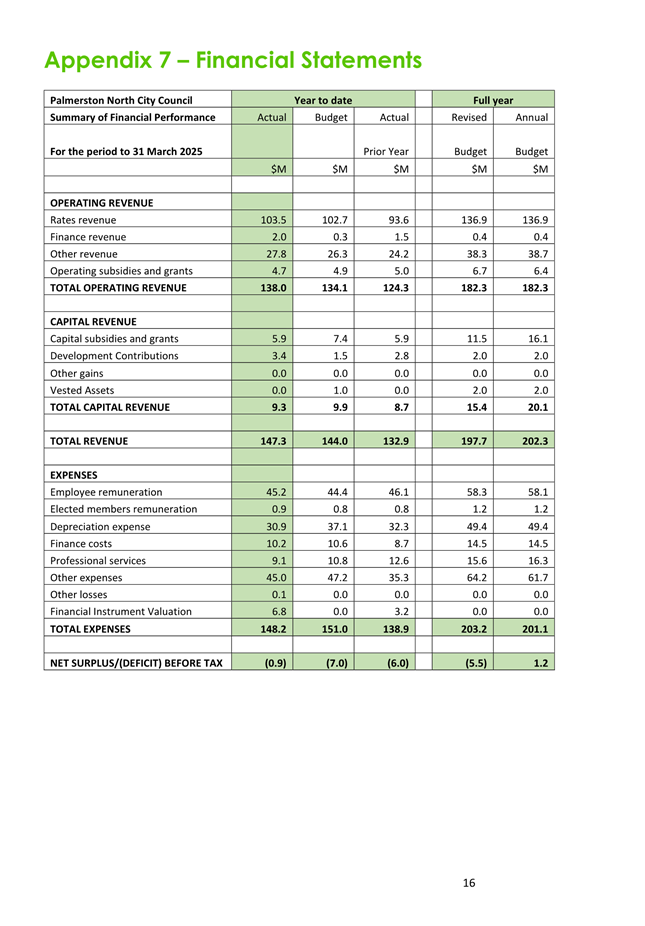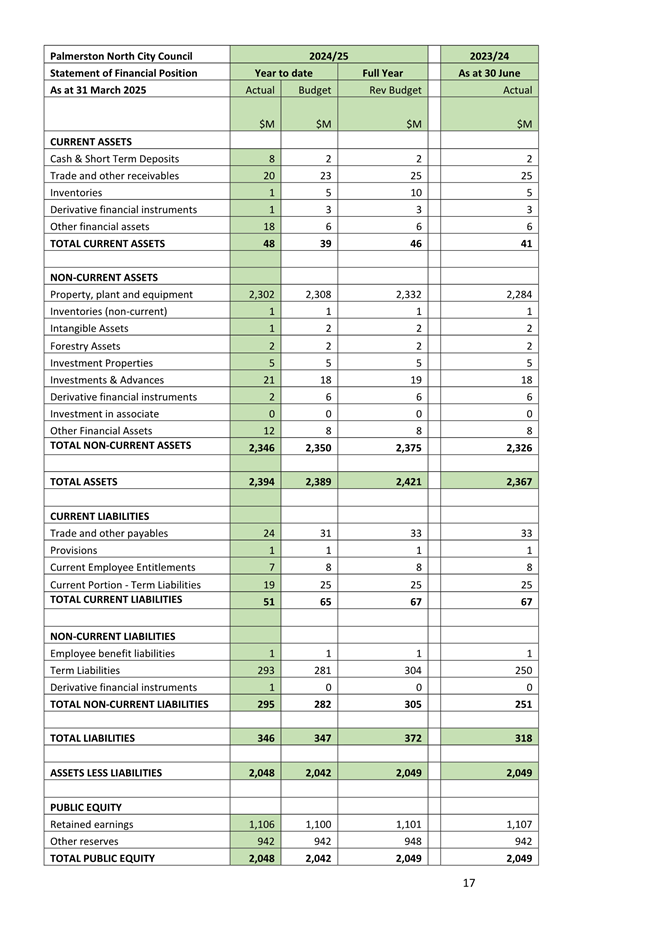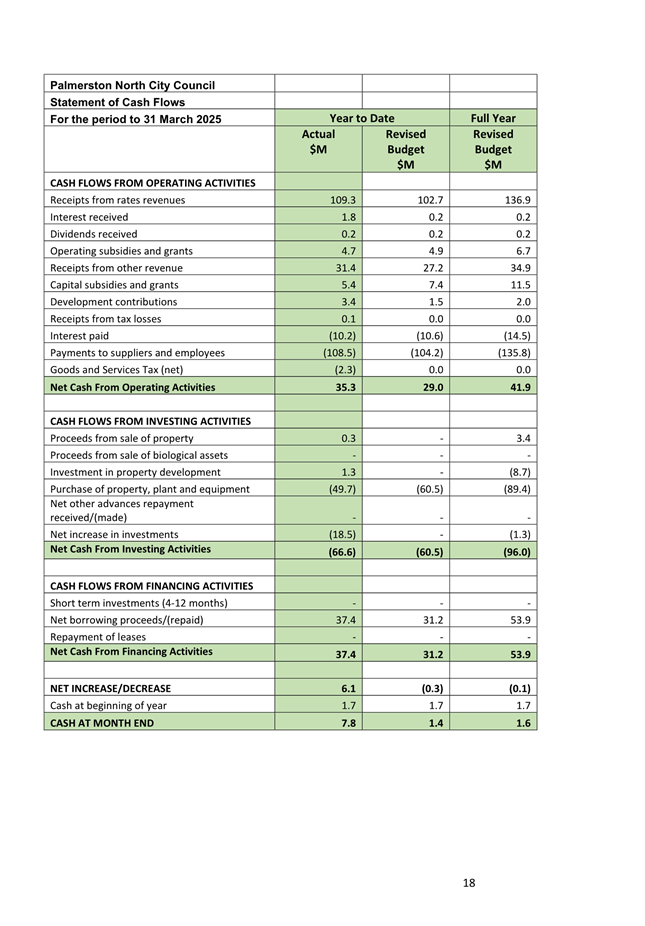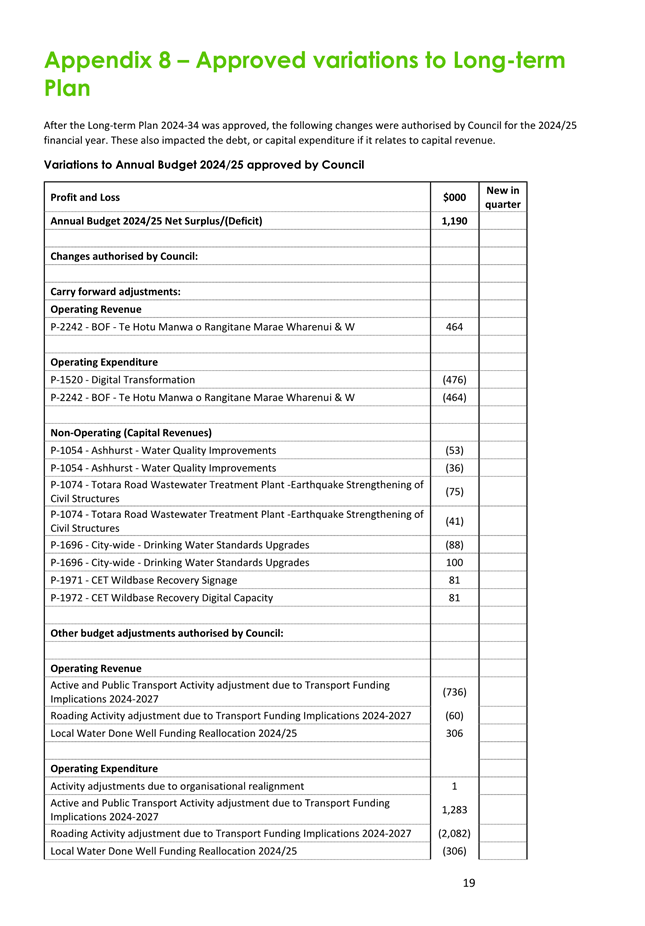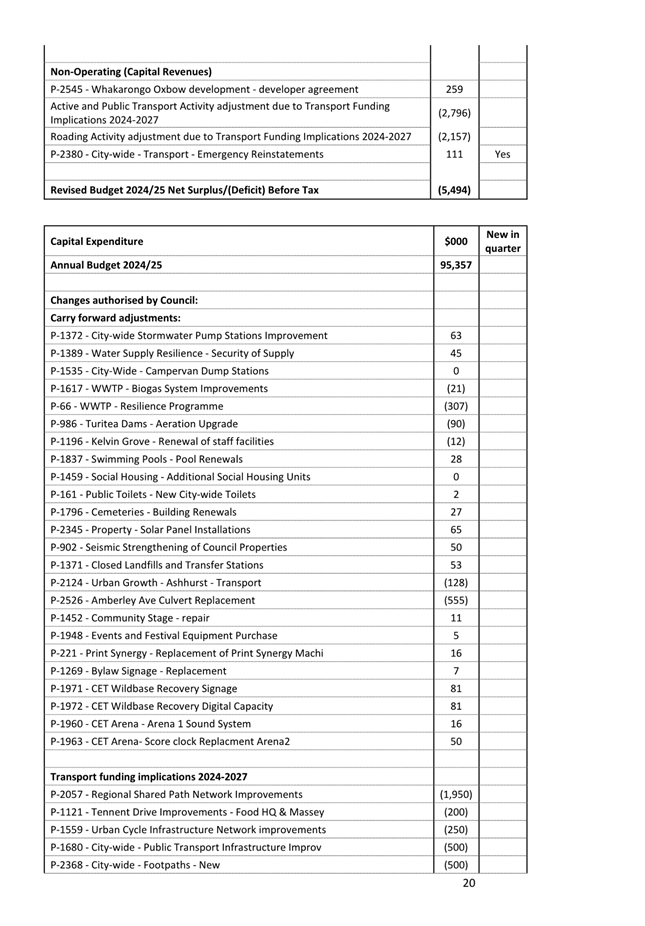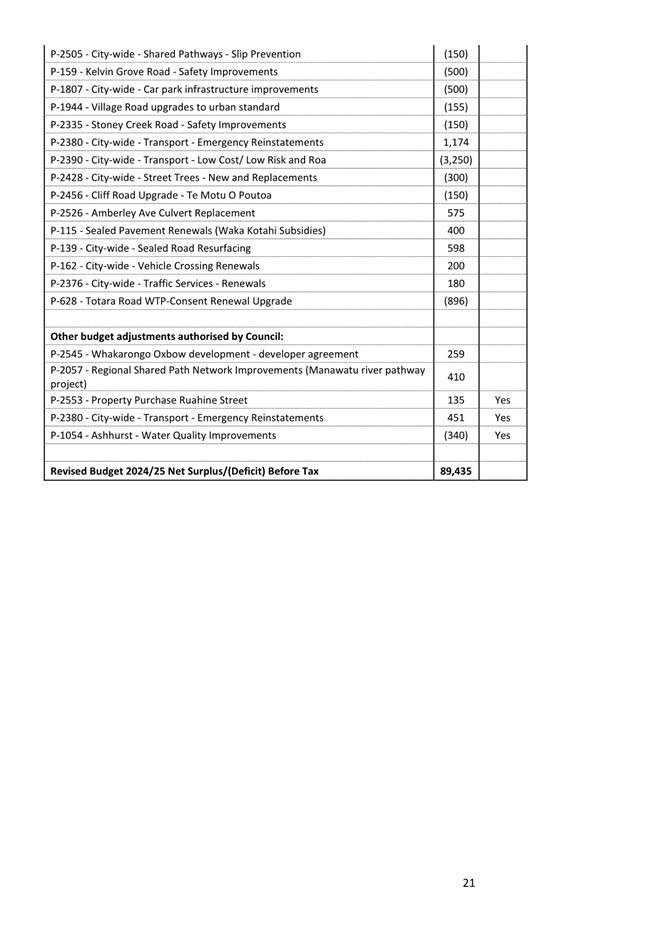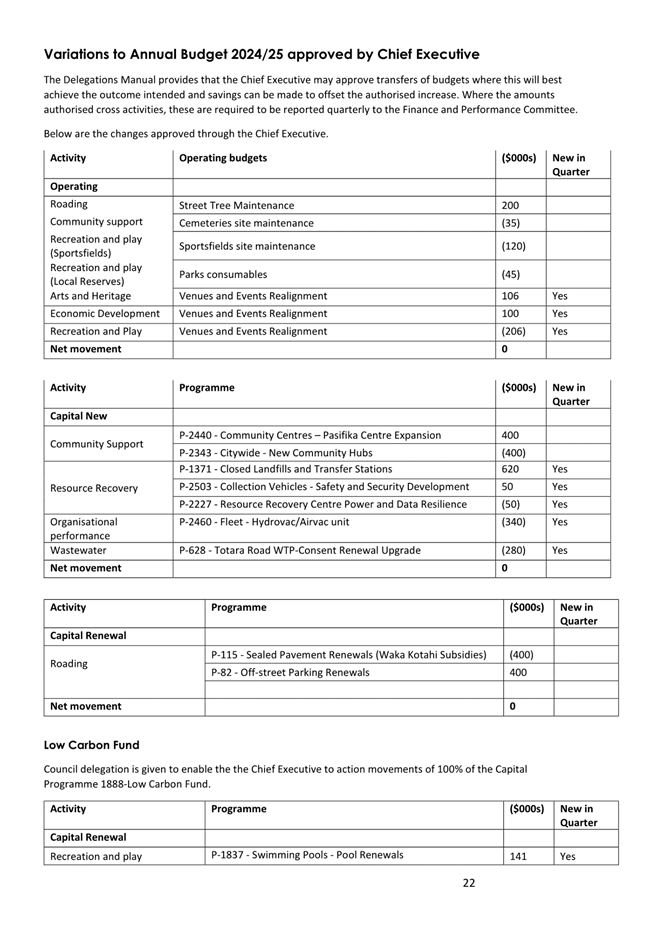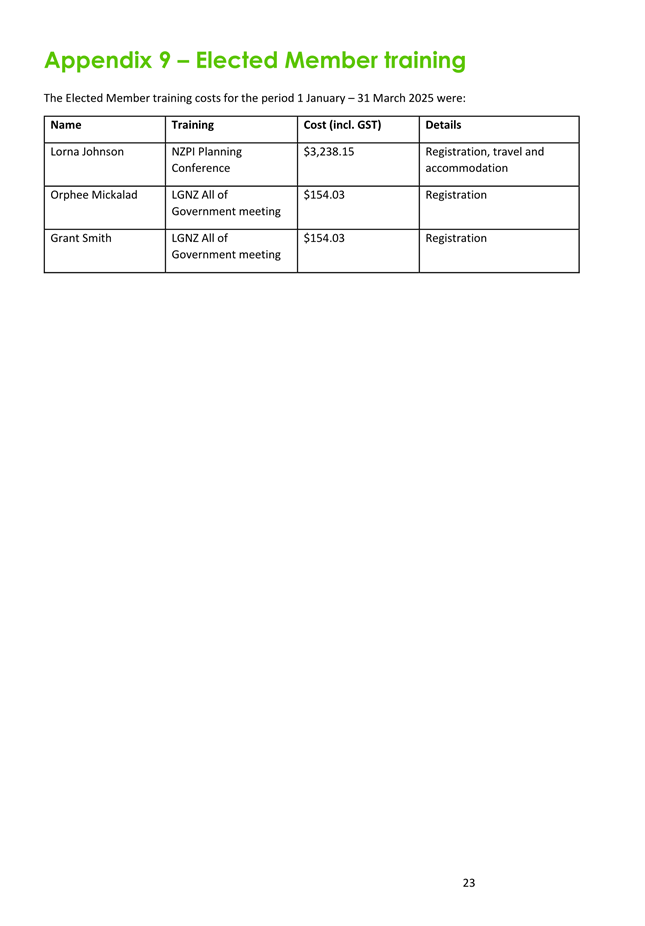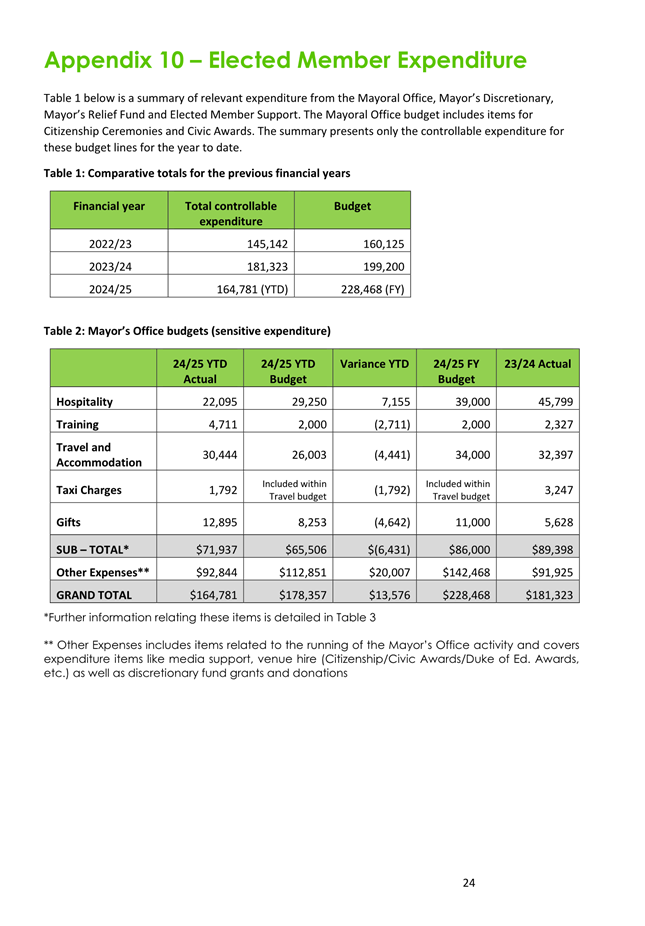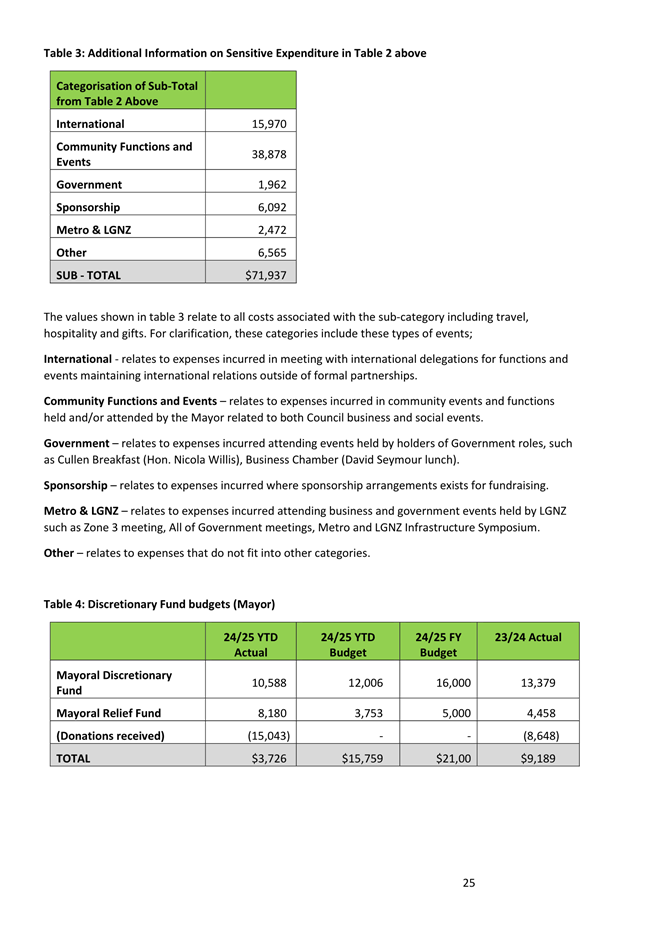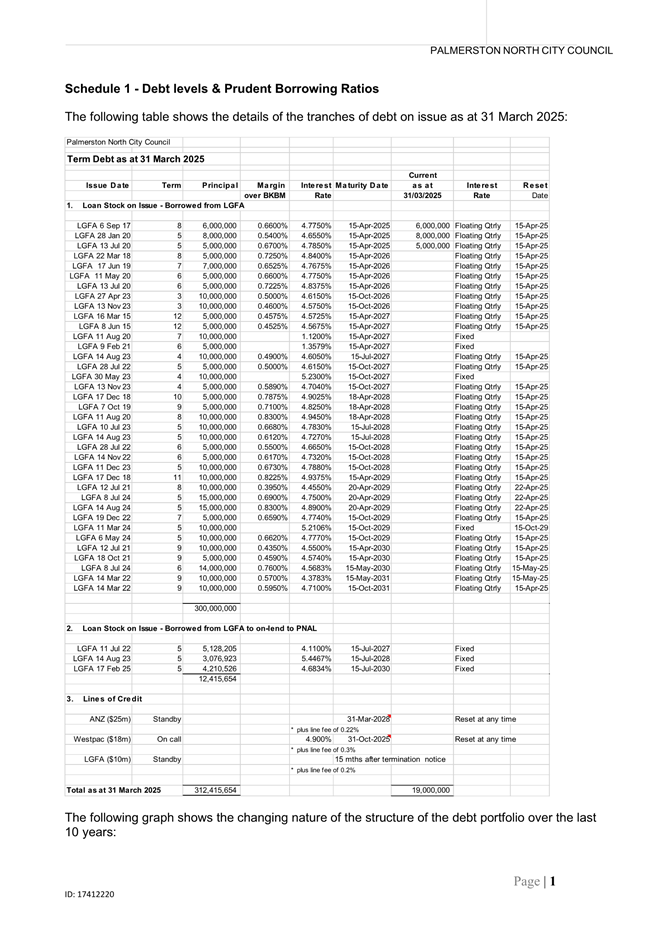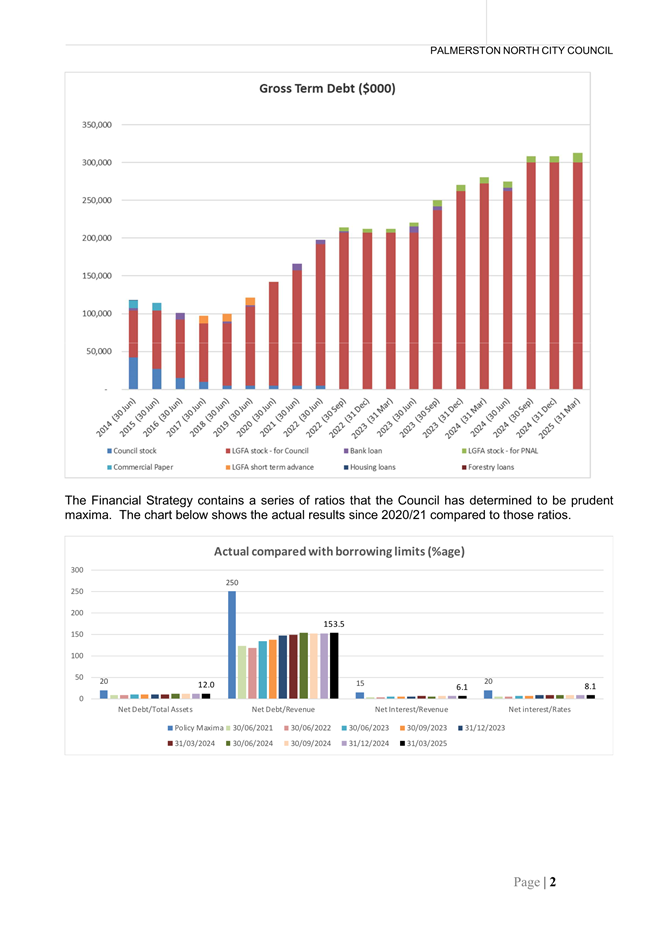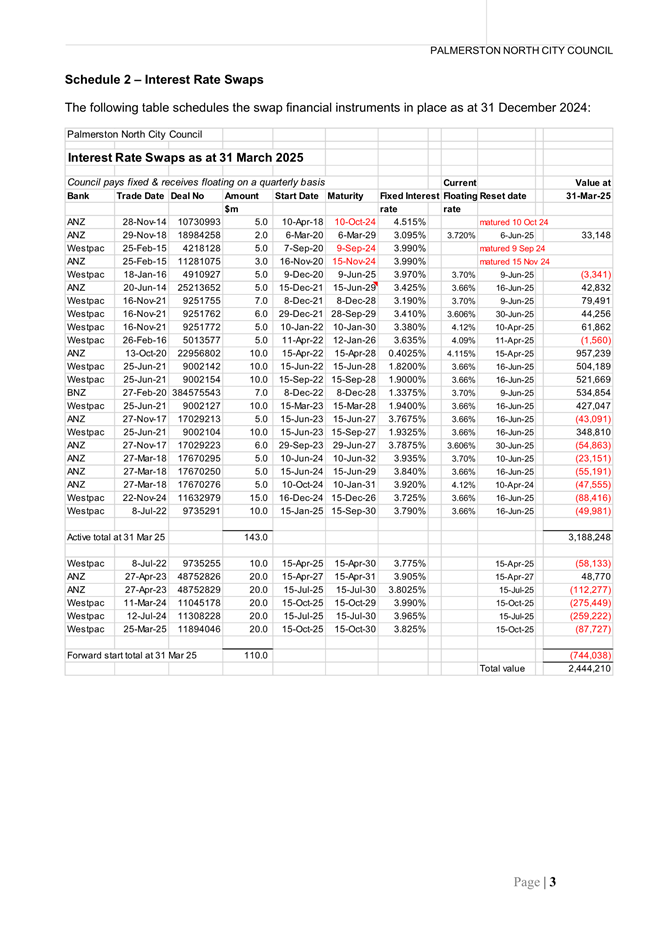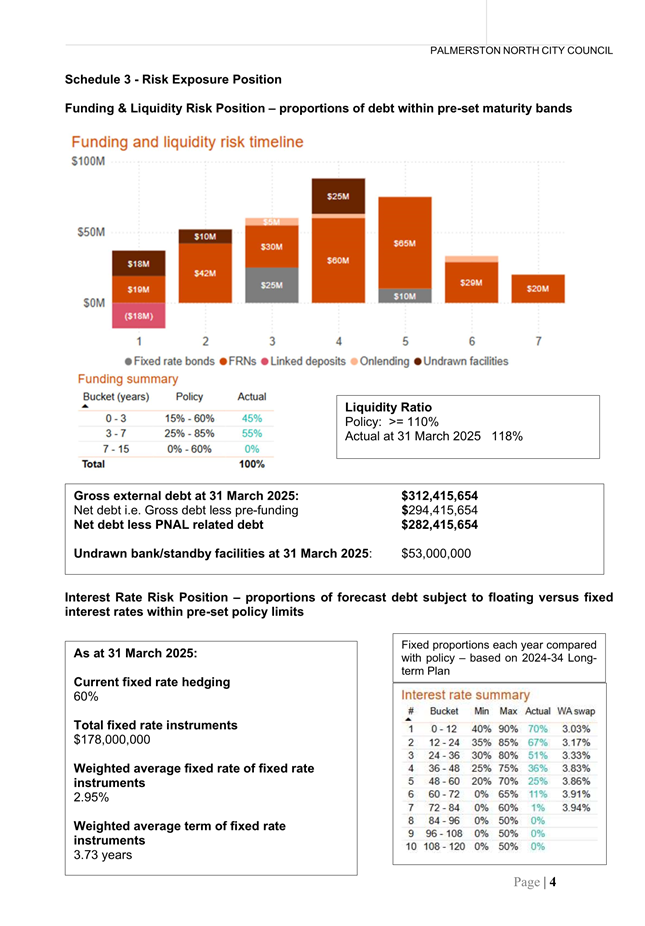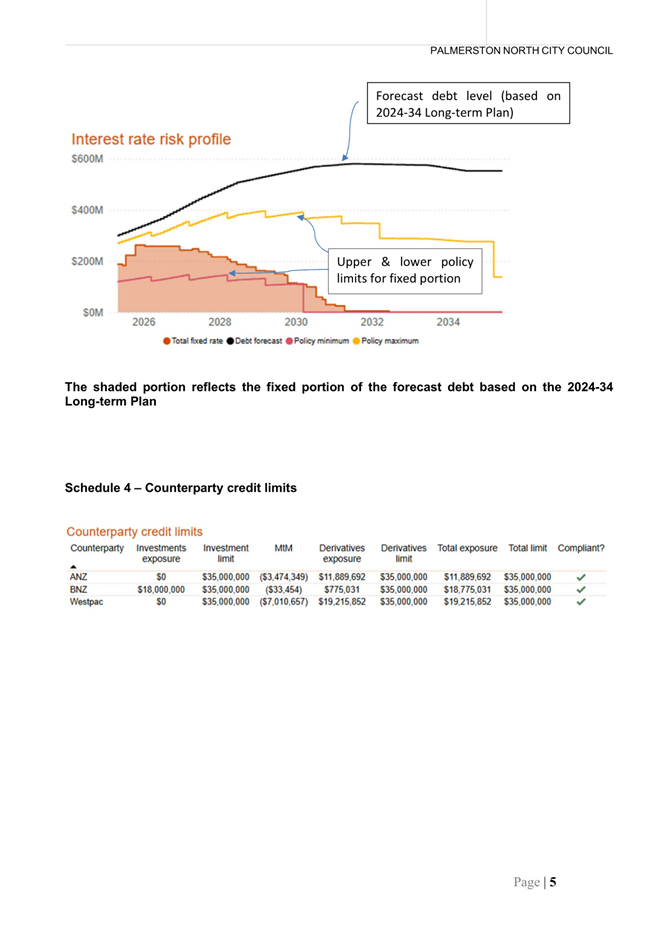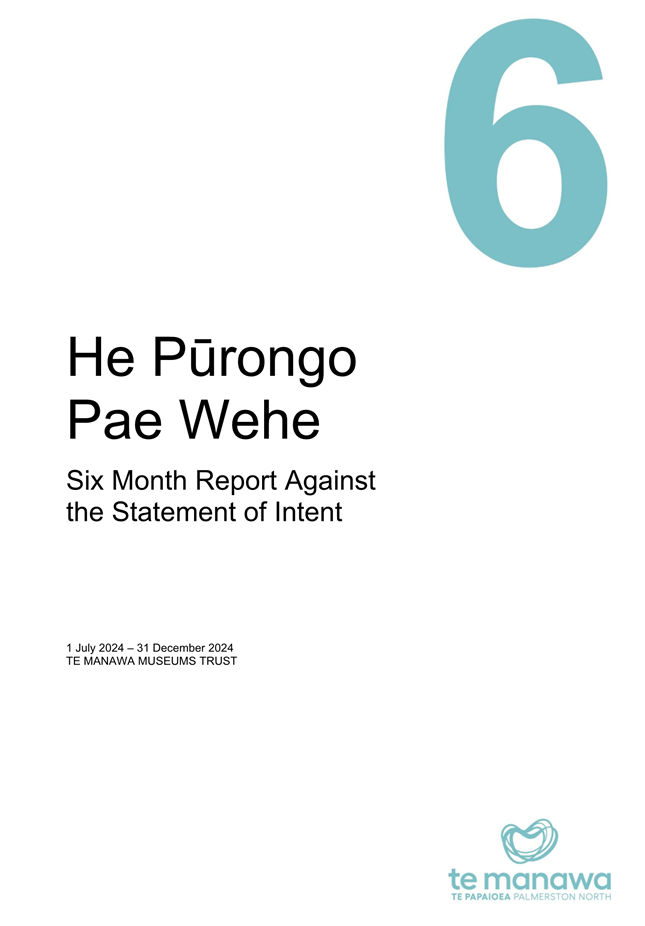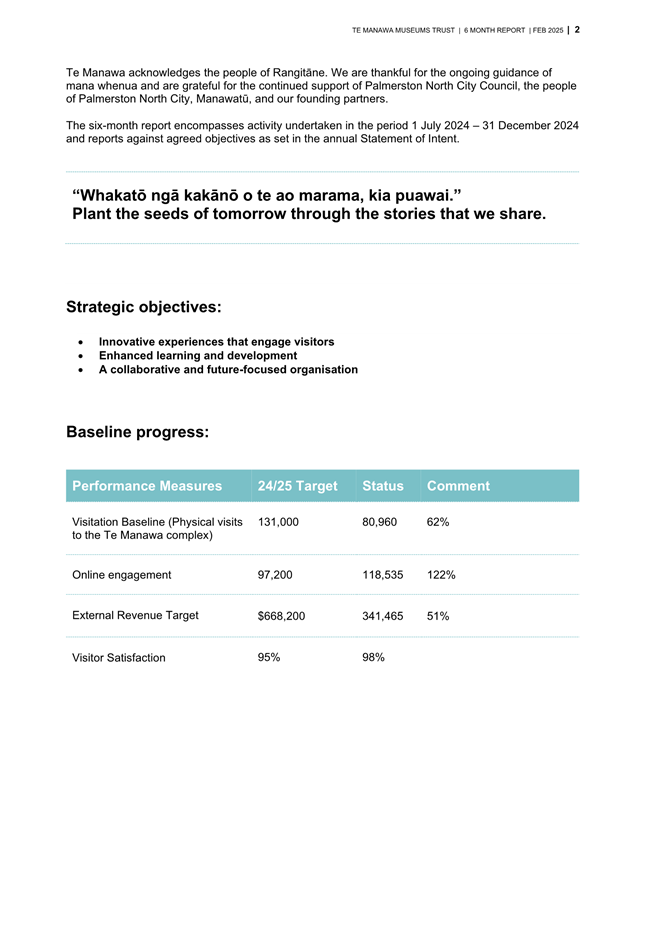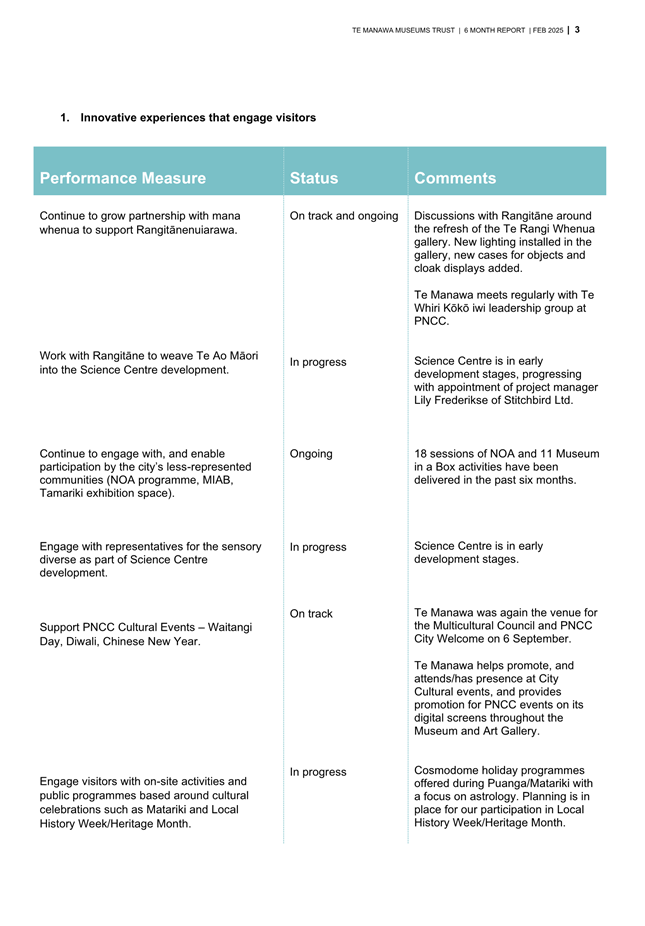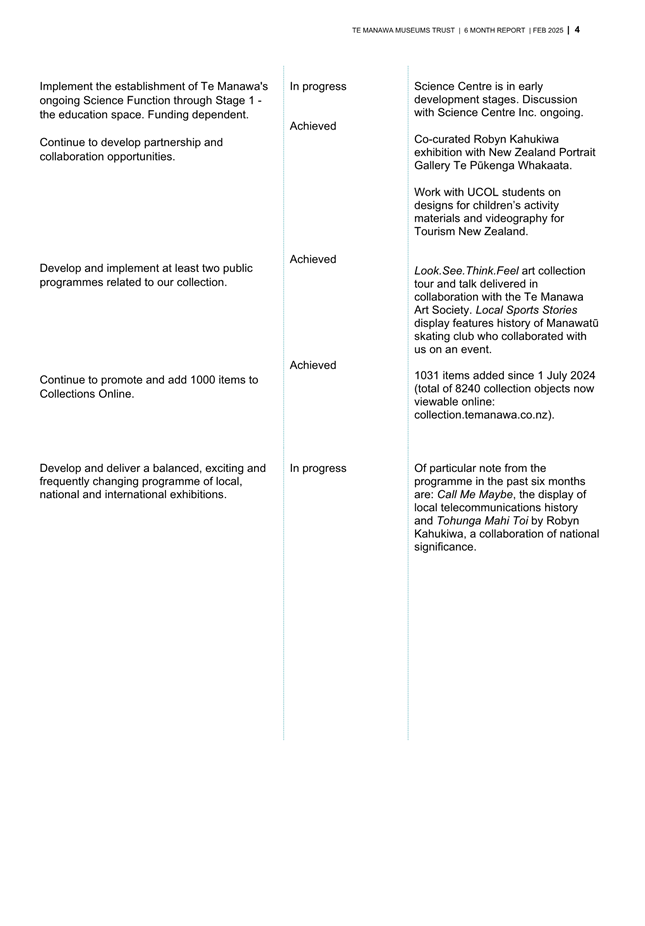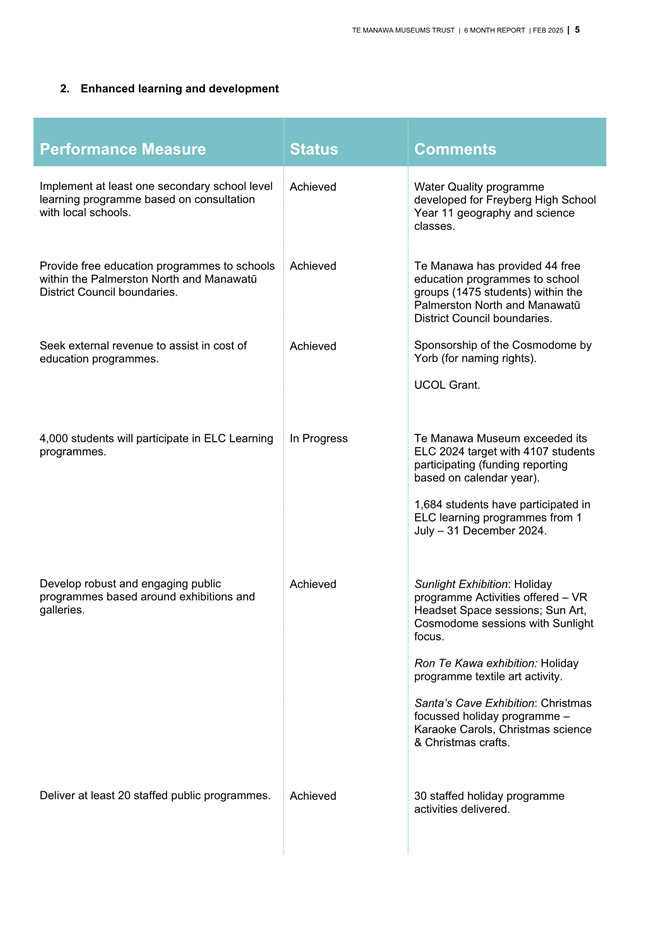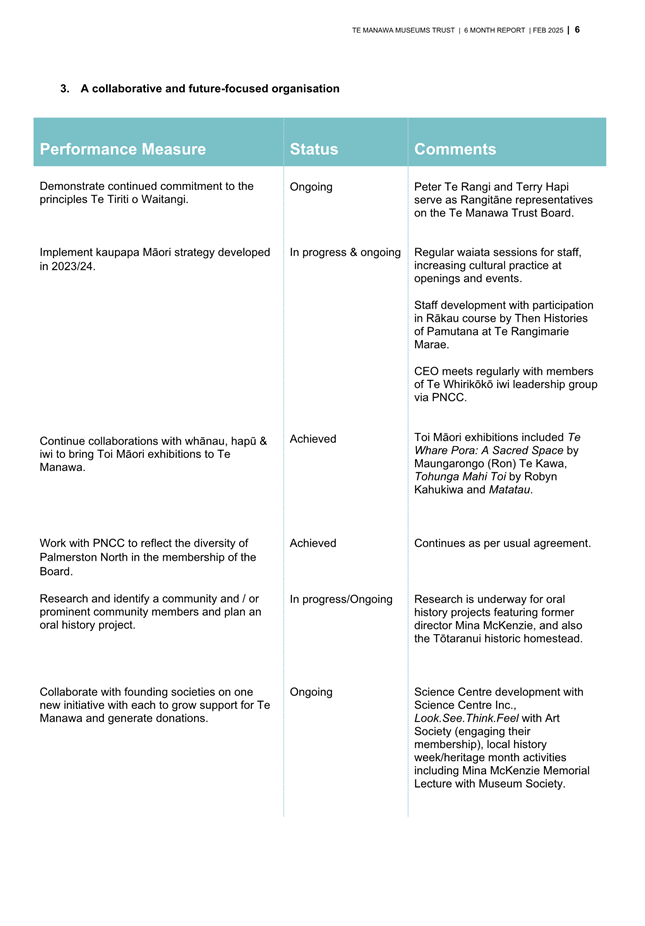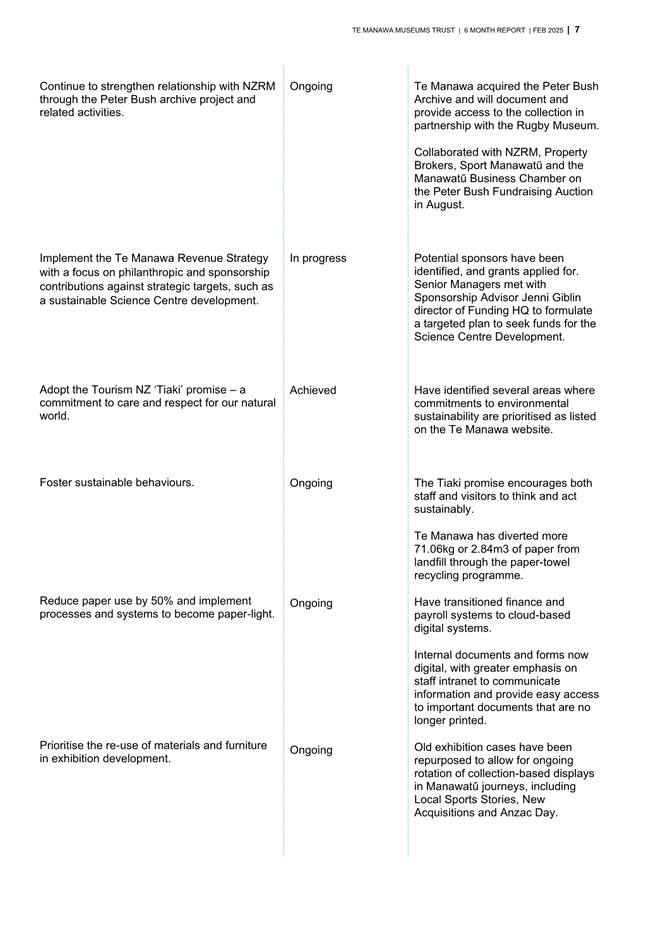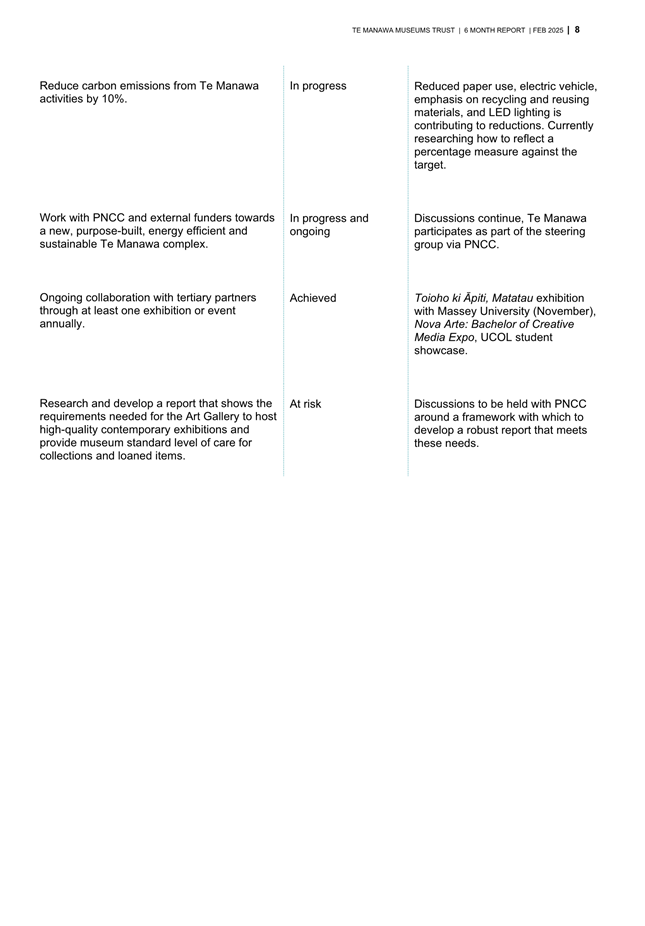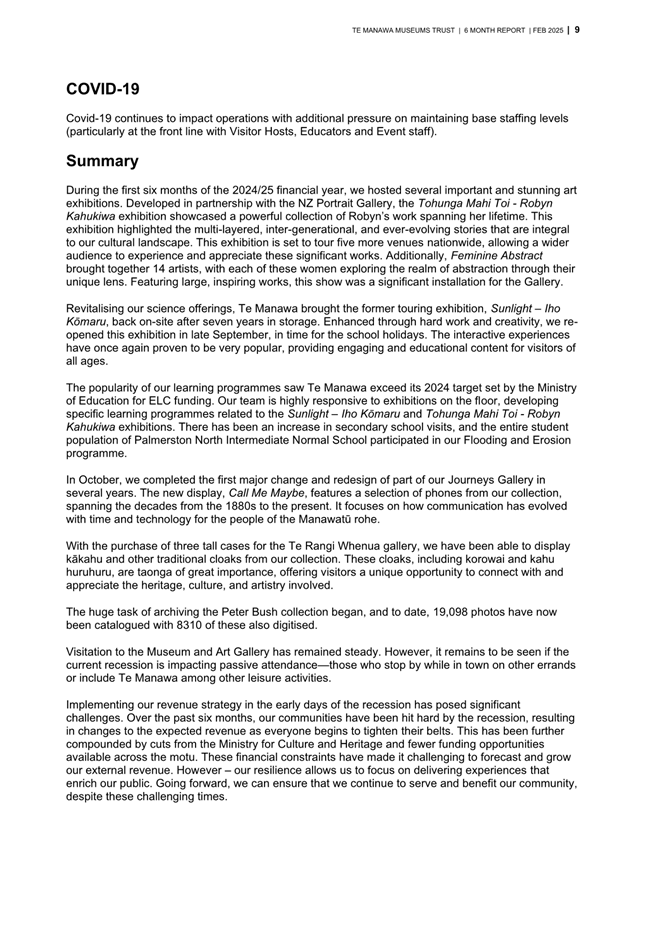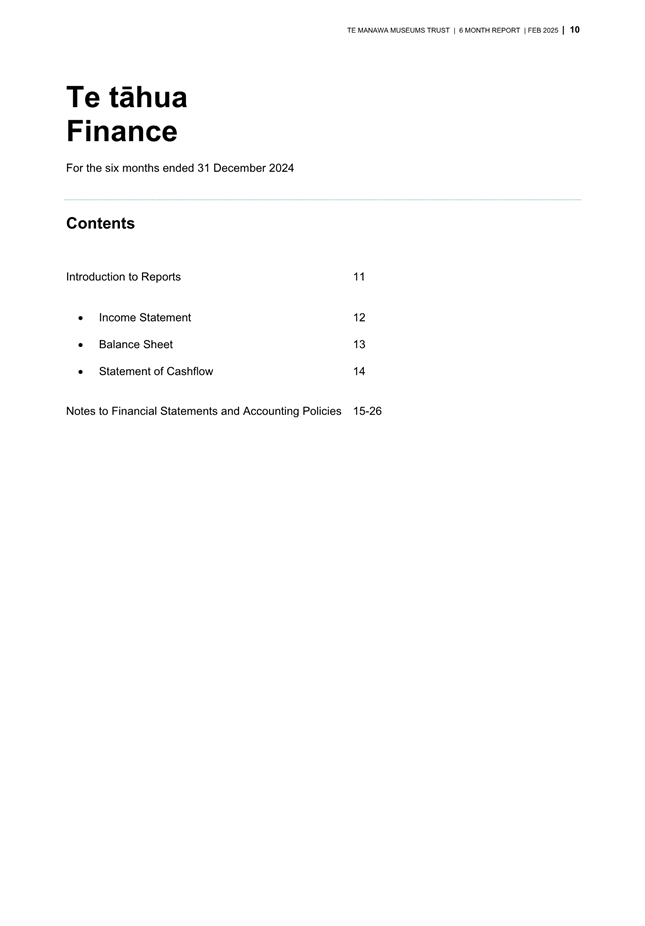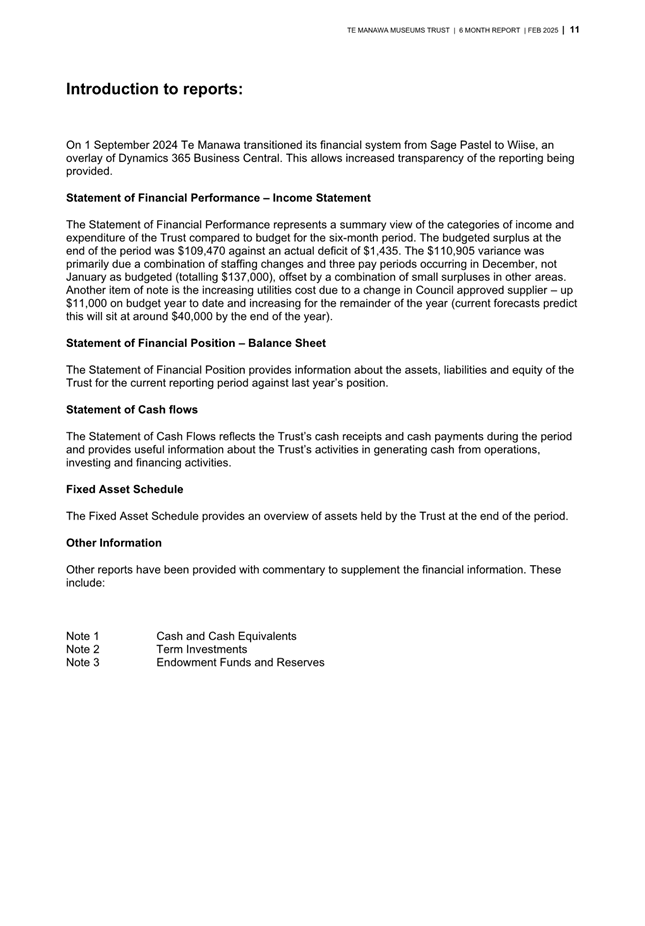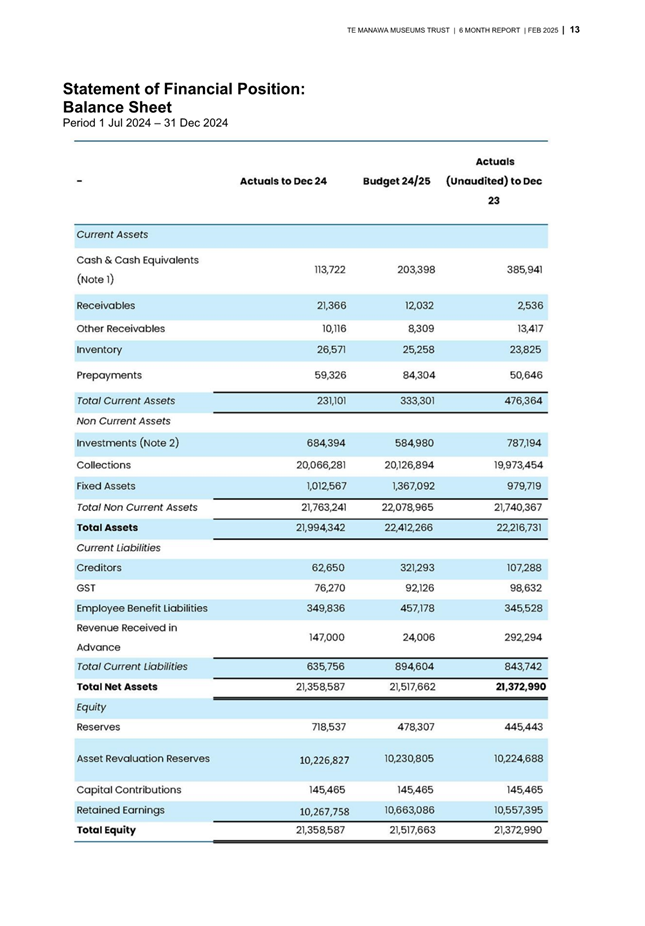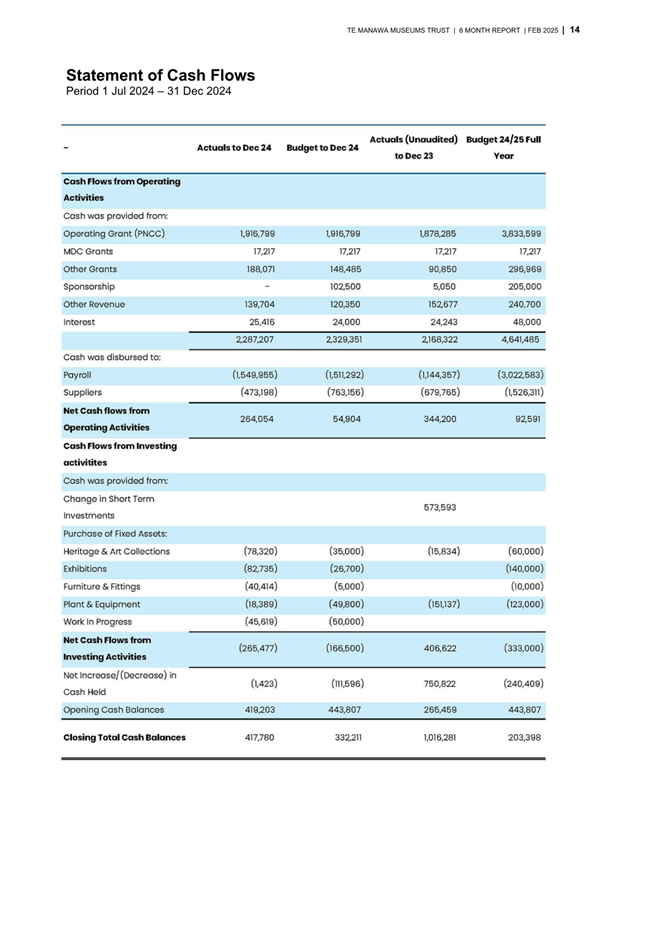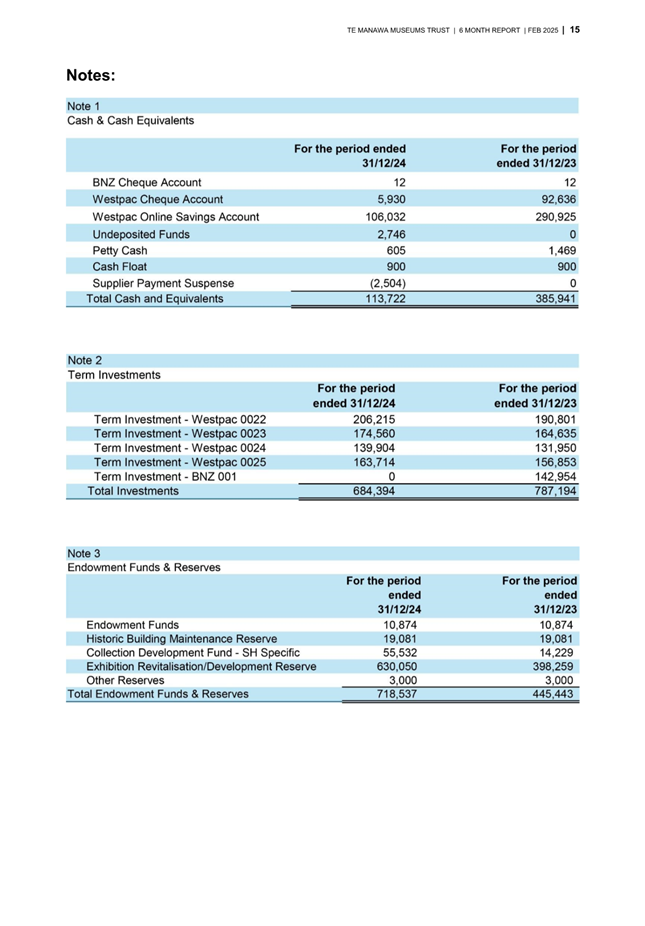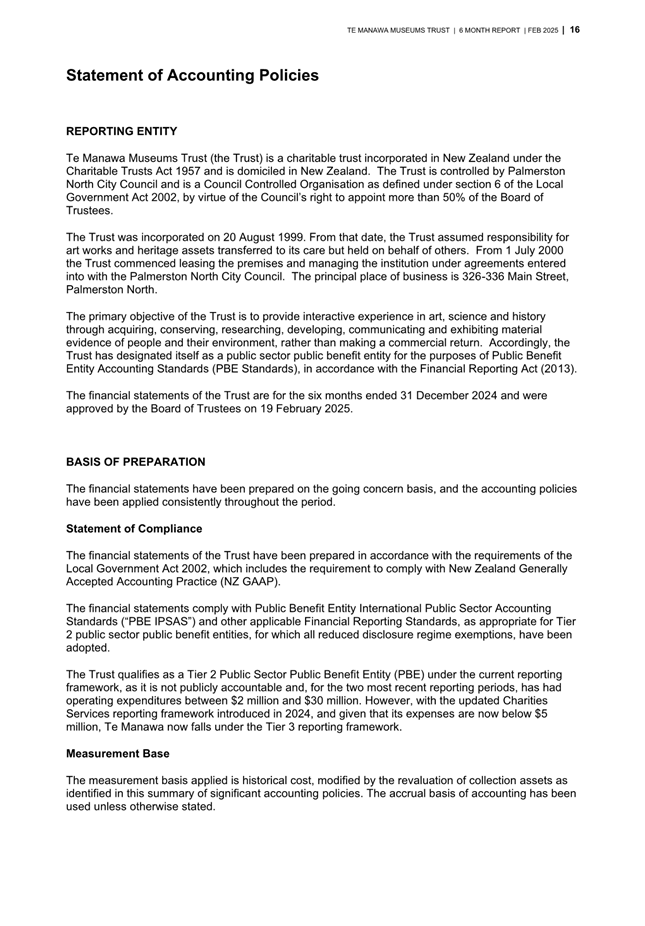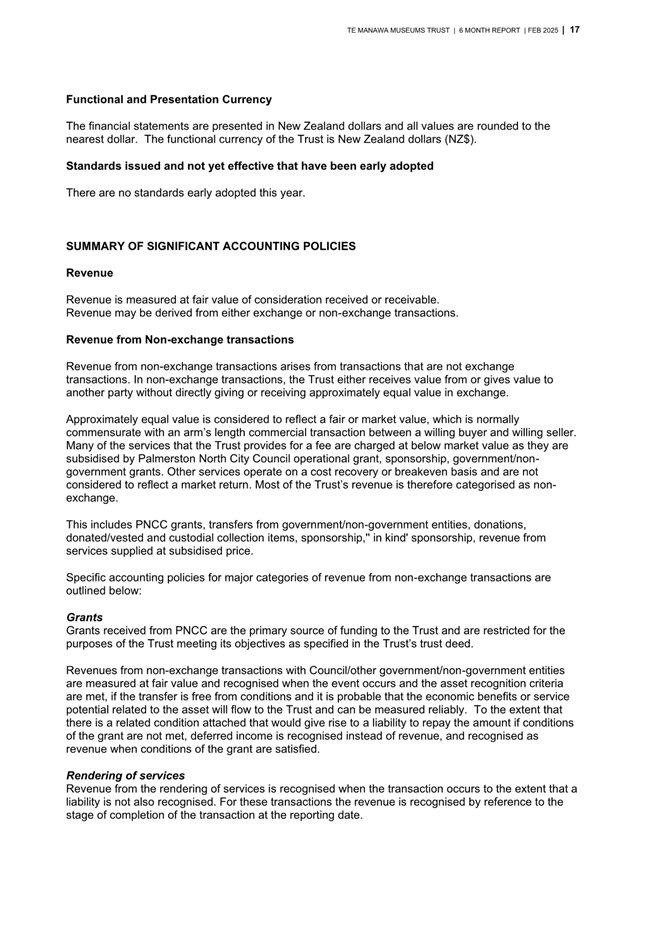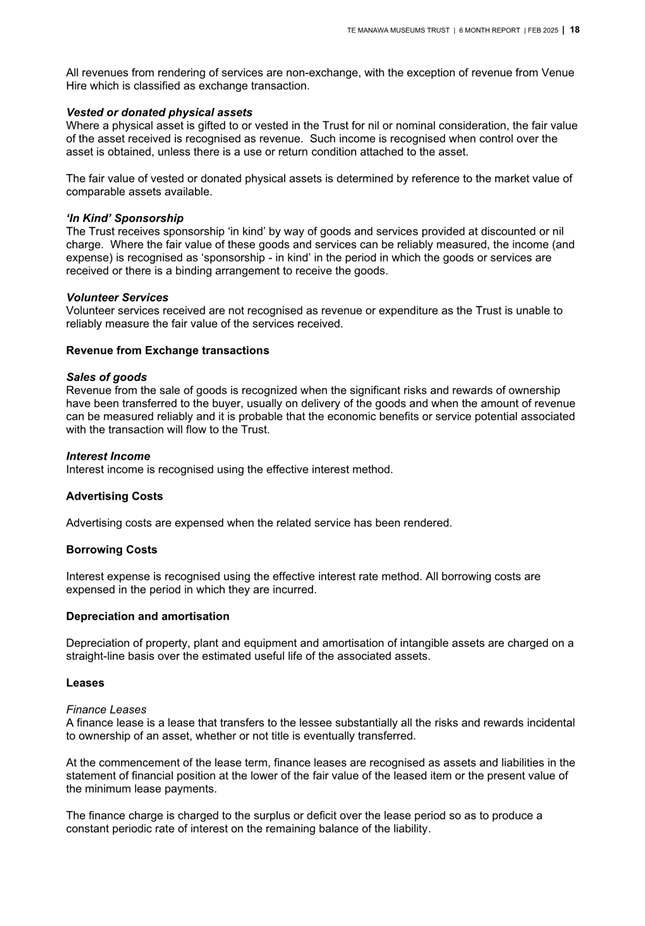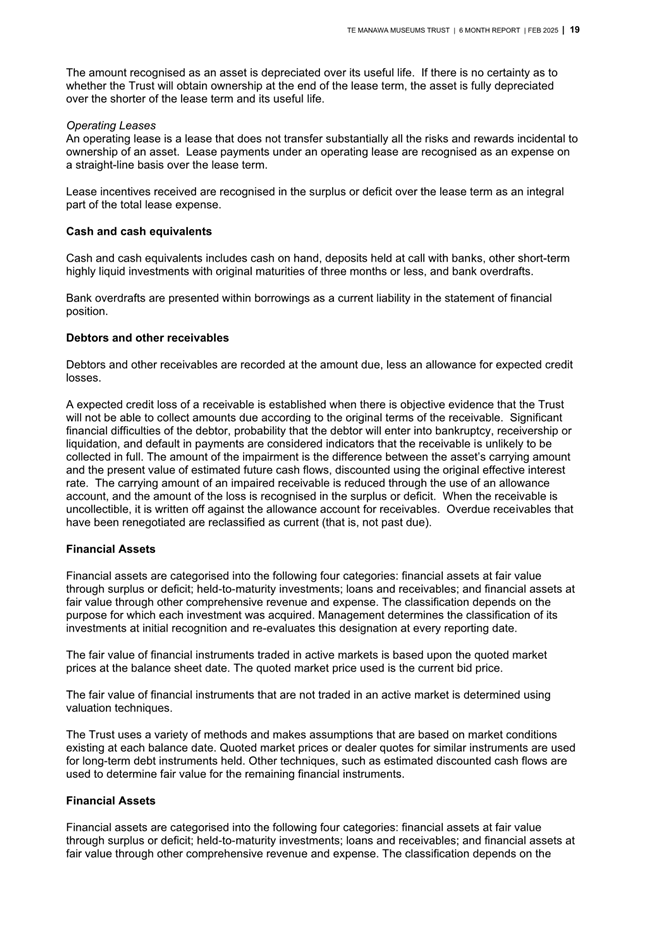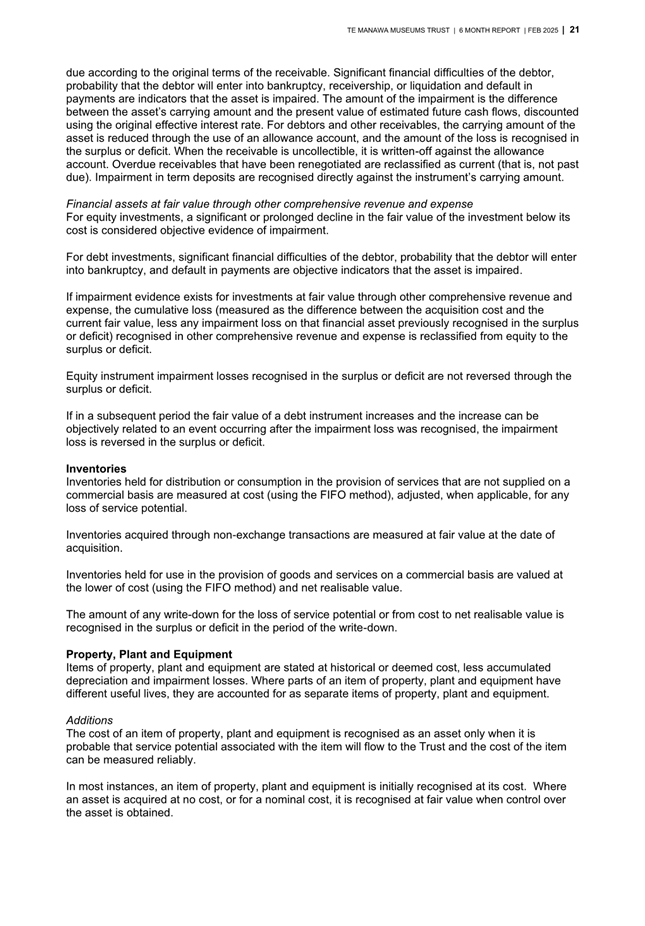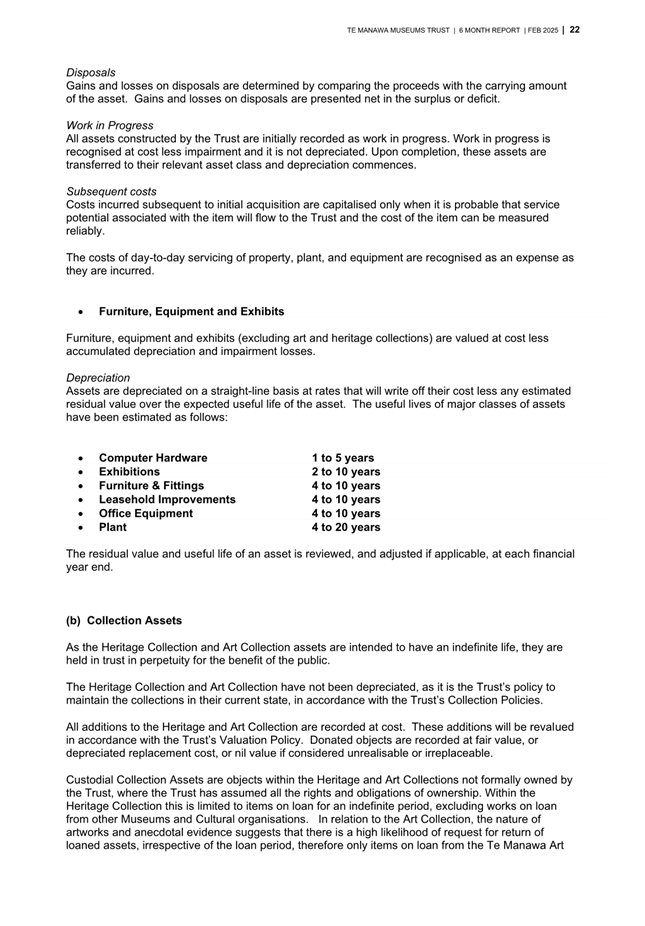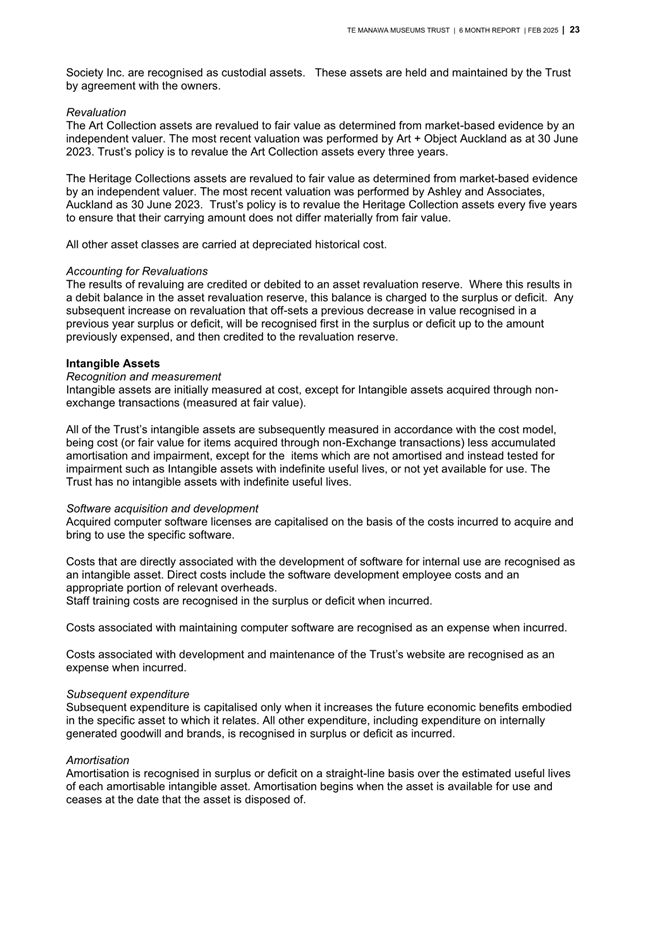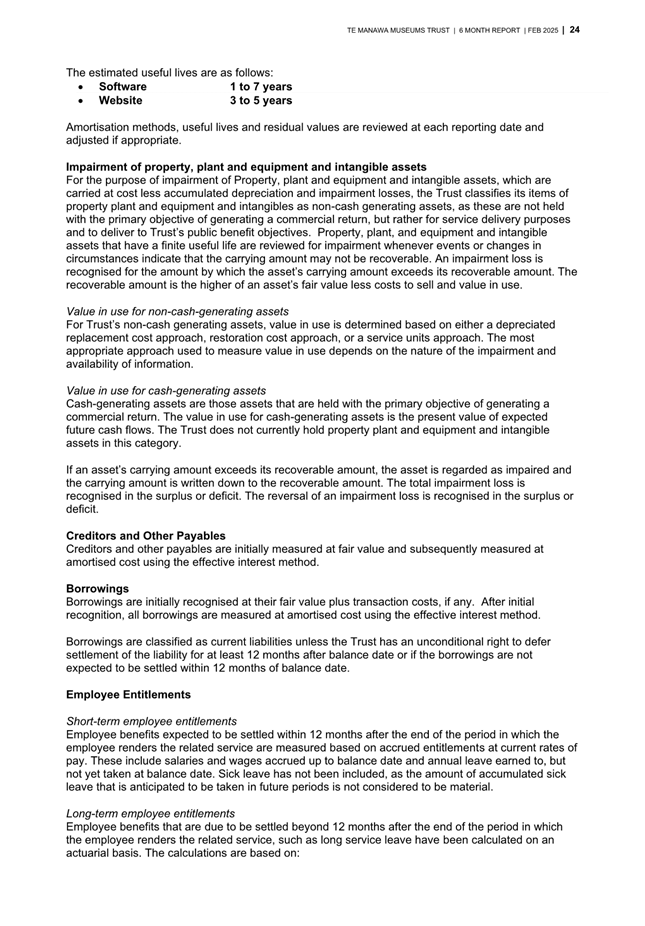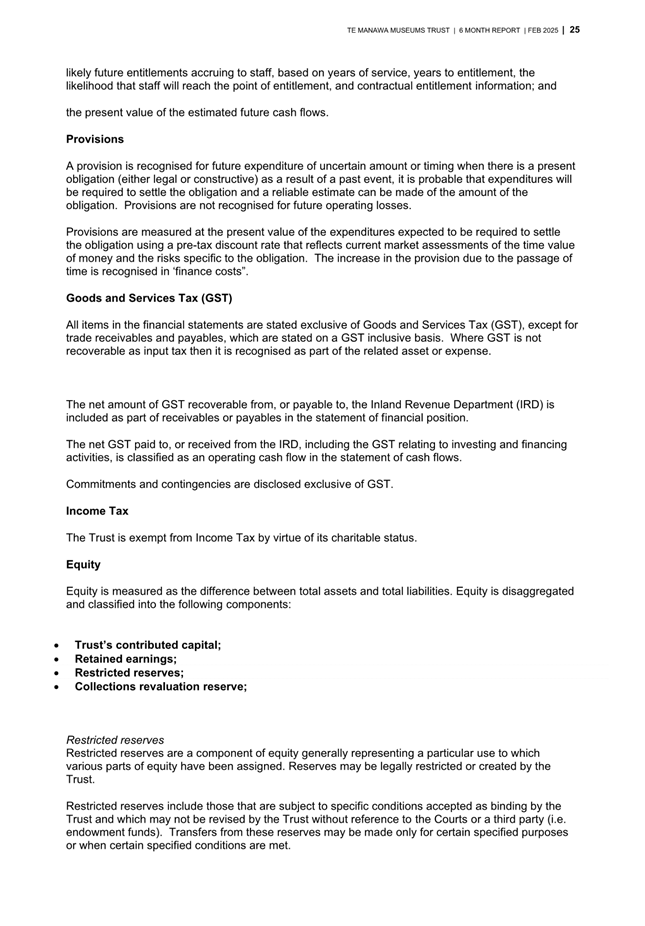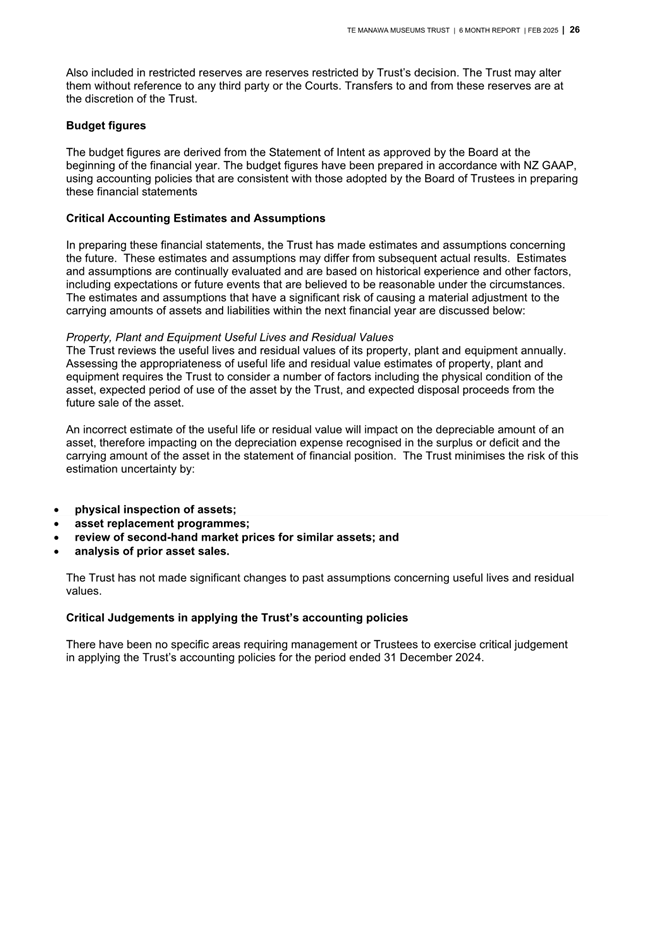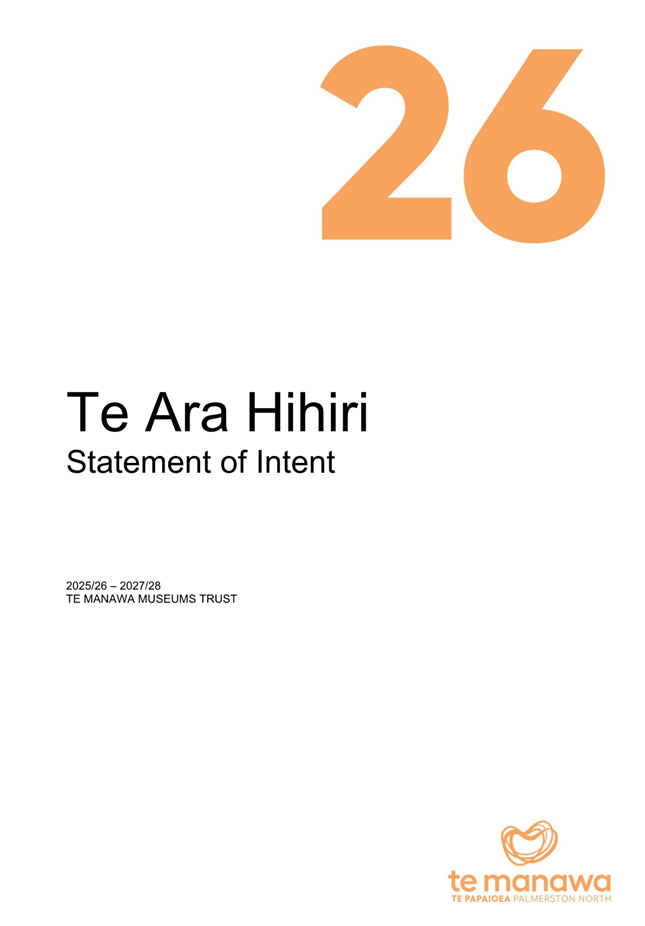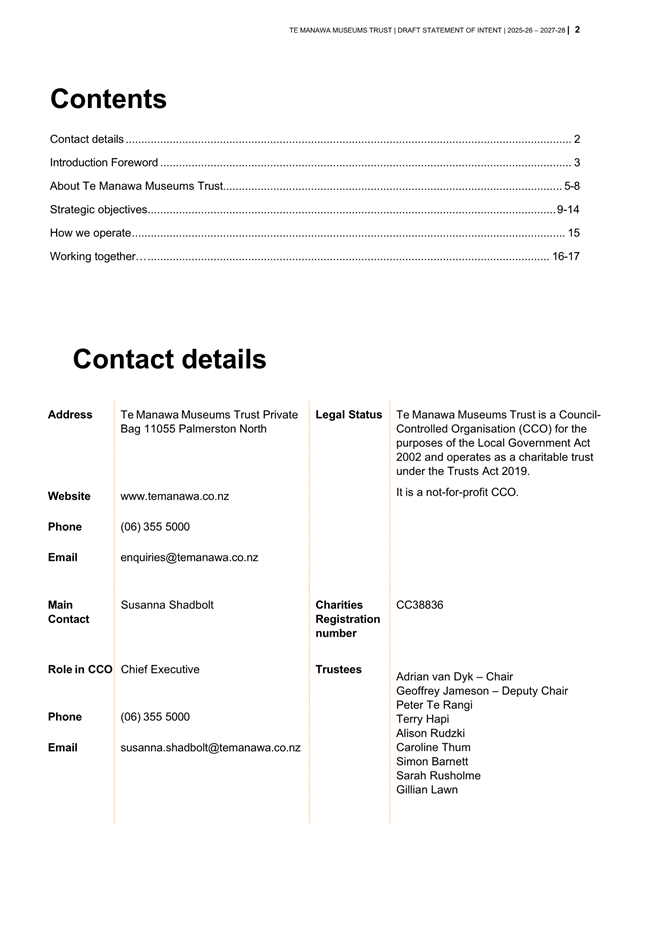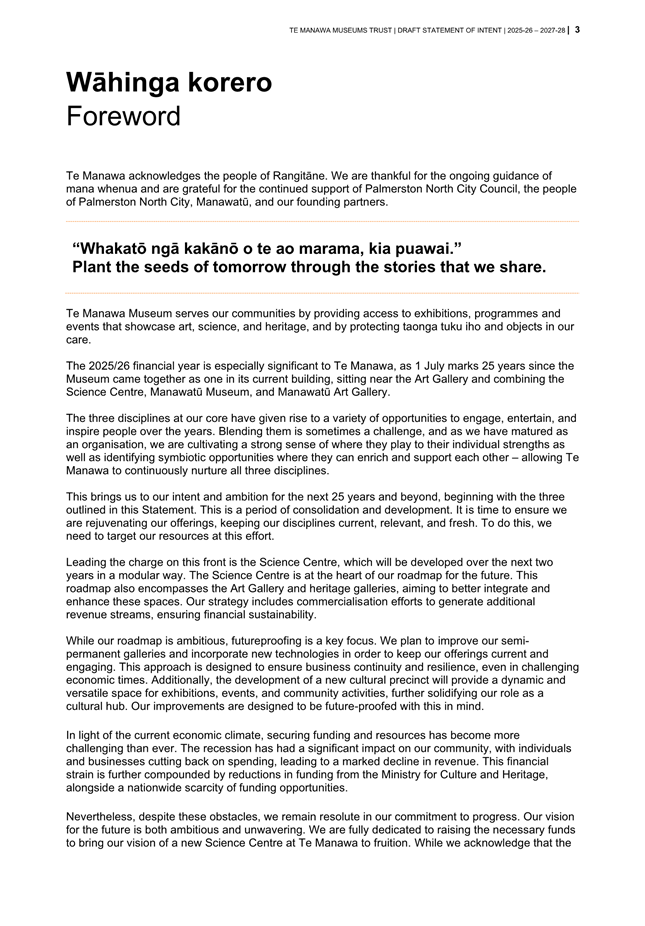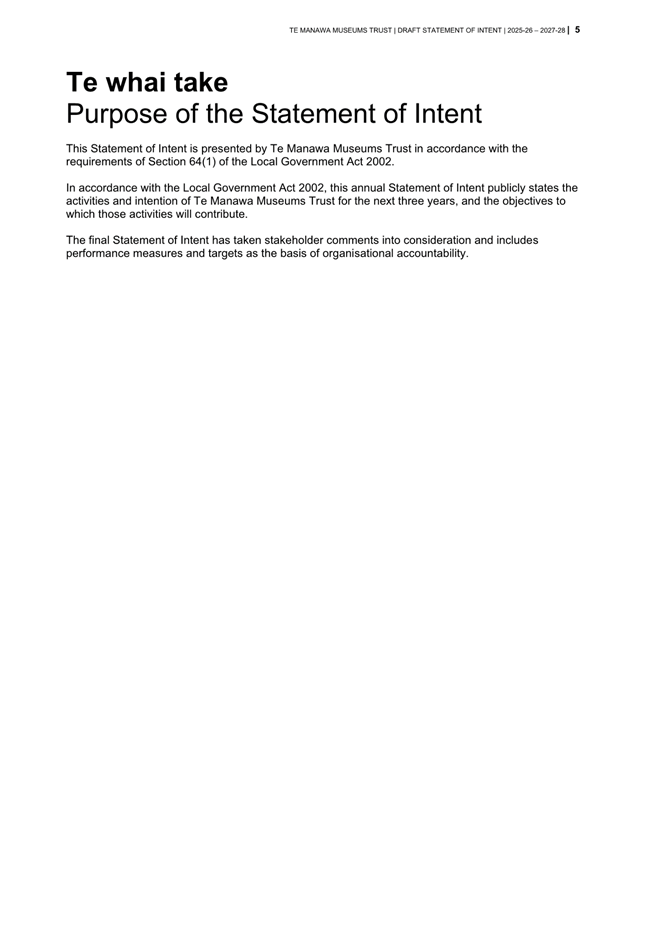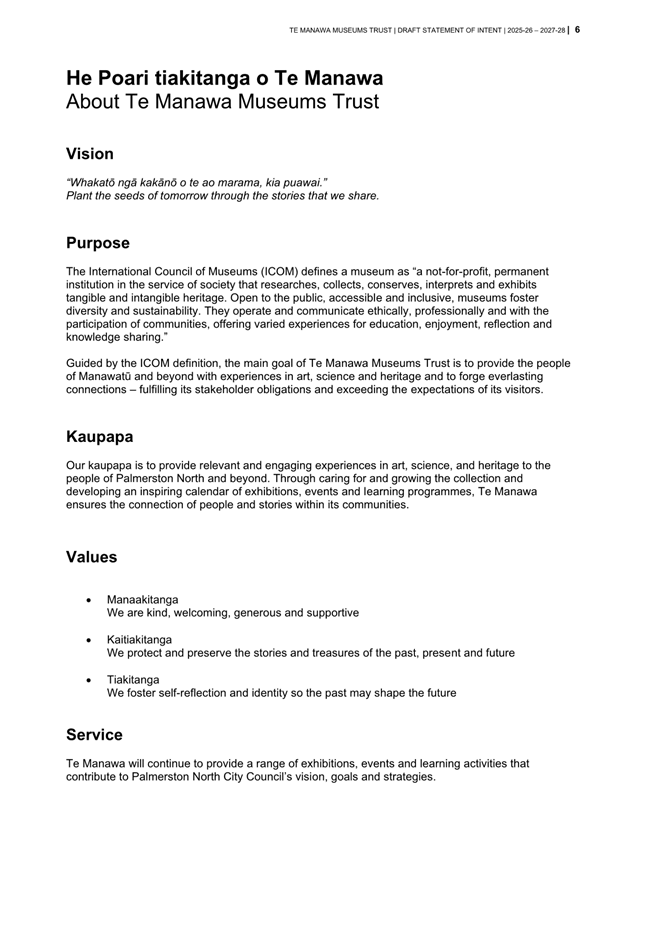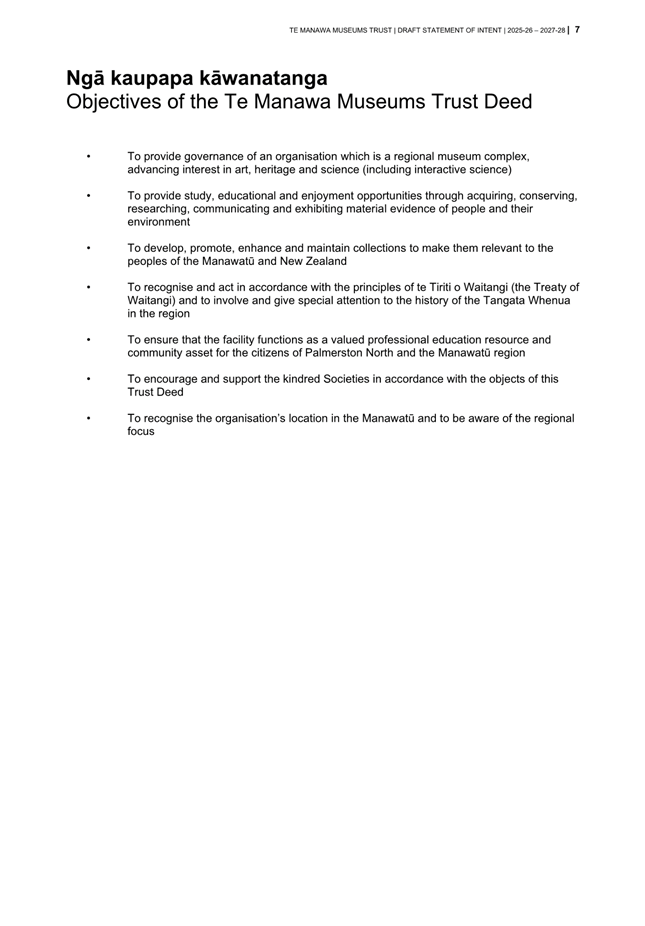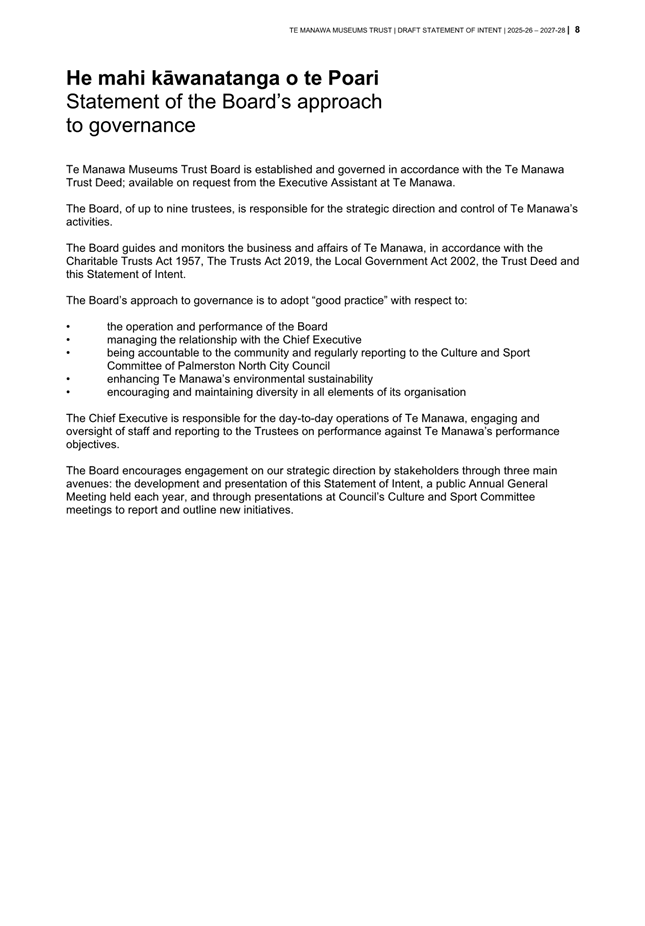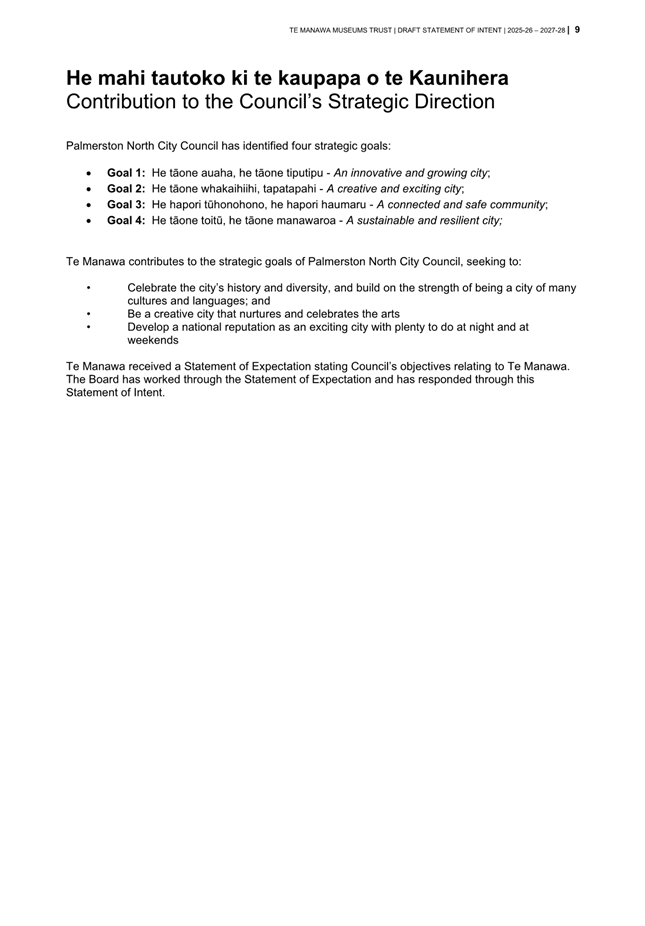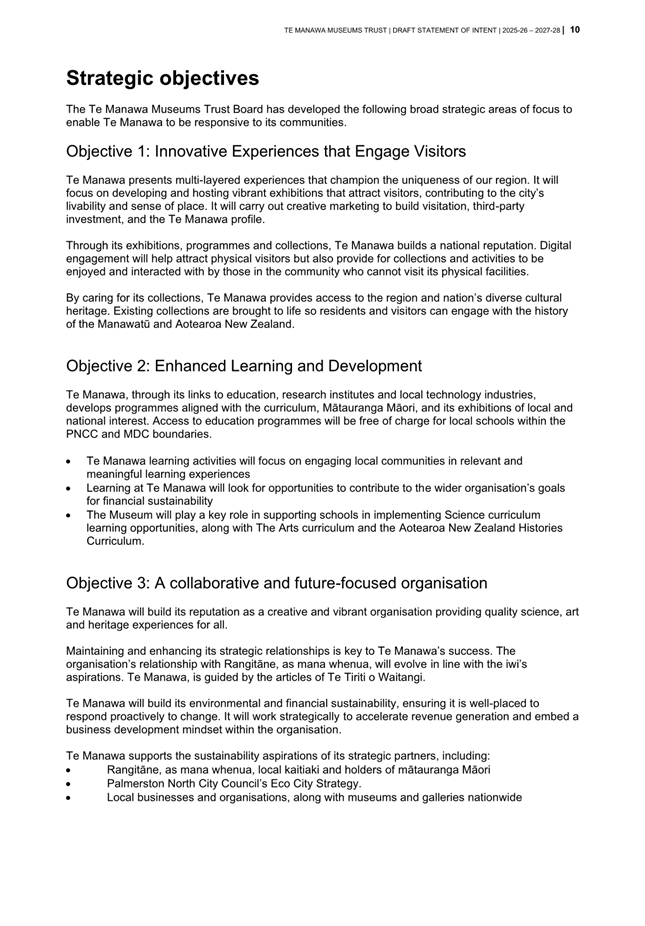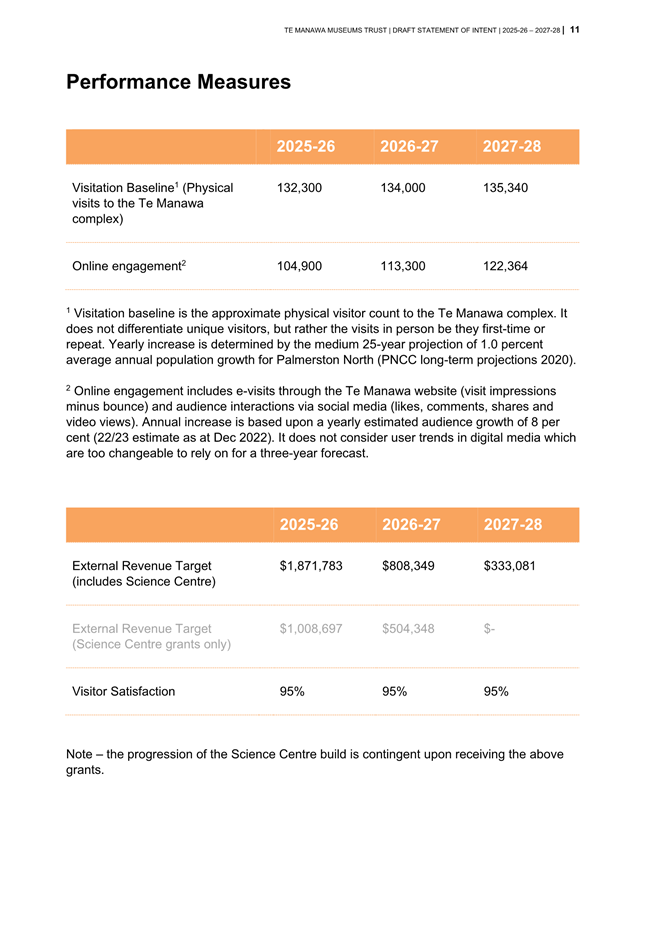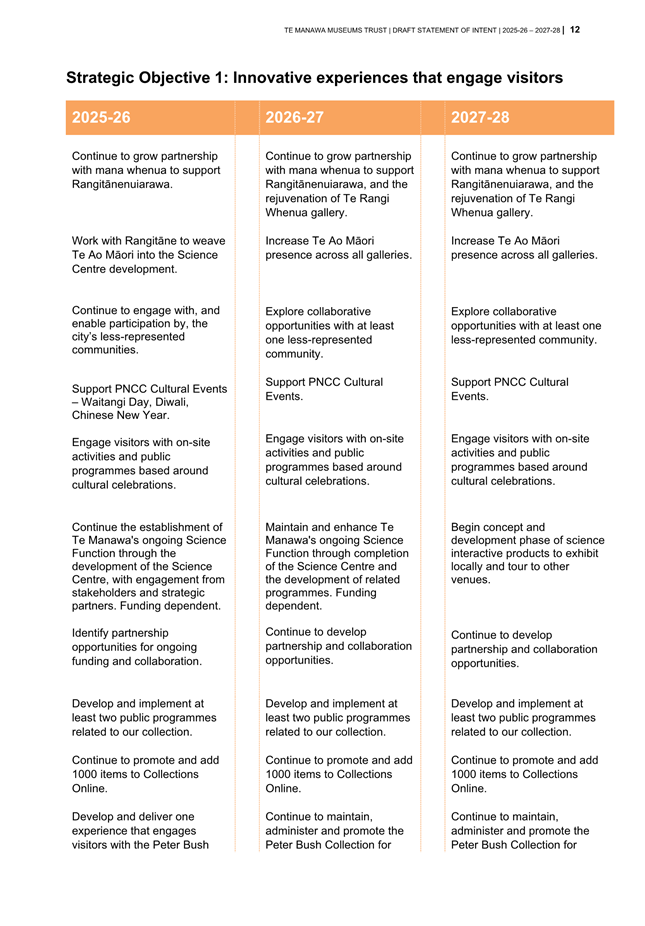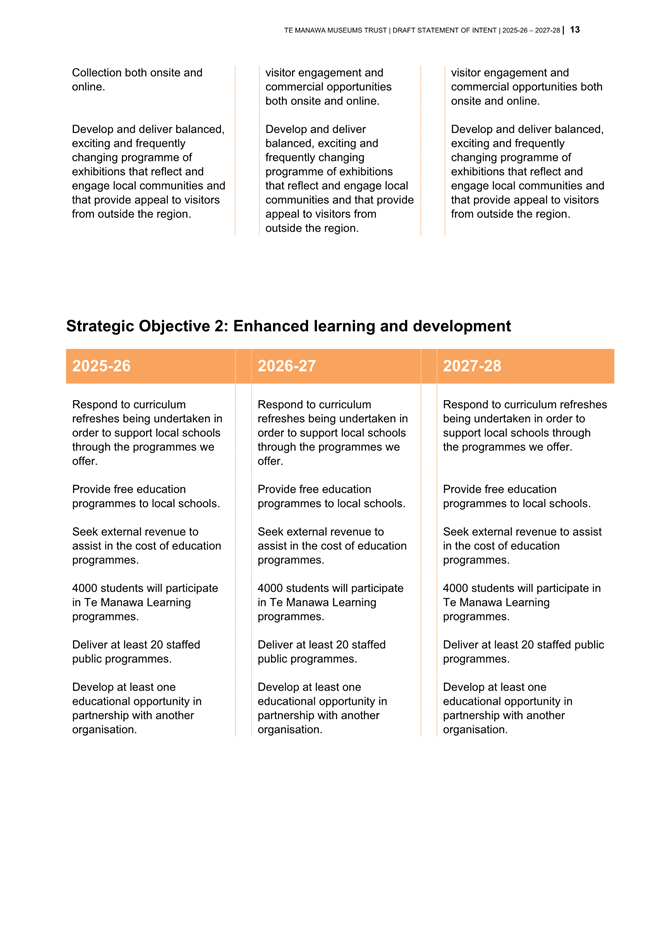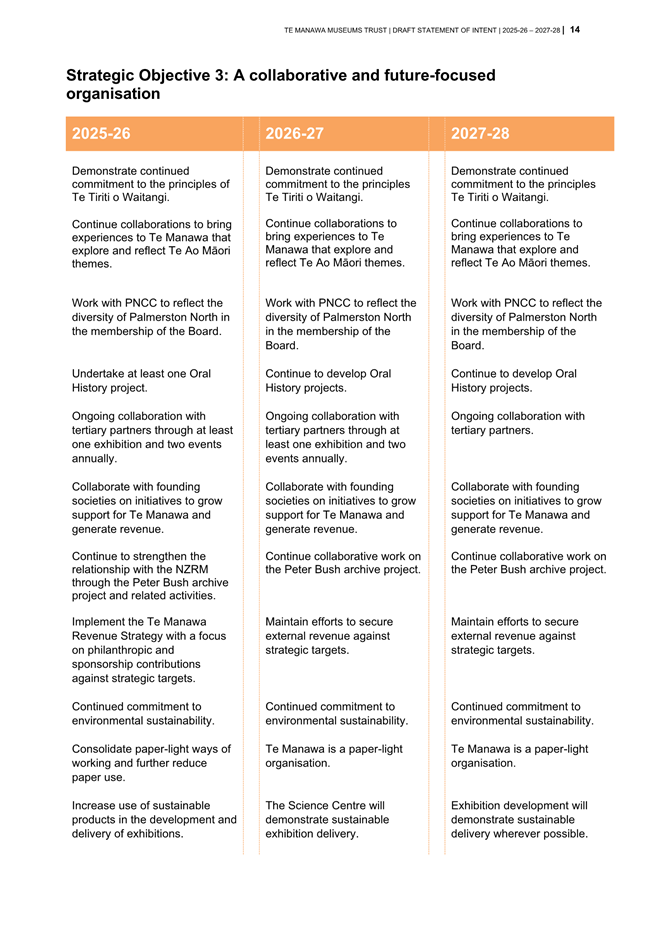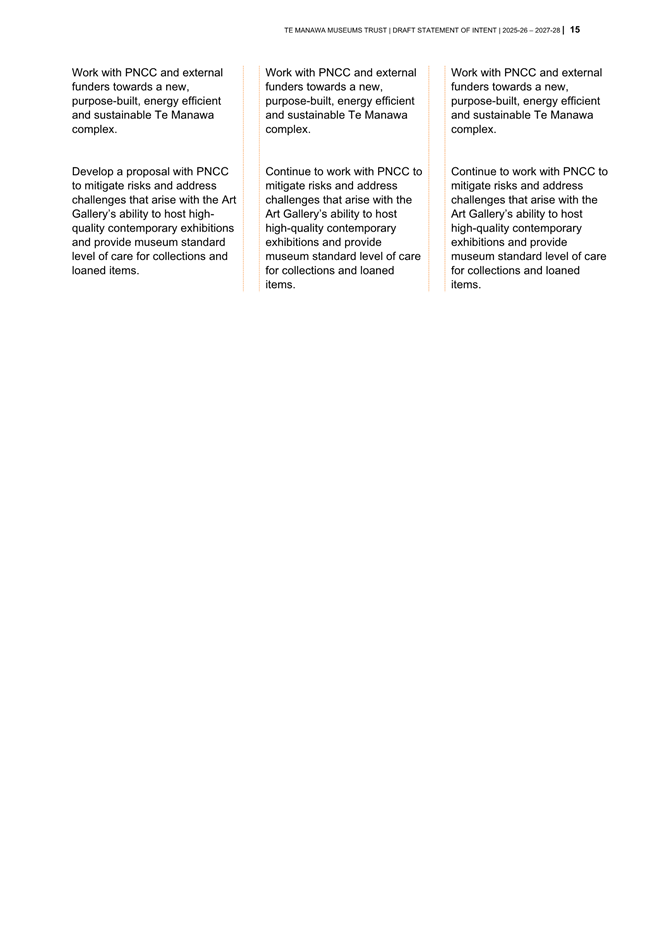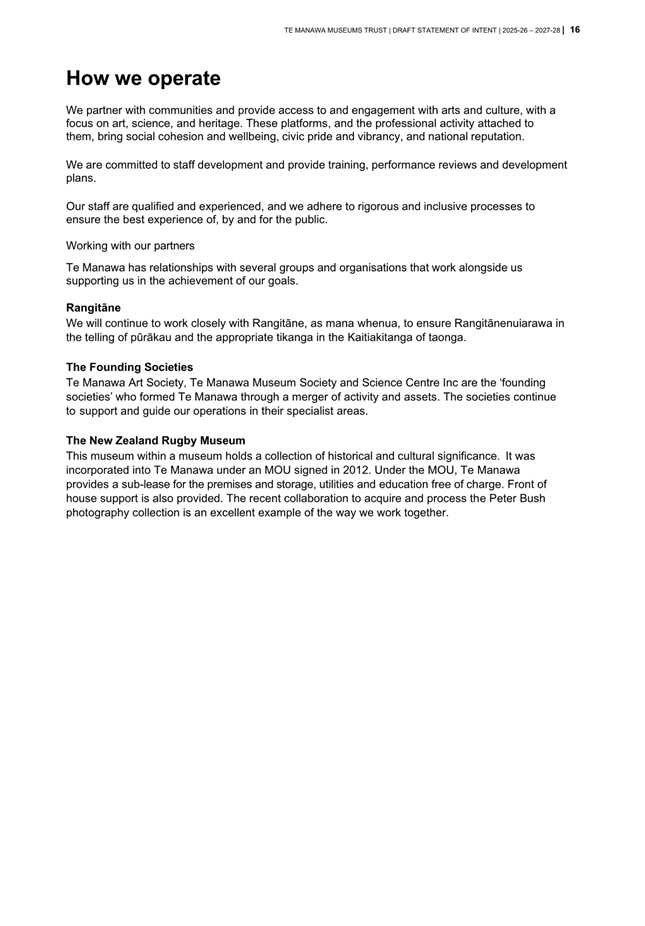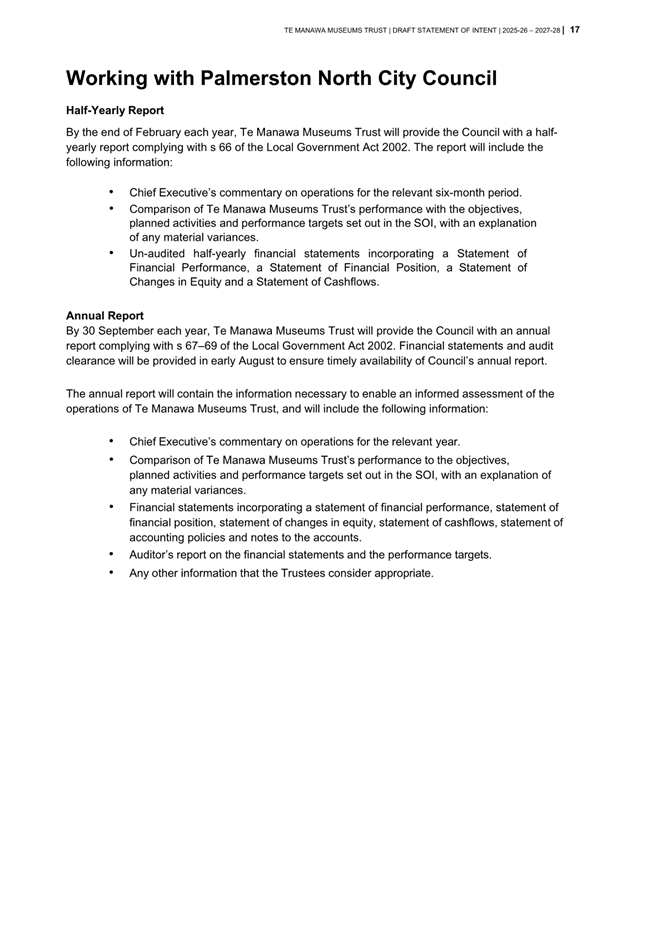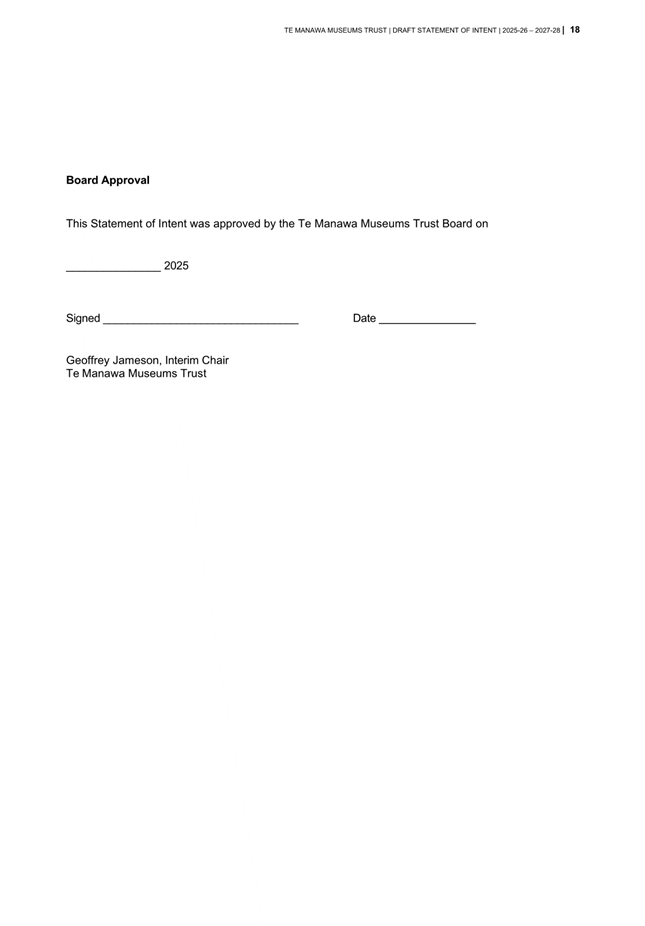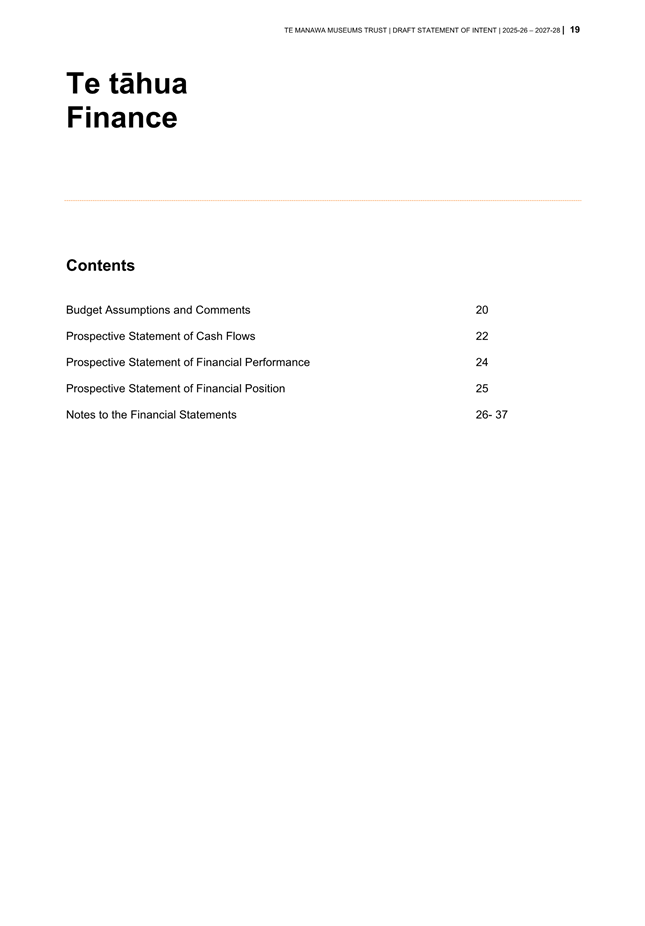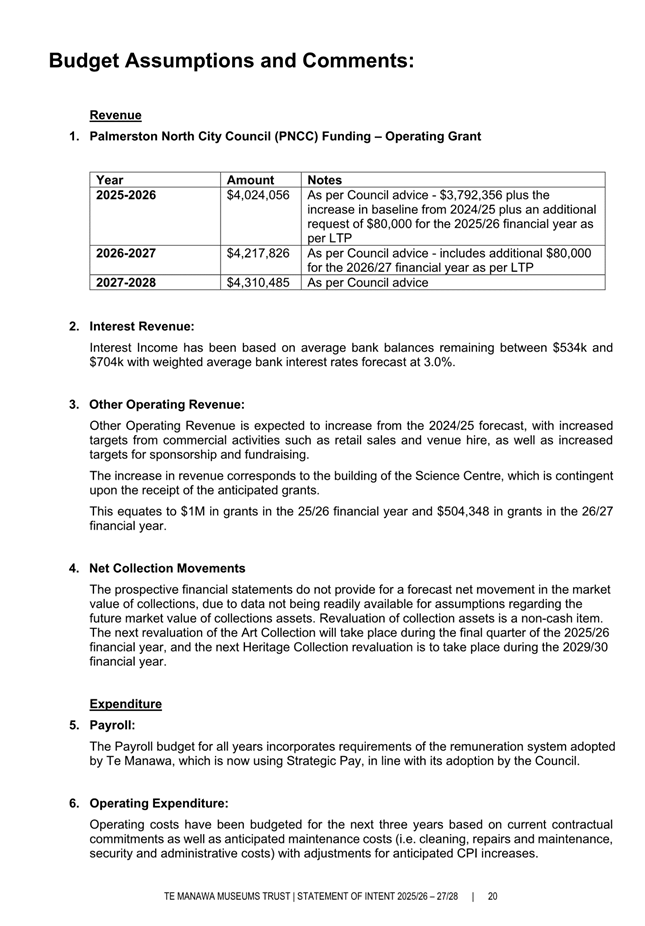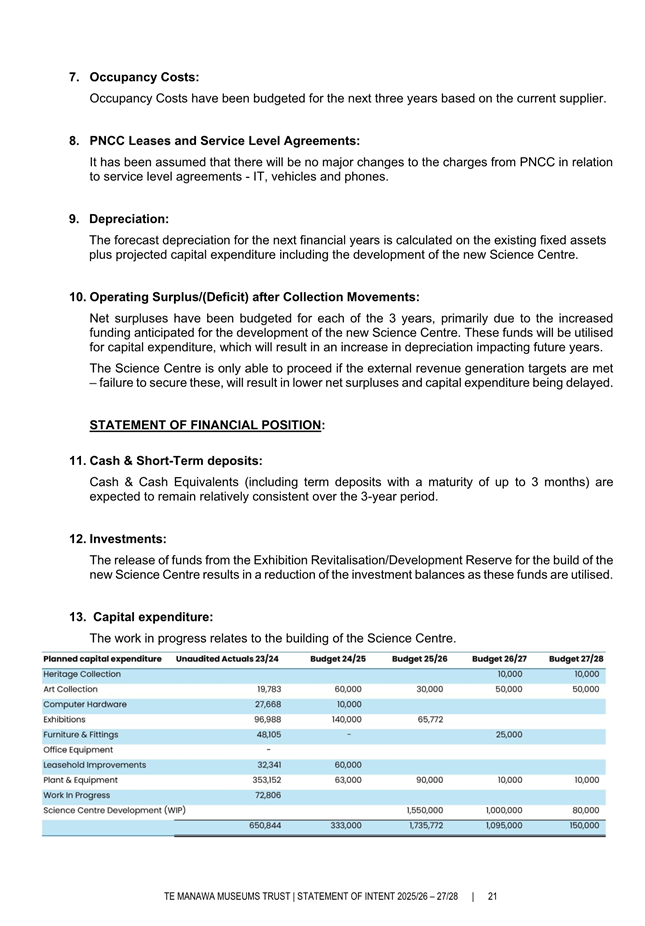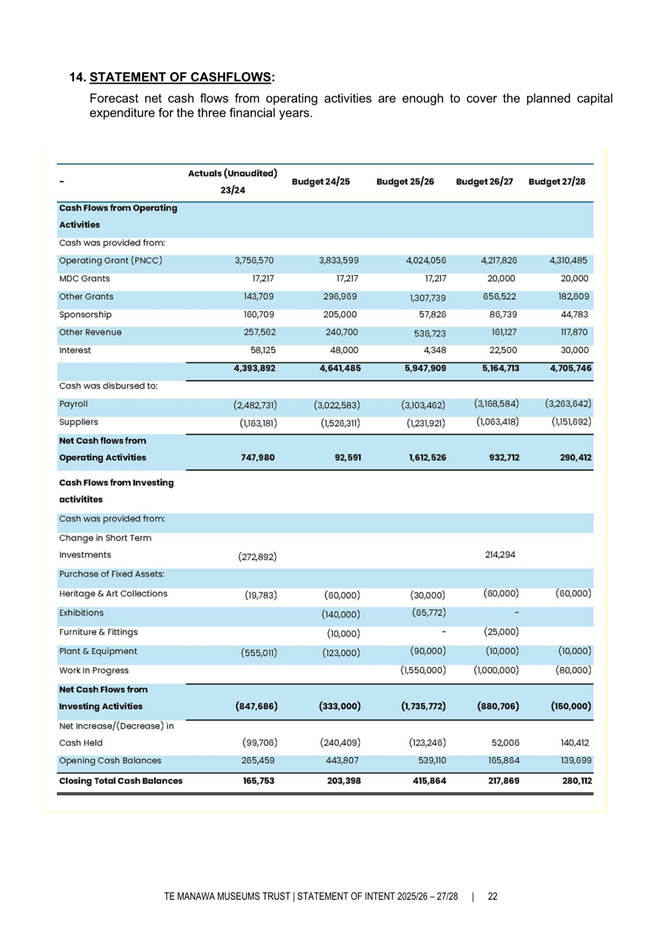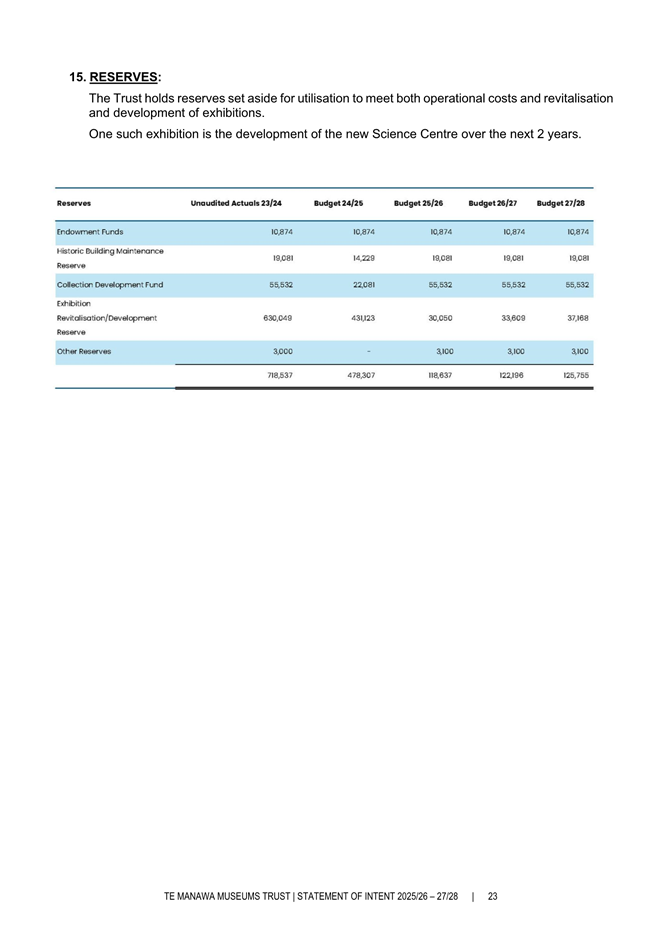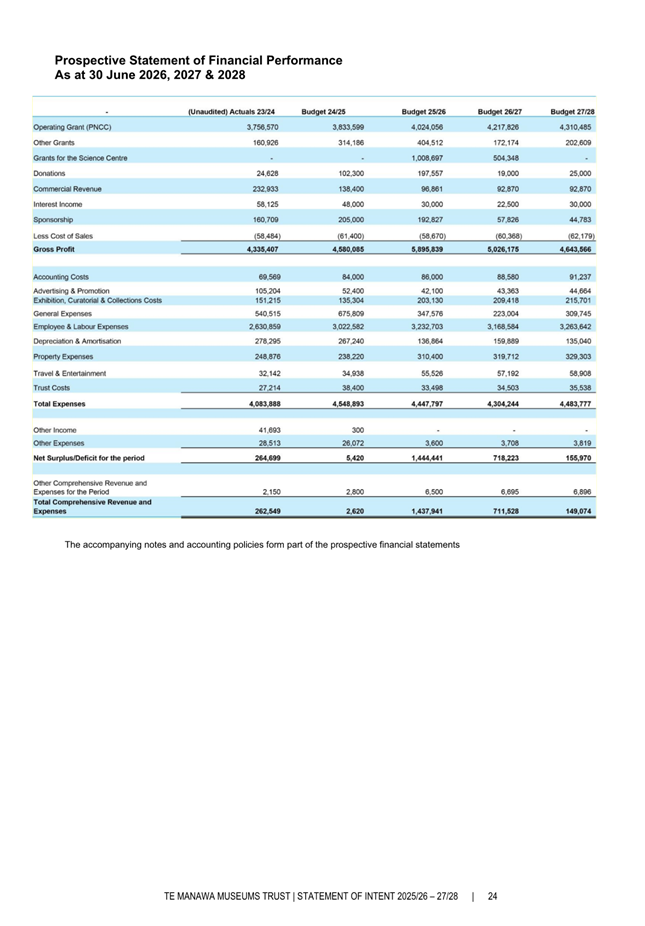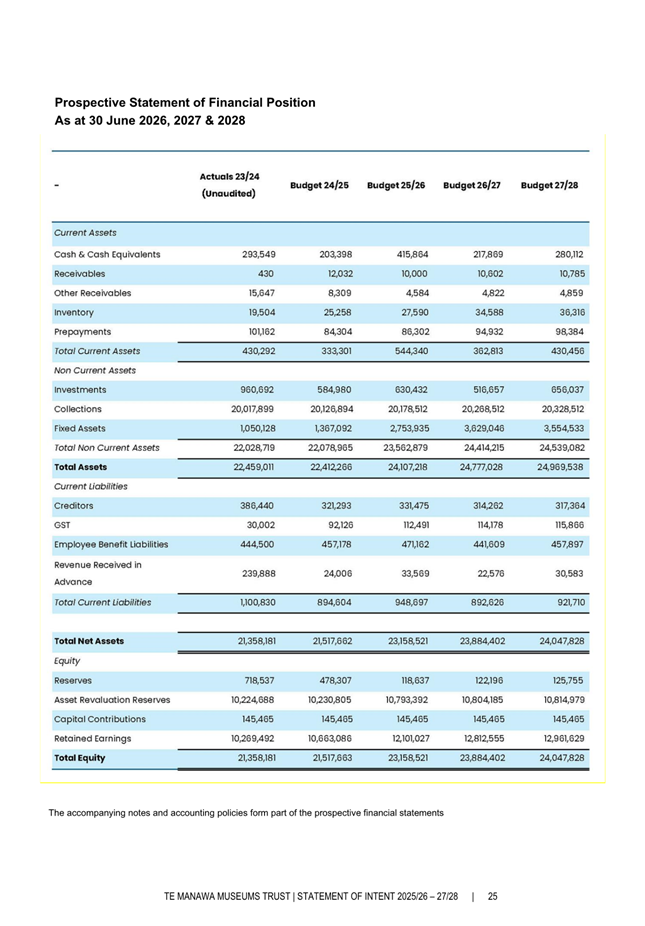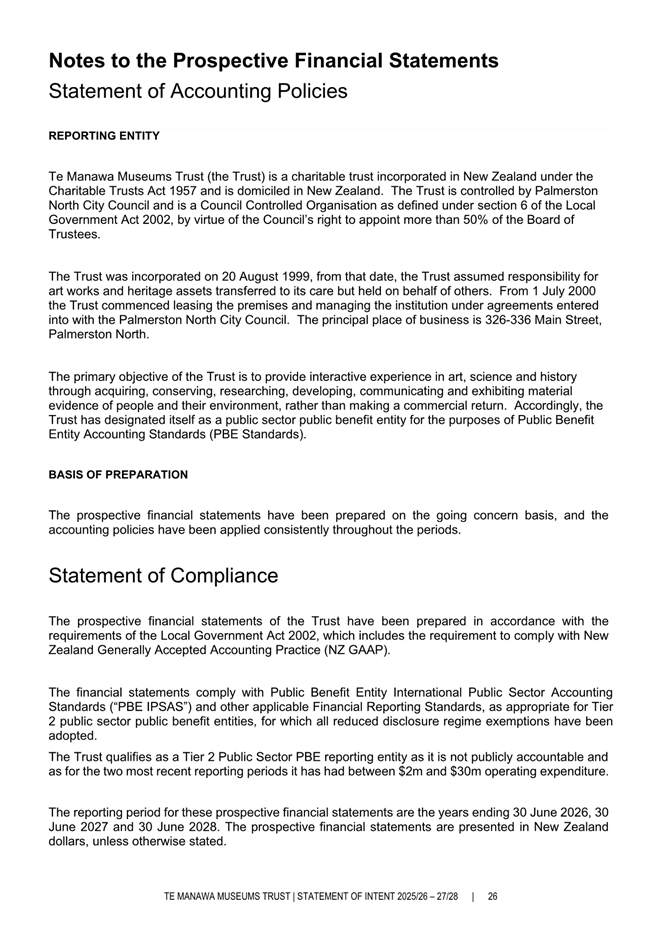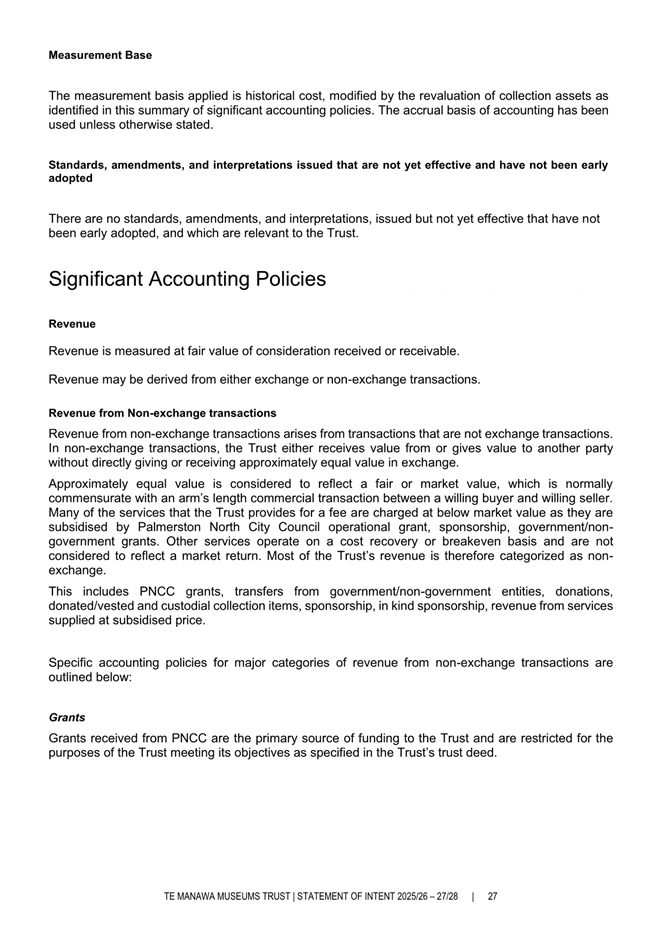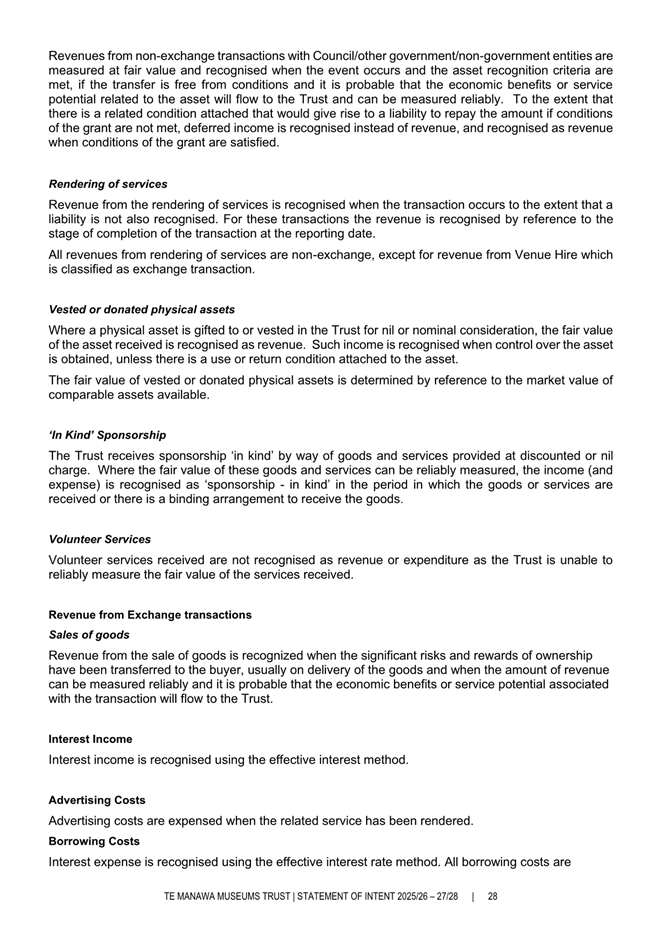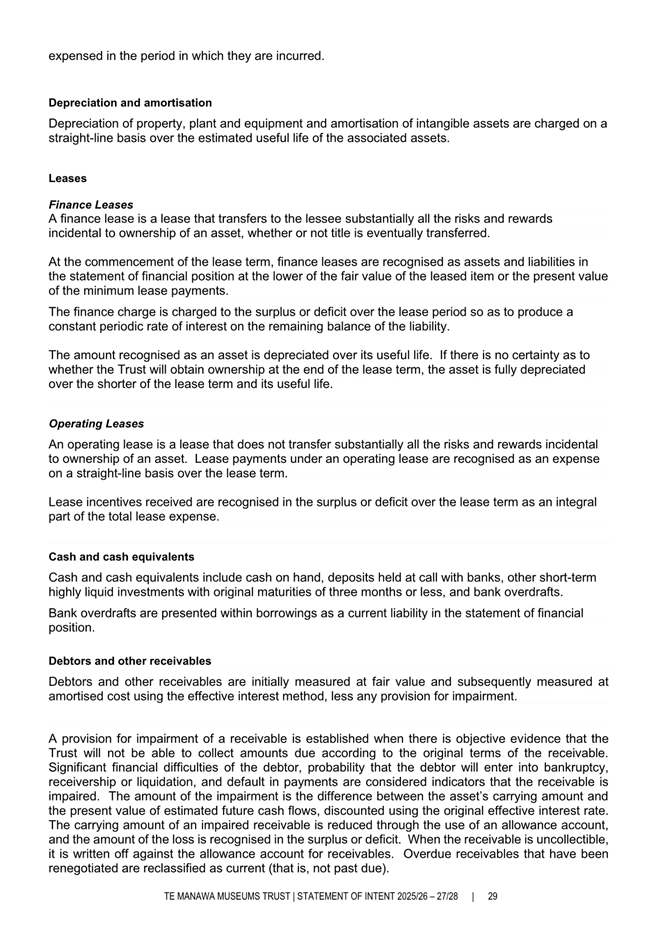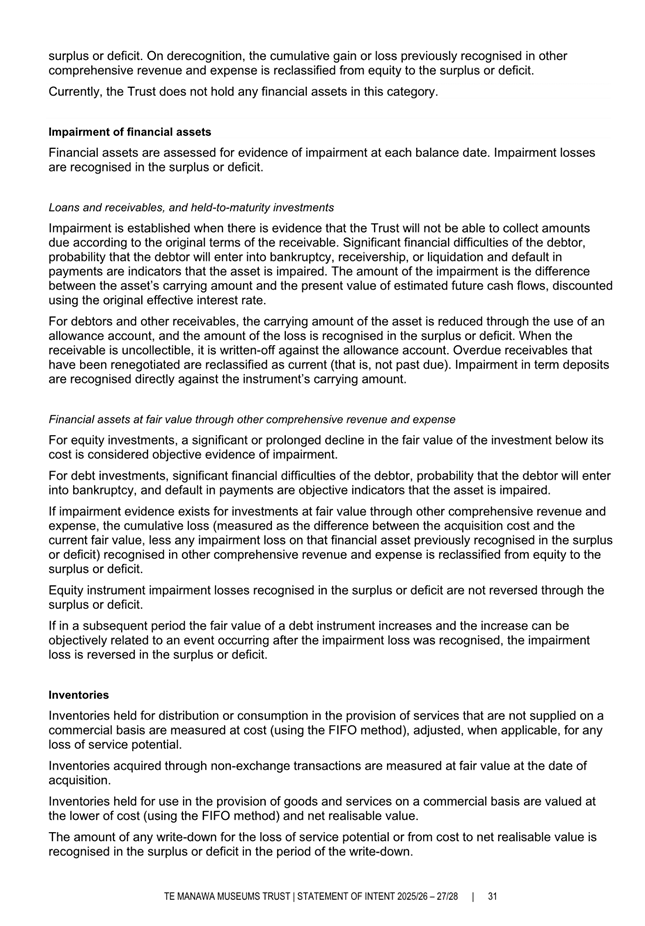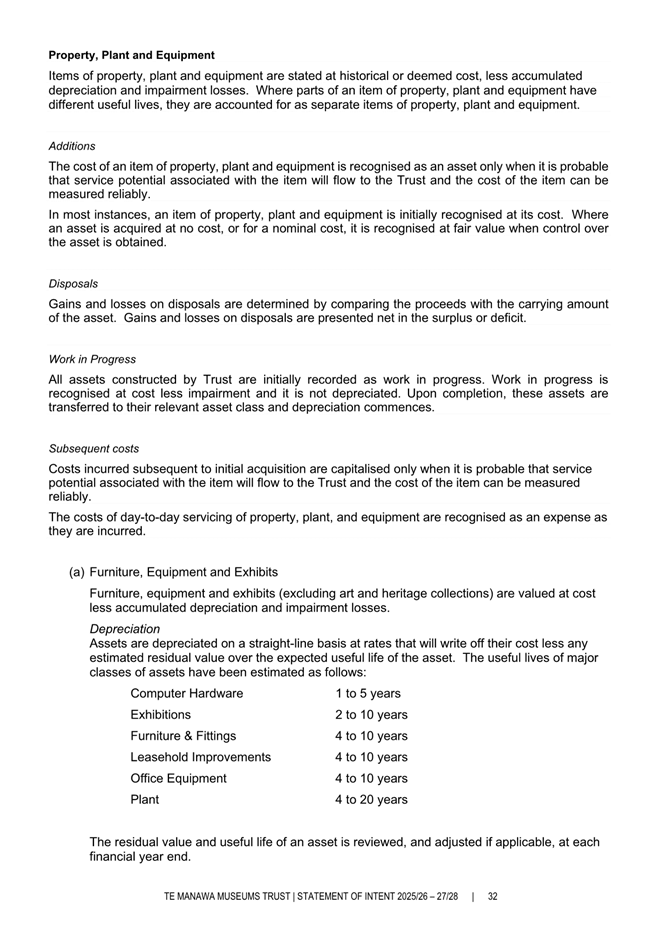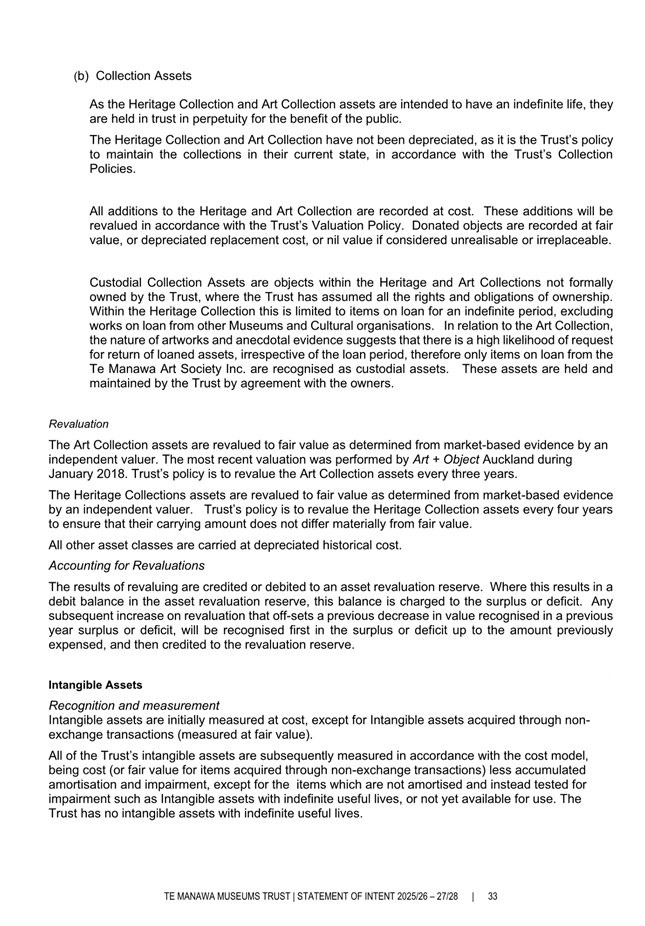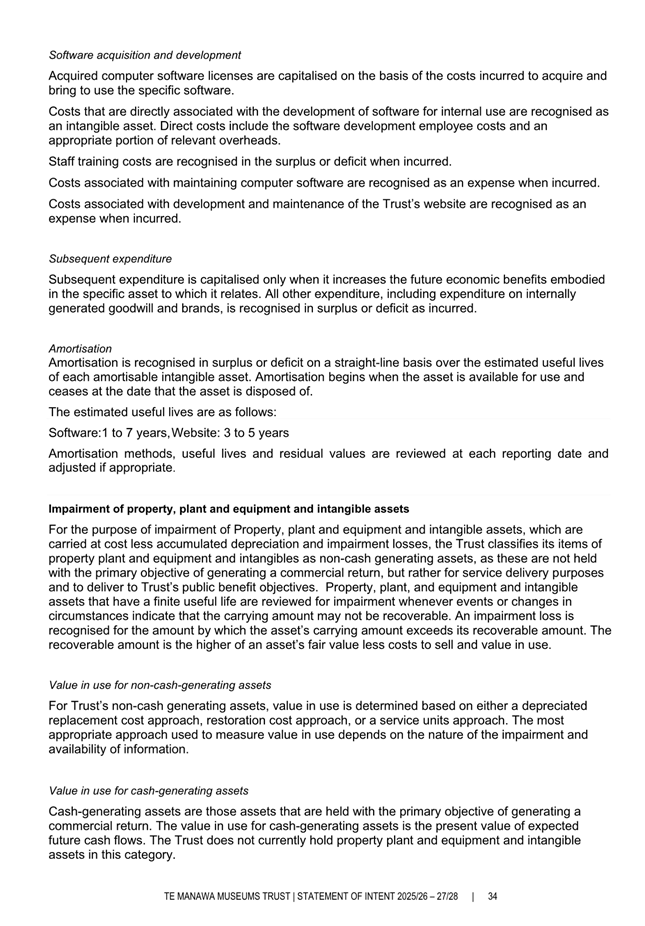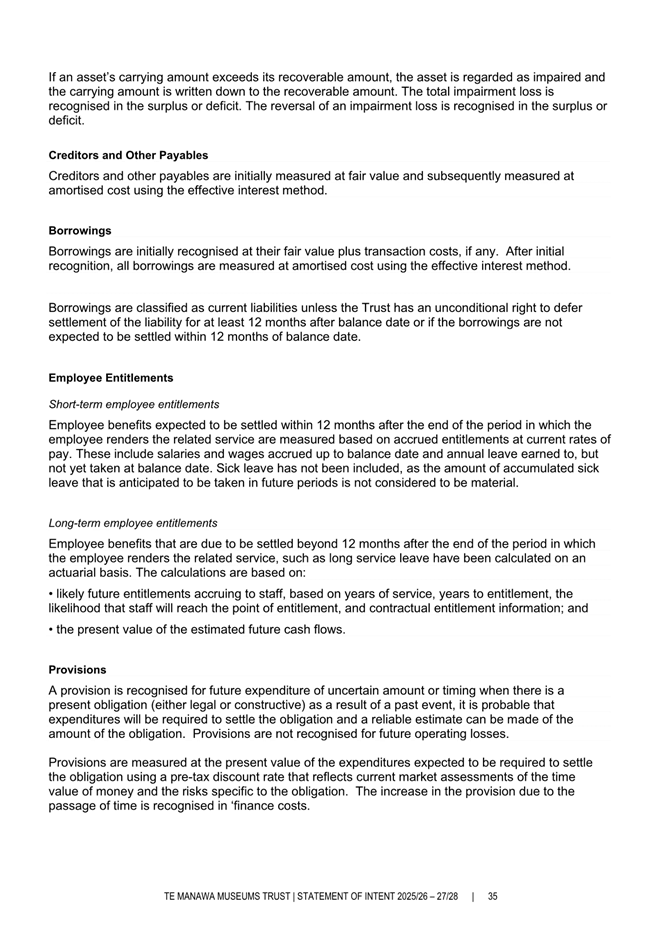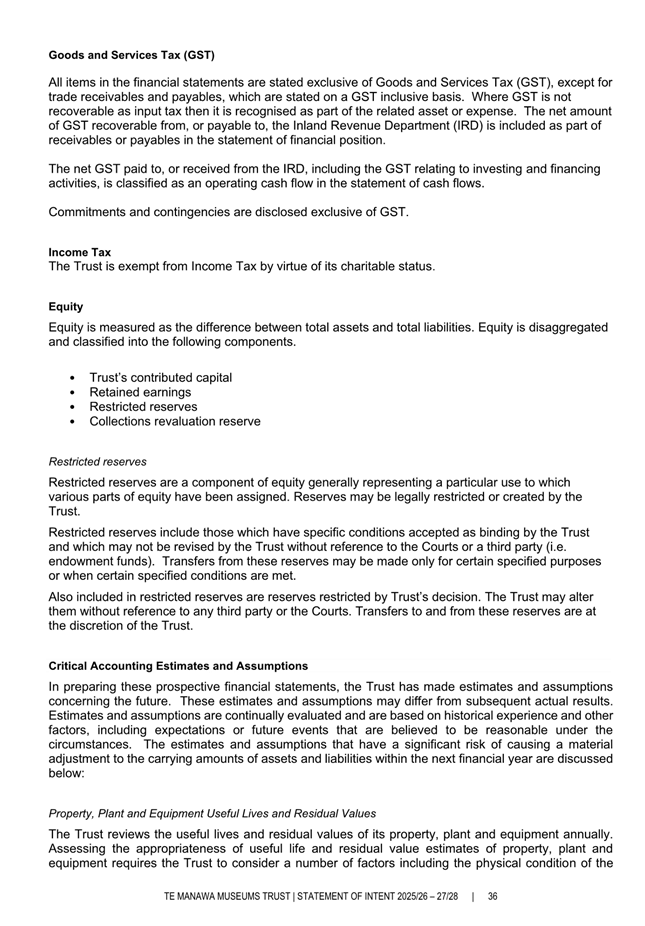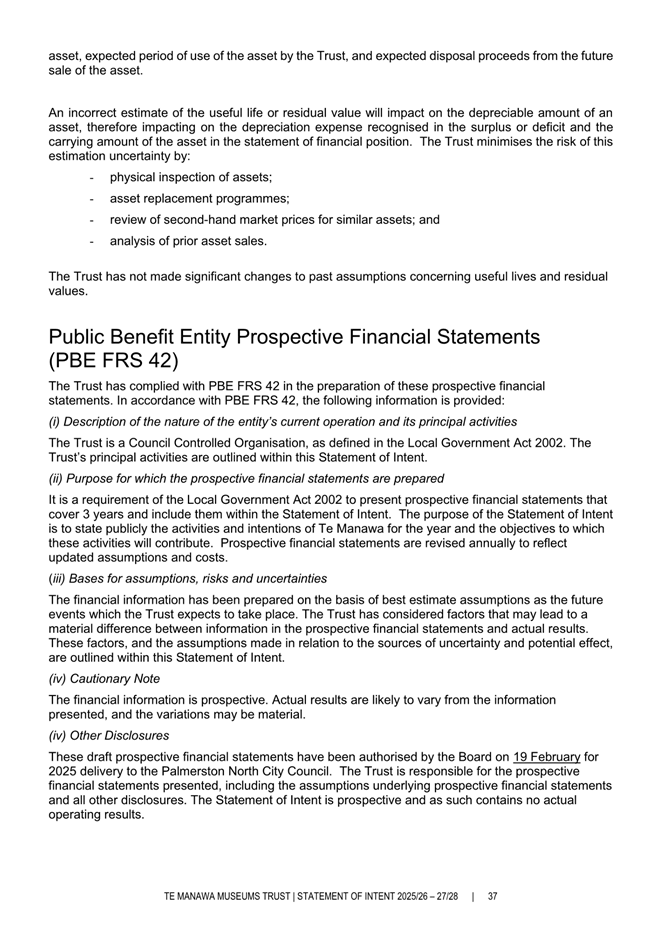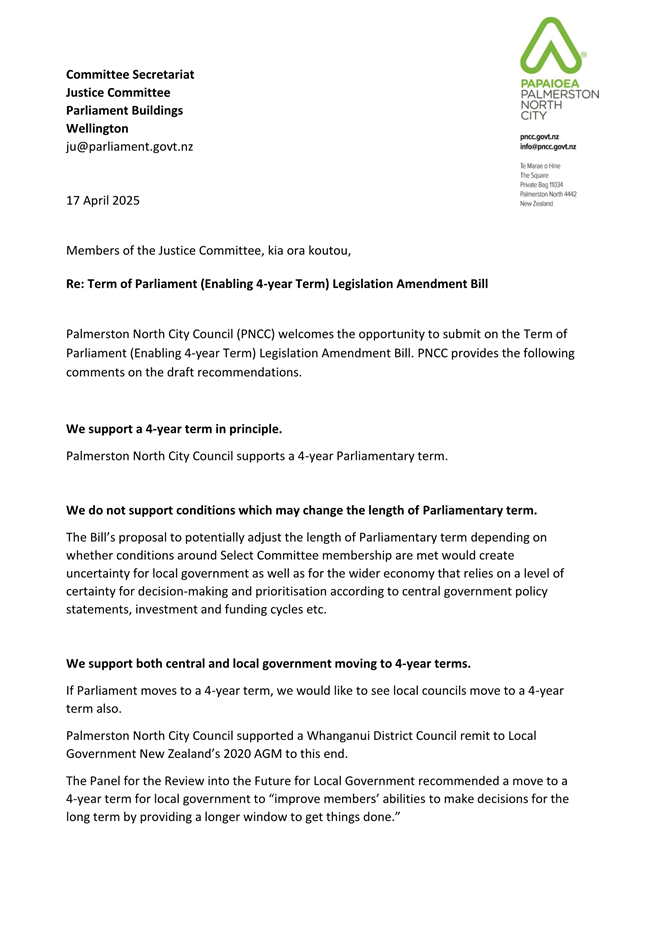|
Grant Smith (Mayor)
|
|
Debi Marshall-Lobb (Deputy Mayor)
|
|
Mark Arnott
|
Leonie Hapeta
|
|
Brent Barrett
|
Lorna Johnson
|
|
Rachel Bowen
|
Billy Meehan
|
|
Vaughan Dennison
|
Orphée Mickalad
|
|
Lew Findlay (QSM)
|
Karen Naylor
|
|
Roly Fitzgerald
|
William Wood
|
|
Patrick Handcock (ONZM)
|
Kaydee Zabelin
|
Council MEETING
7 May 2025
Order of Business
1. Karakia
Timatanga
2. Apologies
3. Notification
of Additional Items
Pursuant to
Sections 46A(7) and 46A(7A) of the Local Government Official Information and
Meetings Act 1987, to receive the Chairperson’s explanation that
specified item(s), which do not appear on the Agenda of this meeting and/or the
meeting to be held with the public excluded, will be discussed.
Any
additions in accordance with Section 46A(7) must be approved by resolution with
an explanation as to why they cannot be delayed until a future meeting.
Any
additions in accordance with Section 46A(7A) may be received or referred to a
subsequent meeting for further discussion. No resolution, decision or
recommendation can be made in respect of a minor item.
4. Declarations
of Interest (if any)
Members
are reminded of their duty to give a general notice of any interest of items to
be considered on this agenda and the need to declare these interests.
5. Public
Comment
To receive
comments from members of the public on matters specified on this Agenda or, if
time permits, on other matters.
6. Confirmation
of Minutes Page 7
That the minutes of the ordinary Council meeting of 2 April
2025 Part I Public be confirmed as a true and correct record.
Reports
7. Consideration
of options to take forward for Nature Calls Page 15
Report, presented by Mike
Monaghan, Manager - 3 Waters and Anna Lewis, Project Manager.
8. Capital
Delivery 2025/26 Page 59
Memorandum, presented by John
Aitken, Manager Project Management Office.
9. Draft
Health Promotion Policy - Deliberations Page 65
Report, presented by David
Murphy, General Manager Strategic Planning.
10. Quarterly
Performance and Financial Report - period ending 31 March 2025 Page 117
Memorandum, presented by Scott
Mancer, Manager - Finance and John Aitken, Manager - Project Management Office.
11. Treasury Report -
Nine months ending 31 March 2025 Page 191
Memorandum, presented by Steve
Paterson, Manager - Financial Strategy.
12. Te Manawa Museums
Trust: Six-Month Report 1 July - 31 December 2024 and Draft Statement of
Intent 2025-28 Page 203
Memorandum, presented by Sarah
Claridge, Governance Advisor.
13. Roslyn Community
Hub Page 279
Report, presented by Martin
Brady, Community Development Advisor and Bill Carswell, Activities
Manager - Property Services.
14. Submission on Term
of Parliament (Enabling 4-year Term) Legislation Amendment Bill Page 291
Memorandum, presented by Hannah
White, Manager Governance.
15. Council Work
Schedule Page 295
16. Karakia
Whakamutunga
17. Exclusion of Public
|
|
To be moved:
That the public be excluded from the following parts
of the proceedings of this meeting listed in the table below.
The general subject of each matter to be considered
while the public is excluded, the reason for passing this resolution in
relation to each matter, and the specific grounds under Section 48(1) of the
Local Government Official Information and Meetings Act 1987 for the passing
of this resolution are as follows:
|
General subject of each matter to be
considered
|
Reason for passing this resolution in
relation to each matter
|
Ground(s) under Section 48(1) for
passing this resolution
|
|
18.
|
Confirmation of the minutes of the ordinary
Council meeting of 2 April 2025 Part II Confidential
|
For the reasons set out in the Council of 2 April
2025, held in public present.
|
|
19.
|
Purchase of two parcels of land for the
purpose of a City East Bore and a City North Bore.
|
COMMERCIAL ACTIVITIES:
This information needs to be kept confidential to
allow Council to engage in commercial activities without prejudice or
disadvantage
|
s7(2)(h)
|
This resolution is made in reliance on Section
48(1)(a) of the Local Government Official Information and Meetings Act 1987
and the particular interest or interests protected by Section 6 or Section 7
of that Act which would be prejudiced by the holding of the whole or the
relevant part of the proceedings of the meeting in public as stated in the
above table.
|
Palmerston North City Council
Minutes of
the Council Meeting Part I Public, held in the Council Chamber, First Floor,
Civic Administration Building, 32 The Square, Palmerston North on 02 April 2025,
commencing at 9.06am.
|
Members
Present:
|
Grant Smith (The Mayor) (in the Chair)
and Councillors Debi Marshall-Lobb, Mark Arnott, Brent Barrett, Vaughan
Dennison, Lew Findlay, Roly Fitzgerald, Patrick Handcock, Lorna Johnson,
Billy Meehan, Orphée Mickalad, William Wood and Kaydee Zabelin.
|
|
Members Present Online:
|
Councillors Leonie Hapeta, and Karen
Naylor.
|
|
Apologies:
|
Councillor Rachel Bowen (late arrival)
and Leonie Hapeta (early departure).
|
Councillor Leonie
Hapeta left the meeting at 10.10am after
consideration of clause 52-25.
|
|
Karakia
Timatanga
|
|
|
Councillor Debi Marshall-Lobb opened the meeting with
karakia.
|
|
44-25
|
Apologies
|
|
|
Moved
Grant Smith, seconded Debi Marshall-Lobb.
RESOLVED
1. That Council receive
the apologies.
|
|
|
Clause 44-25 above was
carried 15 votes to 0, the voting being as follows:
For:
The Mayor (Grant Smith) and
Councillors Debi Marshall-Lobb, Mark Arnott, Brent Barrett, Vaughan Dennison,
Lew Findlay, Roly Fitzgerald, Patrick Handcock, Leonie Hapeta, Lorna Johnson,
Billy Meehan, Orphée Mickalad, Karen Naylor, William Wood and Kaydee
Zabelin.
|
|
45-25
|
Presentation - Massey University Foundation
Presentation, by Mitch
Murdoch, Director of the Massey University Foundation.
Mitch presented the
Foundation’s vision to regenerate the riparian corridor along the
Massey University side of the Manawatū river. She sought financial
support from Council of $1M (over three years).
Presentation appended
separately to the minutes.
The Mayor moved an additional
motion to refer the presentation to the Annual Plan process, so it can be
considered alongside other proposed community and Council projects.
|
|
|
Moved
Grant Smith, seconded Debi Marshall-Lobb.
RESOLVED
1. That the
Council receive the presentation for information.
|
|
|
Clause 45-25 above was
carried 15 votes to 0, the voting being as follows:
For:
The Mayor (Grant Smith) and
Councillors Debi Marshall-Lobb, Mark Arnott, Brent Barrett, Vaughan Dennison,
Lew Findlay, Roly Fitzgerald, Patrick Handcock, Leonie Hapeta, Lorna Johnson,
Billy Meehan, Orphée Mickalad, Karen Naylor, William Wood and Kaydee
Zabelin.
|
|
|
Moved
Grant Smith, seconded Vaughan Dennison.
RESOLVED
2. That Council refer Massey University Foundation’s
presentation to the Annual Plan process.
|
|
|
Clause 45-25 above was
carried 9 votes to 6, the voting being as follows:
For:
The Mayor (Grant Smith) and
Councillors Debi Marshall-Lobb, Mark Arnott, Brent Barrett, Vaughan Dennison,
Roly Fitzgerald, Patrick Handcock, Leonie Hapeta, Orphée Mickalad
Against:
Councillors Lew Findlay,
Lorna Johnson, Billy Meehan, Karen Naylor, William Wood and Kaydee Zabelin.
|
|
46-25
|
Confirmation of Minutes
|
|
|
Moved
Grant Smith, seconded Debi Marshall-Lobb.
RESOLVED
1. That the minutes
of the ordinary Council meeting of 5 March 2025 Part I Public and Part II
Confidential be confirmed as a true and correct record.
|
|
|
Clause 46-25 above was
carried 15 votes to 0, the voting being as follows:
For:
The Mayor (Grant Smith) and
Councillors Debi Marshall-Lobb, Mark Arnott, Brent Barrett, Vaughan Dennison,
Lew Findlay, Roly Fitzgerald, Patrick Handcock, Leonie Hapeta, Lorna Johnson,
Billy Meehan, Orphée Mickalad, Karen Naylor, William Wood and Kaydee
Zabelin.
|
Reports
|
47-25
|
The
Globe Theatre Trust: Six-Month Report 1 July - 31 December 2024 and
Draft Statement of Intent 2024-27
Presented by Gerry Keating,
Manager and John Adams, Chair of the Globe Theatre Trust and Sarah Claridge,
Governance Advisor.
The Governance Advisor
corrected a figure in clause 4.9 of the report: Operations over this
reporting period has created a cash deficit of $27k not $43k as
stated.
|
|
|
Moved
Grant Smith, seconded Debi Marshall-Lobb.
RESOLVED
1. That Council
receive the Six-Month Performance Report 1 July - 31 December 2024
(Attachment 1) submitted by the Globe Theatre Trust.
2. That Council
receive the draft Statement of Intent 2025-28 (Attachment 3) submitted by the
Globe Theatre Trust.
3. That Council
agree that the recommended comments on the draft Statement of Intent
2025–28 outlined in Table 3 be advised to the Globe Theatre Trust
Board.
|
|
|
Clause 47-25 above was
carried 15 votes to 0, the voting being as follows:
For:
The Mayor (Grant Smith) and
Councillors Debi Marshall-Lobb, Mark Arnott, Brent Barrett, Vaughan Dennison,
Lew Findlay, Roly Fitzgerald, Patrick Handcock, Leonie Hapeta, Lorna Johnson,
Billy Meehan, Orphée Mickalad, Karen Naylor, William Wood and Kaydee
Zabelin.
|
|
48-25
|
Transport Emergency Works
Report, presented by Glen
O'Connor, Manager Transport.
|
|
|
Moved
Grant Smith, seconded Debi Marshall-Lobb.
RESOLVED
1. That Council
approve an increase in the budget for programme 2380 Citywide –
Transport – Emergency Reinstatements by $451k to be funded by
a. an increase in
capital revenue of $111k from New Zealand Transport Authority – Waka
Kotahi
b. and a budget
decrease of $340k from programme 1054 Ashhurst – Water Quality
Improvements
|
|
|
Clause 48-25 above was
carried 15 votes to 0, the voting being as follows:
For:
The Mayor (Grant Smith) and
Councillors Debi Marshall-Lobb, Mark Arnott, Brent Barrett, Vaughan Dennison,
Lew Findlay, Roly Fitzgerald, Patrick Handcock, Leonie Hapeta, Lorna Johnson,
Billy Meehan, Orphée Mickalad, Karen Naylor, William Wood and Kaydee
Zabelin.
|
|
49-25
|
Roxburgh Crescent Land Classification
Report, presented by Aaron
Phillips - Activities Manager Parks.
|
|
|
Moved
Grant Smith, seconded Debi Marshall-Lobb.
RESOLVED
1. That Council declare
approximately 400 m² of the access leg portion of Pt Lot 2 DP 60866
contained in certificate of title WN31C/75 to be road reserve.
2. That Council declare
approximately 5,084 m² of Pt Lot 2 DP 60866 contained
in certificate of title WN31C/75 on and over the stop bank of the
Manawatū River Park to be recreation reserve under the Reserves Act
1977.
3. That Council
make the reserve declaration and classifications in resolution 1 and 2
subject to:
a. The Plan Change
E: Roxburgh Residential Area becoming operative, and
b. Subdivision of the surrounding land
that ensures that the road reserve portion of this reserve declaration is
contiguous with a vested road reserve at the time of subdivision.
4. That Council
note that:
a. the precise partition of area
between the road and recreation reserves portions will be determined at the
time of the subdivision of the surrounding land in order to align with the
road reserves created during that residential subdivision.
b. The portion to be declared road
reserve will require subdivision from the portion that will be recreation
reserve. This will be carried out at the time of subdivision of the
surrounding land and associated roads.
|
|
|
Clause 49-25 above was
carried 15 votes to 0, the voting being as follows:
For:
The Mayor (Grant Smith) and
Councillors Debi Marshall-Lobb, Mark Arnott, Brent Barrett, Vaughan Dennison,
Lew Findlay, Roly Fitzgerald, Patrick Handcock, Leonie Hapeta, Lorna Johnson,
Billy Meehan, Orphée Mickalad, Karen Naylor, William Wood and Kaydee
Zabelin.
|
|
50-25
|
Elected Members' Meeting Attendance Statistics - 1 July
2024 to 31 December 2024
Memorandum, presented by
Hannah White - Manager Governance.
|
|
|
Moved
Grant Smith, seconded Debi Marshall-Lobb.
RESOLVED
1. That Council
receive the memorandum titled ‘Elected Members’ Meeting
Attendance Statistics - 1 July 2024 to 31 December 2024’ dated 2 April
2025 for information.
|
|
|
Clause 50-25 above was
carried 15 votes to 0, the voting being as follows:
For:
The Mayor (Grant Smith) and
Councillors Debi Marshall-Lobb, Mark Arnott, Brent Barrett, Vaughan Dennison,
Lew Findlay, Roly Fitzgerald, Patrick Handcock, Leonie Hapeta, Lorna Johnson,
Billy Meehan, Orphée Mickalad, Karen Naylor, William Wood and Kaydee
Zabelin.
|
|
51-25
|
Council Work Schedule
|
|
|
Moved
Grant Smith, seconded Debi Marshall-Lobb.
RESOLVED
1. That Council
receive its Work Schedule dated 2 April 2025.
|
|
|
Clause 51-25 above was
carried 15 votes to 0, the voting being as follows:
For:
The Mayor (Grant Smith) and
Councillors Debi Marshall-Lobb, Mark Arnott, Brent Barrett, Vaughan Dennison,
Lew Findlay, Roly Fitzgerald, Patrick Handcock, Leonie Hapeta, Lorna Johnson,
Billy Meehan, Orphée Mickalad, Karen Naylor, William Wood and Kaydee
Zabelin.
|
Recommendations from Committee Meetings
|
52-25
|
Risk & Assurance Committee Part I Public - 12 March
2025
Councillor Dennison presented the recommendation
below:
|
|
|
Moved Vaughan Dennison, seconded William Wood.
RESOLVED
1. That
Council adopt the recommendation from the Risk & Assurance Committee of
12 March 2025:
Setting Council's Risk Management Appetite and
Tolerance Levels (clause 9-25)
Memorandum, presented by
Stephen Minton, Risk Management Advisor.
The COMMITTEE RECOMMENDS
1. That Council
reconfirm the risk appetite and risk tolerance levels as noted in section 3.1
and 3.2 of the memorandum titled ‘Setting Council’s Risk
Management Appetite and Tolerance levels’, presented to the Risk and
Assurance Committee on 12 March 2025.
|
|
|
Clause 52-25 above was carried 15 votes to 0, the voting being as
follows:
For:
The Mayor (Grant Smith) and
Councillors Debi Marshall-Lobb, Mark Arnott, Brent Barrett, Vaughan Dennison,
Lew Findlay, Roly Fitzgerald, Patrick Handcock, Leonie Hapeta, Lorna Johnson,
Billy Meehan, Orphée Mickalad, Karen Naylor, William Wood and Kaydee
Zabelin.
|
Councillor Leonie Hapeta left the meeting at 10.10am.
Exclusion
of Public
|
53-25
|
Recommendation to
Exclude Public
|
|
|
Moved Grant Smith, seconded Patrick Handcock.
RESOLVED
That the public be excluded from the following parts
of the proceedings of this meeting listed in the table below.
The general subject of each matter to be considered
while the public is excluded, the reason for passing this resolution in
relation to each matter, and the specific grounds under Section 48(1) of the
Local Government Official Information and Meetings Act 1987 for the passing
of this resolution are as follows:
|
General subject of each matter to be
considered
|
Reason for passing this resolution in
relation to each matter
|
Ground(s) under Section 48(1) for
passing this resolution
|
|
19
|
Te Āpiti Ashhurst (3 bridges) Loop - Land
Purchase and Progress
|
NEGOTIATIONS:
This information needs to be kept confidential to
ensure that Council can negotiate effectively, especially in business
dealings
|
s7(2)(i)
|
|
20.
|
Nature Calls - Lead Technical Consultant contract
extension
|
THIRD PARTY COMMERCIAL:
Disclosing the information could harm a company's
commercial position
and NEGOTIATIONS:
This information needs to be kept confidential to
ensure that Council can negotiate effectively, especially in business
dealings
|
s7(2)(b)(ii) and s7(2)(i)
|
This resolution is made in reliance on Section
48(1)(a) of the Local Government Official Information and Meetings Act 1987
and the particular interest or interests protected by Section 6 or Section 7
of that Act which would be prejudiced by the holding of the whole or the
relevant part of the proceedings of the meeting in public as stated in the
above table.
|
|
|
Clause 53-25 above was carried 14 votes to 0, the voting being as
follows:
For:
The Mayor (Grant Smith) and
Councillors Debi Marshall-Lobb, Mark Arnott, Brent Barrett, Vaughan Dennison,
Lew Findlay, Roly Fitzgerald, Patrick Handcock, Lorna Johnson, Billy Meehan,
Orphée Mickalad, Karen Naylor, William Wood and Kaydee Zabelin.
|
The public part of the meeting finished at 10.12am
The meeting adjourned for 27 minutes
Confirmed 7 May 2025
Mayor
TO: Council
MEETING DATE: 7
May 2025
TITLE: Consideration
of options to take forward for Nature Calls
PRESENTED BY: Mike
Monaghan Manager 3 Waters and Anna Lewis Project Manager
APPROVED BY: Chris
Dyhrberg, General Manager Infrastructure
RECOMMENDATION(S) TO Council
1. That Council provide direction to the
Chief Executive on which of the Nature Calls discharge options are to be
removed from further consideration and no longer progressed.
analysis of options
Officers
have prepared a comprehensive list of potential wastewater discharge solutions
for the Nature Calls programme for Council’s consideration. These
are presented below in the Options analysis table. However, given the
current uncertainty surrounding the final form of the national wastewater
standards, officers advise that the shortlisting of options should be deferred
until final standards are formally released. Instead, a preferred
approach would be for Elected Members to indicate via resolution which options
they do not wish officers to continue to work on, recording the rationale for
the exclusion.
Work may
then continue, on a no regrets basis, on any remaining options until a
shortlisting exercise is undertaken post standard confirmation. This
approach, anticipated mid/end August 2025, will significantly reduce the risk
of progressing with options that may ultimately fail to meet regulatory
compliance standards, and will allow Council to undertake a public consultation
process based on thoroughly reviewed and standards-aligned solutions.
While this revised
timeline may mean that a final decision on the Best Practicable Option (BPO)
cannot be made by the current Council, it creates an opportunity for a more
robust and meaningful engagement process with iwi. This extended
timeframe will enable deeper incorporation of cultural values and perspectives
into the assessment and decision-making process, ensuring that the final
selected solution reflects a balanced, inclusive, and future-proofed outcome.
|
Problem
or Opportunity
|
Following consultation and deliberations
for the Long-Term Plan (LTP)2024-34, Council resolved that the budget for the
Nature Calls project would be no more than $480M (excluding
inflation). Council also instructed the CE to review the BPO
options and considering any new and emerging technology.
The project team have completed this
review in consideration of the recently released Draft Wastewater Standards
(‘standards’). The options are outlined in detail below for
Council’s consideration.
|
|
OPTION
A:
|
Discharge
to River at Ōpiki
Treated
wastewater discharged to Manawatū River at Ōpiki Bridge only, with
no land discharge.
|
|
Treatment and
assumptions
|
· High
level of treatment (typically Membrane Bio-Reactor (MBR), or similar with
high rate activated sludge), value engineering applied
· Treated
wastewater standards (annual median concentrations):
- BOD - 10 mg/L
- TSS - 10 mg/L
- E.coli - 1300 cfu/100 mL
- TN - 5 mg/L
- TP – 1mg/l
· Treated
wastewater discharged to Manawatū River at Ōpiki (near the State
Highway 56 bridge).
|
|
Considerations and risks
|
· Low dilution ratio
standards apply
· WWTP upgrade to high
level treatment (with value engineering) would provide a compliant
discharge
· Conveyance and
infrastructure costs significant
· Unlikely to be
supported by Iwi
|
|
Compliance with
draft wastewater standards?
|
Complies with Standards
|
|
Does it meet
the Project Objectives
|
General/strong alignment
|
|
Financial
|
Cost - $362M (meets LTP budget). Cost
includes conveyance to and new river discharge structure at Ōpiki
|
|
OPTION B1:
|
Discharge
to River at Totara Rd
All
treated wastewater is discharged, at existing location to the Manawatū
River at Totara Road
|
|
Treatment and assumptions
|
· High
level of treatment (typically MBR, or similar with high rate activated
sludge), value engineering applied
· Treated
wastewater standards (annual median concentrations):
§ BOD - 10
mg/L
§ TSS - 10
mg/L
§ E.coli - 1300
cfu/100 mL
§ TN - 5
mg/L (risk assessment at site will determine this)
§ TP - 0.1 mg/L (less than half median
river flow); 0.2 mg/L (half median to median river flow) and 1.7 mg/L (above
median flow)
|
|
Considerations
and Risks
|
· Low
dilution ratio standards will apply for BOD, TSS and E.coli
· Site
specific assessment required to determine allowable levels of Nitrogen and
Phosphorus, but even at high level of treatment initial advice indicates that
unacceptable periphyton growth might occur in outer years at low flow
periods, noting:
· There
is high uncertainty on the prediction model, and standards are silent on
assessment required i.e. national bottom line or OnePlan levels
· Significant
improvement to discharge quality from current treatment plant
· Mixing
at Totara Rd needs improving
· Could
discharge via wetland/land passage
|
|
Compliance with
draft wastewater standards?
|
Risk that Option B1 does not meet site specific
assessment for periphyton
|
|
Does it meet the Project Objectives
|
General/strong alignment
|
|
Financial
|
· Cost
- $285M (meets LTP budget)
· Costs
do not include land passage/wetland system, as this is undefined.
|
|
OPTION B2:
|
B1 +
Future Adaptive Management Solution to address periphyton risk
All
treated wastewater is discharged, at existing location to the Manawatū
River at Totara Road
|
|
Treatment and assumptions
|
· High
level of treatment (typically MBR, or similar with high rate activated
sludge), value engineering applied
· Treated
wastewater standards (annual median concentrations):
§ BOD - 10
mg/L
§ TSS - 10
mg/L
§ E.coli - 1300
cfu/100 mL
§ TN - 5
mg/L (risk assessment at site will determine this)
§ TP - 0.1 mg/L
(less than half median river flow); 0.2 mg/L (half median to median river
flow) and 1.7 mg/L (above median flow)
· Option
B2 involves a future adaptive management solution that will be engaged prior
to the periphyton risk level being reached by the river discharge. This
may include alternative discharge options or locations, such as discharge to
land-based schemes, discharge at other river locations (option C as an
example), recycled reuse and/or any other future adaptive management
opportunities.
|
|
Considerations
and Risks
|
· Low dilution
ratio standards will apply for BOD, TSS and E.coli
· Site specific
assessment required to determine allowable levels of Nitrogen and Phosphorus,
but even at high level of treatment initial advice indicates that
unacceptable periphyton growth might occur in outer years at low flow
periods, noting:
· There is high
uncertainty on the prediction model, and standards are silent on assessment
required i.e. national bottom line or OnePlan levels
· Significant
improvement to discharge quality from current treatment plant
· Mixing at Totara
Rd needs improving
· Could discharge
via wetland/land passage
|
|
Compliance with
draft wastewater standards?
|
Likely complies, require site specific assessment at
Totara Road for periphyton assessment (lower risk as future adaptive
management options will consider periphyton levels.
|
|
Does it meet
the Project Objectives?
|
General/strong alignment
|
|
Financial
|
Cost - $285M +
future cost for Adaptive Management
|
|
OPTION
C:
|
Discharge
to River at Totara Rd and Ōpiki (at low flows)
Primary
discharge to the Manawatū River at Totara Road only during high flows, with
secondary discharge near Ōpiki bridge only during low flows, with no
land discharge.
|
|
Treatment and assumptions
|
· High
level of treatment (typically MBR, or similar with high rate activated sludge),
value engineering applied
· Treated
wastewater standards (annual median concentrations):
§ BOD - 10
mg/L
§ TSS – 10
mg/L
§ E.coli - 1300
cfu/100 mL
§ TN - 5
mg/L (risk assessment at site will determine this)
§ TP - 0.1 mg/L
(less than half median river flow); 0.2 mg/L (half median to median river
flow) and 1.7 mg/L (above median flow)
· Conveyance
and discharge to Manawatū River at Ōpiki during low river flows,
being a soft-bottom portion of the river, which would allow the discharge
standards to be applied
· Discharge
to Totara Rd during high river flows assumed to be acceptable for limiting
periphyton growth, but to be confirmed through site-specific risk assessment.
· Discharging
at Totara Rd rather than Ōpiki would save pumping energy costs.
|
|
Considerations
and Risks
|
· Low
dilution ratio standards apply at Ōpiki, therefore WWTP upgrade to high
level of treatment required
· Site
specific assessment required to determine allowable levels of Nitrogen and
Phosphorus for discharge at Totara Rd during high river flows. May
allow reduction in OPEX by reducing need for alum dosing and reducing annual
pumping costs.
· May
have scope for optimisation of flows to Totara Rd when doing site specific
assessment
|
|
Compliance with
draft wastewater standards?
|
Would comply with standards at Ōpiki, nutrient standards do not apply at Totara Rd and
would require site specific periphyton assessment (albeit a lower risk as
discharged at this location during high flows only).
|
|
Does it meet
the Project Objectives?
|
General/strong alignment
|
|
Financial
|
Cost - $363M (meets LTP budget)
Cost includes conveyance to and new
river discharge structure at Ōpiki.
|
|
OPTION
D:
|
Discharge to River at
Totara Rd and Ōpiki (at low flows); and Discharge to Land (75% Average
Dry Weather Flows (ADWF))
Manawatū River discharge near Totara
Road and below Ōpiki Bridge, with removal of 75% ADWF to land when the
river is below 37.5m3/s)
|
|
Treatment and assumptions
|
· High
level of treatment (typically MBR, or similar with high rate activated sludge),
value engineering applied
· Treated
wastewater standards (annual median concentrations):
- BOD - 5 mg/L
- TSS - 5 mg/L
- E.coli - 10 cfu/100 mL
- TN - 5 mg/L (risk assessment at site
will determine this)
- TP - 0.1 mg/L (less than half median
river flow); 0.2 mg/L (half median to median river flow) and 1.7 mg/L (above
median flow)
· The
following risk mitigation measures are assumed:
- Discharge
75% of ADWF to land when river is below half median flow (37.5m3/s)
- Remaining
treated wastewater to be discharged to Manawatū River at Ōpiki
during low flows, being a soft-bottom portion of the river, which will meet
discharge standards
- Discharge
to Totara Rd in higher flows
|
|
Considerations
and Risks
|
· Low
dilution ratio standards apply at Ōpiki, therefore WWTP upgrade to high
level of treatment required
· Site
specific assessment required to determine allowable levels of Nitrogen and
Phosphorus for discharge at Totara Rd during high river flows. May allow
reduction in OPEX by reducing need for alum dosing and reducing annual
pumping costs.
· May
have scope for optimisation of flows to Totara Rd when doing site specific
assessment
· Land
discharge requires a site and a site-specific risk and land capability
assessment
|
|
Compliance with
draft wastewater standards?
|
· Low
dilution standards likely apply at Ōpiki
· Site
specific assessment required to determine allowable levels of Nitrogen and
Phosphorus for discharge at Totara Rd during high flows
· Land
discharge requires a specific site
· Ōpiki
discharge unlikely to be supported by iwi
|
|
Does it meet
the Project Objectives?
|
General alignment
|
|
Financial
|
Cost - $616-$714M (exceeds LTP
budget)
· Upper
bounds of estimates for land procurement, application and conveyance to land.
· Cost
includes conveyance to and new river discharge structure at Ōpiki
|
|
OPTION
E:
|
Discharge
to River at Totara Rd and Ōpiki; Discharge to Land (soil moisture
dependent, >75% ADWF)
Treated
wastewater is discharged to the Manawatū River, with discharge of at
least 75% ADWF to land driven by soil moisture (aiming to discharge as much
treated wastewater to land as possible for as long as possible during extreme
low river flow periods).
|
|
Treatment and assumptions
|
· Sufficient
wastewater is diverted to land to allow the “High Dilution”
standards to apply to the river discharge
· Treated
wastewater standards (annual median concentrations):
§ BOD - 20
mg/L
§ TSS - 30
mg/L
§ E.coli - 32,000
cfu/100 mL
§ TN - 35
mg/L
§ TP - 10
mg/L
· Minimal
upgrade to existing WWTP
· ‘High
Dilution’ standards can be achieved by upgrading the existing aerated
ponds using an attached growth reactor to meet the ammonia standard.
(Note cost is a very high-level estimate)
· Assumes
that this will be sufficient to meet nutrient requirements of a site-specific
risk assessment for discharge to the Manawatū River at Totara Rd, using
High Dilution standards as a basis
|
|
Considerations
and Risks
|
· Depending
on where in the Manawatū River the discharge occurs, either a
site-specific assessment will be required to determine allowable levels of
Nitrogen and Phosphorus for discharge, or compliance with low dilution
wastewater standards for Nitrogen and Phosphorus will be required
· Discharging
to hard-bottomed river and only at times when river flows are not low may
allow for lower upgrade to the WWTP than previous options, however noting
current cBOD and TSS do not meet high dilution standard, so some upgrade
still required
· Technical
advice received previously noted that the discharge to land could be
optimised if the amount of discharge is driven by soil moisture.
Quantities are yet to be modelled, and the level of treatment required to be determined
from the model, with the idea that less treatment may be required
· Land
discharge requires a site and a site-specific risk and land capability
assessment
· Unlikely
to be supported by iwi due to lower standard of treatment applied to wastewater
for this option
|
|
Compliance with
draft wastewater standards?
|
Risk associated with the requirement for two site
specific assessments (one for periphyton and another for land discharge)
|
|
Does it meet
the Project Objectives?
|
General alignment
|
|
Financial
|
Cost - $444- $599M (lower end of the
band meets LTP budget, upper end exceeds LTP budget).
Upper bounds of estimates taken for
land procurement, application and conveyance to land. Cost includes
conveyance to and new river discharge structure at Ōpiki.
|
|
OPTION
F:
|
Discharge
to Ocean
Treated
wastewater discharged to the ocean, with discharge to the Manawatū River
in exceptional circumstances (approx. 3% of the time)
|
|
Treatment and assumptions
|
· No
upgrades to WWTP (current level of treatment), plus provision for growth and
pump stations required for conveyance (approx. $60M)
· Conveyance
is approximately 30km, with no defined location, to a long ocean outfall from
the foreshore (approx. 2km)
|
|
Considerations
and Risks
|
· Assumes
discharge in exceptional circumstances would be at Totara Road, where
site-specific Nitrogen and Phosphorus assessment can be used to show no
unacceptable effects from discharge at times of very high flow in the
river
· Assumes
plant upgrade for growth only
· Current
treatment meets standards for Ocean discharge
· Note
poor alignment with mauri of ocean, unsupported by iwi/hapū and not
previously supported by Council on cultural grounds. Noting that the project
objectives only relate to mauri of Manawatū River
· Can
meet standards with current level of treatment, if discharging to open ocean
500m offshore
|
|
Compliance with
draft wastewater standards?
|
Complies with standards
|
|
Does it meet
the Project Objectives?
|
General/strong alignment (Note: Project
objectives only relate to mauri of Manawatū River)
|
|
Financial
|
Cost - $529M (exceeds LTP budget)
Costs taken from June 2021
calculation, with 24.8% escalation to 2024 costs.
|
|
OPTION
G:
|
Discharge
to River at Totara Rd; Discharge to Land (Staged move)
As for
Option H but with application for short term consent or longer-term consent with
staged move from river to land: Incur plant upgrade cost now (approx. $284M)
and then gradually incur land cost
|
|
Treatment and assumptions
|
· High
level of treatment (typically MBR, or similar with high rate activated
sludge), value engineering applied
· Treated
wastewater standards (annual median concentrations):
- BOD - 10 mg/L
- TSS - 10 mg/L
- E.coli - 1300 cfu/100 mL
- TN - 5 mg/L (risk assessment at site
will determine this)
- TP
- 0.1 mg/L (less than half median river flow); 0.2 mg/L (half median to
median river flow) and 1.7 mg/L (above median flow)
· Assumes
a staged approach to discharge to land, moving towards a discharge of 75%
Average Dry Weather Flow to land when the River is below half median flow
(37.5m3/s). Remaining flow discharges to the Manawatū River at
Totara Rd.
|
|
Considerations
and Risks
|
· Low
dilution ratio standards apply for BOD, TSS and E.coli
· Site
specific assessment required to determine allowable levels of Nitrogen and Phosphorus,
but even at high level of treatment initial is that unacceptable periphyton
growth might occur in low flow periods with 100% discharge to river
· There
is high uncertainty on the prediction model, and standards are silent on
assessment required i.e. national bottom line or Horizon OnePlan levels
· Depending
on predicted periphyton effect, may not be possible to stage discharge as
proposed.
|
|
Compliance with
draft wastewater standards?
|
Risk associated with the requirement for two site
specific assessments (one for periphyton and another for land
discharge). Potentially non-compliant for periphyton initially.
|
|
Does it meet
the Project Objectives?
|
General/strong alignment
|
|
Financial
|
Cost - $559 - $656M (Exceeds LTP
budget)
· Above
cost range represents the final ‘stage’ of capex costs, i.e.
upgraded WWTP, conveyance and application to land
· Initial
cost for upgraded WWTP approx. $284M
· Range
relates to upper and lower bounds for land procurement and conveyance
|
|
OPTION
H:
|
Discharge to River at Totara Rd;
Discharge to Land
Treated wastewater is discharged to the
Manawatū River, with discharge of 75% ADWF to land when the River is
below half median flow (37.5m3/s).
Discharge
to the Manawatū River at Totara Rd
|
|
Treatment and assumptions
|
· High
level of treatment (typically MBR, or similar with high rate activated
sludge), value engineering applied
· Treated
wastewater standards (annual median concentrations):
- BOD - 10 mg/L
- TSS - 10 mg/L
- E.coli - 10 cfu/100 mL
- TN - 5 mg/L (risk assessment at site
will determine this)
- TP - TP - 0.1 mg/L (less than half median river flow); 0.2 mg/L (half
median to median river flow) and 1.7 mg/L (above median flow)
· Assumes
a discharge of 75% Average Dry Weather Flow to land when the Manawatū
River is below half median flow (37.5m3/s). Remaining flow discharges to the
river at Totara Rd
|
|
Considerations
and Risks
|
· Low
dilution ratio standards apply for BOD, TSS and E.coli
· Site
specific assessment required to determine allowable levels of Nitrogen and
Phosphorus
· There
is high uncertainty on the prediction model, and standards are silent on
assessment required i.e. national bottom line or Horizons OnePlan levels
|
|
Compliance with
draft wastewater standards?
|
Risk associated with the requirement for two site
specific assessments (one for periphyton and another for land
discharge). Potentially non-compliant for periphyton.
|
|
Does it meet
the Project Objectives?
|
General alignment
|
|
Financial
|
Cost - $559 - $656M (Exceeds LTP
budget)
Range relates to upper and lower
bounds for land procurement and conveyance
|
|
OPTION
I:
|
Discharge
to River at Longburn; Discharge to Land (Previous BPO and option that consent
was submitted for)
Treated wastewater is discharged to the
Manawatū River, with discharge of 75% ADWF to land when the River is
below half median flow (37.5m3/s).
Discharge
to the Manawatū River at Longburn
|
|
Treatment and assumptions
|
· High
level of treatment (typically MBR, or similar with high rate activated
sludge), value engineering applied
· Treated
wastewater standards (annual median concentrations):
- BOD - 10 mg/L
- TSS – 10 mg/L
- E.coli - 1300 cfu/100 mL
- TN - 5 mg/L (risk assessment at site
will determine this)
- TP - 0.1 mg/L (less than half median
river flow); 0.2 mg/L (half median to median river flow) and 1.7 mg/L (above
median flow)
· Assumes
that the discharge of 75% Average Dry Weather Flow to land when the River is
below half median flow (37.5m3/s). Remaining flow discharges to the
Manawatū River at Longburn.
Note: This is the consent that was
submitted in December 2022.
|
|
Considerations
and Risks
|
· Fatally flawed on cost
· Site
specific assessment required to determine allowable levels of Nitrogen and
Phosphorus
· WWTP
upgrade to high level of treatment (with value engineering)
|
|
Compliance with
draft wastewater standards?
|
Risk associated with the requirement for two site
specific assessments (one for periphyton and another for land
discharge).
|
|
Does it meet
the Project Objectives?
|
General Alignment
|
|
Financial
|
$598-$696M
Range relates to upper and lower bounds
for land procurement and conveyance and includes conveyance to and new river
discharge structure at Longburn.
|
Rationale for the recommendations
1. Background and previous council decisions
1.1 The
Long-Term Plan Resolution on the 29 May 2024 concluded–
- That the Nature Calls budget should be no more than $480M (excluding
inflation) across the 2024-34 Long-Term Plan; and that Council instructs the CE
to revisit the BPO shortlisted options and determine if any new industry
developments or alternative options could be considered as the Best Practicable
Option
1.2 Following
that resolution, the following activities have occurred:
- Options from
the previous BPO process were revisited (including considering new and emerging
technology)
- External
independent experts were engaged to carry out a gap analysis on potential
options
- Review of the
Draft Wastewater Standards from Taumata Arowai (TA) in February 2025
- Review list
of potential options against;
o The Project Objectives
o The Draft Wastewater
Standards; and
o The project budget of $480M
(excluding inflation)
The outcome of this work is provided in the following
sections.
2. Description of discharge options
2.1 Further
information supporting the Summary of Options table above can be found in;
Attachment A (Nature Calls Workshop 30 April slides, updated with the Programme
Milestones from this paper) and Attachment B (Description of Potential
Discharge Options against budget, objectives and Draft Wastewater Standards),
which provide detail of each of the individual options considered.
Overview of Discharge Options
2.2 The
discharge options presented above and in the accompanying attachments fall into
three categories –
- Discharge
to the Manawatū River (Options A, B1 (via an optional
wetland / land passage discharge) and C.
- Hybrid discharge to the Manawatū River,
and to land OR incorporating an Adaptive Management approach (Options B2, D, E,
G, H and I).
- Discharge to ocean (Option F).
2.3 The options considered include varying combinations of each, except
the ocean discharge. An overview of key considerations of these options
is provided below.
Discharge to River
2.4 Discharge
to the Manawatū River is considered at three locations, including;
- Discharge via existing location and structure at Totara Road
- Discharge at new location and structure at Longburn (as per the
previously submitted consent application); and
- Discharge at a new location and structure at Ōpiki.
Relevance of River Discharge
Location to the application of the Draft Standards
2.5 The
discharge to river location is integral to how the Draft Standards are applied.
2.6 At
the Totara Road and Longburn discharge sites, the river is considered
hard-bottomed. The standards require a site-specific risk assessment to
consider the effects of the discharge on periphyton and algae growth. The
Manawatū River is sensitive to periphyton growth. This was a key environmental
effect considered in the previously lodged consent application, despite the
proposed very high treatment of the wastewater and disposal to land discharge
during low river flows (when the river is at its most sensitive to periphyton
growth).
2.7 The
river bottom downstream of Ōpiki is considered sandy bottomed. The
growth of periphyton is not considered to be a risk in this environment and the
Draft Standards require Council to follow the wastewater treatment levels for
the relevant dilution ratio. As discussed previously, the existing
wastewater treatment plant does not meet the proposed treatment standards for
low or moderate dilution requirements. In order to achieve these
treatment standards, a new high-rate nutrient removal secondary treatment
process will be required (such as a MBR / Biological Nutrient Removal
(BNR) plant).
Discharge to Land
2.8 Dual
discharge options (Hybrid) to the river and land are considered in Options D, E, G, H and I.
2.9 The Draft Standards require a risk based approach to land
discharge. They do not provide any guidance on how to consider dual
discharges such as land and water.
2.10 The standards require specific land areas to be identified for the
risk-based approach to be applied. The previously lodged consent
application sought a global consent, which allowed Council to obtain consent
for land discharge within the ‘Area of Interest’. In order
for land discharge option to be considered, specific sites will need to be
identified to allow for the risk based approach to be applied (noting that this
was not provided in detail with the draft standards and would not be
potentially fully understood until the final standards are released in August
2025).
Discharge to Ocean
2.11 The discharge to ocean option has been included in the list for
Elected Members to consider. It is important to note however, that this
option was removed from the previous BPO options due to strong opposition from
iwi/hapu and it was unsupported by Council on cultural grounds. Iwi have
once again expressed their position of no support for this option in our
technical working group meetings. However, it meets the new draft
standards, so has been included in this paper for transparency.
3. Analysis of options
3.1 To
assist Elected Members consider to which options should be removed for any
further consideration at this stage of the process, the project team have
considered the list of options that have been compiled in accordance with the
LTP resolution against the Project Objectives, LTP budget and the Draft
Wastewater Standards.
Nature Calls Project Objectives
3.2 The
Nature Calls Project Objectives are:
A best practicable option that
is developed in partnership with Rangitāne o Manawatū which:
1. Protects
public health and minimises public health risks.
2. Minimises
adverse environmental effects on air, land and water;
3. Is
sustainable, enduring, and resilient;
4. Contributes
to improving the health and mauri of the Manawatū River;
5. Takes
an integrated approach to the management of the Manawatū River Catchment
including understanding cumulative effects (not assessed as cumulative effects
on entire catchment depends on actions undertaken by others);
6. Enhances
peoples use and enjoyment of the Manawatū River
7. Is
affordable and cost effective;
8. Minimises
whole of life carbon emissions and optimises resource recovery;
9. Is
innovative while being evidence based;
10. Facilitates
long term growth and economic development;
11. Is developed
with the active engagement of the community and key stakeholders (not assessed
at this stage given engagement will occur later)
3.3 The
summary of options (above) and Attachment A and B detail the alignment of the
options against the project objectives.
3.4 It
is important to note that iwi input has not been included in the assessment of
Objective 4 (Contributes to improving the health and mauri of the Manawatū
River).
Nature Calls Project Budget
3.5 A
high-level capital cost estimate has been prepared for each option using base
cost components from previously developed estimates. Cost assumptions,
are included in Attachment A and B and the summary table above.
3.6 No
options have been removed that exceed the LTP budget of $480M (excluding
inflation); all cost estimates and ranges are included above and in Attachment
A and B.
3.7 The
high-level cost estimates provided were developed using base components from
previous (2024) estimates and are intended for comparative purposes only at this
stage. These costs should not be considered definitive due to the
preliminary nature of the project scope.
3.8 As
the options are not yet well defined, there is a higher risk of unknown costs
and changes, which will evolve with further technical development. The
project team will continue to refine and firm up the estimates for any options
Council decide to continue working on, incorporating confirmed assumptions
during the technical development phase
3.9 The
cost figures presented are based on 2024 rates without inflation adjustments
and include contingencies aligned with assessed uncertainties.
Contingency allowances have been applied more heavily in areas of greater
uncertainty to reflect potential risks. The percentage contingency allowances
for different elements are set out in Attachment B. Exclusions, such as
detailed estimates of whole-of-life operational costs, have not been factored
into these initial estimates but will be addressed during detailed technical
development.
3.10 However,
at a very high level, operational costs estimates range from
approximately $7M per year for an upgraded WWTP discharging to Manawatū
River at Totara Rd only, to approximately $8.5M for an upgraded plant
discharging to river at Totara Rd plus conveyance and discharge to land.
3.11 Current
estimates are at the P50 level, meaning there is an equal probability that 50%
of cost outcomes will be lower and 50% higher. For large infrastructure
projects requiring greater financial confidence, P95 figures—accounting for
additional risk allowances—may be more appropriate and will involve
adjustments to the presented numbers.
Draft Wastewater Standards
3.12 The
project team presented the Draft Wastewater Standards at the Council Workshop
on the 12 March 2025 and the Nature Calls Quarterly Update to the
Sustainability Committee (16 April 2025), included a summary of Council’s
submission to TA on the standards.
3.13 The
discharge options have been assessed against the standards for
compliance. The outcome of this assessment is included above and in
Attachments A and B.
3.14 In some
cases, compliance is difficult to ascertain due to limited information released
in the draft standards (i.e. risk-based assessments for periphyton and
land-based discharge).
Summary
3.15 Table 1
below provides a traffic light summary of the options against the $480M
(excluding inflation) project budget, the draft standards and the project
objectives.
Table 1: Discharge
Options against Cost, Draft Standards and Project Objectives

4. iwi engagement
4.1 As
presented in the Sustainability Committee update (16 April 2025), regular
meetings continue with representatives from Rangitāne, Te
Tūmatakahuki and Ngāti Whakatere.
4.2 The
project team met with Te Tūmatakahuki and Ngāti Whakatere representatives
on the 22 April 2025 to present the summary of the options against the project
budget, draft standards and project objectives. The Rangitāne
representative was unable to attend and will be briefed on this information as
soon as possible.
4.3 Feedback
on the options and the analysis presented was requested from each of the
iwi/hapū groups. Representatives in attendance indicated strong
objection to the Ocean Discharge option (Option F).
4.4 The
project team will continue to engage with representatives from these groups
through the development of the BPO.
5. stakeholder engagement
5.1 The project team will continue to brief
stakeholders through the Nature Calls Steering Group which meets every two months.
6. programme
6.1 The
project team have prepared a programme that de-risks the potential for waste
and rework by aligning a more in-depth technical review of remaining options on
the long list with the announcement of the new environmental wastewater
discharge standards.
6.2 At
this stage, the standards are expected to be released mid to late August 2025.
6.3 This
timeline will, however, will mean that the shortlisting, public consultation
and final BPO decision cannot happen within this term of Council. The
project team have outlined key risks identified with this programme in Figure 1
below.
Figure 1: Programme
Milestones and Risks

This programme carries two key risks that are outlined in Table 2
below –
Table 2: Risks Associated with BPO Option Selection Programme
|
Risk
|
Risk to Programme
|
Description
|
|
1
|
High
|
Delays in the release of standards due to extensive public feedback
may prevent the project from meeting critical follow-on deadlines, impacting
overall delivery timelines.
|
|
2
|
Medium
|
The project may face delays or reduced quality in the analysis
required for BPO selection if more than 4 options are shortlisted, due to
overextension of technical resources.
|
6.4 Significant changes to the
final standards may result in options that no longer meets the draft standards,
therefore reducing the choices to take forward into a short list.
7. conclusion
7.1 Discharge
Options A – I have been presented to Elected Members in this
report. Many of the options have previously been considered, some are
variations of existing options. All have been measured against three
simple criteria - budget threshold; compliance with the draft wastewater
standards, and alignment with the original project objectives.
7.2 It
is anticipated that Elected Members will select several options to remove from
the long list for further consideration. The rationale for this decision
will be recorded to ensure a robust process is followed. Work on a no
regrets basis will then continue on the remaining long list options between now
and the release of the final standards.
8. next steps
8.1 Following
Elected Members determining which discharge options to remove from the current
long list, the project team will commence further technical development on the
remaining long list options on a no regrets basis to be able to provide further
detail the options to support the short-listing decision in December 2025.
8.2 The
project team will present regular updates to Council via the established
Quarterly reports.
8.3 Engagement
with Iwi partners and stakeholder groups will continue as we work towards the
release of the standards and the development of any next stages of the project.
9. Compliance and administration
|
Does the Council have delegated
authority to decide?
|
Yes
|
|
Are the decisions significant?
|
No
|
|
If they are significant do they
affect land or a body of water?
|
No
|
|
Can this decision only be made
through a 10 Year Plan?
|
No
|
|
Does this decision require
consultation through the Special Consultative procedure?
|
No
|
|
Is there funding in the current
Annual Plan for these objectives?
|
Yes
|
|
Are the recommendations
inconsistent with any of Council’s policies or plans?
|
No
|
|
The recommendations contribute
to:
Whāinga
4: He tāone toitū, he tāone manawaroa
Goal 4: A sustainable and resilient city
|
|
The recommendations contribute to this
plan:
13.
Mahere wai
13. Water Plan
The objective is: Lodge resource
consent application for future discharge of the Wastewater Treatment
Plant.
|
|
Contribution to strategic
direction and to social, economic, environmental and cultural well-being
|
Lodging for resource consent
allows Council to continue to provide its wastewater services and allows for
future proofing of the City.
|
|
|
|
Attachments
|
1.
|
Attachment A: Nature Calls EM Workshop slides 30th
April, updated with the Programme Milestones from this paper ⇩ 
|
|
|
2.
|
Attachment B: Description of potential discharge
options against budget, objectives and draft wastewater standards ⇩ 
|
|

Memorandum
TO: Council
MEETING DATE: 7
May 2025
TITLE: Capital
Delivery 2025/26
Presented By: John
Aitken, Manager Project Management Office
APPROVED BY: Chris
Dyhrberg, General Manager Infrastructure
Cameron McKay, General Manager
Corporate Services
RECOMMENDATIONS to
Council
1. That Council
a. Refer the carry
forward of Capital Programmes from the 2024/25 Financial Year to the 2025/26
Financial Year, as detailed in Attachment 1, to the Annual Budget Deliberations
meeting on 14 May 2025.
b. Refer the carry
forward of Capital Programmes from the 2024/25 Financial year to the 2026/27
Financial Year, as detailed in Attachment 1, to the Annual Budget 2026/27
process.
2. That Council
a. Approve an
increase to capital budgets in the 2024/25 Financial Year to allow for early
commencement of capital works, as detailed in Attachment 2.
b. Refer the
adjusted capital programme budgets, as detailed in Attachment 2, to the Annual
Budget Deliberations meeting on 14 May 2025.
1. ISSUE
1.1 The
purpose of this memorandum is to seek Council approval for adjustments to the
capital programme schedules and funding allocations to enhance the efficiency
and effectiveness of capital delivery over the 2024/25 and 2025/26 financial
years.
2. SUMMARY
2.1 Council
approved the Long Term Plan on 26 June 2024. This includes all Capital
Programmes referenced in this report.
2.2 A
review of the current capital programme has identified several projects that
have encountered delays due to unforeseen circumstances, while others are ahead
of schedule and/or require additional funding to meet critical deadlines. To
optimise resource utilisation and maintain service delivery standards,
adjustments to the timing of these programmes is recommended.
Capital Programme Carry
Forward
2.3 Updated
timing involves deferring capital programmes from the 2024/25 Financial Year to
the 2025/26 Financial Year. This approach acknowledges current timeline
constraints and allows for maintains momentum of capital projects to be
delivered, albeit delayed.
2.4 The
total budget proposed to be carried forward to 2025/26 Financial Year is
$11,907,000 and carried forward to 2026/27 Financial Year is $1,707,000. This
is detailed in Attachment 1.
Capital Programme Early
Commencement
2.5 Bringing
forward selected programmes from the 2025/26 Financial Year to the 2024/25
Financial Year is proposed to mitigate risks associated with future financial
plans and provide greater certainty of capital delivery. This proactive measure
balances workloads across financial years and optimises resource utilisation.
2.6 The
programmes that are considered suitable to bring forward to the current
financial year are detailed in Attachment 2.
2.7 The
early commencement of capital programmes will see an increase in the current
financial year budget and decrease in Financial Year 2025/26 to be referred to
the Annual Budget deliberations.
3. CONSIDERATIONS
Carry Forwards
3.1 The
carry forward of budgets is required due to delays experienced during capital
delivery. The reason for these delays varies between:
· Unclear
scope, deliverables and outcomes
· Consultant
and contractor performance delays
· Late
commencement from delayed NZTA funding confirmation
· Change
in scope based on technical, stakeholder or legal constraints
3.2 Updating
the timing of programme costs allows for prudent cost management and alignment
to the delivery of capital programmes. It is noted that some programmes are
recommended to be moved into Financial Year 2026/27 which will be confirmed as
part of the Annual Budget process for that year.
3.3 The
recommended updated timing for programmes for Financial Year 2025/26 are
summarised in Attachment 2.
3.4 A
key risk associated with carry forward of programme budgets into next financial
year is creating a higher expectation for capital delivery for that year.
3.5 If
there was a desire to offset the carry forward amount from the 2025/26
programme, there are several options available to Council:
· Reducing
capital programme budget for Financial Year 2025/26. This could result in scope
reduction for agreed programmes, in some cases.
· Bringing
selected programmes forward from Financial Year 2025/26 to Financial Year
2024/25.
· Deferring
costs to later years in the Long-Term Plan, which would impact the timeframes
of agreed projects and when they would occur.
· Cancelling
work and accepting a lower level of service.
Early Commencement of
Capital Works
3.6 This
recommendation looks to start programmes proposed for Financial Year 2025/26 in
the current financial year. This offers several benefits including timely
delivery, efficient use of resources and offset the amount of capital required
to be delivered in Financial Year 2025/26.
3.7 Starting
of selected capital programmes early will stagger the start point for capital
delivery, rather than starting all work on 1 July 2025. This continuity enables
efficient use of people, equipment and material specific to the time required
for delivery. An example of this is planting for parks and reserves and
swimming pool renewals during winter months.
3.8 Programmes
where early commencement are recommended will be delivered by different council
divisions to those programmes identified for carry forwards. This mitigates the
risk of delivery.
4. Compliance and administration
|
Does Council have delegated
authority to decide?
|
Yes
|
|
Are the decisions significant?
|
No
|
|
If they are significant do they
affect land or a body of water?
|
No
|
|
Can this decision only be made
through a 10 Year Plan?
|
No
|
|
Does this decision require
consultation through the Special Consultative procedure?
|
No
|
|
Is there funding in the current
Annual Plan for these objectives?
|
No
|
|
Are the recommendations
inconsistent with any of Council’s policies or plans?
|
No
|
|
The
recommendations contribute to:Whāinga 1: He tāone auaha, he
tāone tiputipu
Goal 1: An innovative and growing city
Whāinga
2: He tāone whakaihiihi, tapatapahi ana
Goal 2: A creative and exciting city
Whāinga
3: He hapori tūhonohono, he hapori haumaru
Goal 3: A connected and safe community
Whāinga
4: He tāone toitū, he tāone manawaroa
Goal 4: A sustainable and resilient city
|
|
Contribution to strategic
direction and to social, economic, environmental and cultural well-being
|
Ongoing review of budget timing
allows Council to meet or modify its identified objectives.
|
|
|
|
Attachments
|
1.
|
Capital Programme Estimated Carry Forward List ⇩ 
|
|
|
2.
|
Capital Programme Early Commencement List ⇩ 
|
|
TO: Council
MEETING DATE: 7
May 2025
TITLE: Draft
Health Promotion Policy - Deliberations
PRESENTED BY: David
Murphy, General Manager Strategic Planning
APPROVED BY: Waid
Crockett, Chief Executive
RECOMMENDATION(S) TO COUNCIL
1. That Council
adopt Te Kaupapahere mō te Whakatairanga Hauora (ngā inu hauora, te
auahi kore me te momirehu kore, me te haumaru hihirā) – Health
Promotion Policy (Healthy beverages, Smoke-free and Vape-free, and Sun
Protection) [Attachment 2] and rescind the Sun Protection Policy 2010; Healthy
Beverage Policy 2017; and Auahi Kore Smoke-free and Vape-free Policy
2020.
OR
Having considered the matters in s.82 of the Local
Government Act 2002 [LGA], Council makes amendments to the Te Kaupapahere
mō te Whakatairanga Hauora (ngā inu hauora, te auahi kore me te
momirehu kore, me te haumaru hihirā) – Health Promotion Policy
(Healthy beverages, Smoke-free and Vape-free, and Sun Protection) and
determines that either:
a) further consultation is
not warranted, by determining that the nature and significance of those
amendments does not warrant further consultation, and rescind the Sun
Protection Policy 2010; Healthy Beverage Policy 2017; and Auahi Kore Smoke-free
and Vape-free Policy 2020
OR
b) further targeted consultation should be
undertaken on the amendments.
Summary of options analysis for the
Draft Health Promotion Policy
|
Problem
or Opportunity
|
Consultation has
been completed on the draft Health Promotion Policy (Healthy
Beverages, Smoke-free and Vape-free, and Sun Protection) 2024
[the Policy]. The Community Committee heard submissions at its 4
December 2024 meeting. The Council
is now in a position to consider all submissions received, deliberate, and
make a decision on the next steps.
|
|
OPTION 1:
|
Adopt
the Policy, and rescind the current health-related policies
|
|
Community Views
|
Community views have
been sought. The response to consultation on the proposal of the Council was
mixed. Option 1 would progress the policy process in favour of those who
support the proposal.
|
|
Benefits
|
The proposed Policy
will consolidate the Council’s three health promotion policies into
one. This will clearly describe the position of the Council to support
the health and wellbeing of the community, by encouraging behaviour change in
settings where the Council has influence or control.
Option 1 progresses the
review of the Policy in line with the process described in the policy
framework [Attachment 3].
|
|
Risks
|
There is some
dissatisfaction with the draft Policy, noted in the submissions and feedback
received by the Council in response to its proposal. Recommending the draft
Policy be adopted by the Council does not address the concerns of those
submitters.
|
|
Financial
|
There is a small budget
[$5,000] attached to smoke-free vape-free promotion.
|
|
OPTION 2:
|
Not adopt the Health Promotion Policy at this time,
and provide instruction to the Chief Executive on preferred next steps. The
current health-related policies remain effective until a further decision of
the Council is made.
|
|
Community Views
|
Community views have
been sought. The response to consultation on the proposal of the Council was
mixed. Some respondents to the Council’s proposal did not support the
proposal either in-part or in its entirety. Option 2 might support the
views of these respondents.
|
|
Benefits
|
Some respondents to the
consultation did not support the proposal of the Council. Option 2 might
support their submissions. Unless rescinded, the current policies will
continue.
|
|
Risks
|
The Sun Protection
Policy has not been reviewed since it was adopted in 2010. Similarly,
the Healthy Beverages Policy has not been reviewed since 2017. The Auahi Kore
Smoke-free and Vape-free Policy, last reviewed in 2020, is also due for
review. Progressing Option 2 means an opportunity will be delayed or lost to
improve the current policies and bring them up-to-date and in-line with the
current strategic direction of the Council.
|
|
Financial
|
There is a small budget
[$5,000] attached to smoke-free and vape-free promotion.
|
|
OPTION 3:
|
Having considered
the matters in s.82 of the Local Government Act 2002 [LGA], Council makes
amendments to the Policy and determines that either: further consultation is
not warranted and rescinds the current health-related policies / or further
targeted consultation should be undertaken on the amendments].
|
|
Community Views
|
Community views have
been sought. The response to consultation on the proposal of the
Council was mixed.
|
|
Benefits
|
The benefits of this
option are that the Council can respond directly to feedback given in
submissions as part of this process.
Option 3 progresses the
review of the Policy in line with the process described in the policy
framework [Attachment 3].
|
|
Risks
|
There is a risk to the
decision-making process if the Council does not demonstrate proper
consideration of its consultation obligations under s.82 of the LGA when
making amendments.
|
|
Financial
|
There is a small budget
[$5,000] attached to smoke-free and vape-free promotion.
|
|
OPTION 4:
|
Not adopt the Health
Promotion Policy, and retain the three current health-related policies [status
quo]
|
|
Community Views
|
Community views have
been sought. The response to consultation on the proposal of the Council was
mixed.
|
|
Benefits
|
The position of the
Council proposed in the Health Promotion Policy is a continuation and
confirmation of the position already stated in current policy. Not adopting
the Health Promotion Policy and retaining the three current health related
policies means that, in practice, very little will change, and the Council
will continue to deliver aspects of health promotion to the
community.
|
|
Risks
|
Some Policy
improvements may be lost, for example a clearer definition of “Council
events” will not be made to improve operational practice, or updates to
align with the current strategic direction.
|
|
Financial
|
There is a small budget
[$5,000] attached to smoke-free and vape-free promotion.
|
Rationale for the recommendations
1. Overview of the problem or opportunity
1.1 Palmerston
North City Council [the Council] has consulted on its draft Health Promotion
Policy [the Policy]. The Council should now consider all submissions which have
been received and heard, and then deliberate. This report provides detailed
analysis on submission comments to assist with those deliberations.
1.2 Consultation
returned a mixed response to the proposal. Most submitters supported the intent
of the proposal, in particular:
· Merging
the policies together.
· The
purpose and objectives of the policy – to encourage long-term behaviour
change and a healthy community.
· Educative and informative health resources should be available to
contribute to maintaining a healthy community.
1.3 Submitters
who did not support the proposal [all or in part] cited:
· The
Council is overstepping its remit.
· The
Policy would unfairly diminish a person’s ability to make their own
decisions or choices for their families.
· The
Policy encourages unnecessary spending of ratepayer money.
1.4 This
report concludes that the Council should adopt Te Kaupapahere mō te
Whakatairanga Hauora( ngā inu hauora, te auahi kore me te momirehu kore,
me te haumaru hihirā) – draft Health Promotion Policy (Healthy
beverages, Smoke-free and Vape-free, and Sun Protection), which is Attachment
2.
1.5 Analysis and
advice, as well as suggested amendments to the proposal, is provided in
Attachment 1 to this report, and should be considered alongside each original
submission.
2. Background and previous council decisions
Purpose of the
Policy
2.1 As
of 2024, the Sun Protection Policy, Healthy Beverages Policy, and Auahi Kore
Smoke-free and Vape-free Outdoor Areas Policy, were due for review.
2.2 All
three policies promote the health of the community by encouraging behaviour
change in settings where the Council has influence or control, such as in
Council-controlled public spaces, facilities, and events. The policies
contribute to improving health issues that are prevalent within the community,
including:
· Premature
and preventable death and morbidity from tobacco smoking [smoke-free and
vape-free]
· Melanoma
and skin cancers caused by sun exposure [sun protection]
· Diabetes,
unwanted weight gain, and tooth decay in children, from a high sugar diet
[healthy beverages]
2.3 Because
of the similarities in purpose, objectives, outcomes, and guidelines, staff
proposed combining the Council’s three health promotion-related policies
into one policy.
2.4 Each
proposed element of the Policy contributes towards various Council’s
objectives and actions, and especially those in the Community Safety and Health
Plan to:
· Promote community
health
· Promote our Auahi
Kore Smokefree and Vapefree city
· Provide sun
protection at events and public spaces
· Work with public
health partners to promote community health initiatives and programmes
Smoke-free and vape-free
2.5 The draft Policy encourages residents and visitors to Palmerston
North to be smoke-free and vape-free in public spaces by taking an educative
and non-punitive approach to raising awareness about the harm of smoking and
vaping. Signage is the main mechanism used to raise awareness of the smoke-free
and vape-free environment.
Sun Protection
2.6 The draft Policy contributes to a reduction in the incidence of skin
cancer by improving shade and other sun protection measures throughout the city
by leveraging Council’s function as a consent authority and provider of
parks, recreational facilities, and events.
Healthy beverages
2.7 The
draft Policy encourages healthy beverage choices to contribute to improved
health and model good health behaviours for the wider community by restricting
the sale of sugar-sweetened beverages [SSBs] in some Council controlled
facilities and events. The Policy promotes alternatives to SSBs such as
water, 100% fruit juice, unsweetened milk, artificially sweetened carbonated
drinks and zero sugar carbonated drinks.
Elected member workshop
2.8 In
March 2024, a
workshop with elected members was held to seek feedback on Council’s
three health promotion policies. Different views were shared on striking the
right balance between leveraging Council’s own influence to achieve its
health objectives for the community, and its mandate to do so. At that
workshop, there was general support for combining the policies in to one.
Decision of the Committee to consult
2.9 At its meeting on 28 August 2024, the Community Committee
approved consultation on the draft Health Promotion Policy (Healthy
Beverages, Smoke-free and Vape-free, and Sun Protection) 2024.
The approved proposal included:
· having
one combined health promotion policy
· requiring
smokefree and vapefree signs to be in te reo Māori and English
· requiring sunblock
stations to be available at Council-delivered community events scheduled
between September to April (daylight saving months)
· an
update to the structure of the policy including the strategic content, purpose,
objectives, and principles
· expanding
the mandate of the current smokefree and vapefree reference group to become the
health promotion reference group
· adding
a requirement to raise public awareness of the policy
· adding
a requirement to advocate to the government on matters to achieve the
objectives of the policy
Consultation and hearing of submissions
2.10 The
Council consulted with the community in October – November 2024,
receiving 56 submissions to its proposal. The Community Committee heard five
submitters speak to their submissions at its 4
December 2024 meeting. A summary of all submissions received was provided
to the Committee and is included in that meeting agenda.
Post-consultation
2.11 Further
community interest in the draft Policy was noted in January 2025, after
consultation had closed, specifically related to healthy beverages and the
Council not selling sugar sweetened beverages at its venues or events.
2.12 Under the
existing Healthy Beverage Policy 2017, sugar sweetened beverages [SSBs], or
“sugary drinks”, are not sold at our libraries and community
centres. Our existing policy also encourages contractors selling SSBs at
Council facilities - including our offices, the Conference and Function Centre,
Central Energy Trust Arena [CETA], and the Lido Aquatic Centre - to voluntarily
refrain from selling them until their next contract negotiation. All of these
facilities, except for the Lido, have already implemented this direction and
are not selling SSBs. CETA, the largest venue in the city, has not sold SSBs
since January of 2020, when the catering contract was negotiated in line with
the policy in place at that time.
2.13 The draft
Policy is therefore a continuation of the current policy position of the
Council on healthy beverages, rather than the introduction of new policy or provision.
It is further expected that as existing commercial catering contracts at
Council venues and facilities come up for renewal, they will also be negotiated
in line with the Policy, and SSBs will no longer be sold.
2.14 Because
the Policy only affects the sale of these drinks at Council
facilities and events, people can still bring their own sugary drinks for
personal consumption, as long as they comply with other rules and limits
described by individual venues.
2.15 NOTE: the
policy does not apply to age restricted alcoholic beverages such as beer, wine,
and RTDs.
3. Description of options
3.1 The
Council now has the following options:
3.2 Option
1: adopt the Health Promotion Policy, and rescind the current
health-related policies
3.3 This
is the Option the Council should choose to adopt the Health Promotion Policy
with minor amendments, as attached.
3.4 Option
2: not adopt the Health Promotion Policy at this time, and provide
instruction to the Chief Executive on preferred next steps. The current
health-related policies remain effective until a further decision of the
Council is made
3.5 This
is the Option the Council should choose to pause the policy development
process, and receive further advice or information from staff on how to achieve
the Council’s preferred policy position.
3.6 Option
3: Having considered the matters in s.82 of the Local Government Act 2002
[LGA], Council makes amendments to the Policy and determines that [either:
further consultation is not warranted, and rescinds the current health-related
policies / or further targeted consultation should be undertaken on the
amendments]
3.7 This
is the Option the Council should choose to continue with its proposal to have a
Health Promotion Policy, and make amendments to that proposal with or without a
consultation process.
3.8 Option
4: not adopt the Health Promotion Policy, and retain the three current
health-related policies [status quo]
3.9 This
is the Option the Council should choose to stop the policy development process,
and retain its three current health-related policies.
Decision-making
obligations of the Council
3.10 Section 82 of the LGA describes the
Principles of consultation which apply to Council process and decision-making.
The principles in s. 82 (1) (a-f) are met by the Council when it engages or
consults with the community, by: preparing a proposal, inviting views on that
proposal, and with an open mind considering those views before making a
decision. S.82(4)(a), (b), and (c) further oblige the Council to have
regard to:
· S.82(4)(a)
the requirements of s.78
(Community views in relation to decisions)
· S.82(4)(b)
the extent to which the current views and preferences of persons who will or
may be affected by, or have an interest in, the decision or matter are known to
the local authority; and
· S.82(4)(c)
the nature and significance of the decision or matter, including its likely
impact from the perspective of the persons who will or may be affected by, or
have an interest in, the decision or matter.
3.11 For each
Option, the Council should have careful regard of the obligations established
in s.82 when it deliberates and makes a decision on the draft Health Promotion
Policy.
3.12 An
analysis of the Options is included in section 4 of this report [below]
4. analysis of options
Option 1: adopt the Health Promotion Policy, and
rescind the current health-related policies
4.1 The
Council has completed consultation on the draft Policy.
4.2 The
Council received a mixed response to its proposal, though most were in favour
of the Policy either wholly or in part. The main proposals made by the Council,
which are all recommended for adoption, are:
· To
have one combined Health Promotion Policy, as it will provide a neat package
that describes all elements of Council’s approach to health promotion,
and will streamline oversight and review of the Policy
· To
amend and clarify the definition of events by using terms that are familiar to
operational staff, to make the Policy simpler to interpret and consistent in
its application
· To
have smoke-free and vape-free signs in te reo Maori, to reflect current practice
· To
require sunblock stations be available at Council-delivered community events
between September and April [daylight savings months], which along with the
change to the definition of events, will provide greater clarity for staff to
resource this requirement
· To
update and extend the list of Council facilities where SSBs are not sold, to
reflect current practice and policy
· To
include a requirement for free drinking water and the installation of drinking
fountains in suitable public spaces, as well as the provision of free,
accessible, and safe drinking water in Council facilities. This will
reflect current practice and operational programmes
· To
extend the scope of the Health Promotion Reference Group to include healthy
beverages and sun protection, in addition to its current remit of smoke-free
and vape-free, to leverage the knowledge and resources of the Groups’
contributing members
· To
add a requirement to raise public awareness of the Policy, to bring consistency
and awareness to the areas of focus for the Council regarding health and
healthy communities
4.3 Attachment
1 includes advice in response to submissions made. Minor changes to the
original proposal are being advised, none of which change the scope,
application, or intent of the Policy:
4.4 Clause
4. Ngā Whāinga – Objectives
· Add
the words “[as defined]” to the
third bullet point under the Healthy beverages heading so that it reads:
“Fewer people buy and consume sugar sweetened
beverages [as defined] at public places and
events.”
· Delete
footnote 2, as it is repeated language:
Sugar
Sweetened Beverage is any beverage that has had calorific sweetener, usually
sugar, added prior to sale. The Main categories of sugary drinks include but
are not limited to carbonated soft drinks/fizzy drinks, sachet mixes, fruit
drinks, cordials, flavoured milks, cold teas/coffees, and energy/sports drinks.
4.5 The
change to Clause 4 is administrative and is to improve the interpretation and
readability of the Policy.
4.6 Clause
7. Ngā Aratohu - Guidelines
· Add
the words “non-calorific” to the
third bullet point under 7.i) Healthy beverages heading, related to the
types of beverages which are recommended instead of SSBs, so that it reads:
“Artificially / non-calorific
sweetened drinks”
4.7 The
change to Clause 7.i) aligns with the definition of SSBs used in the Policy.
The definition of SSB used in the Policy is: “Sugar Sweetened Beverage
(SSBs) is any beverage that has had calorific sweetener, usually sugar,
added prior to sale. The main categories of sugary drinks include, but are not
limited to, carbonated soft drinks/fizzy drinks, sachet mixes, fruit drinks,
cordials, flavoured milks, cold teas/coffees, and energy/sports drinks.”
· Add
the words “groups and” to the third
bullet point under 7.u) Promotion and education heading so that it reads
“Community groups and organisations”
4.8 The
change to clause 7.u) is made to be more inclusive of the different
types of community groups and organisations in Palmerston North.
4.9 The
Council has a long commitment to promoting and communicating its health-related
goals through various policies. There is a risk therefore that not adopting the
Policy will mean that the Council misses an opportunity to contribute to
meeting its own health-related goals, and those of its partners.
Legal and other Risk
4.10 Option 1 has the lowest risk of the four Options. Option 1 makes minor
changes to what was originally proposed by the Council, it continues current
Council policy, and generally supports the overall feedback received through
submissions. Option 1 does not support the views of those who opposed the
proposal of the Council, entirely or in part.
4.11 There
are noted benefits in proceeding with Option 1; Option 1 (or Option 3) is
recommended.
Option 2: not adopt the Health Promotion Policy, and
provide instruction to the Chief Executive on preferred next steps. The current
health-related policies remain effective
4.12 Option 2
means that the Council pauses the policy development process to receive further
advice from staff on how to achieve the Council’s preferred policy
position.
4.13 This is
the option the Council should choose if:
· It
would like to be provided with additional information or analysis from staff
before making a decision;
· It
is not yet ready to determine specific amendments or whether consultation is
required under Option 3; or
· Having
deliberated, it wishes to fundamentally reconsider the proposal, including
potentially not proceeding with any health promotion policy.
4.14 Under
Option 2, the Council would not make any immediate decisions about amendments.
Instead, it would direct staff to provide further advice or undertake
additional work before returning the matter to Council for decision.
4.15 Many
submitters did not support the draft Policy. These submitters pointed to
specific aspects of the proposal - mostly the ongoing position to not sell
sugary drinks at Council venues and events, and to provide sunblock at Council
events free of charge - as areas of dissatisfaction. Few of these
submitters stated that they disagreed with the overall intent and objectives of
the Policy.
4.16 Option 2
delays decision-making, which may frustrate all submitters regardless of their
position. Unlike Option 3, which allows for immediate amendments as a pathway
forward, Option 2 defers any substantive decisions pending further staff work
4.17 The
Council should also note Option 2 is unlikely to directly address the concerns
of the submitters who do not support the Policy unless further instruction to
rescind Council’s substantive health related policies is also given.
4.18 During any
delay under Option 2, the existing policies remain in force. This means the
current restrictions on sugary drinks and requirements for sun protection
continue to apply until Council makes a future decision
Legal and other Risk
4.19 Option 2 has some risks, primarily to the expectations of submitters and stakeholders,
from possible delays caused by additional work to inform deliberations. This
Policy is not a legal requirement for the Council, so the risk posed by a delay
in this process is primarily reputational rather than legal i.e.: the Council
is not on a prescribed timeframe for this Policy.
4.20 The
benefits of Option 2 do not outweigh those of Option 1 or Option 3. Option 2 is
not recommended.
Option 3: Having considered the matters in s.82 of the
Local Government Act 2002 [LGA], Council makes amendments to the Policy and
determines that [either: further consultation is not warranted, and rescinds
the current health-related policies / or further targeted consultation should
be undertaken on the amendments].
4.21 Option 3
means the Council continues with its proposal to have a Health Promotion
Policy, while making amendments to that proposal following consultation. The
Council would need to explicitly consider whether further consultation is
necessary, having regard to the matters in s.82 of the LGA.
4.22 When
considering the need for further consultation under s.82, the Council should
have regard to:
· The
nature and significance of the decision or matter (s.82(4)(c)).
· The
views and preferences of persons who will or may be affected by the decision,
and the extent to which they are known to the Council (s.82(4)(a) and (b)).
· Whether
the amendments respond to consultation feedback already received.
· The
costs and benefits of undertaking further consultation.
· Whether
additional views are likely to be obtained that would substantially differ from
those already received.
4.23 Under
Option 3 the Council would need to determine, through additional resolutions,
its changes, based on the information it currently has. Staff would then
prepare a final updated version of the Policy based on those resolutions for
approval [or approval under delegation] of the Council. Final approval by
Council [or approval under delegation] would be a procedural decision that
gives effect to the substantive decision to amend the Policy.
4.24 Option 3
is therefore the option the Council should choose if it wants to make further
amendments to the Policy in response to feedback received, with or without
further consultation.
4.25 The Council
might choose Option 3 without further consultation if (for example), having
considered the benefits and risks, it considers that the feedback already
received supports its proposed changes, the changes would not have resulted in
different responses had they been part of the original proposal, and the
changes will meet community needs and expectations.
4.26 The
Council might choose Option 3 with targeted consultation if (for example)
it considers that the proposed changes represent a significant departure
from what was consulted on, affected parties have not had adequate opportunity
to comment on the specific changes, or additional feedback would likely assist
in making a better decision
4.27 Depending
on the changes which are made, Option 3 could progress the views of those who
do support, or those who do not support the current proposal, either in part or
in the entirety.
4.28 With any
change considered through Option 3, the Council should also be aware of how the
change would contribute to the strategic direction of the Council more
widely.
Example – Sun protection
4.29 An example
of a change under Option 3 could be that the Council does not provide free
sunblock or sunscreen at its community events between September and April
[clause 7.f in the proposal]. Not providing free sunblock or sunscreen at
community events would be something which the Council did not consult on as
part of its proposal, and which forms part of its current policy.
4.30 The
Council might consider a change like this in response to the mixed feedback it
received on its proposal to provide free sunblock or sunscreen at Council-run
community events.
4.31 In this
example, while the Council might consider removing clause 7.f from the Policy,
it could continue to provide the other elements of sun protection it has
described in its proposal i.e. providing sunshade at events, scheduling events
outside of the hours of 11am and 4pm during the high ultra-violet radiation
season, planning and implementing tree planting and maintenance programmes for
natural shade, and three yearly shade audits.
4.32 The
Council would also consider the submissions it received in support of the
proposal it made to provide free sunblock or sunscreen at events, and balance
the effect of the change with the expectations of those submitters.
Example – Healthy beverages
4.33 Another
example of a change under Option 3 could be removing, either entirely or in
part, the references to SSBs in the Policy. The Council proposal to
continue with its current Policy of not selling SSBs at its venues and events
attracted the most dissatisfaction from submitters across all feedback forms,
though the overall submission response was slightly in favour.
4.34 For this
example, the Council could address the feedback received from submitters who do
not support the position of the Council on SSBs in different ways:
· The
Council could remove all references to SSBs from the Policy, and proceed to
allow the sale of SSBs at its venues and events
· The
Council could retain the current position on SSBs, but exclude specific
venues from the requirements in the Policy e.g: Central Energy Trust Arena,
or the Civic Administration Building
· The
Council could retain the current position on SSBs, but exclude specific
events from the requirements e.g: major community events like Festival of
Cultures
· The
Council could change the requirement in the Policy so that instead of not
allowing the sale of SSBs at its venue and events, the requirement would be to
make available healthy alternatives
4.35 In this
example, while the Council may choose to remove the relevant clauses related to
SSBs from the Policy, it could continue to provide the other elements of
healthy beverages it has described in its proposal i.e.: continuing to make
healthy beverage alternatives available to purchase at its venues and events,
identifying suitable locations for installing drinking water fountains and
implementing this over time, and providing clean and accessible drinking water
at Council facilities.
4.36 As with
the previous example, the Council would also consider feedback it received in
support of not allowing the sale of SSBs at its venues or events, and balance
the effect of the change with the expectations of those submitters.
Legal and other Risk
4.37 Option 3 has risks. The primary risk is procedural, being a
potential failure to properly consider the need for further consultation under
s.82 during deliberations on the changes that it wishes to make. There is also
a substantive risk if the Council makes a decision not to consult further that
no reasonable council could have made in the circumstances.
4.38 The critical legal requirement is that the Council explicitly
considers and exercises its discretion under s.82 regarding the need for
further consultation when contemplating amendments to the Policy. In having
proper regard to its obligations under s.82, the Council should consider the
relevant factors as summarised in paragraph 4.22 above. The resolution should
indicate that the Council has considered the s 82 factors and reached a
decision on whether further consultation is necessary.
4.39 The legal
risk depends on the nature of the amendments being proposed and whether the
Council actually considers the matters in s.82 during deliberations. Different
amendments may carry different risk profiles, but the key requirement remains
that the Council must exercise its discretion by considering whether further
consultation is warranted for the specific changes being contemplated.
4.40 Option 3 offers flexibility to make amendments in response to
feedback. If amendments are made without further consultation, it provides
finality and closure to the policy development process. However, if further
consultation is required, this benefit of timely resolution is reduced,
potentially delaying the implementation of the policy.
4.41 While Option 3 provides flexibility, it carries higher legal risk
than Options 1 or 2 if consultation requirements are not properly addressed.
4.42 There
are noted benefits in proceeding with Option 3; Option 3 (or Option 1) is
recommended.
Option 4: not adopt the Health Promotion Policy, and
retain the three current health-related policies [status quo]
4.43 Option 4
stops the policy development process. This is the Option the Council should
choose if it decides, based on feedback and submissions, that it should not
adopt the Health Promotion Policy, and instead retain its position stated in
its three current health-related policies.
Legal and other Risk
4.44 Option 4
means that there is a lost opportunity to make improvements identified through
the policy review and development process. These include:
· administrative
updates, and updates to strategic alignment reflecting the current goals and
vision of the Council
· implementation
improvements, achieved through clarification of definitions and streamlining
operational and advocacy processes
· expanding
the mandate of the current Smokefree and Vapefree Reference Group
4.45 There is
also some risk that Option 4 does not meet the expectations of the community.
The proposed Health Promotion Policy sought to combine but generally reflect a
status quo position for all three current health-related policies. Option 4 is
likely to meet expectations of submitters who provided feedback in favour of
the proposal, and is unlikely to address dissatisfaction from submitters who
did not support the proposal.
4.46 The
benefits of Option 4 do not outweigh those of Option 1, Option 2, or Option 3.
Option 4 is not recommended.
Current health related policies
4.47 Each of the Options has a different potential effect on the current
health-related policies [Sun Protection, Healthy Beverages, and Auahi Kore
Smoke-free and Vape-free], shown below. Depending on the Option chosen, and the
course of action pursued by the Council, appropriate resolutions will need to
be considered to manage the continuation or rescinding of current policy.
|
Policy
|
Option 1
|
Option 2
|
Option 3
|
Option 4
|
|
Health Promotion Policy [proposed]
|
Adopt policy
|
Do not adopt policy and provide direction
on next steps
|
Make amendments and adopt an amended
policy with or without further consultation.
|
Do not adopt policy
|
|
Sun Protection Policy 2010 [current]
|
Replaced, rescind
|
Remains
|
Replaced, rescind
|
Remains
|
|
Healthy Beverage Policy 2017 [current]
|
Replaced, rescind
|
Remains
|
Replaced, rescind
|
Remains
|
|
Auahi Kore Smoke-free and vape-free policy 2020 [current]
|
Replaced, rescind
|
Remains
|
Replaced, rescind
|
Remains
|
|
Outcome for Council
|
One Policy
|
Paused process
|
One Policy
|
Three Policies
|
|
Risk Assessment
|
Low
|
Medium/Low
|
Medium
|
Medium/Low
|
|
Recommended Option
|
Yes
|
No
|
No
|
No
|
5. Conclusion
5.1 The
Council has been provided analysis and advice to assist with its deliberations
on Te Kaupapahere mō te Whakatairanga Hauora (ngā inu hauora, te
auahi kore me te momirehu kore, me te haumaru hihirā) – draft Health
Promotion Policy (Healthy beverages, Smoke-free and Vape-free, and Sun
Protection).
5.2 If
the Policy is adopted (Option 1) or amended and adopted without further
consultation (Option 3(a)), the review of the Policy is complete. Unless it is
brought forward, the next review will occur in 2028.
6. Next actions
6.1 If
the Council adopts the Policy (Option 1), or an amended version of the Policy
without further consultation (Option 3a)), as recommended, implementation will
start.
6.2 Public
notices will be placed, copies of the Policy will be available for inspection
at Council offices and libraries, and all submitters to the consultation, as
well as interested parties, will be directly notified of the outcome of the
process.
Health Promotion Reference Group
6.3 The
Health Promotion Reference Group will be convened through the implementation of
the Policy, in-line with the process established through the policy framework,
and the implementation plan of the Policy [which the Senior Leadership Team
will approve].
7. Outline of community engagement process
7.1 Council
has completed early engagement and formal consultation with the community under
sections 82 and 83 of the Local
Government Act 2022. Partners and stakeholders, including Te Whatu Ora, the
Cancer Society, and Rangitāne o Manawatū through Te
Whiri Kōkō, were invited to provide feedback and make a
submission on the proposal. The community more widely was also invited to share
their feedback during the consultation period [7 October 2024 – 8
November 2024].
7.2 Printed
copies of the Statement
of Proposal were made available from the Customer Service Centre, as well
as at all Council libraries. A consultation
page that explained the proposal of Council, contained information about
how people could get in touch, and included an online submission form was
published to the Council website.
7.3 Consultation
information was shared through a social media campaign on the Council’s
social media channels, posters, and through Councils reference groups.
8. Compliance and administration
|
Does the Council have delegated
authority to decide?
|
Yes
|
|
Are the decisions significant?
|
No
|
|
If they are significant do they
affect land or a body of water?
|
No
|
|
Can this decision only be made
through a 10 Year Plan?
|
No
|
|
Does this decision require
consultation through the Special Consultative procedure?
|
No
|
|
Is there funding in the current Annual
Plan for these objectives?
|
Yes
|
|
Are the recommendations
inconsistent with any of Council’s policies or plans?
|
No
|
|
The recommendations contribute
to:
Whāinga
3: He hapori tūhonohono, he hapori haumaru
Goal 3: A connected and safe community
|
|
The recommendations contribute to this
plan:
7.
Mahere tautāwhi hapori
7. Community Support Plan
The objective is: Support
for-purpose organisations and communities of interest and deliver programmes
to promote community wellbeing. Local communities and communities of interest
have the support they need to develop and deliver initiatives to meet their
needs. For-purpose organisations have the resources they need to
promote community wellbeing. Programmes supporting community wellbeing
have Council support and funding.
· Take part in
interagency initiatives to promote community wellbeing.
9.
Mahere haumaru hapori, hauora hapori
9. Community Safety and
Health Plan
The objective is: Promote community health
Community spaces and events are smokefree and sunsmart.
Council venues and facilities and events provide for healthy food and
beverage choices. Community health issues and solutions are well
understood, and communities have access to the information they need.
· Promote our
Auahi Kore Smokefree and Vapefree city
· Provide sun
protection at events and public spaces
· Work with public
health partners to promote community health initiatives and programmes
|
|
Contribution to strategic
direction and to social, economic, environmental and cultural well-being
|
The recommendation will
contribute to increased sun-protection at events in public spaces, promote
smoke-free and vape-free messaging around the city, and prevent unwanted weight
gain and tooth decay in children through the consumption of sugary
drinks. The recommendation will also widen the mandate of the Council
to work with its public health partners to promote community health
initiatives and programmes.
|
|
|
|
Attachments
|
1.
|
Deliberations Advice - Health Promotion Policy 2024 ⇩ 
|
|
|
2.
|
For Adoption - Health Promotion Policy 2024 ⇩ 
|
|
|
3.
|
Policy Framework ⇩ 
|
|
Memorandum
TO: Council
MEETING DATE: 7
May 2025
TITLE: Quarterly
Performance and Financial Report - period ending 31 March 2025
Presented By: Scott
Mancer, Manager - Finance and John Aitken, Manager - Project Management Office
APPROVED BY: Cameron
McKay, General Manager Corporate Services
RECOMMENDATION TO COUNCIL
1. That Council
receive the memorandum titled ‘Quarterly Performance and Financial Report
– period ending 31 March 2025’, and related attachments, presented
to Council on 7 May 2025.
2. That Council
approve the following programme transfers for the 2024/25 Financial Year:
a. Increase
Programme 1791 – Parks Depot – Building Renewals by $330,000, and
b. Decrease
Programme 186 – Public Toilet Renewals by $120,000, and
c. Decrease
Programme 1763 – CET Arena Property Purchase by $210,000.
1. ISSUE
To provide an update on the
performance and financial achievements of the Council for the period ending 31
March 2025.
2. BACKGROUND
Details of operating and
financial performance are included in the attached report, with further
information provided through the appendices to the report.
Budget Transfers over Chief
Executive delegation
Council has provided delegation
to the Chief Executive to vary budgets, within certain parameters. There is a
limit of 30% of the activity budget and the transfer must be of the same type
of expenditure e.g. Operating to Operating, Capital New to Capital New and
Capital Renewals to Capital Renewals. Where these parameters are not met,
Council must approve the transfers.
In the current year, a boiler
replacement was undertaken at the Esplanade Conservatory. As the work was being
undertaken it was discovered that there were significant building code
compliance issues, including fire protection. As work was already underway,
these issues had to be rectified while minimising disruption for the work.
There are two programmes that
the Property Division have achieved some savings within in the current year.
One planned renewal (public toilets) was achieved through a previous programme
for upgrading the Kelvin Grove Cemetery building at the same time as earthquake
strengthening was undertaken. The property purchase near the CET Arena has,
through negotiations, achieved a saving in comparison to budget estimates for
the purchase. Both programmes can be transferred to offset this overspend with
no impact to levels of service.
The receiving activity of
Economic Development would have an increase of budget which is greater than
30%. Additionally, one of the programmes is Capital New, which is being
transferred to a Capital Renewal programme.
3. NEXT STEPS
The June 2025 results will be
presented to the August Strategy & Finance Committee.
4. Compliance and administration
|
Does the Council have delegated
authority to decide?
|
Yes
|
|
Are the decisions significant?
|
No
|
|
If they are significant do they
affect land or a body of water?
|
No
|
|
Can this decision only be made
through a 10 Year Plan?
|
No
|
|
Does this decision require
consultation through the Special Consultative procedure?
|
No
|
|
Is there funding in the current
Annual Plan for these actions?
|
Yes
|
|
Are the recommendations
inconsistent with any of Council’s policies or plans?
|
No
|
|
The
recommendations contribute to the achievement of objectives
in:
14.
Mahere mana urungi, kirirarautanga hihiri
14. Governance and Active Citizenship
Plan
The objective is: to enable
Council to exercise governance by reviewing financial performance and
operating performance and provide accountability for these to the public.
|
|
Contribution to strategic
direction and to social, economic, environmental and cultural well-being
|
As above.
|
|
|
|
Attachments
|
1.
|
Monthly Financial Dashboard - March 2025 ⇩ 
|
|
|
2.
|
Quarterly Performance and Financial Report - period ending
31 March 2025 ⇩ 
|
|
|
3.
|
Quarterly Performance and Financial Report - period ending
31 March 2025 - Appendix 1 ⇩ 
|
|
|
4.
|
Quarterly Performance and Financial Report - period ending
31 March 2025 - Appendicies 2-10 ⇩ 
|
|
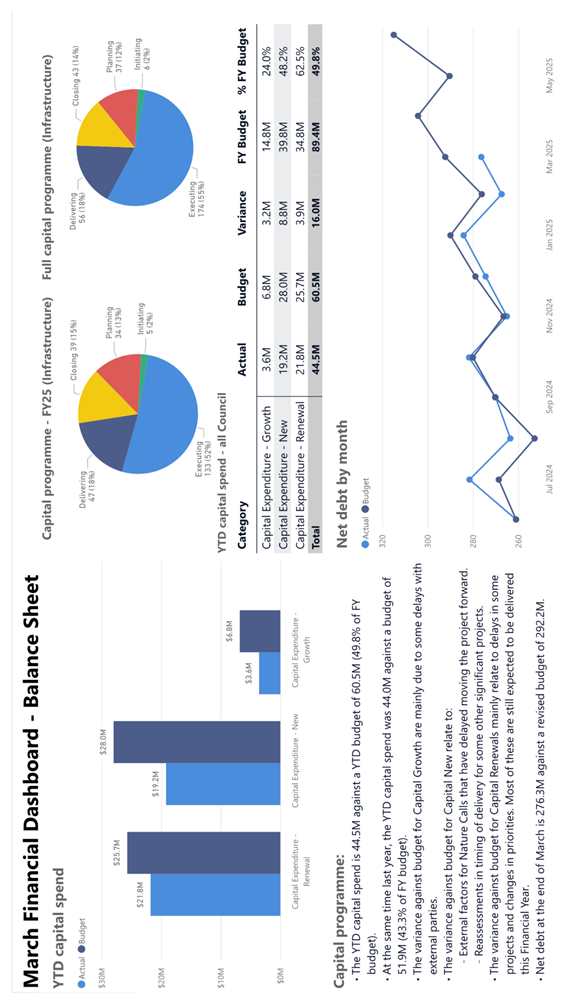
Memorandum
TO: Council
MEETING DATE: 7
May 2025
TITLE: Treasury
Report - Nine months ending 31 March 2025
Presented By: Steve
Paterson, Manager - Financial Strategy
APPROVED BY: Cameron
McKay, General Manager Corporate Services
RECOMMENDATION TO Council
1. That Council
note the performance of Council’s treasury activity for the nine months ending
31 March 2025.
1. ISSUE
1.1 To
provide an update on the Council’s treasury activity for the nine months
ending 31 March 2025.
2. BACKGROUND
2.1 The
Council’s Long Term Plan 2024-34 forecast additional debt of $53.3m would
need to be raised during the 2024/25 year to fund the $62.4m of new capital
expenditure programmes (including assumed carry forwards from 2023/24).
On 26 June 2024 Council authorised the Chief Executive to borrow up to an
additional $54m for its purposes during 2024/25.
2.2 Council’s
Financial Strategy (adopted 26 June 2024) contains the following ratios which
the Council has determined to be prudent maxima:
· Net debt as
a percentage of total assets not exceeding 20%
· Net debt as
a percentage of total revenue not exceeding 250%
· Net interest
as a percentage of total revenue not exceeding 15%
· Net
interest as a percentage of annual rates income not exceeding 20%
2.3 The
Treasury Policy (embracing the Liability Management and Investment Policy), an
updated version of which was adopted by the Council on 14 February 2024, also
contains a number of other criteria regarding debt management.
3. PERFORMANCE
3.1 On
18 March 2025 S&P Global Rating issued revised credit ratings for a large
number of NZ Councils following their reassessment of the local government
sector in NZ. The change in their assessment was primarily driven by the
increasing burden on Councils to fund infrastructure and the volatility of the
policy framework for the structure of local government. The Council’s
previous rating of AA (negative) was changed to AA- (stable). The effect
of this lowered credit rating is that there will be a 0.05% increase in the
borrowing margin applied to new long-term borrowings raised by the Council.
3.2 Schedule
1 attached shows the details of Council’s debt as at 31 March
2025. Debt levels were within the policy parameters outlined in section 2
of this report.
3.3 The
summarised term debt movements are shown in the following table:
|
|
LTP Budget for year #1 (2024/25)
$000
|
Actual – 3 months (2024/25)
$000
|
Actual – 6 months (2024/25)
$000
|
Actual – 9 months (2024/25)
$000
|
|
Debt balance at 1 July
2024:
· Core Council debt
· Debt on behalf of PNAL
Plus new debt #2
Less debt repayments #2
|
256.1
0
53.3
0
|
267.0
8.0
44.0
(10.8)
|
267.0
8.0
44.0
(10.8)
|
267.0
8.0
4.2
(10.8)
|
|
Closing gross debt
balance
Comprising:
Bank advance (on call)
LGFA stock
|
309.4
|
308.2
0
308.2
|
308.2
0
308.2
|
312.4
0
312.4
|
|
Less:
Deposits held for debt
repayment #3
Sum advanced to PN
Airport Ltd
|
0
0
|
(18.0)
(8.0)
|
(18.0)
(8.0)
|
(18.0)
(12.0)
|
|
Net Council related
term debt
|
$309.4
|
$282.2
|
$282.2
|
$282.4
|
#1 The
Council’s LTP does not currently include the debt related to PNAL.
#2 A
portion of the Council’s debt is drawn on a daily basis – daily
drawdowns and repayments are not included in these figures but the net draw or
repayment for the year to date is shown as part of new debt or debt repayment
as appropriate.
#3 To
ensure there were sufficient funds on hand to meet outgoings in a period of
uncertain cashflows a term loan of $15m was raised in mid-August. As at 31
March 2025 $6.3m of this was held on on-call. If this was taken into
account, then the net Council related debt was effectively $276.1m as at 31
March.
3.4 Gross
debt at 31 March 2025 was $312.4m compared with $275m at 1 July
2024.
3.5 The
debt raised in the nine months to 31 March 2025 is explained further in the
following table:
|
|
Position
as at 1 July 2024 $m
|
Position
as at 31 March 2025 $m
|
Change
YTD $m
|
|
Gross
debt
Less
portion relating to PNAL
|
275.0
(8.0)
|
312.4
(12.0)
|
37.4
(4.0)
|
|
Gross
debt relating to Council
Less
term deposit held to repay maturing debt
|
267.0
(6.0)
|
300.4
(18.0)
|
33.4
(12.0)
|
|
Net Council
related debt
|
261.0
|
282.4
|
21.4
|
This shows net additional term debt of $21.4m was raised
during the nine months. This compares with the authorised total sum for
the year of $54m mentioned in clause 2.1. $29m was raised on 8 July with
$19m of this being to fund debt maturing in April 2025. $18m of this has
been placed on term deposit in the meantime. $4.2m was raised on 17
February and $4m on-lent to PNAL.
3.6 A
10-year history of the gross & net debt is shown in the following graph:
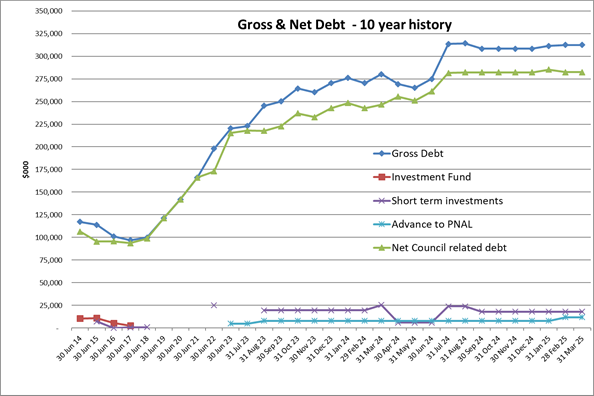
3.7 Actual
finance costs incurred by the Council depend on the actual debt levels and the
interest rate. During the nine months gross finance costs (including
interest, line fees and the effects of payments relating to swaps) amounted to
$10.21m compared with the budget for the year of $14.52m.
3.8 Deducting
interest income from the gross interest expense of $10.21m means a net interest
expense (for Council related debt) for the nine months of $8.4m compared with
the annual budget of $14.16 m.
3.9 The
effective weighted average interest rate for the year to date is 4.4% compared
with the budgetary assumption of 5%.
3.10 The
Council has entered financial instruments related to its debt portfolio
utilising swap trading lines established with Westpac, ANZ and BNZ. The
details of these are shown in Schedule 2 attached.
The value of these instruments is measured in terms of its
‘mark-to-market’, i.e. the difference between the value at which
the interest rate was fixed and the current market value of the
transaction. Each of these transactions was valued at the date they were
fixed and again at the reporting date. Financial reporting standards
require the movement in values to be recorded through the Council’s
Statement of Comprehensive Income (Profit & Loss Account). They have
been revalued as at 31 March 2025. The latest valuation is an asset of
$2.44m compared with an asset of $9.35m as at 30 June 2024. The reduction
in asset value of $6.91m is a consequence of reducing market interest rates.
3.11 The
Council’s Treasury Policy contains guidelines regarding the measurement
of treasury risk as follows:
· Funding and
liquidity risk is managed by the Council maintaining a pre-set portion of its
debt in a range of maturity periods, e.g. < 3 years, 3 - 7 years, 7 years
+.
· Interest
rate risk is managed by the Council maintaining the ratio of debt that is
subject to floating versus fixed interest rates within pre-set limits.
3.12 The
position compared to the policy is illustrated in the graphs in Schedule 3 attached.
3.13 The
funding and liquidity risk position can be summarised as follows:
· Council’s
liquid position complies with policy.
· Since 1 July
2024 $48.2m of term debt has been raised and $4.8m of bank debt and $6m of term
debt has been repaid.
3.14 The
interest rate risk position describes the portion of the overall forecast debt
that is fixed versus floating and can be summarised as follows:
· There is
significant uncertainty about forecast levels of future debt – this very
much depends on a number of factors including future Council decisions on the
proposed capital expenditure programme, the future structure for the provision
of three waters and the extent of external funding able to be organised from
other arrangements.
· Policy
compliance at 31 March 2025 is based on the debt forecasts in the adopted Long-term
Plan.
3.15 The
Treasury Policy also contains requirements in relation to counterparty credit
risk – this relates to investments and financial risk management
instruments. Three new forward start swap agreements have been entered
over the nine-month period:
· on 12 July
fixing interest rates for $20m at 3.695% from 2025 to 2030,
· on 22
November fixing interest rates for $15m at 3.725% from 2024 to 2026,
· on 25 March
fixing interest rates for $20m at 3.825% from 2025 to 2030.
The position as at 31 March 2025 is shown in Schedule 4
attached.
3.16 Council’s
credit lines with the banks include a $18m three-year credit facility with
Westpac Bank (maturing 31 October 2025) and a revolving $25m three-year
facility with ANZ Bank (maturing 31 March 2028). In March a new revolving
15 month $10m standby line was arranged with LGFA.
4. CONCLUSION AND NEXT STEPS
4.1 Gross
finance costs for the nine months to 31 March (including interest, line fees
and the effect of swaps) was $10.21m compared with budget for the year of
$14.52m. The net finance cost (after considering the interest income from
term investments and the advance to Palmerston North Airport Ltd) is $8.4m
compared with the budget for the year of $14.16m.
4.2 In
conjunction with Council’s treasury advisors hedging instruments are
regularly reviewed in an effort to ensure the instruments are being utilised to
best advantage as market conditions change. The level of hedging cover is
also reviewed as the forecasts of future debt levels are revised.
4.3 Council’s
borrowing strategy is continually reviewed, in conjunction with Council’s
treasury advisors, to ensure best advantage is taken of Council’s quality
credit rating.
4.4 A
further performance report will be provided after the June 2025 quarter.
5. Compliance and administration
|
Does the Council have delegated authority to decide?
|
Yes
|
|
Are the decisions significant?
|
No
|
|
If they are significant do they
affect land or a body of water?
|
No
|
|
Can this decision only be made
through a 10 Year Plan?
|
No
|
|
Does this decision require
consultation through the Special Consultative procedure?
|
No
|
|
Is there funding in the current
Annual Plan for these actions?
|
Yes
|
|
Are the recommendations
inconsistent with any of Council’s policies or plans?
|
No
|
|
The recommendations contribute
to:
All of Council’s Goals.
|
|
The
recommendations contribute to the achievement of objectives
in:
14.
Mahere mana urungi, kirirarautanga hihiri
14. Governance and Active
Citizenship Plan
The objective is: Oversee
Council operations and communicate outcomes and decisions to our communities.
|
|
Contribution to strategic
direction and to social, economic, environmental and cultural well-being
|
Managing the Council’s
treasury activity is a fundamental component of day to day administration of
the Council.
|
|
|
|
Attachments
|
1.
|
Schedules 1 - 4 ⇩ 
|
|
Memorandum
TO: Council
MEETING DATE: 7
May 2025
TITLE: Te
Manawa Museums Trust: Six-Month Report 1 July - 31 December 2024 and
Draft Statement of Intent 2025-28
Presented By: Sarah
Claridge, Governance Advisor
APPROVED BY: Cameron
McKay, General Manager Corporate Services
RECOMMENDATION TO Council
1. That Council
receive the Six-Month Performance Report 1 July - 31 December 2024 (Attachment
1) submitted by Te Manawa Museums Trust.
2. That Council
receive the draft Statement of Intent 2025-28 (Attachment 2) submitted by Te
Manawa Museums Trust.
3. That Council
agree that the recommended comments on the draft Statement of Intent
2025–28 outlined in Table 4 be advised to Te Manawa Museums Trust.
1. ISSUE
1.1 Te
Manawa Museums Trust (Te Manawa) has delivered its six-month report 1 July - 31
December 2024 and draft Statement of Intent (SOI) 2025-28. This report
includes analysis of both documents, which are appended to this memorandum.
1.2 The
purpose of this report is to provide an opportunity for Council to give
feedback to the Te Manawa Board on their draft SOI.
1.3 Under
the Local Government Act 2002 (LGA), when preparing the final SOI, a Council
Controlled Organisation (CCO) must consider any comments made on the draft by
the Council, prior to delivering a final SOI by 30 June 2024.
1.4 Due
to a new financial system and a change in personnel, Te Manawa did not meet the
legal deadline of 1 March to submit these documents.
2. BACKGROUND
2.1 Te
Manawa is a Council Controlled Organisation (CCO), which was set up to manage
the Te Manawa Museum. A CCO is an organisation in which Council has the right
to appoint at least 50% of the trustees and must work towards Council’s
objectives on its behalf.
2.2 Six-month
performance reports allow Council to track a CCO’s progress against their
SOI and the Council’s objectives for the CCO. This six-month report
covers the first six months of the SOI 2024-2027.
2.3 The
Council is required by the LGA to regularly undertake performance monitoring of
its CCOs. Council is required to evaluate:
· the contribution
of each CCO to the Council’s objectives for the CCO,
· the
desired results set out in the SOI; and
· the
overall aims and outcomes of the Council based on the six-month reports.
3. COUNCIL OBJECTIVES FOR TE MANAWA
2025-2028
3.1 It
is good practice for a shareholder of a CCO (ie. Council) to outline what it
expects of its CCO, and to clarify the roles and responsibilities of the CCO
Board and Council in a Statement of Expectations (SOE).
3.2 In
September 2024, Council agreed a three-year Statement of Expectations (SOE)
2025-2028 for Te Manawa. The SOE aligns with the objectives from
Council’s Oranga Papaioea City Strategy and strategic plans, in
particularly the Arts Plan and the Heritage Plan.
3.3 Council’s
priorities under the Arts and Heritage Plans for Te Manawa are below:
For the Arts Plan
Objective 1: Provide and support cultural
facilities Te Manawa is a central city museum, art gallery, and
science centre for the wider region.
Objective 2: Support community arts initiatives and
organisations. The value of the arts is evident in our cityscape. There is
support for local arts organisations and creative initiatives.
Objective 3: Provide, fund, and support city and
community events There is a variety of local city and community
events and festivals throughout the year. Communities have opportunities to
share and celebrate their cultural identity and interests. New and developing
events attract and engage new audiences.
For the Heritage Plan:
Objective 1: Promote, protect, celebrate, and share
knowledge of local history City communities have opportunities to see
and learn about the various threads of Palmerston North’s history. This
includes the history of Rangitāne o Manawatū, and social history
including for example the development of the cityscape, military, education, sport,
medical and railway heritage, and the stories of the many and diverse
communities who live here.
Objective 2: Support Rangitāne o Manawatū in
their role as kaitiaki of their historic heritage places. Rangitāne o
Manawatū identifies projects and initiatives of greatest priority. Council
works with Rangitāne o Manawatū in support of shared and agreed
outcomes to promote community wellbeing.
3.4 Te
Manawa has incorporated these objectives into their key performance indicators
which are grouped as:
· Innovative experiences
that engage visitors;
· Enhanced Learning
and Development; and
· A
collaborative and future focused organisation.
4. PERFORMANCE FOR THE SIX MONTHS July TO
DECEMBER 2024
4.1 In February
2024, Council agreed to increase Te Manawa’s grant to $4M for the 2024-25
year. The additional grant was to upgrade and replace Te Manawa’s
semi-permanent offerings. This involves new content, furniture, exhibits and
interactions. In this reporting period, work to upgrade the semi-permanent
offer included:
· The new display,
Call Me Maybe in the Journeys Gallery. The exhibit features a selection of
phones, spanning the decades from the 1880s to the present. It focuses on how
communication has evolved with time and technology for the people of the
Manawatū.
· The purchase of
three tall cases for the Te Rangi Whenua gallery, these display kākahu and
other traditional cloaks from Te Manawa’s collection. The cloaks offer
visitors a unique opportunity to connect with and appreciate the heritage,
culture, and artistry involved.
4.2 Highlights
from Te Manawa’s Six-Month Report (Attachment 1) include the following:
· Hosted
several Toi Māori exhibitions included Te Whare Pora: A Sacred Space by
Maungarongo (Ron) Te Kawa, Tohunga Mahi Toi by Robyn Kahukiwa and Matatau.
· Collaborated
with tertiary partners to exhibit Toioho ki Āpiti, Matatau with Massey
University (November), and Nova Arte: Bachelor of Creative Media Expo, (UCOL).
· Collaborated
with New Zealand Rugby Museum, Property Brokers, Sport Manawatū and the Manawatū
Business Chamber on the Peter Bush Fundraising Auction in August.
· Learning
programmes have been very popular, Te Manawa exceeded its 2024 target set by
the Ministry of Education for Enriching Learning Curriculum (ELC) funding with
4107 students attending during the 2024 calendar year. 44 free education
programmes to school groups (1475 students) were also run.
· The
interactive touring exhibition, Sunlight – Iho Kōmaru, was very
popular with visitors.
4.3 Table
1 shows Te Manawa’s six-month performance against its annual target. Te
Manawa is tracking well against all its performance measures and has already
achieved the online engagement target.
4.4 Whilst
officers acknowledge that the Trust does not want to set targets that are
impossible to achieve, having targets that are too easy to achieve diminishes
the usefulness of having performance measures. Perhaps the Board should
consider more ambitious targets for next year or review the depth of
engagement.

4.5 Table
2 compares Te Manawa’s results for the last 3 years.
Table
2: Comparing the first six months of the financial years 2022, 2023 and
2024
|
Measure
|
|
YTD
31 Dec 2022
|
YTD
31 Dec
2023
|
YTD
31 Dec
2024
|
3 Year Trend
|
|
Visits to
Te Manawa
|
Actual
Target*
|
69,303
65,000
|
84,401
65,000
|
80,860
65,500
|
→
|
|
External
revenue ($)
|
Actual
Target*
|
197,940
473,590
|
290,037
255,125
|
$397,619
$334,100
|
↑
|
|
Visitor
satisfaction
(TM
surveys)
|
Actual
Target
|
98%
95%
|
98%
95%
|
98%
95%
|
→
|
*Target is for the six-month mark
4.6 ‘Visits
to Te Manawa’ is slightly down on last year but is still higher than
2022.
4.7 It
is pleasing to see the external revenue figure increase by $100,000 compared to
2023, and to hear about progress in this area, particularly the work to
identify potential sponsors and implement the Revenue Strategy.
Financial Analysis for the six-month
period
4.8 Te
Manawa has recently implemented a new accounting system, which has been used to
create the financial statements for both the six month and draft SOI. Collating
the financial data into the new system has been a challenging process and has
led to significant delays.
4.9 The Trust reported a deficit of $1,435
as opposed to a budgeted surplus of $109K, an unfavourable variation of $112k. This is because of
staffing changes ($137k) and three pay periods falling in December.
Table 3: Summary
of Financial Information for Six-Month Report
|
July -
December 2024
|
July - December 2023
|
|
Actual
|
Budget
|
Variance
|
Actual
|
Variance*
|
|
Financial Performance
|
|
PNCC Grants
|
1,916,799
|
1,916,799
|
0
|
1,878,285
|
38,514
|
|
Total Revenue
|
2,258,264
|
2,349,088
|
(90,824)
|
2,137,024
|
121,240
|
|
Total Expenses
|
2,257,721
|
2,215,846
|
41,875
|
1,841,556
|
416,165
|
|
Other Expenses
|
1,978
|
22,972
|
(20,994)
|
26,295
|
(24,317)
|
|
Net Surplus (Deficit)
|
(1,435)
|
109,470
|
(111,705)
|
277,357
|
(270,608)
|
|
Financial Position
|
|
Current Assets
|
231,101
|
333,301
|
(102,200)
|
476,364
|
(245,263)
|
|
Total Assets
|
21,994,342
|
22,412,266
|
(417,924)
|
22,216,731
|
(222,389)
|
|
Current Liabilities
|
635,756
|
894,604
|
(258,848)
|
843,742
|
(207,986)
|
|
Total Liabilities
|
635,756
|
894,604
|
(258,848)
|
843,742
|
(207,986)
|
|
Net Assets
|
21,358,587
|
21,517,662
|
(159,075)
|
21,372,990
|
(14,403)
|
|
Equity
|
21,358,587
|
21,517,662
|
(159,075)
|
21,373,990
|
(15,403)
|
|
Cash Flows
|
|
Total Net Cash Flows
|
(1,423)
|
(111,596)
|
110,173
|
750,822
|
(752,245)
|
|
Opening Cash
|
419,203
|
443,807
|
(24,604)
|
265,459
|
153,744
|
|
Closing Cash
|
417,780
|
332,211
|
85,569
|
1,016,281
|
(598,501)
|
*when compared to the same period 12 months ago
5. draft statement of intent 2024-2027
5.1 The
Board has presented a draft SOI (Attachment 1) that aligns with Council’s
strategic direction and addresses the Statement of Expectations, as outlined in
Table 4 below.
Table 4: Comparison of Te
Manawa’s SOI with Council’s Statement of Expectation
|
Objectives
from Council’s Statement of Expectation
|
Te Manawa’s Draft SOI 2025-28
|
Comments + Recommendations for Final SOI 2025-28
|
|
Contribute
towards specific actions in the Arts Plan and the Heritage Plan and align
activities to Council’s overall vision, goals, and Oranga Papaioea City
Strategy.
|
Partially
Included: Te Manawa’s contribution to Council’s strategic
goals are detailed on page 9.
|
No
mention to the specific objectives in the Arts and Heritage Plans (section
3.3 above).
Recommendation
That
Te Manawa detail how it meets these specific objectives.
|
|
Focus
on developing and growing use of and access to collections.
|
Included: Outlined in Objective 1 actions include:
· Working
with Rangitāne to weave Te Ao Māori into the Science Centre
development.
· Develop
and deliver one experience that engages visitors with the Peter Bush
Collection
· Continue
to promote and add to Collections online
|
Satisfies Statement of Expectation.
|
|
Focus
on attracting visitation and third-party investment.
|
Included:
as part of the foreword on page 3.
Objective
1 explains how Te Manawa aims to attract visitors using creative
marketing and digital engagement.
A
range of actions to attract different communities to the museum are listed
under Objective 1. Actions include:
· Delivering a
programme of balanced, exciting, and frequently changing exhibitions;
aligning attractions to support Council’s cultural events; and,
· Engaging
visitors with on-site activities and public programmes based around cultural
celebrations.
Actions
to attract external funding include:
· Identify
partnership opportunities for ongoing funding and collaboration.
· Seeking external
revenue to assist in cost of delivering the education programme (Objection
2), and
· Implementing the
Te Manawa Revenue Strategy with a focus on philanthropic and sponsorship
contribution against strategic targets (Objection 3).
‘Visitor Numbers’ and External Revenue are also
performance measures.
|
Satisfies Statement of Expectation.
|
|
Develop
performance measures that demonstrate performance.
To
include:
increasing
patronage numbers
|
Included:
The draft SOI lists 4 performance measures (page 11)
External revenue targets are given inclusive and excluding the
Science Centre project.
|
Targets are modest, considering Te Manawa has exceeded the
current targets (see Table 1 above).
Officers recommend online engagement measurement be scoped to
help identify if other strategic objectives such as education and visitor
attraction are being met, eg. Specifying traffic to certain web pages such as
Explore the collection -
Te Manawa, which are being developed to meet those purposes
Recommendation
1. That Te Manawa review targets to be more ambitious.
2. That Te Manawa review the measure “Online
Engagement”.
|
|
Outline
approach to good governance practices, financial sustainability, and
environmental sustainability.
|
Included:
Good
governance practices
The
Board has listed in its approach to governance (page 10): to ‘encourage
and maintain diversity in all elements of its organisation’
An action in Objective 3 is to Work with PNCC to reflect the
diversity of Palmerston North in its Board.
Financial sustainability practices
Mentioned in the foreword, and in objectives in reference to the
Revenue strategy and partnership funding efforts.
Environmental sustainability Actions are discussed in
Objective 3 : these include:
· Reduce
paper use and
· Increasing
the use of sustainable products in the development and delivery of
exhibitions.
|
Satisfies Statement of Expectation.
|
|
Outline
your approach to upholding the mana of Te Tiriti o Waitangi including working
in partnership with Rangitāne o Manawatū (see page 7 of the
Oranga Papaioea City Strategy).
|
Included:
Mentioned in the foreword.
Several
objectives and actions refer to collaborating with Rangitāne and
Māori to develop exhibitions and implement strategies.
Under How we operate (page 16) Te Manawa states: “We
will continue to work closely with Rangitāne, as mana whenua to ensure
Rangitānenuiarawa in the telling of pūrākau and the
appropriate tikanga in the Kaitiakitanga of taonga”
|
Satisfies Statement of Expectation.
|
|
Outline
approach to engaging with and enabling participation by under- represented
communities[1]
|
Included: Action under Objective 1: Continue to engage
with the city’s less-represented communities with the aim in 2026-27 to
explore exhibition opportunities with one of these groups.
|
Specific programmes/ groups have been removed from SOI since the
previous year (NOA programme, MIAB, Tamariki exhibition space).
|
|
Collaborate
with Council on the development of the Civic and Cultural Masterplan and to
resolving earthquake prone building issues.
|
Included: Mentioned as an activity in Objective 3:
“Work with PNCC and external funders towards a new purpose-built,
energy efficient Te Manawa complex.”
|
Satisfies Statement of Expectation.
|
|
Manage
existing collections and any potential donations to ensure every collection
item is housed in optimum conditions.
Demonstrate how:
· the collecting goals of the museum and other
collections-related policies take account of collections sustainability, and
current and long-term storage requirements;
· items acquired
for the collection or accepted on long-term loan fall within the acquisitions
policy of the museum or gallery and that Te Manawa can provide adequately for
their physical protection, care, and documentation.
|
Partially Included
Mentioned as an activity in Objective 3: “Develop a
proposal with PNCC to mitigate risks and address challenges that arise with
the Art Gallery’s ability to host high-quality contemporary exhibitions
and provide museum standard level of care for collections and loaned items.”
|
The SOI talks about the importance of maintaining collections
but does not go into details about how it does so.
The SOI mentions that renovations of the Art Gallery need to
occur to enable Te Manawa to provide a museum standard level of care.
However, this issue does not cover the full extent of Council’s
expectation. This may be better covered through a report to Council rather
than including detail in the SOI.
Recommendation
That the SOI include an action to inform Council about the
Acquisition Policy, how collections are protected, and any risks to the
collection.
|
|
Strategic
Partnerships
strengthening
the partnership with the New Zealand Rugby Museum;
working
with Te Manawa’s founding trusts to address shared objectives;
working
with the Heritage Reference Group during the establishment phase.
|
Partially Included:
New Zealand Rugby Museum
An action in Objection 3 involves continuing to strengthen the
relationship through the Peter Bush archive project and other related
projects.
Founding Societies
Te Manawa to collaborate with founding societies to grow support
and general revenue.
Heritage Reference Group
Not mentioned
|
Recommendation
That Te Manawa explain how it plans to work with the Heritage
Reference Group.
|
Financial
Commentary
5.2 Revenue
is forecast to increase and then decrease over the next few years due to monies
being sourced to fund the redevelopment of the new Science Centre. The Science
Centre is contingent upon receiving funding of $1.5M through grants and
sponsorship. It is scheduled to open in 2028.
5.3 Council’s
operational grant remains the main source of revenue for the Trust.
Table
5: Te Manawa’s SOI Summary Financials
|
($)
|
Budget
|
SOI
|
|
Summary Financials
|
24/25
|
25/26
|
26/27
|
27/28
|
|
Financial Performance
|
|
PNCC Grant
|
3,833,599
|
4,024,056
|
4,217,826
|
4,310,485
|
|
Total Revenue
|
4,580,085
|
5,895,839
|
5,026,175
|
4,643,566
|
|
Total Expenses
|
4,548,893
|
4,447,797
|
4,304,244
|
4,483,777
|
|
Other Expenses
|
25,772
|
3,600
|
3,708
|
3,819
|
|
Net Surplus (Deficit)
|
5,420
|
1,444,441
|
718,223
|
155,970
|
|
Financial Position
|
|
Current Assets
|
333,301
|
544,340
|
362,813
|
430,456
|
|
Total Assets
|
22,412,266
|
24,107,218
|
24,777,028
|
24,969,538
|
|
Current Liabilities
|
894,604
|
948,697
|
892,626
|
921,710
|
|
Total Liabilities
|
894,604
|
948,697
|
892,626
|
921,710
|
|
Equity
|
21,517,663
|
23,158,521
|
23,884,402
|
24,047,828
|
|
Cash Flows
|
|
Total Net Cash Flows
|
(240,409)
|
(123,246)
|
52,006
|
140,412
|
|
Opening Cash
|
443,807
|
539,110
|
165,864
|
139,699
|
|
Closing Cash
|
203,398
|
415,864
|
217,870
|
280,111
|
|
Financial Indicators
|
|
Current Ratio
|
0.37
|
0.57
|
0.41
|
0.47
|
|
Working Capital
|
(561,303)
|
(404,357)
|
(529,813)
|
(491,254)
|
5.4 Whilst
it is not ideal to have a current ratio of less than 1 and negative working
capital, as this could indicate issues meeting its short term obligations, Te
Manawa does have enough funds available in their investments (term deposits of
$585k in 2024/25) to cover its short term expenses. However, an ongoing
low current ratio is not sustainable and Te Manawa will need to carefully
manage its cashflow over this period.
6. NEXT STEPS
6.1 Any
Council comments on the draft SOI will be communicated in writing to Te Manawa.
6.2 Te
Manawa will deliver their final SOI to the Culture & Sport Committee on 25
June 2025.
7. Compliance and administration
|
Does the Council have delegated
authority to decide?
|
Yes
|
|
Are the decisions significant?
|
No
|
|
If they are significant do, they
affect land or a body of water?
|
No
|
|
Can this decision only be made
through a 10 Year Plan?
|
No
|
|
Does this decision require
consultation through the Special Consultative procedure?
|
No
|
|
Is there funding in the current
Annual Plan for these actions?
|
Yes
|
|
Are the recommendations
inconsistent with any of Council’s policies or plans?
|
No
|
|
The recommendations contribute
to Goal 2: A Creative and Exciting City
|
|
The recommendations contribute
to the achievement of action/actions in the Arts and Heritage
The action is: to support CCOs
to achieve the objectives of the Arts and Heritage Plan.
|
|
Contribution to strategic
direction and to social, economic, environmental, and cultural well-being
|
Receiving the six-month report
allows the Council to have oversight against the previously agreed SOI.
|
|
|
|
Attachments
|
1.
|
Te Manawa Muesums Trust_ Six Month Performance Report
July-December 2024 ⇩ 
|
|
|
2.
|
Te Manawa Museums Trust- Draft Statement of Intent 2025-2028
⇩ 
|
|
TO: Council
MEETING DATE: 7
May 2025
TITLE: Roslyn
Community Hub
PRESENTED BY: Martin
Brady, Community Development Advisor and Bill Carswell, Activities
Manager - Property Services
APPROVED BY: Danelle
Whakatihi, General Manager Customer & Community
Chris Dyhrberg, General Manager
Infrastructure
RECOMMENDATION(S)
TO Council
1. That Council
proceed with Option 2, support further investigation of the feasibility
and community views of a community hub in Roslyn and refer adjustment of budget
within Programme 2343 – Citywide – New Community Hubs to the Annual
Budget 2025/2026 deliberations, to allow for future decision-making regarding
property required to support future provision.
Summary of options analysis for
|
Problem
or Opportunity
|
Council requested a
review of relevant reports and property options to respond to a request for a
Roslyn community hub. There is $1.5M allocated in Programme 2343 –
Citywide – New Community Hubs for Roslyn.
|
|
OPTION 1:
|
Support further investigation of the feasibility and
community views of a community hub in Roslyn.
Do
not adjust budget in advance of future decision-making regarding property
required to support possible new provision.
|
|
Community Views
|
Early engagement with
key stakeholders and community in Roslyn indicates a desire for Council to
support further investigation of the needs and aspirations for a community
hub.
|
|
Benefits
|
Council gains better
understanding of the needs of community and viability of a Roslyn community
hub
Makes the most of
current stakeholder readiness and momentum to lead the feasibility work now
with the support of Council
|
|
Risks
|
With budget not
adjusted in the immediate term, there is a risk that this option would create
a community and stakeholder expectation that then may not be able to be met
Community needs may
change between a feasibility study completed now and the budget being
available in later years
|
|
Financial
|
Nil – a
community-led feasibility study can be delivered through existing budgets;
officer resource required to support can be delivered within existing
budgets.
|
|
OPTION
2:
|
Support
further investigation of the feasibility and community views of a community
hub in Roslyn.
Refer adjustment of budget within Programme 2343
– Citywide – New Community Hubs to the Annual Budget 2025/2026
deliberations, to allow for future decision-making regarding property
required to support future provision.
|
|
Community Views
|
Early engagement with
key stakeholders and community in Roslyn indicates a desire for Council to
support further investigation of the needs and aspirations for a community
hub.
|
|
Benefits
|
As per Option 1
Additionally,
adjustment would allow immediate progress if the result of the feasibility
study and community engagement was in favour of a Roslyn community hub with a
property investment
|
|
Risks
|
Budget adjustment may
not turn out to be necessary if feasibility study and community views do not
support or require the establishment of a community hub in Roslyn.
A budget adjustment may
also raise community expectations, even though feasibility outcome may not
support a hub.
|
|
Financial
|
Nil for the feasibility
and community views component – a community-led feasibility study can
be delivered through existing budgets; officer resource required to support
can be delivered within existing budgets.
Adjustment of budget
within Programme 2343 – Citywide – New Community Hubs would move
$1.5 million capital new forward from Year 7 (2030/2031) to an earlier year.
|
|
OPTION 3:
|
Do
not support further investigation of feasibility and community views of a
community hub in Roslyn at this time; do not adjust budget.
Feasibility
work to be completed closer to the current timing of the budget provision for
a Roslyn community hub.
|
|
Community Views
|
Early engagement with
key stakeholders and community does not support this option; there is a
desire to proceed with a Roslyn community hub sooner than year 7 (2030/2031).
|
|
Benefits
|
No further
investigation work required at this stage. This decision would give clarity
to the community regarding Council’s plans for provision for Roslyn in
the coming years.
|
|
Risks
|
The needs and
expectations of the Roslyn community may not be met in the short term.
|
|
Financial
|
Nil.
|
Rationale for the recommendations
1. Overview of the problem or opportunity
1.1 Community
hubs can provide residents with welcoming, accessible and safe spaces within
neighbourhoods to gather, undertake recreational and educational activities,
and receive services. Palmerston North City Council currently supports a wide
range of community facilities across the city, including community centres,
community houses and community libraries.
1.2 Community
submissions to the Long-Term Plan 2024-2034 requested Council respond to this
need and establish a community hub in Roslyn.
1.3 During
the Long-Term Plan 2024-2034 deliberations, Council resolved:
“that the Chief Executive provide a report to
council outlining property options for Roslyn, requested by ACROSS and REACH
Roslyn, to support delivery of community services. The report should include
a full review of existing and relevant reports to summarise the needs
identified and to inform what the next steps would be, which might include a
feasibility study and or engagement”.
1.4 This
report responds to the above resolution, providing an overview of property
options, prior reports relating to identified needs in Roslyn, and a summary of
the community context based on early engagement. Three options are
presented for next steps for Council’s review: to proceed with further
feasibility work, to proceed with further feasibility work and pre-emptively
adjust the relevant programme budget, or to do nothing further at this stage.
1.5 Officers
note the second option would require adjustment of budget within Programme 2343
– Citywide – New Community Hubs and, therefore, would require
referral to the Annual Budget 2025/2026 deliberations, hence the timing of this
report and presentation to Council rather than the Community Committee on 21
May as previously planned.
2. Background
2.1 In
the Oranga
Papaioea City Strategy for 2024-2034,
Council aspires to create a connected and safe community, where people
have accessible and appropriate social support, access to safe and accessible
community places, and access to services and facilities that are inclusive and
appropriate for their needs. The Strategy states Council will be most
effective when planning and service delivery responds to current community
issues, and while working with our partners and communities to achieve our
shared goals.
2.2 This
report was requested through the Long-Term Plan 2024 – 2034, in response
to community submissions regarding a need for a Roslyn community hub to deliver
enhanced social services and community facility provision within the
suburb.
2.3 Submissions
by REACH Roslyn and ACROSS Te Kotahitanga o te Wairua (ACROSS) were made in
response to the community facility developments proposed in the draft Long-Term
Plan 2024-2034, in particular the community library hub planned for
Awapuni. Both submissions advocated for a community hub to be established
in Roslyn. ACROSS also suggested that Council purchase a building for
such a hub to operate from.
2.4 Officers
note the below resolution was also passed during the Long-Term Plan 2024-2034
deliberations, which established the programme budgets as they currently stand:
“That Council reduce Programme 2343 –
Citywide – New Community Libraries/Hubs – including Awapuni,
Roslyn, Te Patikitiki Highbury to $13M (excluding inflation) total: $1M Year 1,
$0 Year 2 & 3, and $3M per annum in years 4, 5, 6 and 7, allowing budgets
for Roslyn $1.5M, Awapuni $8M, Te Patikitiki-Highbury $3.5M.”
2.5 Roslyn
is in the north-eastern quarter of the city and has a population of 6033,
according to the 2023 Census. Ethnic
diversity is a defining characteristic of Roslyn, with 67.9% of residents
identifying as European/Pākehā, 25% as Māori, 17.1% as Asian,
7.9% as Pacific peoples, and 2.8% belonging to other ethnicities.[2] This
diversity contributes to the cultural richness of the community and influences
local needs in areas such as education, social services, and community
engagement.
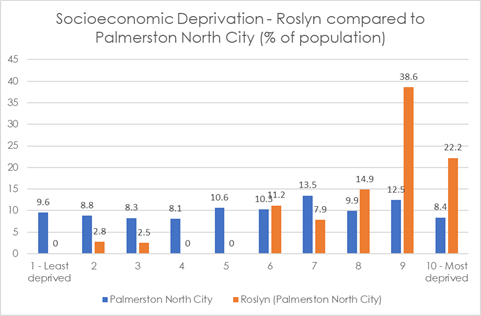
Table 1. Socioeconomic
deprivation in Roslyn, from Census 2023. Palmerston North City, vs Roslyn (Palmerston North
City), Place and ethnic group summaries | Stats NZ
2.6 Roslyn
also has a higher socioeconomic deprivation rating compared to Palmerston North
City as a whole, with 60.8% of the suburb rated as 9 or 10 on the socioeconomic
deprivation scale.
2.7 While
there are relatively few social services in Roslyn, those that are there are
well established and have good links with many parts of the local
community. These organisations include REACH Roslyn, House Next Door,
MASH Trust, and ACROSS Te Kotahitanga o te Wairua.
2.8 Officers
have good long-standing relationships with these organisations and, in the
preparation of this report, have engaged with these services to understand
their aspirations, individual capacity, and willingness to collaborate to
progress this work.
2.9 While
collaboration is still in its early stages, it represents a significant step
toward the development of a community hub. Further work is required to
engage the community, gather their input, and develop a comprehensive
understanding of how a proposed community hub would operate.
2.10 Extensive
community views have not been sought in the preparation of this report, however
some early engagement has been conducted over the past few months by community
stakeholders. For example, REACH Roslyn conducted surveying at the Wacky
Water Day event in Roslyn in February 2025. The ‘Have a Say
Day’ planned for November 2024 had to be cancelled due to poor
weather. While responses to the survey conducted at Wacky Water Day were
few, they did indicate a demand for enhanced community services provision to
support the residents of Roslyn.
3. PropertY Options
3.1 Without
a full knowledge at this point of the requirements or scope of a community hub
in Roslyn, Council officers have investigated property options in the area
based on assumed general specifications from early engagement with community
stakeholders and feasibility work for other community hubs. These
specifications included: space for several meeting rooms of different sizes; back office spaces for service providers; storage facilities; kitchen,
toilets, and carparking with the building being accessible and age
friendly. Another key consideration was location, with the suburb being
intersected by several busy roads.
3.2 After
identifying and assessing several properties against the specifications, a
shortlist was developed for further investigation. After conducting
further investigation, officers found no properties that could be presented as
options for consideration at this point in time.
3.3 Depending
on the direction of Council following this report, Officers will continue to
pursue possible property options to support the feasibility study; any viable
options will be presented back to Council alongside the feasibility study
findings.
4. review of existing & relevant
reports
4.1 Alongside
the investigation of property options, Officers conducted a review of existing
and relevant reports, and identified four reports as having significance to
community and social service provision in Roslyn. Those reports were:
a. A
feasibility report completed in 2017 investigating the need for a new community
hub in Kelvin Grove.
b. The
2022
Community Places Research Report
c. The
2023
Feasibility Study for Palmerston North City Council Community Libraries/Hubs
and Community Centres
d. The
current Community Centres’ Delivery Model Review (nearing completion and
due for presentation to the Community Committee on 21 May).
4.2 These
reports highlight the need to ensure planning for community hub type facilities
consider factors such as future population growth, connections within the
suburb to other community facilities, and providing sufficient level of service
across the city as a whole (i.e. the hub and spoke network model).
4.3 The
Kelvin Grove Feasibility Report in 2017 identified a critical need for a
community hub and library in Kelvin Grove due to inadequate service provision
and a growing population. It is noted that whilst this need was
established in the report, there has been no resulting increase of provision in
Kelvin Grove. While Roslyn was not specifically included in the scope of
the report, it provides useful context with Kelvin Grove being a large
neighbouring suburb with strong arterial routes into and through Roslyn, and it
can be assumed that residents of Kelvin Grove would also be regular users of
Roslyn based facilities.
4.4 The
Community Places Research Report in 2022 provided a stocktake of community
facilities across the city and recommended exploring alternative community
buildings for utilisation as an approach to service unmet needs. This approach
has been considered in the investigation of property options for this report,
however, no suitable community buildings have been identified to date. If
Council directs further feasibility work, this approach will be continued to
ensure opportunities to maximise existing facilities are identified,
particularly as specifications for a future Roslyn community hub become
clearer.
4.5 The
2023 Feasibility Study, which investigated the needs for community facility
provision in Awapuni and Highbury, and for the Pasifika and Multicultural
communities, emphasised the necessity of establishing a hub in the city’s
east to ensure equitable library and community facility coverage across the
city. This report introduced the hub and spoke City Library and Community
Centres Network model, which provides a framework for future provision
decisions based on projected population growth and communities of interest
(groups of suburbs). The proposed eastern and western hubs within the
model would serve a wider catchment and provide a greater range of services and
spaces.
4.6 While
at the time of writing the Community Centres’ Model Review has not been
completed, early findings indicate that the community centres model, which
includes the Rangiora Community Centre in Roslyn, is operating well overall,
with high levels of utilisation. While this is a positive finding in the
context of that review, it confirms for this report that there is likely a need
for further community facility provision in Roslyn.
4.7 Notably,
all four reports highlight Roslyn as an area currently underserved by community
services.
5. Description of options
5.1 Option
1. Support further investigation of the feasibility and community views of a
community hub in Roslyn. Do not adjust budget in advance of future
decision-making which may or may not be required regarding property required to
support future provision.
5.2 The
collaborative effort between the four organisations (REACH Roslyn, House Next
Door, MASH Trust, and ACROSS) is growing momentum. This group has
indicated a willingness to coordinate a feasibility study to establish the
viability and specifications of a future Roslyn community hub, with funding
support from Council (from within existing budgets).
5.3 Officers
note MASH have done some
prior scoping of a Te
Whare Oranga Community Health & Wellbeing Hub which would also
feed well into this feasibility study, with the potential to pilot this concept
as a Roslyn community hub.
5.4 Officers
would ensure the feasibility study builds from the above-mentioned existing reports
and frameworks, and considers the context of Council’s provision of other
facilities in the neighbourhood, including Roslyn Community Library.
5.5 In
addition to this work, officers, together with stakeholders, would conduct
further community engagement to ascertain the views of Roslyn residents.
Officers would also engage with partners Rangitāne o Manawatū to seek
their views and aspirations for the suburb.
5.6 The
above would be delivered within Council’s existing budgets. No adjustment
would be made to the programme budget in the immediate term, though programme
budgets could be adjusted in future years as further information is received.
5.7 Findings
and recommended next steps would be reported back to the Community Committee in
August.
5.8 Option
2. Support further investigation of the feasibility and community views of a
community hub in Roslyn. Refer adjustment of budget within Programme 2343
– Citywide – New Community Hubs to the annual budget 2025/2026
deliberations, to allow for future decision-making regarding property required
to support future provision.
5.9 This
option includes the feasibility study and community engagement work of Option 1
above, but also pre-emptively adjusts the relevant programme budget to allow
for opportunities or recommendations that may result from the feasibility study
to be progressed in a shorter timeframe.
5.10 Option
3. Do not support further investigation of feasibility and community views of a
community hub in Roslyn; do not adjust budget. Feasibility work to be completed
closer to the current timing of the budget provision for a Roslyn community
hub.
5.11 This option
maintains current levels of support for Roslyn in the short to medium term,
allowing the issue to be revisited closer to the current budget allocation in year
7 (2030/2031).
5.12 Officers
have the capacity to continue to conduct community development work within the
Roslyn community at the current level of service through their connections via
REACH Roslyn, the Roslyn Library and House Next Door.
5.13 No
additional funding would be required. Community groups in Roslyn already access
Council funding for initiatives such as Wacky Water Day and Movie Nights.
Community funds would continue to be available for Roslyn.
6. Analysis of options
6.1 Officers
recommend proceeding with Option 2, as it has the greatest potential to respond
to the needs of Roslyn whilst maximising stakeholder and community momentum.
6.2 Both
Options 1 and 2 would provide Council and stakeholders with essential
information regarding the scope, functionality and specifications of a future
Roslyn community hub. Wider community views and Rangitāne input
would also be sought as part of both options, which would assist with future
decision making around facility provision.
6.3 Officers
view that stakeholders involved with Roslyn are currently well positioned to
progress a feasibility study, with Council’s funding and support. If
proceeding with Option 3, it is likely that early engagement and coordination
of stakeholders would need to be revisited again closer to the current budget
timing in year 7.
6.4 Option
2, where the programme budget is adjusted, provides greater opportunity to
progress the recommendations of the feasibility study. If the budget is
not adjusted at this stage, as in Option 1, there is a risk that community and
stakeholder momentum may be lost after the feasibility study is
concluded. Further, there may be confusion caused in the community by
seeking their views at this stage without an ability to deliver any change in
facility provision in the short term.
6.5 Whilst
both Options 1 and 2 are well supported by existing reports, as reviewed above,
proceeding with Option 3 would give earlier clarity to the community regarding
Council’s plans for provision for Roslyn in the coming years.
6.6 On
balance, Officers recommend proceeding with Option 2 as the pathway, which
aligns most closely with Council’s strategic direction and aspirations
for community wellbeing.
7. Conclusion
7.1 Roslyn
is a suburb with comparatively high and complex wellbeing needs, however, it
has a limited number of social services and community wellbeing agencies based
in the suburb. Community submissions to the Long-Term Plan 2024-2034
requested Council respond to this need and establish a community hub in Roslyn.
7.2 This
report has provided the results of an investigation of property options for a
community hub in Roslyn (i.e. none at this stage), and an overview of four
relevant reports relating to the identification of community facility needs in
the suburb.
7.3 Three
options have been presented for next steps for Council’s consideration,
with Option 2 recommended as the pathway which has the greatest potential
benefit for community.
8. Next actions
8.1 Should
Council proceed with Option 2, including approval through the annual budget
deliberations, then the following steps would be undertaken:
· Officers
would work alongside community stakeholders (including MASH Trust, ACROSS,
House Next Door and REACH Roslyn) to undertake a feasibility study to ascertain
the scope, functionality and specifications of a future Roslyn community hub.
· Officers,
together with stakeholders, would undertake further community engagement to
ascertain the needs and aspirations of Roslyn residents with regards to social
service and community facility provision.
· Officers
would continue to investigate property options that may be suitable for a
future community hub.
· Officers
would present a report to the Community Committee in August 2025 for further
consideration.
8.2 Should
Council opt to proceed with Option 1, the above steps would also be taken,
noting there would be no need to await annual budget deliberations.
8.3 Should
Council decide to proceed with Option 3, no further action would be required;
the current levels of service for Roslyn would continue.
9. Compliance and administration
|
Does Council have
delegated authority to decide?
|
Yes
|
|
Are the decisions significant?
|
No
|
|
If they are significant do they
affect land or a body of water?
|
No
|
|
Can this decision only be made
through a 10 Year Plan?
|
No
|
|
Does this decision require
consultation through the Special Consultative procedure?
|
No
|
|
Is there funding in the current
Annual Plan for these objectives?
|
No
|
|
Are the recommendations
inconsistent with any of Council’s policies or plans?
|
No
|
|
The
recommendations contribute to:
Whāinga
3: He hapori tūhonohono, he hapori haumaru
Goal 3: A connected and safe community
|
|
The recommendations contribute to this
plan:
7.
Mahere tautāwhi hapori
7. Community Support Plan
The objective is: Provide and
support community centres, Youth Space, and Hancock Community House
|
|
Contribution to strategic
direction and to social, economic, environmental and cultural well-being
|
Community facilities contribute
to the achievement of community wellbeing across all four areas, due to the
range of activities, services and initiatives they support.
|
|
|
|
Attachments
Nil
Memorandum
TO: Council
MEETING DATE: 7
May 2025
TITLE: Submission
on Term of Parliament (Enabling 4-year Term) Legislation Amendment Bill
Presented By: Hannah
White, Manager Governance
APPROVED BY: Cameron
McKay, General Manager Corporate Services
RECOMMENDATION TO Council
1. That Council
receive the memorandum titled “Submission on Term of Parliament
(Enabling 4-year Term) Legislation Amendment Bill.”
1. issue
Council has made a submission to Parliament’s Justice
Select Committee on the Term of Parliament (Enabling 4-year Term) Legislation
Amendment Bill. The submission period closed on 17 April 2025.
Broadly, the Bill proposes creating
an option to extend the Parliamentary term to four years at the start of each
term. The term could be extended to four years only if the overall membership
of Parliament’s subject select committees was proportional to the party
membership in the House of Representatives of the non-executive members.
The Bill sets out the key provisions enabling a 4-year term
of Parliament, alongside the existing provision that provides for a maximum
3-year term of a Parliament.
If passed, the constitutional changes of the Bill would be
put to the public via a referendum.
The Bill was introduced as a part of the coalition
government’s agreements. It is based on the ACT Party’s draft
Constitution (Enabling a 4-Year Term) Amendment Bill.
In response a submission was prepared by officers and
submitted to the Committee Secretariat under the Mayor’s delegation
(clause 2.9.1), following an opportunity for Elected Member contribution. It is
presented here for noting by the Council and community. The focus of the short
submission is on implications for the local government sector.
2. Compliance
and administration
|
Does the Council have delegated
authority to decide?
|
Yes
|
|
Are the decisions significant?
|
No
|
|
If they are significant do they
affect land or a body of water?
|
No
|
|
Can this decision only be made
through a 10 Year Plan?
|
No
|
|
Does this decision require
consultation through the Special Consultative procedure?
|
No
|
|
Is there funding in the current
Annual Plan for these objectives?
|
Yes
|
|
Are the recommendations
inconsistent with any of Council’s policies or plans?
|
No
|
|
The recommendations contribute
to:
Whāinga
3: He hapori tūhonohono he hapori haumaru
Goal
3: A connected and safe community
|
|
The recommendations contribute to this
plan:
14.
Mahere mana urungi, kirirarautanga hihiri
14. Governance and Active
Citizenship Plan
The objective is: Provide
leadership and advocacy for Palmerston North
|
|
Contribution
to strategic direction and to social, economic, environmental and cultural
well-being
|
The submission is an example
of advocacy to the Government on an issue that poses an opportunity for local
government.
|
|
|
|
Attachments
|
1.
|
Submission to Justice Committee: 4-year Parliamentary term ⇩ 
|
|
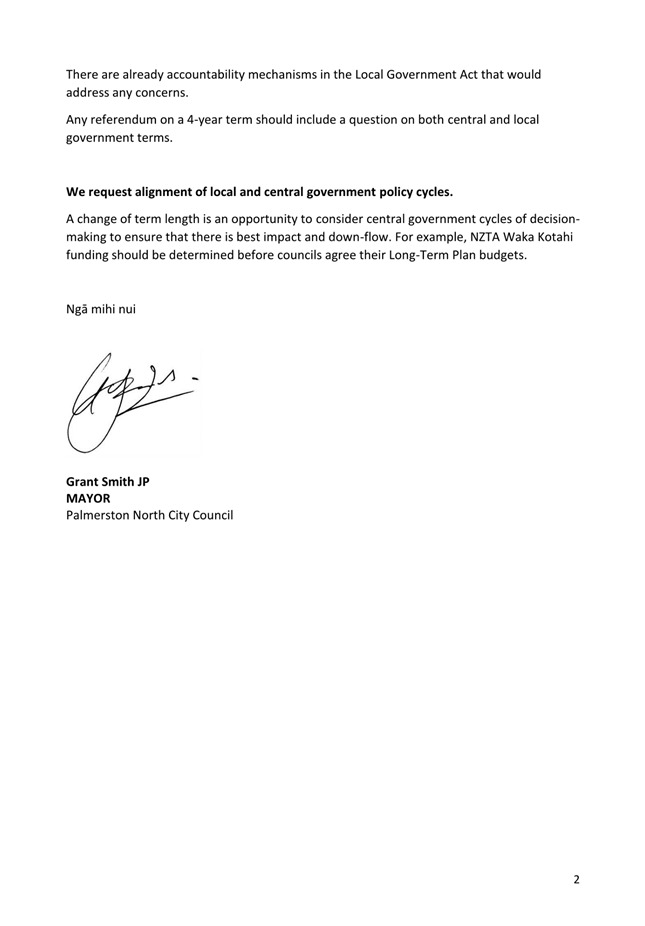
Committee Work Schedule
TO: Council
MEETING DATE: 7
May 2025
TITLE: Council
Work Schedule
RECOMMENDATION TO Council
1. That Council
receive its Work Schedule dated 7 May 2025
COUNCIL
WORK SCHEDULE 7 May 2025
|
#
|
Estimated Report Date
|
Subject
|
Officer Responsible
|
Current Position
|
Date of Instruction & Clause
|
|
|
7 May 2025
|
Nature Calls – Options
report
|
GM Infrastructure
|
|
29 May 2024
Clause 95.11 -24
(rec 2)
|
|
|
7 May 2025
|
Te Manawa
– Six month and Draft SOI 25-28
|
GM Corporate Services
|
Moved from
Culture and Sport
|
|
|
|
7 May 2025
|
Draft Health
Promotion Policy - Deliberation Report
|
GM Strategic Planning
|
Moved from
Community Committee
|
28 August 2024
Clause 16-24
|
|
|
7 May 2025
|
Quarterly
Performance Report
|
GM Corporate Services
|
Moved from
Strategy and Finance
|
|
|
|
7 May 2025
|
Treasury Report
– quarterly update
|
GM Corporate Services
|
Moved from
Strategy and Finance
|
|
|
|
7 May 2025
|
Property options to support the
delivery of Community Services in Roslyn
|
GM Customer & Community
|
|
29 May 2024
Clause 95.36-24
|
|
1
|
7 May
3 Sept
2025
|
Review of PNCC
Appointment of Directors Policy.
|
GM Corporate Services
|
|
2 Oct 2024
Clause 172
|
|
2
|
14 May 2025
|
Investigate options to support
Basketball Manawatū
|
GM Customer & Community
|
To form part of Annual Plan
Deliberation report
|
Culture
and Sport
26
March 2025
|
|
3
|
14 May 2025
|
Deliberations for
the Annual Plan 25/26
|
Chief Executive
|
|
Terms of Reference
|
|
4
|
4 June 2025
|
Adoption of Fees
and Charges
|
GM Corporate Services
|
following
consultation (Trade Waste/ Planning)
|
12 February
Clause xx-25
|
|
5
|
4 June 2025
|
Remits received from other Territorial Authorities
|
GM Corporate Services
|
None received
|
Terms of Reference
|
|
6
|
4 June
8 Oct 2025
|
Residents Survey – Action Plan
|
GM Strategic Planning
|
|
Terms of Reference
|
|
7
|
4 June 2025
|
Adopt Annual Plan 2025-26
|
Chief Executive
|
|
Terms of Reference
|
|
8
|
4 June 2025
|
Deliberations- Te Motu o Poutoa
Civic Marae: Governance Structure
|
GM Infrastructure
|
|
|
|
9
|
7 May
4 June 2025
|
Deliberations- Local Water Done Well Options
|
GM Infrastructure
|
|
|
|
10
|
4 June 2025
|
Set the Rates for 2025-26
|
GM Corporate Services
|
|
Terms of Reference
|
|
11
|
4 June 2025
|
Approve Borrowing for 2025-26
|
GM Corporate Services
|
|
Terms of Reference
|
|
12
|
25 June
2025
|
Alternative
Options for BPO - Nature Calls
|
GM Infrastructure
|
|
Council
29 May 2024
Clause 95.11 -25 (rec 2)
|
|
13
|
25 June
2025
|
Quarter 3 –
Economic Update
|
GM Strategic Planning
|
Moved from Economic
Growth
|
|
|
14
|
25 June
6 August
2025
|
Approve LWDW - Water Services Delivery Plan
|
GM Infrastructure
|
|
|
|
15
|
6 August 2025
|
Agree revised BPO – Nature Calls
|
GM Infrastructure
|
|
|
|
16
|
6 August 2025
|
Review of CEDA Directors Policy
|
GM Corporate Services
|
|
2 Oct 2024
Clause 172
|
|
17
|
6 August 2025
|
Report back on Investment Options for PN Airport
|
GM Corporate Services
|
|
6 December 2023
Clause 197-23
|
|
18
|
6 August 2025
|
Civic and Cultural Precinct Master Plan Steering Group
– 6-monthly update
|
GM Strategic Planning
|
|
Terms of Reference
|
|
19
|
6 August
2025
|
Appointment of Trustees on Council Controlled Organisations
|
GM Corporate Services
|
|
Terms
of Reference
|
|
20
|
8 Oct 2025
|
Adopt Annual Report 2024-25
|
Chief Executive
|
|
Terms
of Reference
|
|
21
|
8 Oct 2025
|
Low Carbon Fund
Allocations 2024/25
|
GM Strategic Planning
|
Moved from Sustainability
Committee
|
21
August 2024
Clause
24-24
|
|
22
|
8 Oct 2025
|
Waste Management
and Minimisation plan 2019 - annual progress update for 2024/25 FY
|
GM Strategic Planning
|
Moved from Sustainability
Committee
|
9
Sept 2020
Clause
17-20
|
|
23
|
8 Oct 2025
|
Citywide
Emissions Inventory 2024 Annual Report
|
GM Strategic Planning
|
Moved from Sustainability
Committee
|
Climate
Change Plan
Action
3
|
|
24
|
8 Oct 2025
|
PNCC
Organisational Emissions Inventory 2024/25 Annual Report
|
GM Strategic Planning
|
Moved from Sustainability
Committee
|
Climate
Change Plan
Action
1
|
|
25
|
TBC
|
Summerhays
Reports –
Partnership
Models
Expressions of
Interest
|
GM Infrastructure
|
Lying on the Table
|
1 May 2024
Clause 66-24 and 74 -24
|
|
26
|
TBC
|
Effectiveness of
Civics Education Initiatives – Annual progress report
|
GM Customer & Community
|
|
29 May 2024
Clause 95.29 -24
|
Proactive Release of
Confidential Decisions
|
Date of meeting
|
Report Title
|
Released
|
Withheld
|
|
2 October 2024
|
Civic Honours 2024
|
Report, Decision
and Division
|
N/A
|
|
11 December 2024
|
Contract time extension- Nature Calls technical experts
|
Report, Decision
and Division
|
N/A
|
|
11 December 2024
|
Appointment of Directors to Central Economic Development
Agency 2024
|
Report, Decision
and Division
|
Attachment
|
|
5 March 2025
|
Reappointment of Trustees/Directors on Council
Controlled Organisations
|
Report, Attachment,
Decision and Division
|
N/A
|


































